
THE ECOLOGY OF PARADOX:
DISTURBANCE AND RESTORATION
IN LAND AND SOUL
by
Rowland S. Russell
A dissertation submitted in partial fulfillment of
the requirements of the degree of
Doctor of Philosophy
Environmental Studies
at
Antioch University New England
(2007)
Committee:
Mitchell Thomashow (Chair), John Tallmadge, and Fred Taylor

© Copyright by Rowland S. Russell 2007
All Rights Reserved

i
ABSTRACT
This heuristic study explores environmental disturbance and ecological
restoration in several North American settings in order to uncover
epistemological, philosophical, aesthetic and ethical considerations revolving
around those place-based processes. With fire as one of the central metaphors
of this work, the initial place-based chapter examines Northern New Mexico's
Pajarito Plateau to explore the region's fire ecology. The study then moves to
the Pacific Northwest to draw from wild salmon restoration efforts in urban
Seattle habitat. The third place-based chapter focuses on the Midwest grass and
farmlands in order to investigate the seeming contradictions between managing
prairie landscapes for agricultural commodity versus biological diversity. In the
final chapter, the metaphorical implications of disturbance and restoration are
explored in terms of individuals, communities and as a society.
In explicating the philosophical and phenomenological foundations of
disturbance and restoration, personal experiences are used in the study as
examples to develop applied practice of paradox. It also examines and
illuminates correspondences between ecological and eco-psychological cycles of
disturbance and restoration within the context of paradox, which for the purpose
of this work is defined as any place or context where seemingly contradictory
elements coexist without canceling each other out. Drawing from landscape and

ii
literary sources, the study seeks to extrapolate a metaphorical correspondence
between exterior and interior realms of paradox. The conclusion is that attention
to processes of disturbance and restoration in nature can yield wisdom that
informs our relationships with our ecological surroundings, our communities, and
our individual selves. Furthermore, specific practices can emerge to help
humans deal more healthfully and strategically with the complex, divisive issues
of our places and times.

iii
ACKNOWLEDGEMENTS
I am extremely grateful to each of the places I studied, as well as to all of the
authors and organizations whose works illuminated my research. I also
appreciate my workplace and literary colleagues, as well as my community of
friends for their ongoing support throughout this long journey. My ultimate
thanks and appreciation goes to my dissertation committee, consisting of Mitchell
Thomashow (Chair), John Tallmadge, and Fred Taylor. Their guidance to me
both in research and writing, and their overriding belief in my work, made this
dissertation possible.

iv
TABLE OF CONTENTS
Abstract...................................................................................................... i
Acknowledgements...................................................................................... ii
List of Figures.............................................................................................. iv
Chapter I: Place-Based Paradox.................................................................... 1
The Gift of Pain
Correspondence
Borrowed Senses
Placing Perception
In the Realm of Paradox
Chapter II: Fire Walk on the Pajarito............................................................ 22
Ruination
Fire Walk on the Pajarito
Burning Question
Chapter III: The Mists of Time.................................................................... 83
Time Transing
Cinematic Ecology
Nurse Logs
Wild Time: A Stitch in the Social Fabric
Chapter IV: Thinking Like a Prairie.............................................................. 152
Roots and Routes
Soil Building/Soul Building
Ghost Roads
Rumination
Eating Oil
Fundament/Firmament
A Diversity of Disturbance
Chapter V: Practices of Paradox.................................................................. 229
Religio
Shattering
Seeking Refuge: Carrying Capacity of the Soul
Controlled Burns
Endarkenment
Works Cited.............................................................................................. 289

v
LIST OF FIGURES
Salmon Woman......................................................................................... 109


1
CHAPTER I: PLACE-BASED PARADOX
THE GIFT OF PAIN
And the world cannot be discovered by a journey of miles, no matter how long,
but only by a spiritual journey, a journey of one inch, very arduous and humbling
and joyful, by which we arrive at the ground at our feet, and learn to be at
home.1
- Wendell Berry
Day begins with a search for life in a place of death. I‟m walking to Keene‟s
Greenlawn Cemetery, seeking peace in an otherwise hectic day. As I enter, my
breathing slows, shoulders relax. Redwings, thrushes, and wrens call from tree
and cattail perches on Beaver Creek‟s expansive marshes. Wildflowers bloom
from wood and road edge. Greenlawn has witnessed its share of angst and
grief, yet I find pleasurable refuge here amid a profusion of wildlife.
A shadow passes to my right. I look up as a turkey vulture tilts and veers
over the ridge. Fitting, I think, to encounter here a creature that transforms
decaying death into soaring life. While vulture searches for road kill sustenance,
I‟ve been in pursuit of philosophical nourishment contained within religious
upheaval, debilitating illness, familial angst, and existential crisis. It‟s not that
my own disturbances are all that striking; what intrigues me is how our internal

2
processes of destruction and resurrection can mirror those of landscapes, and
how ecological processes often defy divisions humans habitually make.
As the graveyard vulture disappears over the hill to the east, I reflect on
another time when the shadow of death passed over me. If our bodies can be
perceived as a metaphorical landscape, then a naturally occurring disturbance
regime of physiological ruin once cleared space in me for restorative new
growth, provided the quixotic gift of pain, and perhaps set me on this enduring
quest to explore the ecology of paradox.2
Awakening one morning, I couldn‟t dress without bolts of excruciating
pain shooting up my spine and down my legs. Debilitating discomfort
intermingled with growing numbness in my face and extremities. The symptoms
baffled my environmental education center‟s on-call physician, as well as the
orthopedic surgeon I was referred to. On a hunch, our savvy on-site nurse made
an appointment with a neurologist who immediately sent me to the hospital.
A spinal tap confirmed a diagnosis of Guillan-Barre; a viral induced illness
which attacks and damages nerve endings along the spinal column (including
those controlling function of vital organs). Paralysis or death was a distinct
possibility. Restoration seemed a universe away. I lost over twenty pounds
from my already slim build. Hands and feet felt as lifeless as cinder blocks. My
face was completely paralyzed, except for my jaw. Incapable of making the
necessary seal to swallow, I manually held my lips closed. Unable to close my
eyes to sleep at night, I gently pushed the lids down, like lowering the shades.3

3
Painfully aware of my limitations, I found I could not walk more than a
few steps unaided. One evening I tried to carry a stack of dirty dishes to the
kitchen counter and tumbled in a clattering heap as the whole dining room fell
silent. Another time, out at the basketball court, I tried to take a jump shot. My
feet never left the ground and I fell flat on my face. To handle the physical pain
attending devastated nerve pathways, I took heavy pain medication. But I was
at a loss about how to handle the psychic pain. My body now a foreign
landscape, feeling a burden on my friends, I fell into a deep depression.
As with land, perhaps body too requires its periodic cycles of disturbance and
restoration. Renowned for his work with leprosy patients in India in the mid-20th
century, Dr. Paul Brand almost literally stumbled on the knowledge that became
the basis for his ground-breaking medical work and for his book The Gift of Pain,
co-authored with Philip Yancey. One morning Brand watched a leper stumble off
the roadway, badly fracturing his ankle. Picking himself off the ground, the man
walked on as if nothing happened. Recalling his training in neurology, a light
went on for Brand.4
He posited that those afflicted with leprosy had lost the neural ability to
feel pain. Formerly, any physical contact with such patients was discouraged –
the fear that their very flesh was diseased overrode any empathetic impulse.
Brand surmised that lack of sensation led to accidental wounds, which
unexamined and unfelt became infected and gangrenous. He devised an

4
ingenious training program to cultivate bodily awareness in his patients, to help
compensate for their sensory deprivation. Even those of us without such
illnesses, posits Brand, will go to great lengths to avoid pain, not realizing its gift
to us of teaching presence.
My neurologist cautioned me that nerve regeneration, to the extent that it was
possible (some never recover), could be as excruciating as the onset of the
illness. “Move into the pain.” he urged counter-intuitively, “that‟s evidence that
your nerves are healing.” I consciously willed myself to stretch and exercise,
despite the agony, lest I permanently lose precious mobility. “Congratulate me, I
have a new pain,” I„d joke with friends, cognizant of the thin and permeable
membrane between my own disturbance and restoration.
Evangelical Christians speak of being born again in Christ. In recovering
from the Guillan-Barre‟s disturbance, I was resurrected by the contradictory
calculus of searing pain equating a return of the potential for pleasure. I was
slowly reborn into the body I‟d taken for granted. Each new sensation, each
returning motor function, was an absorbing lesson in physiology and cause for
celebration. Formerly deadened taste buds reveled in the return of familiar
flavors. My friends threw me a party when I learned to whistle again. In an
effort to recover balance, I renewed a childhood compulsion and walked along
the tops of railroad tracks. I gradually found my bodily center and a

5
compensatory balance despite the lack of sensation in my feet. In the span of a
year, I‟d regained most of what I‟d again know of sensation and mobility.
I learned to accommodate my impairments even as I strove for further
healing. That day I‟d face-planted on the basketball court, I vowed that I‟d once
again dunk a basketball. Eighteen months later on a sunny Vermont summer
camp afternoon, with half the staff and kids bearing witness, I barreled down the
lane and barely eked the ball over the front rim. With that dunk, my journey
through physiological and attitudinal restoration may not have ended, but by the
time I had arrived again to the ground at my feet and at home in my body,
having discovered a new world of quixotically inseparable pain and pleasure,
each informing and amplifying the other.
Buddhist meditation seeks to bring us alive into the present moment, to notice,
then let go. Each sensation, each emotion, becomes a messenger, a teacher.
Encountering suffering, anger, sorrow or anxiety, our own or others, we may
split from it or get lost in it. The point is not to splinter or wallow, but to move
through the conflict and contradiction to the underlying patterns of coherence
beneath the raw emotions. I think of these teachings, and the lessons of
ecosystems of paradox and of my own body, as I seek to craft space to hold
these disparate elements, suspending avoidance and withholding judgment.

6
CORRESPONDENCE
That restoration can be found in the midst of disturbance is the essence of
paradox, which I define as any place or context where seemingly contradictory
elements coexist without canceling each other out. We tend to think of life and
death, confusion and certainty, light and dark, and disturbance and restoration
as inherently oppositional. My quest has been to learn from the land how to
better hold such contradictions in creative tension.
Such learning is a matter of correspondence; in the literal sense of the
word a mutual responsiveness between person and place. Most plant and animal
communities lend themselves to an analysis of disturbance regimes. Many,
particularly those degraded by negative human influence, are in need of
restoration. With something like what biologists refer to as a “search image”
senses ingrained by the twining of disturbance and restoration begin to see
ecological paradox everywhere. I chose areas of study that were on the
margins; forgotten or neglected, damaged lands, throwaway places. These are
where we may more readily see how countervailing forces can resolve
themselves in a more complex pattern of connection than we normally observe.
Wondering how we might better attend to our own inherent personal and
societal contradictions, I turn to three exemplary places of paradox as my
mentors; the Pajarito Plateau in New Mexico, greater Seattle, and prairie
remnants scattered throughout the Midwest. Considerations for choice of study

7
included geographically disparate locales, differing levels of human inhabitation
(virtually none, heavily urban, thickly settled to sparse), and a commensurate
range of human inputs into disturbance regimes and restoration efforts.5 Most
particularly, I chose places which carried unique and compelling contradictions,
whose stories make up the bulk of this work. Landscapes like this exemplify
paradox; enfolding destructive forces and invigorating responses with a natural
ease seldom approached by humans. My bias of learning from land to better
understand self and society requires a bit of explanation.
As a boy growing up in an isolated corner of rural Pennsylvania, I
constantly looked to my hills and fields for guidance and its creatures as role
models, but I did not find a language for the correspondence between self and
place till years later. Browsing a used bookstore in Seattle, I pulled a slim
volume off the shelf whose title intrigued me. Sanctuary by Steven Levine (best
known for his writings on death and dying) is an account of the escape he and
his wife made from their stultifying Southern Cal existence to be caretakers for
an entire year at a remote Arizona wildlife sanctuary.6
I bought the book and devoured it that night. I envied the earthy calm of
their daily routines, how their grounding (both literal and figurative) helped heal
the land and something of themselves as well. In one particular passage, Levine
noted that learning about and working closely with wild nature, we inform and
transform our own inner nature.7 I was inspired to ask “If I were a wildlife
sanctuary, how would I steward myself?” Engaged with questions of

8
correspondence and complementary processes between interior and exterior
ecosystems, I have crafted a discipline I call „„metaphorical ecology.8” Ecological
processes become a lens for understanding the dynamics within, between, and
around us. This practice forms a particularly useful lens on our personal
variations of disturbance and restoration.
We all experience our share of rough stretches. My two sisters were
simultaneously facing the ravages of cancer when I happened upon John
Berger‟s Restoring the Earth: How Americans Are Working to Renew Our
Damaged Environment. A chapter entitled „The Prairie Makers‟, chronicling
efforts to revitalize deeply disturbed Great Plains habitat to ancestral prairie glory
particularly struck me as relevant. Short, mid and long grass prairies evolved
amidst periodic conflagration. Researchers set test plots aflame, no doubt with
trepidation. Inured to eons of fire, prairie species would theoretically hold
competitive advantage over recently introduced non-native species.9
Fire proved its mettle in creating space for new growth of indigenous
prairie plants. In a micro-environment free from competition with weeds,
indigenous species thrived. Other natives, responding to the subtly altered
chemistry of the soil, prospered. Soul-scapes, like landscapes, are subject to
periodic disturbances. I wondered if painful experiences might similarly alter the
micro-environment of body, psyche and soul. Perhaps people, like prairie lands,
could find rejuvenation amidst devastation.

9
At some levels the distinctions between metaphor, image, dream and
reality can blur. Describing these dynamics defies reason and syntax. Words
such as ecology, place, psyche and soul are slippery, at once overly broad and
frustratingly vague. In articulating place-based examples and stories of
disturbance and restoration, I connote a set of encompassing dynamics more
than a catalog of species, habitats or habits. Drawing from the lexicon of
systems theory, I am interested less in the sum of parts of any given place,
community or person, than of the emergent properties of the whole.
The emergent properties of paradox are not found in either side of our
nominal contradictions, but in what cultural psychologist Charles Johnston calls
the “third space.”10 Rather than hardening into one side or another of
oppositional stances we need to maturely incorporate each other‟s perspective.
In doing so we arrive at a place that is neither the right side of the road or the
left, nor even the line down the middle, but an overarching space that
encompasses contradictory stances but also something beyond either side.
Landscapes and their resident organisms model for us ways of holding our own
incongruities in creative tension. In moving beyond knee-jerk contradictions, the
challenge may be as much perceptual as intellectual.

10
BORROWED SENSES
Awhile back I lingered near a small vernal pool in the cemetery and listened to a
sunset sonata in the key of tree-frog. A student of mine has been undertaking
fascinating research into sound and nature. He recently shared a passage from
W.A. Matieu‟s „The Musical Life‟ that described how certain sounds contain many
levels of tone that can be discerned with careful attention.11 I concentrated on
the texture of frog sound. For quite some time I could only sift out the calls of
separate frogs but gradually I began to hear a lower undertone beneath the co-
mingled voices. Letting go into the listening, another subtle note emerged from
spring peeper cacophony. Before I moved on past the pond, I‟d detected at
least four nuanced variations on the collective Pseudacris crucifer voice.
As many times as I‟ve listened to tree-frog song, in that episode I‟d found
new information I‟d never considered before. Was it my ears alone that
facilitated the learning? My perceptual intake that evening was a matrix of tree-
frog, my student, and the words of Matieu within the milieu of a temperate April
evening and bath-tub warmed brackish water. Stripped of context, I might have
heard everything but learned nothing.
Perhaps our perception in any given moment in a particular place at a
specific time is never ours alone, but is informed by other people, organisms,
times and places. These „„borrowed senses” make up a part of our „„perceptual
ecology,” a term pioneered by Mitch Thomashow and explored at length in his

11
Bringing the Biosphere Home: Learning to Perceive Global Environmental
Change. In „A Place-Based Perceptual Ecology‟ Thomashow emphasizes that
close attention to intimate details of the local landscape is the foundation for
environmental understanding and forms the basis for what he terms “practices of
perceptual ecology.”12 Perception of paradox is similarly rooted in sensory
exploration with attention on seemingly irrational elements in the landscape.
Coherence is a word we often use to refer to the quality of our
comprehension. My dictionary defines this as „marked by logical consistency.”13
In explicating place-based paradox, I deliberately sought out illogical
inconsistencies. Finding what Gregory Bateson called “patterns that connect”14
within the incongruous matrix of particular places required a fundamental shift of
perception. We normally screen out extraneous and contradictory information as
we take in the world; we simplify to make sense of our existence. This is not
unlike chaos theory; beneath the apparent disorder is a pattern of order that
connects the seemingly random pieces into a larger fabric. In „„making sense‟‟ of
paradox, I cultivated perceptual perspectives to better incorporate seeming
contradictions. These “practices of paradox” will be introduced throughout the
place-based chapters which follow, and explored more deeply in the closing
chapter, but first I will elaborate a bit on the role of place.

12
PLACING PERCEPTION
Several years ago, I committed to daily pre-sunset walks through the cemetery
as part of an essay I was developing contrasting experiences of „„novelty” and
“nuance.” I sought a way to track subtle changes in one specific locale over a
modest course of time vs. recording novel experience in far-flung places. Those
walks were a kind of courtship for what has now become a committed
relationship with Greenlawn Cemetery.
Place commitments, like our human ones, are laced with intimacy and
inference, and thus require constant attention and a probing intelligence. This
morning I walk the marsh perimeter, searching for signs of Keene‟s devastating
October 2005 flood. Errant drain pipes and wood platforms have been hauled
away, though a tan and sienna maze of loose brush and branches still tangles
the boles of streamside trees. The creek‟s namesake beaver have not returned,
but it‟s a good year for blackbirds, red-tail hawks, and the first bluebirds I‟ve
seen in some time. Startling azure and white violets shout from each stretch of
lowland grass, lapping like waves against the upper limit of the previous flood
zone. Wild strawberries, heal-all and skunk cabbage have also found this place
more to their liking. It is now difficult to recall the post-flood deathly stillness of
October. Here in the marsh, Autumn destruction has paradoxically resolved in
more nuanced Spring revival.

13
Without ongoing intimacy with this place, I might have missed the details
that add up to a pattern of regeneration, missed the nuances of how disturbance
created the conditions for renaissance here. Disturbance as an ecological force
on particular landscapes resets the successional clock, clears new ground and
breaks older components down, while releasing space and nutrients for new
growth. In the pattern lexicon of Greenlawn, there is an ongoing call and
response between certain species and certain kinds and levels of disruption. In a
way, from the perspective of intimate connection with a place like Greenlawn, to
speak of the systole and diastole of disturbance and restoration as separate
makes no more sense than to see in breath and out breath as unrelated.
Both chronologically and epistemologically, my place-based paradox quest
begins in New Mexico, the setting for my first chapter. Recalling what I had
learned the time my nerves caught on fire, I traveled to the fire-inured landscape
of Northern New Mexico‟s Pajarito Plateau, where rejuvenation interpenetrates
devastation. I hoped to discern patterns of disruption and connection in a place
where periodic devastation was a necessity to ecological integrity. Fire may
create clearing and deconstruct matter to make nutrients for new growth, but I
wondered with what assurance we could wield it.
As I learned from the Pajarito example, on landscapes as vast and
complex as the Colorado Plateau, patterns of destruction and renewal play out at
scales that may be much more fine-grain than we usually consider in managing
such regions. Reintroduction of fire plays out like an exercise of opening a set of

14
Russian dolls; each successively smaller scale carries nuances unaccounted for at
the previous one. Successful administration of controlled burns, for example,
may require a level of unprecedented managerial intimacy for forest rejuvenation
to cascade across scales.
From a concentrated focus on disturbance and its spatial scale, I next
shifted my attention to ecological restoration and its temporal scale. My second
place-based chapter, entitled „The Mists of Time,‟ takes place in and around
greater Seattle in the Pacific Northwest. I contemplated the quirky dynamics
attending restoration of a wild species in an urban habitat. Just as disturbance is
an ecological coin with more than one side, perhaps there might be a shadow
side to practices of restoration as well, especially related to native/non-native
species composition.
How do we account for time as well as space in the calculus of restoration
science? In working on inner-city watersheds resource managers have all but
declared open warfare on non-native species such as Himalayan blackberry and
Scotch broom. How long does it take for something to be considered native?
After more than a hundred years of persistent, wide-spread and large scale
human disturbance not only resetting the ecological clock but potentially
slamming the original dynamics into eternal snooze, one wonders whether such
places themselves can any longer be considered native.
For my third place-based chapter, „Thinking Like a Prairie,‟ I chose prairie
habitats scattered across three Midwestern states. Where deeply rooted human

15
communities now contest notions of economic commodity and ecological
diversity over nearly every square inch of soil, I looked to remnant native
grasslands to show me how to think more like a prairie, and furthermore, to
discern the diversity of ideological and philosophical insights available at the
ecotone of disturbance and restoration in places where humans are neither
excluded nor omnipresent.
If spatial considerations were the emergent properties of the Pajarito
chapter, and temporal constructs the stuff of the Seattle scenario, then issues of
human interplay with landscape were foremost in these prairie stories. In writing
of such places, Author and Kansas‟ Land Institute founder Wes Jackson asks how
we might become “native to this place.”15 This is a particularly challenging
setting in locales where the species composition has been reduced to variations
of corn, soybeans and wheat. Are such places even native anymore? When we
lose species diversity, we lose their way of thinking. How do we alter our
inhabitation in preservation not only of our agricultural enterprise but of a multi-
faceted prairie lexicon as well?
Just as I‟d borrowed senses to discern the undertones amid tree frog
sound, I borrowed perspectives from other writers, researchers, and organisms,
and from experiences in other times and places to better discriminate patterns of
paradox amid the high-desert plateaus of New Mexico, the urban watersheds of
Seattle, and the tall, short and mid-grass prairie expanses ranging across Iowa,
Nebraska and Kansas.

16
In response to ethnographer Keith Basso‟s question about the nature of wisdom,
Western Apache elder Dudley Patterson replies “Wisdom sits in places.”16 Each
aspect of the local landscape is intertwined with story gathered to that place.
Through a lifetime of contemplating a land and thinking about the associated
stories, a person may “drink” wisdom from each place.17 In the same passage,
Basso continues “The experience of sensing places... is thus both roundly
reciprocal and incorrigibly dynamic. As places animate the ideas and feelings of
people who attend to them, these same ideas animate the places on which
attention has been bestowed...” If we pay deep, sensual attention to place,
perhaps we can gather some of the richness of story and wisdom present there.
Basso concludes “When places are actively sensed, the physical landscape
becomes wedded to the landscape of the mind, to the roving imagination, and
where the mind may lead is anybody‟s guess.”18
Without the agency of place, my study would have been an absurd and
empty exercise. The landscapes became partners in collaboration. Perceptual
intimacy allowed me to partake of their stories. Metaphorical ecology became a
means for translating place stories into human purview. In this fashion, place
becomes an oracle for human understanding. Oracle refers to a medium of
prophesies, but also connotes one who gives wise advice. To encounter place as
oracle is to co-create with land gathering points for shared wisdom.

17
IN THE REALM OF PARADOX
At sunset on “all hallows night” I head to Greenlawn with a candle and a trash
bag. Around Halloween, many Latin Americans celebrate Dias de Muertos; Day
of the Dead. As the sun sets on November 1st, families move en masse to the
graveyard with candles, flowers, drink, picnics and music for vigil and revelry at
the gravesite. They stay all night; sprucing up the monuments, visiting with
each other, partying with the ancestors, and celebrating the twining threads of
life and death amid the dead and the living.19 Their‟s is a refreshingly intimate
and joyful relationship with death, underscored with simple regular practices.
At Greenlawn, I have found a Russell plot that I have adopted (not related
to me as far as I know). I light the candle, clear leaves and grass clippings form
the recessed headstones. I scour the area for garbage. Afterwards, I quietly
commune with my ancestors known and unknown, contemplating the waning
light to the west, the alternating glow and fade of my own life, and the infinite
promises that might be hidden in darkness or death.
My humble “Day of the Dead” ceremony is a practice of paradox,
illuminating a pattern of interrelatedness between the seemingly oppositional
forces of life and death. My closing chapter, „Practices of Paradox,‟ highlights a
number of the systematic approaches enacted through journeys across quixotic
landscapes and within my quicksilver self. Its central theme, religio, draws from
the Latin root words for both connection and flexibility. It may not be enough to

18
discern complex connection, or even to reach across epistemological divides, but
the work of paradox extends into weaving a living fabric encompassing seeming
contradictions at intimate scales on a continual basis, at any moment in time.
I couldn‟t sleep the other night, a humid and sticky May evening. Nearing
one a.m., I rose, dressed and walked towards the cemetery. As I crested the hill
near the west entrance, marsh mist fuzzed the rising moon. It hung like a
lopsided tennis ball, casting a diffuse orange light. As I wound down the hill
towards the marsh and Beaver Brook, I reached a cool raft of air sunk to the
valley floor. Crickets called from the shaggy grass. Pickerel frogs chortled in the
shallows. Fireflies flitted between streamside trees.
I was at once in a very particular place and a universal one. Fog
shrouded details. Imagination filled in the gaps. I was a boy chasing fireflies in
a Pennsylvania field. I was a man on a reconstructed marsh in Seattle, one of
the few places in the city where crickets lived. When one enters the realm of
paradox, boundaries fuzz, edges soften, times transpose, perceptions swerve.
No longer hitched to a fixed point in place, time or attitude, our attention drinks
in the wisdom of a place and connects that information to our own innate
insight. Greenlawn night is alive with organisms and perceptions I would have
missed if I‟d lain in bed, sweating in my restlessness.
One of the enduring paradoxes of my quest is that close attention to
places laced with discomfit and contradiction yields such a strong sense of
resolution and comfort. Letting go my own fixed pictures and rigid perceptions, I

19
form new patterns that connect me to a vastly more diverse attitudinal and
epistemological universe. I inhabit a more tolerant – and self-tolerated – place.
As William Stafford concludes, in his poem „Representing Far Places;‟
It is all right to be simply the way you have to be,
among contradictory ridges in some crescendo of knowing.20
In encouraging a journey of discovery, Wendell Berry asks us to remain
physically local and travel spiritually within ourselves in order to root in the place
where we stand. I‟ve become increasingly rooted in my New Hampshire abode,
though I might be made of more migratory stuff. Crisscrossing North America
these last years, I‟ve come to think of myself as at home in this entire land mass,
as if my body and being exhibit complexity and integrity at a continental scale.
Relentlessly exploring distant deserts, mountains, rainforests, river and prairies,
I‟ve found a roundabout way home to the ground at my feet. But that ground
has shifted, as have my concepts of home. The effort to bridge contradictions,
internal and external, create habitat for what Lauret Savoy calls a “biodiversity of
the mind.”21 Thoughtfully taking in attitudes, beliefs or habits that may
contradict our own ironically leaves us that much more at home.

20
PLACE-BASED PARADOX ENDNOTES
1 Wendell Berry and Gene Meatyard, The Unforeseen Wilderness: An Essay on Kentucky's Red
River Gorge (San Francisco, CA: North Point Press, 1991) 29-30.
2 I took my research methodology from that described by Clark Moustakas, Heuristic Research:
Design, Methodology, and Applications (Newbury Park, CA: Sage Publications, 1990). I drew rich
philosophical Insight from Parker Palmer, The Promise of Paradox: A Celebration of
Contradictions in the Christian Life (Washington, D.C.: The Servant Leadership School, 1993).
3 Describing the illness to friends was like speaking a foreign and unintelligible language. Then I
ran across the wry and inspirational account of the illness by Joseph Heller, and Speed Vogel, No
Laughing Matter (New York City: Avon Books, 1987).
4 Dr. Paul Brand and Philip Yancey, The Gift of Pain: Why We Hurt and What We Can Do About It
(Grand Rapids, MI: Zondervan Publishing House, 1993) 7.
5 Among the works on restoration I consulted were: Kenny Ausubel, Restoring the Earth:
Visionary Solutions from the Bioneers (Tiburon, CA: H.J. Kramer, 1997).; Paul H. Gobster, and R.
Bruce Hill, Restoring Nature: Perspectives from the Social Sciences and Humanities (Washington,
D.C.: Island Press, 2000).; William R. Jordan III, Michael E. Gilpin, and John D. Aber, Restoration
Ecology: A Synthetic Approach to Ecological Research (Cambridge UK: Cambridge University
Press, 1987).; Malcolm Margolin, The Earth Manual: How to Work with Nature to Preserve,
Restore, and Enjoy Wild Land - without Taming It (Boston: Houghton Mifflin, 1975).; and
Stephanie Mills, In Service to the Wild: Restoring and Reinhabiting Damaged Land (Boston:
Beacon Press, 1995).
6 Stephen Levine, Planet Steward: Journal of a Wildlife Sanctuary (Santa Cruz, CA: Unity Press,
1974).
7 Ibid. 220-27.
8 Rowland S. Russell, Cultivating Place-Based Relationship: Practices in Pace and Presence,
Integrated Essay, Keene, NH, 2003.
9 John J. Berger, ed., Restoring the Earth: How Americans Are Working to Renew Our Damaged
Environment (New York City: Alfred A. Knopf, 1985) 106-22.
10 Most well known by this author: Charles Johnston, The Creative Imperative: A Four-
Dimensional Theory of Human Growth and Planetary Evolution (Berkeley, CA: Celestial Arts,
1986).
11 W. A. Mathieu, Musical Life: Reflections on What It Is and How to Live It (Boston: Shambhala
Publications, 1994) 197-98.
12 Mitchell Thomashow, Bringing the Biosphere Home: Learning to Perceive Global Environmental
Change (Cambridge, MA: MIT Press, 2002) 74-104.
13 The New Century Dictionary of the English Language (New York City: Standard Reference
Works Publishing Company, 1957) 273.
14 Gregory Bateson, Mind and Nature: A Necessary Unit (New York City: Bantom Books, 1979) 3-
4.

21
15 Wes Jackson, Becoming Native to This Place (Washington D.C.: Counterpoint, 1994).
16 Steven Feld and Keith H. Basso, ed., Senses of Place (Santa Fe, NM: Schoool of American
Research Press, 1996) 67.
17 Ibid. 71.
18 Ibid. 55.
19 Chloe Sayer, ed., Mexico: The Day of the Dead (Boston: Shambahla Redstone Editions, 1993).
Also, Rosalind Rosoff Beimler, with photos by John Greenleigh, The Days of the Dead (San
Francisco: Collins Publishers, 1991).
20 From the poem „Representing Far Places;‟ William Stafford, Traveling through the Dark (New
York: Harper & Row, 1962) 75.
21 Lauret Savoy, Glenbrook Writers Retreat, Workshop Discussion, Marlborough, NH, Oct. 2004.
Lauret is on the faculty at Mount Holyoke and co-editor of Colors of Nature.

22
CHAPTER II: FIRE WALK ON THE PAJARITO
RUINATION
“I walk in beauty,” say the Navajo. “I drive in beauty,” I‟d scribbled in my
journal as the gas gurgled into the nearly empty gas tank of my rental car at a
Reservation pump somewhere in Arizona‟s Dine land. I‟d started this sojourn in
Los Angeles two mornings ago. The spectacular mountains of Western and
Central Arizona showed gaunt and mangy: Colorado pine borer beetles had
devoured acre upon acre of pinions and ponderosas. If there was a gift in this
disturbance, it was hidden from my discerning eyes.
After a night in Prescott, I‟d traversed the remainder of Northern Arizona
to this dusty gas station some 40-50 miles shy of Canyon de Chelly National
Monument. Pushing on to Cortez, Colorado, I would hike into Mesa Verde as the
park entrance opened the following morning. Mesa Verde, which had reeled in
the aftermath of the 20,000+ acre bite of the Bircher and Pony Mesa fires in the
summer of 2000 was further devastated by the intense Long Mesa burn in July,
2002.1 From a roadside pull-off, I‟d picked my way through a lunar emptiness,
the blackened detritus of pinyon/juniper a fallen tangle where the wind had
blown their withered remains.
At last in New Mexico, I would pass the glistening bulk of flashy new
casinos while the last rays of sun warmed the stony back side of Shiprock. I‟d

23
encounter nary another car until I reached Bandelier‟s Ponderosa Campground,
where I dropped into an immediate sleep, adrift in ponderosa-scented dreams
haunted by stone-eyed mountain lions awash in flame.
I‟d flown more than 3,000 miles and driven another circuitous 1,200 to
discover how the two might be inextricably interwoven. Ahead of me was a 15+
mile loop circumnavigating Frijoles and Alamo Canyons, the plateau where
Yapashi Ruins and Stone Lions lay, the terrain touched and torched by La Mesa
and Dome fires in 1977 and 1996. As I stuffed water, food and gear into my
pack for my fire walk on the Pajarito, I reflected on what had drawn me to these
lands and compelled me to understand the story of its flames. My first journey
to Bandelier National Monument in 1989, then a trip I couldn‟t take in 1996,
primed me to learn all that I could about that corner of the Pajarito, and of the
cultures and the fires that had interlaced with one another.
I‟m obsessed with fire.2 “Love is a burning thing” sings Johnny Cash in his
rendition of June Carter‟s „Ring of Fire.‟3 However it‟s not fire I burn for, but this
particular place on the Pajarito Plateau in Northern New Mexico‟s Bandelier
National Monument. It is a landscape born of, continuously carved by, and
perhaps destined to perish in fire. Seven years after we‟d met, seared by love of
that place, I craved its embrace and feared its ruination.
In September 1996, I‟d attended a nature writer‟s conference near Taos,
New Mexico and afterwards scheduled time to ramble through some of my
favorite lands in the region. The ruins of Yapashi and the nearby shrine of Stone

24
Lions topped my list. But when I headed south to renew my connection, friends
told me not to bother. Until further notice, the trail to Stone Lions was closed.
Several months earlier, the Dome Fire had ravenously swept across Bandelier,
devastating some 17,000 acres in its passage.4
Enduring relationships take time, but I do believe in the possibility of love at first
sight. I recall my first hike in Bandelier in April 1989 as if I‟d walked it yesterday.
From our non-designated campsite at the end of a logging road on National
Forest land, at the edge of a mesa overlooking the spread of the Monument, my
girlfriend and I set out on an ambitious hike traversing Frijoles, Capulin and
Alamo canyons. From all we encountered that day on our intended route, what I
remember most was the part we hadn‟t planned at all.
As Tiana and I stood overlooking White Rock Canyon late in the
afternoon, a notation on our map caught our attention – „Stone Lions‟ – located
just off a trail meandering onto the plateau far from the more visited portions of
Bandelier. Our curiosity aroused, we set off. About five miles in, we came
across broken shards of pottery, the bare suggestions of kiva walls, and other
hints of village life. This was the ruins of Yapashi, a town abandoned by
Ancestral Pueblos to the hot sun and high winds some 500 years ago.
This was physically a ruined place, but imaginatively intact. Somehow
these whispered suggestions and vague remnants evoked more of the presence
of the people who had dwelt here than we‟d encountered the previous day as we

25
strolled a paved trail past the carefully preserved pueblo village of Tyuonyi and
climbed the faithfully restored cliff-side relics near the Visitor Center in Frijoles
Canyon. At Yapashi, the presence of the ancestral Pueblans still felt fresh and
alive. Maybe it was the lonely wind humming across the top of the mesa, or the
complete absence of other hikers out there that day, or perhaps it was the
mystical pull we anticipated ahead of us.
Exhausted but alert we trudged a few hundred yards further as the trail
dog-legged around shaggy pinyon and juniper. We almost tripped over a ring of
deer and elk antlers. Faded bundles of feather and fabric hung nearby. At the
center of the clearing, weathered, hand-carved sandstone figures of two adult
mountain lions reclined languorously beside one another. Over fifteen years
later, I still can not explain why I was so captivated and overcome by that
encounter, any more than I can explain what of that place sings down my blood
and whistles through my bones like a high desert wind through ancient canyons
of memory. I knew that I would gladly walk those many physical miles to see
Stone Lions once more – and that I would walk a thousand metaphysical miles to
feel that way again.
Love is indeed a burning thing, as is at times our quest for knowledge. As
if enflamed, when I returned home from my aborted trip to Stone Lions in 1996 I
combed through all I could read on the Dome Fire and its considerable damage.
I could find no mention of Stone Lions, but found numerous references to earlier
conflagrations on the Pajarito (especially 1977‟s La Mesa fire), and of the role

26
these periodic disturbances played in maintaining the vitality and integrity of fire-
inured landscapes. Scribbled citations led to still other works. Soon a tier on my
bookshelves groaned under thick books on wildlands fire ecology and history.
Somewhat reassured by the larger picture, I was yet plagued by doubts. I could
find scant comfort in the statistics and theories of wildland fire ecology, not
knowing if my beloved had survived the test of flame.
This chapter evokes not only my journey to witness the aftermath of the
Dome Fire, but also explores historical fire on the Pajarito – especially 1977‟s La
Mesa5 – and how that area was made ripe for such conflagrations. I first lay
down a brief foundation of geologic, climatic, and cultural history, filtered
through the lens of fire ecology. The main body of the essay relates my walking
journey with fire and through place, memoir and metaphor along the trail to
Yapashi Ruins and Stone Lions ruins.6 Not all that seems ruined is destroyed. I
also contemplated what wildland fires in a fire-inured landscape might teach us
about our wildfires within, of our intertwined cycles of interior disturbance and
regeneration. I conclude with observations bridging antiquity and modernity,
controlled burns and out-of-control wildfire, and the role of periodic disturbance
in enlivening Pajarito ecology.
Every fire needs three things; fuel, oxygen and ignition source.7 A number of
factors contribute to the fuel load on the Pajarito; including cultural and historical
land use practices and policies. Ever-present environmental and cyclical climatic

27
factors provide the „oxygen‟ required to feed the burn. Both human and non-
human sources serve as ignition flashpoints in these fire stories, but sometimes
it‟s difficult to discern the difference.
Though the Dome fire officially began in late April on Santa Fe National
Forest Land before spreading into Bandelier, in reality the conditions that led to it
had been centuries in the making and thousands of miles in circumference. The
Pajarito was born of fire, in a ruination of stone. In this hotbed of geologic
activity just west of the Rio Grande, two separate massive volcanic explosions
occurred between 1 and 1-1/2 million years ago. The surrounding Jemez
Mountains trace the arc of what had been a 30,000 foot volcano. The nearly
100,000 acres of lush grasslands and mixed woodlands of nearby Valle Grande
occupy a huge caldera 12-15 miles in diameter courtesy of the most recent
eruption. The rhyolitic tuff plateau of the Pajarito incorporates the detritus
spewed from those eruptions.8
Primal fire left its mark. Forces of water also shape and reshape these
plateaus through the erosive grinding of seasonal streams and year-round rivers,
most particularly the winding Rio Grande which follows the primeval track of the
Rio Grande Rift, a 30 million year old giant seam in the Earth running from
central Colorado southward to a few hundred miles north of Mexico City.9 If
paradox represents a rift in reason, then the antediluvian features one finds in
Southwest canyon and mesa country eludes human rationale. Those of us who
are accustomed to time measured in nanoseconds and tracked in day planners

28
struggle to comprehend the comparative geologic speediness with which eons of
persistent waters wore through several hundred feet of volcanic tuff.
The deep-earth fires of volcanic activity on the Pajarito may have created
the fundament and the persuasive plateau waters may have carved the
firmament, but transformation of the raw materials of tuff and stone to the stuff
of life required other forces at other scales of space and time. In addition to
geophysical forces, climatic factors both on macrocosmic and microcosmic scales
helped create the conditions that high desert biotic communities could exploit.
Lightning fires, along with anthropogenic sources of ignition, are deeply
ingrained in the character and function of greater Southwest ecology.10
Each year, triggered by the Southwest Asian Monsoon wind flow pattern,
the Arizona (or Mexican) Monsoon brings moist, tropical air from the Gulfs of
California and the Southeast Pacific into contact with the hot, desiccated
atmosphere rising over the Southeastern deserts. It‟s an incubator for
thunderstorms, which can strike the land with thousands of bolts in any given
summer tempest. All too often, precipitation evaporates before it ever hits the
ground, a pattern persistent enough that it has earned a name, virga.11 Aridity,
an abundance of fuel, and lighting strikes, form a great recipe for wildlands fire.
Stephen Pyne surmised that “if fire did not exist, nature would have had
to invent it.”12 Hot, humid climates possess sufficient biological agents of
decomposition to keep up with rapid growth, while cold dry regions own slow
rates. In landscapes with temperate climates however, the rate of biological

29
growth generally exceeds that of biochemical decomposition. Geologically
induced decomposition alone could never keep up the pace. By the agency of
heat (pyrolysis13) and combustion, fire speedily degrades biotic material into
readily accessible chemical fuel for new plant growth. Here resides fire‟s
mutually enhancing contradiction; while destroying existing life with its fierce and
consuming passage, fire simultaneously deconstructs matter and generatively
redistributes nutrients to serve new growth.
A continually shifting mosaic of plant and animal communities
characterizes post-ice age North American landscapes. This kaleidoscopic array
of physical and climatic changes necessitates an adaptive flexibility. Fire also
helps recycle biotic communities in addition to physical nutrients, clearing the
way for new complexes of organisms.14 Over time, plants, animals and habitats
evolve defensive and opportunistic adaptations in response to the climatic and
physical forces. The geologic scramble of the Pajarito, carved by intermittent
mesa rivers and raked by lightning-lit fires, lent shape to the biologic tangle of
single and multi-celled organisms, plants and animals adapted to its mesas and
canyons. This is a place defined both by its ruination and its recovery.
Wind, water, volcano, fire; from one perspective these elemental
disturbances turned solid stone to ruins. But the geologic, climatic and physical
forces which fractured the surface of the Pajarito ultimately made this place
inhabitable to humans and other species. Might such generation and
rejuvenation always reside just the other side of the coin of ruination? In

30
physically traversing the Pajarito and following the trail of flames from 1977,
1996 and 2000 fire events, I also explore the manner in which destructive
disturbances such as fire might also create conditions for resilient growth.
Humans hold a contradictory relationship with fire; we fear its consuming
destructive nature even as we yearn for its warmth and service. Pyne boldly
states that fire is both a natural and cultural process.15 Overlapping – and oft
crashing – waves of ancestral Pueblans, nomadic Navajo and Apache,
Conquistadors from Spain and Mexico, and Anglos manifesting their various
destinies, each with complicating cultural norms informed anthropogenic fire use
and response. Diverse peoples have inhabited the volcanic cliffs, crevices,
canyons, and mesas of the Pajarito country for more than 3500 years. Each has
left their mark on this land. Campsites of archaic hunter-gatherers date as far
back as 1750 BC, while their descendents, Keres (a Uto-Aztecan tongue) and
Tewa (a member of the Kiowa-Tanoan language family) speaking peoples,
continue to live in San Ildefonso and Cochiti Pueblos. Since the late 1500s, the
Hispano presence has permeated the history of the Pajarito.16
In the mid-1800‟s, Anglos brought the English language (among other
dubious gifts), as the area went through a series of rapid transformations
through the rest of the 19th century. North and west from any Pajarito vista one
sees the murky haze of the coal firing plants.17 Scientists and technicians
undertaking the Manhattan Project first erected prefabricated buildings in Los
Alamos in 1941. Currently, prominent antennae and stark white outbuildings

31
belonging to Los Alamos Nuclear Test Labs dot the plateau. An occasional
vehicle can be heard whining up the twisting incline up Highway 4 and past
Bandelier National Monument.18
Bandelier was carved out of the southernmost section of the Pajarito by
presidential proclamation in 1916.19 Though most guests seldom make it further
than the visitor center and masonry ruins of Frijoles Canyon, dozens of trails
crisscross over 30,000 wilderness acres laced with ancient human artifacts.
Bandelier does not let us forget the works of ancient human hands, nor the
effects and limits of natural processes.20 But in this paradoxical landscape, even
designated wilderness at times requires management. National Forest Service,
the National Park Service, and the Bureaus of Land Management and Indian
Affairs policies and practices intermix and sometimes conflict with each other in
management of Pajarito natural, historical and economic resources.
Our modern relationship with fire is particularly incongruous. In the early
20th Century, federal agencies sought to absolutely eliminate fire from their
lands. However, following decades of dedicated suppression throughout much of
the inter-montane West, a signal shift in fire management practices took place in
the late „60s through the „70s, officially welcoming fire back into places like the
Pajarito. It was thought that prescribed burns, carefully applied, might reduce
excessive fuel loads while restoring some of the vigor to dry-land fire-adapted
trees.21 But well intended actions sometimes hide tragic consequences. When
National Park Service employees at New Mexico‟s Bandelier National Monument

32
began a controlled burn on a corner of their land on Thursday evening, May 4,
2000, the intention was to thin 300-900 acres of crowded under-story and
tangled deadfall to reduce the potential for worse fires. What started as part of
National Park Service‟s management plan for protecting the area ironically turned
disastrous when wind whipped the flames into frenzy.
In a rapid and tragic turn of events, the fire soon spread to adjacent lands
managed by the department of energy. Now perhaps the most well-known of
Pajarito‟s conflagrations, Cerro Grade ultimately consumed in excess of 47,000
acres and swallowed hundreds of buildings, including some facilities on Los
Alamos land, threatening the region with the potential for nuclear contamination
from their extensive research holdings.22 This was ruination on a grand scale.
Under safe conditions, well-timed disturbances of the sort planned for
Bandelier that day in May can help protect high desert and dry montane forests
from the potential for uncontrolled fire. The Bandelier burn radically backfired –
literally – as reports speculate that it was the backfire set to try to contain the
original controlled burn that escaped and ravaged the area, crowning into the
ponderosas and scorching much of its path down to bare soil. However, even
devastating fires can yield restorative consequences. Ironically, the restoration
and reestablishment of many species in fire-inured ecosystems like the Pajarito is
keyed to periodic fire disturbance. Such environments are ecosystems of
paradox, laced with intertwining and sometimes tangled strands of destruction
and renewal. Perhaps every ecosystem is rife with such apparent contradictions.

33
Understanding the contradictory yet complementary nature of disturbance and
restoration might teach us about how such forces play out in our communities,
our economies and policies, our cultures, perhaps even our personal lives.
On my next journey back to the Pajarito following my aborted attempt to see the
ruins and the lions, on a Bandelier employee‟s recommendation I‟d turned onto
Forest Service Road 289 (also known as the St. Peters Dome Road) and headed
south towards the origin point of the 1996 Dome Fire. The Pajarito region
languished in the midst of a particularly extreme dry spell that year. The
ponderosa and mixed conifer forest was densely stocked with a thick under-
story, making for a heavy tinder-dry fuel load. The forests near the Dome
Wilderness were ripe for a blow-up.
Two touring German youths had been camping on Santa Fe National
Forest Land. They left a smoldering campfire behind on April 25th that was all
the opportunity the woods needed.23 The Dome fire was attacked early, but
quickly overpowered its assailants. Early on, FSR 142 served firefighters as both
a control line and an escape route. Initial flames torched mainly ground fuels,
leaving dense supplies of dry canopy yet unburned. Steep, unwieldy
topography, combined with higher than expected winds and several
communication and decision making snafus, made for a tense situation. On the
26th, a crown fire originating in one of the unburned areas jumped the road.
Runaway flame forced forty-eight firefighters to deploy their fire shelters in three

34
separate locations during a one hour period. Thankfully only a couple of
individuals suffered burns with but one engine destroyed by the runaway flames.
As I neared the intersection of FSR‟s 289 and 142, the landscape felt
strangely familiar. I took out my old topographic map and realized that Tiana
and I had turned down this very road seeking a camping place more than a
decade before. I gingerly drove my rental car over the deep furrows, stony
lumps and icy slopes for about half a mile before the road became impassable. I
found a place to turn around, parked, and walked to the top of a nearby ridge.
It wasn‟t easy going. In many places the way was tangled with thorny
undergrowth, complements of the recovering plant life that followed the path of
flames. In some areas, however, it seemed like a fire had never occurred. Tall,
strong ponderosas with barely a singe on their flanks swayed resplendent in the
wind. Near the ridge top I discovered scattered piles of lava stone, perhaps the
remains of some ancient ruin, perhaps the detritus left after even the soil had
burned away. I sat in a stand of ponderosas near a couple of stately Doug firs.
Though most trees seemed untouched by fire to my untrained eye, a foot
and a half of charred tree remain poked out of blank earth just to my left.
There, the flame consumed even the soil for over a hand‟s width around the
remaining trunk. I knelt down and reached into one of the gaps where deep
roots had sunk into the earth. My hand still groped empty space even with my
arm inserted up to my shoulder. As rapacious as a fire can be it can also quite
capricious; to consume even the root hairs of one tree yet leave its next door

35
neighbor standing. In ecosystems of such dramatic unpredictability, I wondered
how we come to terms with the ways and means of fire.
I‟d learned that the Dome Fire command team hoped that the fire could
be bounded by La Mesa‟s burn areas, Alamo and Capulin Canyons, the steepness
of the Dome Wilderness terrain, and FSR 289. They feared the fire, in the path
of prevailing winds, would race north and east onto the heavily fueled Los
Alamos National Lab lands.24 Later I drove along FSR 289 into the heart of the
fire zone. Mile upon mile of bare, broken spires covered the ridges and mesas
like burnt, blackened quills on dead porcupines. My exploration of FSR 142 gave
me no idea of the immensity of the Dome‟s devastation. Had the fire splashed
out onto the plateau near Yapashi? Temperatures that could obliterate soil could
easily splinter stone. Could the lions survive such an onslaught? Fire destroys –
fire rejuvenates. I feared not only the ruination of Yapashi‟s and Stone Lions
fragile relics, but of the destruction of something delicate within me tied
immeasurably to that place, a bond perhaps beyond regeneration.

36
FIRE WALK ON THE PAJARITO
I sip coffee made from strong black beans blended with roast pinyon nuts as I
write these words. I‟ve lit a small rectangle of juniper incense. Tish Hinajosa‟s
„Aquela Noche‟ croons from the CD player.25 A sprawl of relevant maps and
books covers the floor around me. Both the phone and answering machine are
turned off; I want nothing to disturb my reverie. Immersed in the tastes,
textures, aromas and memories recalling my trips to Bandelier National
Monument, I vividly recreate my travels through time and space in search of the
stories written on the Pajarito landscape by fire, in particular the account of what
had become of Yapashi Ruins and Stone Lions. Once more I stood at the portal
of a Bandelier trailhead, ready for adventure into a place of enchantment and
mystery, disturbance and rejuvenation.
As I lift my pack to my shoulders and start my walk, the sun has yet to show
itself over the immense canyon walls in the deep crevice carved by Frijoles
Creek. Though it is cool in the shadows, I am glad. That means both time and
temperature remain in my favor as I begin my climb up the trail towards Frijolito
ruins. Halfway up the steep trail to the ruins, I pass an older couple planning to
hike down towards the Rio Grande after checking out Frijolito. We talk briefly,
pausing to admire the view across to the abandoned village of Tyuonyi and the
cliff-side caves and ruins further up Frijoles Canyon. The Pajarito, though settled

37
from the late 1100s on and used for even longer as a seasonal hunting and
gathering land, experienced an unprecedented building boom towards the end of
the 1200s that saw many of the largest pueblos constructed that visitors see
today at Bandelier.26 In October of 1880, Adolph Bandelier stood at the brink of
Frijoles Canyon. With his first glimpse at the remains of the Tyuonyi community
house and the series of cave dwellings strung along the cliff, he saw not only the
ancient past but his own future beckoning to him. That night he wrote in his
journal of “the grandest thing I ever saw.”27
This morning I gaze from the overlook at the ancient village across the
canyon with Frijolito Ruins, a 1400‟s Ancestral Pueblan village on the south rim at
my feet. Unlike the painstakingly restored stonework of Tyuonyi in the basin,
Frijolito erodes untended, becoming slowly imperceptible to those passing.28 I
think of how the earth slowly swallows the works of humans, whether products
of beauty or of ugliness. Even as this gradual ruination testifies to ephemeral
humanity, the ecological recovery of landscapes like these bears witness to the
ultimate authority ecological forces still hold.
No one knows for sure just why residents deserted these many large
pueblos. Perhaps the answers reside in an even more distant past. An earlier
round of abandonment of various Ancestral Pueblo sites in and around the Four
Corners region took place around the middle to late thirteenth century. Some
postulate that long term droughts dried up water resources. Others guess that
the villages depleted the forests they depended on for firewood, shelter and

38
food. Some muse that a mysterious „enemy‟ first drove these settlements to
their cliff fortresses then ultimately to flight.29 Around this time, a particularly
intense cycle of erosion cut deep arroyos through alluvial terraces bordering
plateau streams. Whatever the ultimate cause of abandonment, as water tables
dried up and cultivated plots turned barren, these Ancestral Pueblo people
(whom archaeologists called „Anasazi‟ from the Navajo term for ancestral
enemies‟ since the 1930s, a term that current Pueblo people find offensive),
disappeared in search of more fertile realms.30
Though the ruins of Frijolito intrigue me, I do not pause long there to listen for
the whispered traces of the ancients. I press on to view the plateau‟s recovery
from La Mesa fire. I‟m also anxious to get to Yapashi and beyond that to
witness, how if at all, the Dome fire impacted the territory of the Stone Lions.
What Pyne calls „cultural fire‟ likely came to North America in the tool kit
of humans who first migrated across the Bering Strait in prehistoric times. By
stimulating game-friendly grasslands and open forests, early indigenous use of
fire reshaped environments into ones which hearkened back to the African
savannah that birthed humanity.31 Though prehistoric evidence of anthropogenic
fire is notoriously difficult to interpret, early humans in the Southwest, like their
counterparts elsewhere in the semi-arid West and prairie Midwest, probably used
flames to facilitate hunting as well as a means for communication across distance
and a weapon in warfare and intertribal conflict.32

39
With sketchy evidence about whether SW natives practiced „slash-and-
burn‟ swidden agriculture, researchers surmise that indigenous peoples of the
Colorado plateau at some point discovered the beneficial application of fire and
ash on both wild gathered and domesticated plants.33 Ample evidence exists
that pre-settlement Native Americans indeed set fires, both intentionally and
unintentionally, though the scale of this use can not be proven by fire scar
evidence.34 Hunting for history on the path of fire, we pursue will-o-the-wisps
that flash and flare from sight and certainty. Fire may leave traces, discernable
by expert dendrochronologists, but it also can cover its tracks.
In historical times, the Apache, Athabascan-speaking interlopers who
came to the region somewhat contemporaneous with the Spaniards in the
1500‟s, used broadcast fire extensively for all the usual purposes of hunt,
defense and war, but also mistakenly assumed that fire promoted rain.35 Pyne
suggests, with no small irony, that continual Apache raiding on other Native and
Hispanic livestock through the 1870‟s may have helped keep overgrazing in
check.36 Reading this, I wonder if this is akin to acknowledging AIDS, malaria,
and starvation for their role in limiting human population growth.
Certainly, the late 1800‟s through the better part of the 1900s saw intense
degradation of grasslands and rampant evidence of severe erosion. In the
Jemez for example, patching together fire scar records from the 1600‟s and early
1700‟s, researchers surmise that fires began to burn with high frequency but low

40
intensity at surface levels. Frequency reduced considerably in the 1750‟s as
formerly nomadic Navajo began sheepherding in well defined settlements.
Increases of Hispanic grazing of sheep and cattle along with Anglo
ranching presence through the late 1800‟s also diminished the frequency if not
the intensity of local fire regimes. Norms evolved to trample eons of lightning-
induced fire further promoted by centuries of ancient anthropogenic broadcast
fire.37 A quilt of continuous grassland amid open forests, which carried low-
intensity fires without overly damaging the mature trees, was replaced with
patchy clusters of grass, thickening brush, and well spaced stands of native
trees. As stands of ponderosas and other conifers grew more dense, it was
believed that grazing‟s loss would eventually be forestry‟s gain. Events through
the 20th Century would call this optimism into question.
About a mile from the Frijolito ruins, the trail forks. The right spur hugs the rim
of Frijoles Canyon, and heads towards the heart of La Mesa burn. I take the left
fork, striking southeast across a rolling mesa. After another mile I glimpse a
smallish hump of land through the trees to my right, Corral Hill, near which
remnants of an old corral can still be traced. Evidence of camps and corrals used
up through the earlier parts of this century checker the Monument area,
attesting to Ancestral Pueblans historical use of this land.
Just as collisions of different air masses and wind patterns give form to
intense weather, perhaps a cultural storm occurs when different peoples collide.

41
Wrenching changes to ancestral Southwest ways of life pulsed through the
region as first Coronado in 1540, and later waves of Spaniards and Mexicans,
came into contact with indigenous peoples. The search for gold and other rich
minerals to fuel the Spanish empire was a primary impetus, but the Catholic
Church‟s search for fresh souls to save was also at play.38
The culture clashes between Church and State, for souls on the one hand
and tribute on the other (and forced labor for both), and between both and the
Pueblan peoples, created a vigorous tension in New Mexico for the first 150
years or so of Hispano exploration and settlement that resulted in the firestorm
of the 1680 Pueblo Revolt. After successfully expelling the Spanish, and shakily
maintaining their independence for twelve years, the remarkable Don Diego de
Vargas led a bloodless – at first – reconquest of the lands they‟d lost.39
Little record remains of Spanish presence in the Pajarito area again till the
mid-1700s. It is likely that these newcomers to the Pajarito, like many other
settlers throughout the west, learned to follow the Native practice of periodic use
of fire to clear patches of land for planting or to encourage fresh plant growth
and more delectable forage for their animals. Perhaps they shifted the normal
cycle of lightning-set fires from their summer peaks to spring or fall burns that
more suited their purposes. Though the Hispano presence on the plateau did
strain an already taxed plateau ecosystem, given their relatively insignificant
population effects, the Pajarito remained quite productive.

42
Hispanic newcomers were products of a deeply connected community that
valued shared resources and banded together to help each other in need. Their
land grants were often viewed as community property, shared by extended
family and friends.40 Strict boundaries proved unimportant, strong bonds vital.
Ironically, the very qualities that helped these people subsist on the harsh
climate of the Pajarito Plateau may ultimately have contributed to the loss of
their land, as Hispano communal property mores came into contact with Anglo
private property standards that overrode preceding communal norms.41 As I
glance around the ruined corral, I wonder if the kinds of values that allowed
humans to live in balance with places like the Pajarito could possibly be restored.
The paradigm of the commons, long harried by corporate and government
adversaries, is a threatened species. Is there fire to decompose our modern
economic constructs, to release its energy?
Up on the plateau, the ponderosas and pinyons suffer mightily – the ips or
pinyon engraver beetle at work, literally chewing through the life force of these
trees. Given the extended drought, sap flow has become slow and sluggish,
insufficient as a natural suppression of the ips. Unimpeded sap flow keeps
these beetles from gaining a purchase for the laying of eggs and the spreading
of fungal friends. By product of the ips invasion, a blue-stain fungus amplifies
the Ips damage by clogging the cambium arteries of each tree, further limiting
sap movement that might expel the infidel Ips. They‟re an unbeatable team;
more than 80% of pinyons and ponderosas, once infiltrated, fail to survive the

43
initial onslaught. Those that do make it become more vulnerable to infestation
from still other agents; Western Pine, Roundheaded and Twig beetles, and fire.42
From appearances, these dying tree tops and needle canopies in a drying
climate seem like roman candles awaiting ignition. This place looks like a wildfire
waiting to happen. But appearances may be deceiving. This stand of trees
could be more vulnerable to fire when the thunderstorms move through later this
year if the dying needles cling to the twigs, or it could be less so if they fall first,
removing the continuous source of fuel that would keep any flames moving.
These beetles are in a steep spiral of unchecked population growth. How
different from humans are the Ips in this regard? Card-carrying lefty-
environmentalists are quick to criticize the destructive role of humanity, but I
can‟t remember the last time Sierra Club or Wilderness Society sent me a mailing
petitioning Congress to stop the ips beetle from chewing on ponderosas.
The shift of power from the 1880s onward from Native and Hispano
subsistence economies to Anglo market economies profoundly impacted the
Pajarito. The delicate ecological balances on the Plateau made it sensitive to
even the smallest degradations. Only so many trees could be cut before a
Pueblo exhausted itself, only so much water was available for crops in so short a
growing season, only so much grass was available to hungry Hispano sheep,
goats and cattle. Following the eventual settlement of the nomadic Navajo on
reservations and final suppression of the marauding Apache, unprecedented
extraction of resources and overgrazing changed the very character of the plant

44
communities. Native grasses slowly disappeared. With cover decimated, soil
was opened to erosion. As timber cutters hauled out economically valuable
trees, low quality scrub woods grew in their stead.
Just as later fire suppression practices of federal agencies contributed to a
buildup of fuel, the abuse of these lands from the 1880s through the early 1900‟s
also played a part in increasing fuel load. With much of the under-story stripped
of the grasses and shrubs that carried periodic fire swiftly through the
woodlands, saplings that might‟ve normally fallen prey to flames survived to
grow up among their tall elders. While the land barons lined their pockets with
money, the „economy of fire‟ on the Pajarito grew impoverished.43 No one
thought to limit their rapaciousness for Pajarito plentitude.
What are the limits to Ips beetles? To fire? Sap limits ips – oxygen limits
fire. What are the limiting factor for humans in places like the Pajarito?
Drought? Climate change via global warming? Empty aquifers? Disaster here
may be inevitable. Bandelier‟s Ancestral Pueblan ruins a mile or so back show
evidence that this land, abandoned some 500 years ago, quite capably imposes
population limits. Did drought, lack of firewood, enemies, insect infestation,
drive these people from their homelands? What might yet drive us from ours?
But the Pueblans were not driven far, and they lived here in precarious
balance for several centuries before they departed. I envy the intimacy these
people had in sustaining themselves in this harsh area for such an extended
time, approximately five hundred years by archeological rendering. Physical

45
effort or intellectual knowledge alone can not provide such intimacy. Surely I
can immerse myself in this place and learn all the facts at my disposal, but I
don‟t yet have a clue about the spirit of this lonely plateau. Do ips beetles dwell
on such things? Do most humans? Perhaps all we can do is pay closer
attention, adjust to each nuance, weather the disturbances, restore the
connections that sustain us in such places, and hope for the best.
I keep an eye peeled for signs of fire. Some time ago, a Bandelier National
Monument employee who‟d worked at Bandelier since before La Mesa had told
me that a lightning fire had been allowed to burn a portion of the mesa near
Lummis Canyon. This, she said, was part of the Park Service‟s effort to allow fire
to take its rightful place on the Plateau ecosystems. She added that recent
research indicated that fires historically burned the plateau on an average of 5-
12 years. “That means that even La Mesa may be due four times over.”44
Sure enough, as I crest a small plateau rise, I notice blackened boles of
ponderosa, and a number of dead tangles of juniper and pinyon. I stop and hold
bits of charcoal to my nose, draw faint black petroglyphs on my hands. Just
when these particular trees burned is hard to say. In this desiccated climate,
decomposition as well as restoration slows to a crawl. Landscapes tend to bear
their scars a long time. Here the scars of La Mesa remain prominent still.45
Perhaps a casually tossed cigarette or a random ignition spark from some
engine triggered La Mesa Fire‟s rapacious journey through more than 15,000

46
acres. The presence of thousands of archaeological sites necessitated a hastily
assembled plan for protection of those irreplaceable cultural resources from both
the ravages of fire, but also from the roughshod strategies habitually applied to
forest fire suppression.46 Though the attendance of the archaeologists did
mitigate much of the damage of the bulldozers initial passage through the
affected sites, some of the worst harm came during later efforts, when crews
returned to widen the fire line. The experience was an unprecedented
cooperative effort involving not only archaeologists and other NPS personnel, but
also National Forest Service and Las Alamos Lab units. La Mesa was a wake-up
call to the importance of extreme sensitivity where ecological fire and
archaeological relics coincided.47
A hump in the earth a little to the south of the trail draws my attention.
I‟d read that this mesa was dotted with small ruins. I walk closer to investigate
and discover the unmistakable tumbles of rectangular blocks of stone that signify
an ancestral Pueblo home. After exploring the perimeter of the site, I sit nearby.
I take out my lunch, breathe in the clear cool air, feel the warm afternoon sun on
my face, and give myself over to reverie.
Sleepy from sustenance and sun, I lay on the mesa grass with my pack
for a pillow and imagined myself on this plateau 500 or 1,000 years ago; pictured
the gathering of foods, the excitement over a successful hunt, the fear of
starvation, the tiredness in my body after lifting heavy stones to a growing
foundation of home. With my eyes closed I vaguely hear the soft murmur of

47
voices, with them open I attempt to see an ancient landscape. For awhile, my
20th century self disappears, all time fades and I exist only as a raw, feral
organism on a living, breathing planet. For a moment, I am restored to a
Pleistocene essence, vicious modernity burned away. I open my eyes, turn to
the north and rise, my reverie ended.
I pause at Lummis Canyon, having traversed another part of the ‟77 La Mesa
burn. Might a burn of that vintage have contributed to ips devastation? With
the fire having thinned out the stand, might the remaining trees be any better
positioned to survive the drought and insect infestation? Apparently they would
not, or at least not so that I notice. Whole stands of ponderosa had been
blighted. Other stands escaped, mysteriously untouched. In pairs of adjacent
trees, one might be fully hit, the other entirely whole.
Here at the base of Lummis Canyon, the ponderosas are fairly healthy.
Given the flowing presence of water in the creek, perhaps available water does
make a difference? Perhaps microhabitat effects enhance viability. Some root
systems may sink more deeply in somewhat more porous soil, or the water table
may swell higher there. Other less lucky tress may be cut off from life-
preserving/ips-preventing water inoculation. This is a capricious realm.
These newly disturbed pinyons, along with the fallen boles from the La
Mesa burn, are becoming ruins themselves, and within centuries will work fully
back into the soil and taken up by whatever plants may live here in the future.

48
After another mile or so, strolling through scatterings of light burn alternating
with completely untouched stands of trees, I suddenly come to the brink of
history itself, the deep chasm of Alamo canyon.
I pause for long minutes at this end of the Canyon, prior to the most
challenging leg of the hike with 500-700 feet elevation loss and regain in the
descent and ascent of the trail. Extreme physical exertion at 7,000 plus feet,
coupled with the emotional effort, make this a taxing traverse. Some thrill to the
traverse of high, precipitous places. I‟m not one of them. I‟ve always been
subject to vertigo. This, complicated by a pronounced lack of sensation in my
feet in the aftermath of Guillan-Barre makes security over the traverse a
daunting operation. Though I‟ve done this hike two other times, I still get a knot
in my stomach at each approach to the canyon rim.
But this time I murmur a makeshift prayer before descending and focus
on each footstep ahead, not on the sheer walls across from me. As the trail
makes its first precipitous turn down the steep wall of Alamo‟s north flank, I lean
against the rock face on the cliff side of the path, sweaty and fearful. I‟m torn
between the wish to gaze out at the raw beauty stretching down towards the Rio
Grande and back towards the head of the canyon, and the desire to close my
eyes to the dizzying gap, my own personal paradox – a contradiction I may
never resolve. I briefly think of turning back. I take a slug of water from my
canteen, swallow hard and renew my descent.

49
Gradually I relax a bit, and the painterly hand of ancient creases of water
through Alamo on the rock canvas opposite me draws my attention. Shingling of
color and tone layered on sheer rock surface, sheathings of intricate markings
lined in stone, mysterious caves carved by unseen force hundreds of feet from
any apparent approach; despite my fear I become mesmerized. My legs shake,
as much from apprehension as from effort, when I reach the dry canyon floor.
Though the upper mesa surfaces cook in the mid-day sun, in the deep Alamo
shade among tall trees, cold still clings to tumbled boulders, frosty dew like fine
granulated sugar. I shiver in the gusts of wind moving around bends in the
barely wet sandy river bottom turns. I imagine the seething water, alive and
vital enough to have laid its path so deep down into the mesas lava flank.
As I climb the other side of the canyon, I must rest every few hundred
yards. I grow concerned about my shortness of breath and lack of stamina until
I remember that I stand over a vertical mile above sea level. I begin to enjoy
the opportunity my rests give to view the natural art work carved into the other
side of Alamo Canyon. Though I can‟t say the traverse is great fun, I‟m more
relaxed and confident than during previous hikes here. It occurs to me that fear
creates its own disturbance regime in the psyche. That there is so little I can
physically do to prepare myself makes heights particularly frightening to me. No
physical props help me work my way through the fear; the effort involves
primarily the mind‟s construct. I wonder why I continue to subject myself to

50
these primal encounters with fear, and how long I will be able to restore my
courage. Then I remember what lured me to this wilderness in the first place.
From the mesa top on the other side of Alamo, the trail turns west, picks its way
over juniper and pinyon plateau and across smaller canyons till gradually leveling
out as it turns slightly towards the north. After a mile or so I notice regular
patterns to the mounded earth to my left. Rectangular stones peek from the
tangled plant over-growth. Stepping closer, I see the formations are far from
random scatterings. I stand in the midst of a nearly unrecognizable Yapashi,
vastly overgrown from when I‟d first happened upon this place many years ago.
Does this render the place ready to burn? In the long span of time, in a place
made of fire, everything eventually becomes fuel for reconstructive disturbance.
Yapashi was one of the largest pueblos on the Pajarito Plateau. It too
was a contemporary of the communities at Frijolito on the rim as well as those in
Frijoles canyon. Estimates for its occupancy start in the mid-1300s and run till it
was abandoned sometime in the early 1500s. To the Cochiti Indians, its name
„Yapashi‟ means „sacred enclosure‟. The Keres name for the place is
„Mokatakpwetka‟matsesoma; „pueblo ruin where the mountain lions lie‟.48 A
football field sized expanse on the flat of a mesa, Yapashi is rimmed by a set of
rectangular buildings. Some walls stand intact but time, weather, and antiquities
admirers have leveled most. An array of pot-shards lay scattered; beautiful
blacks, creams, oranges, patterned with stripes and spots.

51
I hold a heavy black obsidian tool in my hand, picked up from the ground
where I sit eating my lunch. I imagine myself into the hands of the maker of
this tool, the patient chipping away by an accomplished artisan. I picture this
stone rending sinew or rendering flesh of black-tail deer, or scraping the bark
from a ponderosa. I become a resident of this place, if only in my imagination.
Yapashi Ruins compels me more than other Bandelier Ruins, perhaps
because time has reincorporated so much of it into the body earth. I must
reconstruct it with my mind, filling in the lives with my imagination. When I was
a kid, I believed that thoughts took up physical space; that the best and most
original ones could be done in places and at times when no one else was around.
Crowded by others, the imagination is strained. In Yapashi, my imagination
works at its optimum.
Glancing up, I note another reason why Yapashi so compels me. It
commands a nearly 360 degree panoramic view of the Sangre de Cristos to the
east running to Sandia Peak in the southeast. Like Gran Quivara, another
Ancestral Pueblan site in the Salinas Valley a hundred miles or more south as the
raven flies49, Yapashi was built on a mesa promontory with a commanding view
of the high desert surround. Is this for defense, as archeologists suggest, or is
something sought in the spaciousness and beauty that people wanted to live
with on an everyday basis?
Seasonal hunting patterns may have drawn them here. The constancy of
wind and vagaries of weather would seem to have made this an undesirable

52
home. What drew people to this remote plateau far from the seeming
abundance of the banks of the Rio Grande and its Pajarito tributaries? Some
archaeologists postulate that extended drought in the San Juan basin and other
lower elevation settlements may have made the relatively constant though by no
means abundant rainfall an appealing alternative to their now collapsed habitat.
I think their attraction may have had something to do with the over 700
species of wild plants recorded in Bandelier. Of these, Ancestral Pueblo used an
estimated 300 as food, tool, or medicine. What couldn‟t be cultivated through a
series of ingenious agricultural practices was gathered in season and stored
against a time of need. Though the climate may have been harsh on the
Pajarito, more varieties of plants exist here than almost anywhere else in what
some call the “Pueblo Province.” 50
Given this relative cornucopia of plenty and the obvious effort put into
their settlement sites, many ponder just why the Ancestral Pueblo abandoned
these uplands by the late 1500s. Perhaps the weather worm turned once more
and upland droughts made this place untenable. Maybe, as was the case with
their previous lowland basin homes, they‟d used up too many slowly renewable
resources – especially wood. Or perhaps the populous villages in the valley of
the Rio Grande were an irresistible allure to the people of mesas and canyons, a
call still heard today by those of the country towards city dwellers. Whatever the
reason – or reasons – the secret was not divulged to me by the wind whistling
through the junipers and singing over the ruined walls.

53
Interestingly enough, some of those plants so important to residents here
500 years ago, now often provide important clues to where and how people lived
on the Pajarito. Plants like wolfberry, fourwing saltbush, doveweed and beeplant
can be „indicator species‟ for ancient inhabitation and cultivation.
Dendrochronology, first pioneered as a research tool in the 1920‟s Southwest by
an astronomer, A.E. Douglass, examines and correlates the size of rings of trees;
more moisture – more growth.51 By examining enough specimens and working
backwards from trees of a known chronology overlapping with older specimens,
researchers have extrapolated conditions in some areas of the Southwest back
through the 1600‟s. Perhaps I just need to listen more carefully to the growth at
my feet to find out what happened at places like Yapashi. Perhaps the plants
will tell me stories about fire too.
I sit at the larger of two kivas in the courtyard bounded by the surround
of crumbling building walls. An ant hill – industrious reds – lies at my feet, this
Formicidae city having replaced the human one. I‟ve acquaintances who‟ve
rummaged through large-grained mounds such as this in search of treasures
inadvertently hoarded by diligent ants. A red and black striped shard sits at its
edge, mute reminder to the passage of humans and ascendance of ants to the
area, the shifting mosaic of species over time. I rise and head northeast,
following a small sloping wash as it drains off the main courtyard, turning over
interesting shards as I move slowly down the dry rubble. I kneel to examine a
particularly exquisite piece and notice a small rounded mound arcing 30-40 feet

54
to my right, perhaps a terrace for farming or a check dam built for water
containment.
I walk over and investigate. The mound traces a low semi-circular curve
around a very old gnarled juniper. Few stones stand, but I can not gauge this
fact to the tree‟s age, which for all its girth would not have existed at the time
this rockery was laid. Just on the other side of the juniper is a fully disarticulated
skeleton of a mule deer, bleached white like mother-of-pearl inlay on the desert
soil. Upon closer examination, I note a couple of dozen larger pot-shards,
arranged amid the bones.
I‟d been told that the descendents of the Ancient Pueblan people still
practice their medicine up here, some traveling on foot for hundreds of miles for
the ceremonial power engendered in and around these remote ruins. Perhaps
this is one of their makeshift shrines, ode to a deer whose life has provided to
others in its passing. Post-gustatory pellets dropped by other black-tails
conspicuously mark this place, a different kind of honoring. I take the obsidian
tool, still in my hand as I kneel at the bones, and place it gently next to the pot-
shards, say a silent prayer of thanks, then depart.
From the crest of a small rise, several hundred yards from where I expect
to find the Stone Lions, I notice the blackened boles of ponderosas, courtesy I
presume of 1996‟s Dome Fire. Out of respect to the cultures which continue to
visit the shrine as part of their spiritual practice, the Park Service, following the
Dome Fire, eliminated all indication of Stone Lions from its maps and trail

55
signage, hoping to alleviate potential negative impact. Traveling from as far
away as Zuni Pueblo, nearly 200 miles to the southwest, present day Native
peoples, their maps etched in place-based consciousness and ancestral memory,
still make the journey to this sacred site.52
I grow anxious as I approach the shrine, unsure whether it survived the
conflagration. But as I round a corner past a cluster of pinyon and juniper, twin
mountain lions crouch in stillness, now as ever ready to spring. I slump to the
ground exhausted as I slide my pack off and lean back against a sandstone slab
at the perimeter of the two prone lions. The bones that rimmed the rockery
when Tiana and I first saw this place have been removed (or consumed by
mice), but fresh prayer ties spin slowly in the afternoon breeze.
I become aware of a serenity I‟ve not felt all day, or for many days.
Immersed in thoughts of disturbance this last while, I forget that life also
includes ceremony and celebration. A ground squirrel chatters to my left. I cast
a handful of my granola-peanut-current mixture its way; the two of us munch
quietly, each lost in our own thoughts. Fire may come here some day, just as
devastation may come to me at any moment, but for now I am untroubled by
what may or may not come, restored to this moment outside of time.
Who knows how long I remain at the shrine; I hear two ravens gurgling
overhead, a small chickadee lands in a nearby juniper. I might have been
dreaming. I might have been wondering about how some things my mind knows
to be dead, still feel more alive than ever to my heart, and that today my body

56
and senses seem to be listening more to my heart than to my head. I depart
only with great difficulty, acknowledging many more miles to cover with few
enough hours of daylight remaining.
Just a few hundred feet beyond the shrine, the character of the plant life
changes significantly. Left behind are the dense thickets of pinyon and juniper,
replaced by tall, stately ponderosa with open under-story. In a clearing where
the land dips slightly from the plateau, fire has blackened and destroyed most of
the trees that I can see. As I climb the ridge up the dry cindery path I see the
still fresh claw of flame on dead ponderosa bark; the mark of the Dome.
As the trail traverses the side of the ridge, I gaze back once more towards
the Stone Lions, wondering if it was a change in fuel type, a turn of the wind,
pure chance, or perhaps something mysterious beyond the ken of human reason
that accounted for this vast fire stopping just short of that sacred place. I want
to run back down the trail to reassure myself that the lions remain but instead
dip over the top of the ridge and down into a small canyon.
I angle into a shallow basin and leave the fire behind. A frozen stream
cascades alongside the trail. The old ponderosas seem barely touched by flame.
But as I round a corner, mute blackened snags evidence the fire‟s passage. For
the next couple of miles, I walk through a dramatically altered forest, now quiet
but for the occasional rapping of opportunistic woodpeckers, imagining the fury
of flames that must have rampaged through here like a runaway locomotive,
picturing my skin as bark exploding from my frame like a string of firecrackers.

57
Many experts on fire management had already begun to turn the philosophical
corner regarding the residence of fire in natural ecosystems by the mid-1970s.
In fact, a few public and private land managers the Southeast, the Southwest
and Southern California never fully acquiesced to the suppression monarchy. But
it was one thing to profess the necessity of fire and yet another to implement
strategies that welcomed it back into the ecological family. Decades of
suppression, along with heavy grazing practices, altered many landscapes
beyond pre-suppression regimes. The absence of fire resulted in a veritable
cornucopia of potential fuels.
Ironically, it took a massive 1970 fire complexes in Washington and
California to catalyze a shift away from absolute suppression to recognition of
the necessity of certain fires in certain ecosystems at certain times. 53 Though
new research has validated the role of wildlands fire in native ecosystems,
agencies throughout the federal bureaucracy struggle with how to implement
fire-friendly policies. Particularly in the aftermath of Dome and Cerro Grande
conflagrations, fire is not a particularly welcome guest in this region.
New Mexico, after all, was the homeland of the original live “Smokey
Bear” (orphaned after a fire on the Lincoln National Forest). That cuddly image
was used to help support a wholesale (and largely successful) effort to suppress
fires across North America. Mass suppression of fires grew to be the answer to
the catastrophic destruction stemming from the fires of the summer 1910.54

58
Policy, science, and public relations machines were marshaled to the cause. To
most Americans, it became unthinkable to let ANY fire burn ANYWHERE.
But controlled use of fire had never really fully disappeared. Interestingly
enough, when Southwest foresters and wilderness managers once more looked
far and wide for models for reintroduction of fire to their region, they discovered
one in their own backyard. Nearly one hundred years after complete
suppression of the nomadic, warrior Apache and their banishment to reservation
life, the interagency Arizona Watershed Program made a pilgrimage to Fort
Apache Reservation. In managing reservation lands, the Apache quietly
remained true to their fiery ways. After years of carefully applied broadcast fires,
reservation records indicated remarkable reductions in wildfires and badly burned
areas. Anglo visitors hungered to apply what they‟d just observed to ponderosa
forest and desert grasslands.55 For not the first time, we hungrily grabbed for
native knowledge, having earlier stolen both land and pride.
Armed with new knowledge and ennobled by examples of the constructive
use of prescribed fire, many federal agencies, including the National Park Service
which administrates Bandelier, crafted controlled burning plans for their lands. 56
Simple economics can tip the balance towards fire prescription. At a cost of $20
to $50 per acre, prescribed fires is significantly less expensive than the estimated
$1,000 to $2,000 an acre it costs to suppress wildfire.57 But letting (or setting)
fire can be a public relations nightmare. It can be a potential economic debacle
as well, given the park‟s dependency on tourist dollars. In this conundrum, I

59
ruefully wonder whether economy or ecology will win out. Air quality is also of
primary concern throughout the Southwest. Anything that contributes to air
particulate matter raises hackles. Even when conditions seem perfect for a
prescribed burn, one only has to glance over at the gleaming white technical
silos and towers of Los Alamos National Lab to question what might happen if
THIS fire got away. There are more questions than answers.
How for example, does one determine the efficacy of fire when managing
a coniferous forest at the scale of nutrient cycling and microorganisms?
University of New Mexico research associate professor Carleton S. White and
others have inadvertently fueled the considerable controversy about the efficacy
of fire in forests with their research. Some point to the immediate net loss of
nitrogen from smoke particulates and volatilization from each burn and argue
that the forest can not afford frequent burns. Others look at the same
ecosystems, point to the decline of net nitrogen mineralization and nitrification
and contend such places can‟t afford losing periodic fire episodes.58
A component of needle litter called „monoterpenes‟ (an element of
turpentine), may be one of the keys that makes conifers so volatile around fire.
White‟s research shows a tendency for levels of monoterpenes to be low right
after a fire, with a steadily expanding level as time between fires increases.59
This makes sense. If needles contain monoterpenes, then an accumulation of
fallen litter over years would increase the presence of this compound.

60
But why should this matter? Monoterpenes tend to inhibit mineralization
and nitrification by immobilizing the available nitrogen. Long intervals between
fires in coniferous forests can effectively starve trees of nitrogen, but no one can
say what the optimal times between fires might be. Urine and feces of wintering
elk can tip the balance of the nitrogen equation, as can larger amounts of
scorched needle fall in the months after a particularly hot fire. While elk pee
can add nitrogen even in the presence of raised levels of monoterpenes,
scorched needles pump up the monoterpenes earlier in the cycle, and may
require secondary burning to return the system to nitrogen equilibrium.60
As if the ebbs and flows of nitrogen cycling and monoterpenes weren‟t
quixotic enough, minute crypotgams – ancient plants without stamens, pistols,
flowers or seeds – also play a key role in the nitrogen balancing act. Such
organisms serve as nitrogen fixers. Their presence in post-disturbance soils may
be an indicator of soil and forest recovery. As with monoterpenes, any number
of other inputs or impediments of nitrogen could skew the results.61
Both studies surmise that localized conditions need to be factored in when
calculating the presence or absence of fire, while suggesting that lower intensity
fires of higher frequency may be more appropriate. But just where and how
does one draw the burn line across variables as tiny as cryptogams and towering
as ponderosas, all over differing temporal scales? Scientists debate the efficacy
of controlled burns on the minutiae of Pajarito soil. Certainty becomes another
casualty of out-of-control burns. But how much did we ever control fire? As

61
writer Michael Pollan muses whether certain plants cultivated our desire for their
qualities62, I wonder if perhaps fire chose us to broadcast it, as if it knew it could
depend on our quixotic and enduring desire for flame.
Only when the trail reaches the upper end of Alamo canyon, and begins to curve
down its still formidable flank does evidence of the Dome fire recede into the
background, left at the rim where it could not descend. I go ahead, past the
memory of flames, down into the chilled embrace of the canyon. Here the water
flows where it can be seen. Snow has barely melted. The sun itself seems a
stranger. Cold, tired, I rest on a boulder and breathe coolness into my bones.
Rejuvenated after a few minutes pause, I gradually make my way up and
out the other side of the canyon. At the brink of the mesa, another landscape
change startles me. For miles around me, I see naught but an occasional
blackened trunk and the endless stretching of grass covered curve of ground.
“Dome?” I ask aloud, and the wind shushes back through the whisky-colored
grasses “yessss...” Whether silenced from sheer exhaustion or lulled by the
spare and quiet beauty of the winter grasses and shrubs that have covered this
fire-ravaged plateau, my mind ceases its chattering. I hear only the rhythmic
pumping of my blood, primed by my loping footsteps, and the mesa wind.

62
ATOMIC FIRE
Finally past the burned out ruins of the Dome, as I traverse the last segment of
my fire walk along the rim of Frijoles Canyon I feel strangely discomfited. With
sufficient daylight and drinking water left, practicalities do not concern me.
Bodily fatigue at this point in a long hike would usually erode any anxious mind
chatter. The ominous presence of freakish, sterile white structures of outlying
Los Alamos Nuclear Lab facilities no longer troubles me. Since I began my
research I have been dismantling my antipathy towards that place and their
work, and view with more nuance and empathy LANL‟s continued existence on
this plateau. Then it hits me: I walk in silence. Not the silence of a still mind,
but of an environmental quietude. No birds call out. No circling ravens or
hunting hawks. Nothing moves within my field of view but the tugging of up-
canyon wind on spindly juniper and pinyon.
I expected such a hush in the epicenter of the Dome Fire‟s burn, but even
there I was aware of chattering chickadees and flitting juncos. However this
section of the rim has apparently not burned over for many decades. Just as the
presence of fire does not testify to an ill landscape, its absence does not connote
health. If latent ponderosa cones pledge high-mesa growth, then what force
beside fire could tease that promise into fruition? And what self-respecting
ponderosa could gain purchase in the dense stands of juniper crowding the rim?

63
I wonder what has been lost with flame kept from this place. Fire indeed
destroys, but it also creates conditions for new growth. Fire inured organisms
require the periodic presence of flames to fulfill their potential. Might fire-inured
cultures also require periodic disturbance? When something in us is kept from
burning periodically, something else may not have necessary means to seed.
Larger systems maintain integrity by shredding the whole cloth into
smaller strands that can then be rewoven into a new pattern. In such ways the
dynamic equilibrium of ecosystems and species – including humans – maintain
an adaptable flexibility in the face of constantly changing conditions. But what if
that rapidly changing condition happens to takes the form of a crowning
firestorm rampaging cross-mesa towards your home? Pajarito‟s paradox arises
from this continually shifting dynamic of delight and destruction, paucity and
plenitude, hell and healing. Sometimes for new things to come together, the old
must first be torn apart.
Glancing over at the spare white buildings across the plateau, I wonder now
whether certain things should never be torn apart, atoms for instance. I‟ve come
to this plateau with my conflicting perspectives and contradictory ideology.
Others have experienced the enchanting powers of the northern New Mexico
landscape while wrestling with the destructive potential inherent in every crevice
of life. In the summer of 1922, an excruciatingly thin young man arrived at a
dude ranch run by the aristocratic Katherine Page in Cowles, in the majestic

64
Sangre de Cristos, hoping to strengthen his notoriously weak constitution. He
spent golden weeks fearlessly riding through the rigorous landscape. The
experience marked him for life. He first rented, then purchased, a 160 acre
property near Mrs. Page‟s Los Piños Ranch, and returned there for twenty years.
His name was Robert Oppenheimer.63
At dawn on July 16, 1945, an explosion rocked the landscape, and shook
the foundation of how we humans ever saw and ever will see ourselves in
relation to this planet. The fireball that was the Trinity test blast made rubble of
our naiveté, and created a maelstrom of unanswerable questions. The fire inside
an atom torn asunder spread to Hiroshima and Nagasaki, made its way to
Hanford and Three Mile Island, and will live its half-lives long beyond a span of
time any of us can imagine.
Robert Oppenheimer, grown into his stature as a brilliant physicist, was on
the team that selected the site for the Manhattan Project that sought to unlock
the secret of the atom and harness it as a means to end World War II (before
the Germans could end it for us through their own vigorous research). Security
and secretiveness were paramount, yet the project also required the cultivation
of a strong collaborative community among the scientists working on the project.
Perhaps remembering the magic and inspiration of his summer up in the high
country, Oppenheimer suggested the nearby Pajarito.
North of Bandelier, the Los Alamos School occupied a site that seemed to
meet the stringent requirements of the team. Officials at the school were told

65
to clear out early in 1943. Ironically the institution was designed for just the
kind of youth Oppenheimer had been, but urgency was paramount with much
work at hand. The secret effort going on up at “the hill” was subject to much
speculation. Meanwhile, there was little respite for those immersed in the
intense research.64
In some ways life on the plateau changed not a whit with the advent of
the scientists; rhythms in the pueblo of San Ildefonso or in the backcountry of
Bandelier seemed undisturbed. After Trinity, Hiroshima and Nagasaki, however,
even the backwaters of Northern New Mexico felt the force of the blast
(psychically if not physically). Oppenheimer opined “We scientists have known
sin.”65 Some of those involved in the Manhattan Project harbored deep
uncertainties about their role in unleashing the fire and fury within the atom.
Some turned away. Others dedicated themselves even more deeply to their
research.66 Afterwards, some measure of peace and stillness returned to the
Pajarito, but a lingering tension remained.
As I drove to Bandelier during my initial visit, I was amused by how many
white cars I saw along the morning commute to Los Alamos. Either the
government has a large investment in colorless vehicles, or perhaps white had so
much become the color of science (represented by lab coats and sterile white-
washed walls), that it even mediated their choice of personal transportation. But
what science was being practiced there, I could not say, and they would not tell.
I smugly congratulated myself on my obviously superior sophistication and

66
panache. My friends elsewhere in New Mexico by and large felt similarly about
Los Alamos the corporation, and Los Alamos the culture.
Years later, I know both more and less about this place. Secrets whisper
out on Los Alamos National Lab (LANL) land that none of us may know. My own
revealed secret is one of conceit and contrition: in viewing Los Alamos with a
good deal more humility and empathy, I must admit the imperfections of my
perceptions. I‟ve digested much information about the background and history
of the lab and surrounding city, of a few of the remarkable scientists at the heart
of it all, and of their concern for life and peace implicit even in a time of war and
a work of death. I‟ve learned that this unique city on the Pajarito that some call
the nations largest “white collar company town,” contains a cordial, albeit
circumspect citizenry with the same needs we all have.
Hastily assembled from whatever available materials the Army could haul
up onto the plateau, the site of the Manhattan Project became a permanent
installation after the war. Possessing the population of a small city, it built the
infrastructure of a true city only after the fact. Los Alamos, along with its
bedroom community of White Rock, requires food, water, and shelter on a
plateau that has always limited such necessities. Perhaps not even science can
find its way around such limitations. In the aftermath of the Cold War, growth at
the lab has declined. As revenues shrink, Los Alamos struggles with real world
problems it had never known during its years of relative isolation. In a place

67
that has seen many peoples come and go through times of abundance and
scarcity, Los Alamos seeks long term balance.67
Reflecting on my former air of superiority towards Los Alamos, I discover
myself less and less sure of the ability to know anything with absolute assurance.
Perhaps knowledge and wisdom represent a kind of dry-land forest, subject to its
own regimes of disturbance and restoration. To gain new insights, to form new
beliefs, to gather new perspectives, perhaps something of what we know, or
think we know, must be obliterated. Such absolutism – fundamentalism –
repressing or denying all other beliefs but one‟s own, makes no more sense in
the mind than absolute suppression of fire does in Southwestern landscapes.
When everything that exists can be subject to change then what I know can be a
trap, and what I don‟t know a kind of freedom.
One of the things that I can never know is how such a community as Los
Alamos lives with the constant potential for physical obliteration. The presence
of Los Alamos, in terms of its population density as well as the magnitude of
technical buildings and the potentially volatile contents therein, complicates an
already murky picture. No wonder LANL officials shudder each time Monument
staff announce a prescribed burn on their land.
Cerro Grande, 2000; May 4th‟s prescribed burn was officially declared escaped
the following day, as NPS personnel requested assistance from USFS crews.
Accounts differ about whether the original fire or an escaped backfire set to

68
control it led to a blow up that Sunday the 6th, but regardless of the cause the
Cerro Grande blaze was officially upgraded to a wildfire as a result of the erratic
behavior of the burn. A cold front came through on the 9th but the fire still
doubled in size from 2,000 to almost 4,300 acres. That figure was dwarfed the
following day as strong winds blew the fire up into the tinder-dry ponderosa
crowns and raced towards Los Alamos. The city was evacuated and crucial LANL
facilities threatened, as flames roared into Western and Northern Los Alamos.
Acreage lost by the end of the day was 20,000 and counting. That figure
swelled to 33,000 the next day as LANL became the primary front in the firefight.
Ultimately, the fire engulfed 47,650 acres and torched portions of an
alphabet soupcon of Federal holdings (NPS, USFS, DOE, and BIA).68 While
plenty of accolades passed around afterwards (especially towards Los Alamos
Fire Department personnel), there was also ample of blame for all, much of it
heaped upon the staff and leadership at Bandelier and the NPS. So severe was
the fallout from this debacle that then Interior Secretary Babbitt placed a
temporary moratorium on all Western prescribed burns.69
Pyne suggests that just as the 1910 Great Fires, with its epicenter the Big
Blowup in Idaho‟s Bitterroot range over August 10 -11, signaled a sea change
towards absolute fire suppression that held sway over most of the continent for
50-60 years, so too might the devastating fires of the summer of 2000 with
Cerro Grande as its poster child, trigger a backlash over controlled burns.70

69
While honing in on misdirection in „praxis‟ at Bandelier, Pyne levies cogent
and damning criticism of the Cerro Grande event. In highlighting “mission creep”
from protection of ancient relics to comprehensive fire management, Pyne
indicates that the site of the fire itself, Upper Frijoles Canyon, well forested and
relatively well-watered, was not a strong candidate for burning (in fact, the
targeted site burned only patchily).71
If, as Pyne suggests, the locus of control and focus on fire might be better
grounded in biology and ecology than in the practicality of forestry or the praxis
of controlled burn managers,72 then where do we turn for models of how to
make that shift and better integrate fire science in the realm of life? I surmise
that we wrestle with the paradox of wildlands fire to a similar extent that we
struggle to accept disturbance regimes as rejuvenating forces on the inside of us.
Humans, in the ecology of soul, meet disturbance regimes of death, loss and
grief as natural as any force which tears through our forests. Fuel load in both
realms can be problematic, but so also can controlled burns. In landscapes of
uncertainty, crafting fire policy that flexibly attends to everything from
cryptogrammic formation to atomic fire is a supreme challenge.

70
BURNING QUESTIONS
Moving west past Bandelier and Los Alamos, Rte. 4 switchbacks up the flanks of
the Jemez, curves round the rim, then meanders down the other side. In the
distance the immense grandeur of the Valle Grande spreads out for miles.73 Not
far past the Valle Grande and 11,254 foot Redondo Peak, Rte. 4 collides with
Rte. 126 and decides to head south. A few miles down the road, I look for a
somewhat obscure parking area to my left, tucked between two tall ridges as it
skirts along the path of the Jemez River. On one of my first trips down to New
Mexico, my Albuquerque-based friend David had enlightened me to the relaxing
and rejuvenating powers of Spence Hot Springs. Bone tired from all my Pajarito
rambling, I can‟t wait to sink my weary muscles into the 105+ degree waters of
one of Spence‟s deep pools, and to think about all that I‟ve seen and
experienced over the last hours.
The path is as I remembered it; steep, meandering, eroded. I hear
laughter and swearing as I approach the pools. At the upper pool, silent now,
three Native men take long pulls on cans of beer and stare sullenly at me as I
approach. As I undress and ease into one of the lower pools, I chat with
another Anglo man just leaving my pool. I note the bag of trash by his pack and
thank him for his conscientiousness. “Nothing to it”, he replies, “I‟m Monday,”
and extends his hand. “We take turns, pick up trash, plug leaks in the pool
basins if we find „em. Last year we even put out a small fire down the hillside,”

71
he says proudly. He puts his clothes on, struggles into his pack, and slings the
trash bag over his shoulder. We chat for a moment about our birth homes, of
what drew us to this New Mexican outback. As we speak, I glance at the
densely packed ponderosas surrounding the springs and wonder how much
longer this paradise will go without knowing the touch of flames.
As I bid goodbye to Monday, one of the Beer Men calls out “Wherdja say
„ya from?” “Pennsylvania, originally”, I reply. “Transylvania, didja say?” he asks
quizzically and we all laugh (me a bit more uneasily than the others). Another of
the trio digs a Coors tallboy out of a grungy cooler, comes over and sinks into
the water with a deep sigh followed by a long, thundering belch. He asks me
where I‟ve traveled from. He hails from Acoma Pueblo, over near Grants.
The Pueblo in New Mexico have weathered many changes over their
centuries in this region. I admire their ability to keep to themselves; the knack
of maintaining internal cultural and spiritual integrity and quietude. Their ability
to embrace what they can use of the other cultures while making it their own,
serves them well in this place. Christianity and casinos are but two poignant
examples of Pueblan selective incorporation. I decide to accept the Coors
proffered me, and try to adjust to the moment as his culture and mine simmer in
Spence waters, and together we shoot the breeze.
Survival in today‟s complex society and economy can require considerable
adaptation. Nearly every Pueblo in this state has a unique contingent of
seasonal laborers: firefighters.74 Some credit the revitalization of the use of fire

72
in management practices to the knowledge gained from its continued use on a
number of reservation lands in the Southwest. Interestingly, in another of the
strange twists that history often takes, native individuals whose ancestral use of
fire helped shape many of these forest and grassland communities long ago have
spent the better part of this past century being paid to suppress it. Perhaps the
continued shift toward prescribed and natural burns on state and federal lands
will see yet another transformation in their relationship with fire.75
I nod goodbye to my Pueblan companion, stuff the empty beer can into
my pack, climb around into one of the deeper pools and immerse myself so that
only my nose and mouth rest above water. In that small muffled universe, I
imagine I hear the churning of deep molten stones whose heat scalds these
waters. In the sway of that molten pulse, I imagine the kind of power that could
blow the lid off a 30,000 foot mountain and send thousand of feet of lava slurry
and ash out over the surrounding countryside.
However, as I now recall how an intense group of men on a lonely mesa
during WW II found a way to make a fire of their own that would in many ways
dwarf even the volcanic blow of at Valle Grande caldera 1.2 million years ago, I
can‟t imagine what would happen if the keepers of LANL‟s atomic frontier, and
those in charge of managing the vigor and safety of forests alive with fire, had
not been able to keep the two flames apart. The thought disturbs me.
It can also be disturbing to reflect on the firestorms that can erupt from
the collisions of divergent cultures, or religious belief systems, or political

strategies.
73
Within flows of contrary air, the potential for lightning and
conflagration are imminent, particularly when prevailing fronts are held rigidly
distinct from each other. Contrast can inform, or it can spark. Fire, both
physical and metaphorical, may be a natural and necessary component to living
systems, but how many fires do we need? How many is too many? Or might we
need more to break down the old systems to make way for unexplored renewal.
Fire destroys. It can also restore. The presence, or absence, of fire has
informed these landscapes. Temporal, as well as spatial considerations merit
close attention. We look to the past to understand how a complex array of
forces has shaped a landscape over time. We try to learn from that past in
juggling today‟s priorities and assessing tomorrow‟s objectives. To do so
requires deep understanding of the landscapes we inhabit as well as a
comprehensive examination of the culture of fire made up of beliefs, attitudes,
practices and policies that influence our inhabitation. But as much as we look to
the past for guidance and models of integrity, my fire walk on the Pajarito has
revealed that once the fabric of a time and place has been rent asunder, there
may be no putting it back together in replica to the way it was.

74
FIRE WORK ON THE PAJARITO ENDNOTES
1 "Fire: Mesa Verde National Park," United States National Park Service, 4 Dec. 2006
<http://www.nps.gov/archive/meve/fire/>.
2 It appears that I am not the only one with such an obsession. Literature on wildlands fire and
firefighting has become a cottage industry in recent years, starting with the extraordinary tale
told by Norman Maclean, Young Men and Fire (Chicago: University of Chicago Press, 1992). Also,
Sebastian Junger, Fire (New York City: W.W. Norton & Company, 2001).; Peter Leschak, Ghosts
of the Fireground: Echoes of the Great Peshtigo Fire and the Calling of a Wildland Firefighter
(San Francisco: HarperCollins, 2002).; and two works by Norman Maclean's son John N. Maclean,
Fire on the Mountain: The True Story of the South Canyon Fire (New York City: William Morrow
and Company, 1999)., as well as: John N. Maclean, Fire and Ashes: On the Front Lines of
American Wildfire (New York City: Henry Holt and Company, 2003). The fires of 2000 and 2001,
which may have been "tinder" to this bounty of fire literature, also spurred publication of the
anthology (Including a piece by Leopold) edited by Alianor True, ed., Wildfire: A Reader
(Washington, D.C.: Island Press, 2001). The Western conflagrations also spawned a short but
descriptive work by the Southwest writer Scott Thybony, Wildfire (Tucson, AZ: Western National
Parks Association, 2002).
3 Johnny Cash, Ring of Fire, Song, SONY, 1963.
4 Ultimately at its peak, the Dome Fire commanded over 1,000 firefighters and support
personnel, 28 engines, 11 aircraft and 7 water tenders. The cost of tending to the fire escalated
beyond $8 million (billed to the two youths who were thought to have started the fire, though
the sum is not expected to be collected any time soon). Cited from a Bandelier National
Monument handout entitled 'Wildfire: The Dome Fire', and Stephen J. Pyne, Fire in America: A
Cultural History of Wildland and Rural Fire (Seattle WA: University of Washington Press, 1997)
and Patricia L. Andrews Stephen J. Pyne, and Richard D. Laven, ed., Introduction to Wildland Fire
(New York: John Wiley and Sons, Inc., 1996).
5 La Mesa Fire burned across 15,444 acres of ponderosa pine adjoining Bandelier, the Santa Fe
National Forest, and the Los Alamos National Laboratory. That fire officially began in June on a
narrow ridge between Frijoles and Alamo Canyons on Bandelier but spread onto LANL lands.
6 For the purpose of narrative coherence, three separate complete hikes were coalesced into one
exposition.
7 Stephen J. Pyne, Patricia L. Andrews, and Richard D. Laven, ed., Introduction to Wildland Fire
(New York: John Wiley and Sons, Inc., 1996) 3-7.
8 During the most recent eruption episode, a force estimated at 100 times in excess of 1980‟s Mt.
St. Helens explosion. Kenneth A. Brown, Four Corners: History, Land and People of the Desert
Southwest (New York City: HarperCollins, 1995) 166.
9 Similar in scale to the rift which separated North and South America from Europe and Asia some
150-180 million years ago, the deep faults that mark the course of the Rio Grande Rift not only
served as a conduit for the volcanic activity that gave the Pajarito its birth, but also eventually
served as a convenient path for its namesake river, also known in these parts as Rio del Norte.
Ibid. 170-78.
10 Stephen J. Pyne, ed., Introduction to Wildland Fire 300-02.

75
11 Jim Woodmency, Weather in the Southwest (Tucson, AZ: Southwest Parks and Monuments
Association, 2001) 23.
12 Stephen J. Pyne, Fire in America: A Cultural History of Wildland and Rural Fire (Seattle, WA:
University of Washington Press, 1997) 35.
13 Chemical decomposition produced by exposure to a high temperature.
14 Pyne, Fire in America: A Cultural History of Wildland and Rural Fire 35.
15 Ibid. 6.
16 Nancy Warren Hunter, Villages of Hispanic New Mexico (Santa Fe, NM: School of American
Research Press, 1987). Also, Alice Bullock, Mountain Villages (Santa Fe, NM: Sunstone Press,
1973).
17 As a new twist on anthropogenic fire, Pyne refers to our peculiarly modern uses of coal, oil and
nuclear power as 'industrial fire' (Pyne, Fire in America: A Cultural History of Wildland and Rural
Fire 616-18.; and referenced throughout Stephen J. Pyne, Smokechasing (Tucson, AZ: University
of Arizona Press, 2003).
18 Brown, Four Corners: History, Land and People of the Desert Southwest, Carroll L. Riley, Rio
Del Norte: People of the Upper Rio Grande from Earliest Times to the Pueblo Revolt (Salt Lake
City: University of Utah Press, 1995), Marc Simmons, New Mexico: An Interpretive History
(Albuquerque, NM: University of New Mexico Press, 1988), David Roberts, In Search of the Old
Ones: Exploring the Anasazi World of the Southwest (New York City: Simon and Schuster, 1997).
Brown's marvelous Four Corners and Riley's comprehensive Rio del Norte were my primary
reference for materials used in illuminating the history of the Ancestral Pueblans in this chapter.
Robert's and Simmons' works provided additional historical information.
19 Hal K. Rothman, On Rims and Ridges: The Los Alamos Area since 1880 (Lincoln, NE: University
of Nebraska Press, 1997) 58-83, 95-123. The archaeologist Edgar Lee Hewitt first advocated for
the establishment of Pajarito National Park at the turn of the century. Hewitt, a complicated and
controversial personality, also arrived at archaeology and the Southwest along an unlikely path.
Trained as a teacher, Hewitt devoured the works of Adolph Bandelier and in the company of his
first wife, Cora, and several Indian guides, began to earnestly explore the ruins of the Pajarito
throughout the summer of 1886. A vivid dream, of conveying the knowledge he was
interpreting, wrestled with a fierce desire to protect the culture of his discovery from devastation.
As his work in the area intensified through the latter 1890s and the early 1900s, Hewitt began
to lobby for protection of the ancient sites on the Pajarito Plateau that were already beginning to
gain him increased recognition in the field of archaeology. Over the next 25-30 years he played
a heavy hand in the struggle to make the area a National Park, sometimes weighing in favor of
establishment efforts, other times undermining them, depending on how well he felt his interests
were being served vis-a-vis his archaeological empire.
Some archaeologists argued that Hewitt, a dominant figure in the profession, was little
different than the "pothunters" he hoped to save his sites from. However, Hewitt's drafting of
the "Act for the Preservation of American Antiquities" in 1905 did ultimately bring a measure of
protection to the area. Signed into law in 1906, the act gave the president the power to proclaim
national monuments of any area that was deemed to have significant historical, scientific or
cultural interest. Though many of the significant archaeological sites of the area had been
somewhat secured since the General Land Office withdrawal of more than 238,000 acres in July

76
of 1900, it wasn't until 1916 that a 22,400 acre Bandelier National Monument was declared by
President Woodrow Wilson. Besides, Rothman, material for this section was gathered from
Dorothy Hoard, A Guide to Bandelier National Monument (Los Alamos, NM: Los Alamos Historical
Society, 1983) 3-7.
20 Hoard, A Guide to Bandelier National Monument 3-7. Further information can be found in
Bandelier National Monument, (Tucson, AZ: Southwest Parks and Monumnets Association,
1990).
21 Pyne, Fire in America: A Cultural History of Wildland and Rural Fire 263-65. A pragmatic,
hands-on perspective on prescribed fire is contained in Harold H. Biswell, Prescribed Burning in
California Wildlands Vegetation Management (Berkeley, CA: University of California Press, 1989).
A quite nuanced view is represented in Stephen F. Arno, and Steven Allison-Bunnell, Flames in
Our Forest: Disaster or Renewal? (Washington, D.C.: Island Press, 2002).
22 Alison B. Grieggs, Octavio Ramos, and Chris Pearcy, ed., Cerro Grande: Canyons of Fire, Spirit
of Community (Los Alamos, NM: Los Alamos National Bank, 2001) 3-9.
23 It should be pointed out that the Southwest climate is plenty capable of making its own
opportunities, given the preponderance of thunder storms, especially during the particularly
volatile months between June and August. In fact researchers found in a summary of forest fire
statistics that 80% of New Mexico's fires between in the latter part of the 20th Century were due
to lightning, about 20% from human causes. Pyne, Fire in America: A Cultural History of
Wildland and Rural Fire 8-19.
24 "Wildfire: The Dome Fire", Bandelier National Monument, National Park Service, 2000.
25 Tish Hinojosa, Aquella Noche, Album, Texas Music Group, 1991.
26 Riley, Rio Del Norte: People of the Upper Rio Grande from Earliest Times to the Pueblo Revolt.;
Roberts, In Search of the Old Ones: Exploring the Anasazi World of the Southwest.; David E.
Stuart, The Magic of Bandelier (Santa Fe, NM: Ancient City Press, 1989).; and Hoard, A Guide to
Bandelier National Monument. In addition, Scott A. Elias, The Ice-Age History of Southwestern
National Parks (Washington D.C.: Smithsonian Institution Press, 1997). Also utilized was Patricia
Barey's National Park Service tract “Bandelier National Monument.”
27 Bandelier was 40 at the time. Of Swiss blood (he had only become a naturalized U.S. citizen
three years before), Adolph turned his back on his father's banking business for the lure of
anthropological research. A Cochiti Pueblo guide, Juan José, led him to his grand discovery that
day. Bandelier, through the example of his multi-dimensional work in anthropology, ethnology,
archeology and geology would lead others to explore the vast history of the canyon and mesa
area that would ultimately bear his name. Hoard, A Guide to Bandelier National Monument 1.
In 1890, Adolph Bandelier published a novel based on the lives of the prehistoric Pueblo
peoples whose ruins he had discovered in Frijoles Canyon. The Delight Makers was in part an
effort to publicize his findings to an unenlightened general public, as well as a desperate attempt
to generate funds to support further archaeological explorations. Some have taken offense at his
effort to imagine the lives and weave a story involving an ancient people he had no way of
knowing. Others criticize the book‟s wooden and heavy handled prose and plot. Though I agree
that the book is a struggle to read and that in hindsight it certainly has its wants and foibles as
an accurate portrait of a complicated people, I can understand Bandelier's desire to imagine it.
Adolf F. Bandelier, The Delight Makers: A Novel of Prehistoric Pueblo Indians (New York City:
Harcourt Brace Jovanovich, 1971).

77
28 First settled some time in the late 1200s or early 1300s, at the onset of a period referred to by
archaeologists as the Rio Grande Classic Phase, Frijolito Ruins is thought to be contemporaneous
with those of Tyuonyi and Ceremonial Cave down in Frijoles canyon. Hoard, A Guide to Bandelier
National Monument 53. Pueblos of this time, characterized by a grander scale than those of the
preceding Rio Grande Coalition Period, often contained several hundred rooms as opposed to
Coalition settlements that seldom exceeded 20-25 rooms. These larger sites reflected advances
in agricultural and building practices as well as greater complexity in aesthetic, political, economic
and spiritual realms. However, increased populations may have also exacerbated the pressures
placed on an already fragile environment. By the time the Spanish arrived in the late 1500s and
early 1600s, many of these mesa and canyon pueblos had been abandoned in favor of
settlements nearer the Rio Grande. Riley, Rio Del Norte: People of the Upper Rio Grande from
Earliest Times to the Pueblo Revolt 93-118.
29 Others posit that the lure of the "Kachina Phenomenon", a new set of religious practices that
swept trough the area (and is still practiced by modern Pueblans), drew many different
communities together and changed residence patterns in unprecedented ways. Riley, Rio Del
Norte: People of the Upper Rio Grande from Earliest Times to the Pueblo Revolt 94. Also,
Brown, Four Corners: History, Land and People of the Desert Southwest 160-62. For still
another perspective on the rise, life and demise of the ancestral Four Corners people see
Roberts, In Search of the Old Ones: Exploring the Anasazi World of the Southwest.
30 Brown, Four Corners: History, Land and People of the Desert Southwest 149-57. Also, Stuart,
The Magic of Bandelier 88-91.
31 Pyne, Fire in America: A Cultural History of Wildland and Rural Fire 66-70.
32 Ibid. 71-83.
33 William W. Dunmire and Gail D. Tierney, Wild Plants and Native Peoples of the Pueblo
Provinces (Santa Fe, NM: Museum of New Mexico Press, 1997) 62-66.
34 Craig D. Allen, ed., Fire Effects in Southwestern Forests: Proceedings of the Second La Mesa
Fire Symposium (Fort Collins, CO: USDA Forest Service, 1994) 11-32. Thomas W. Swetnam and
Christopher H. Baisan. "Historical Fire Regime Patterns in Southwestern United States Since AD
1700."
35 Pyne, Fire in America: A Cultural History of Wildland and Rural Fire 517-18.
36 Ibid. 519.
37 Allen, ed., Fire Effects in Southwestern Forests: Proceedings of the Second La Mesa Fire
Symposium 41-43. (Ramzi Touchan, Craig D. Allen, and Thomas W. Swetman. 'Fire History and
Climatic Patterns in Ponderosa Pine and Mixed-Conifer Forests of the Jemez Mountains, Northern
New Mexico.')
38 Riley, Rio Del Norte: People of the Upper Rio Grande from Earliest Times to the Pueblo Revolt
10-13, 136-81.
39 Ibid. 183-239.; also Robert Silverberg, The Pueblo Revolt (Lincoln, NE: University of Nebraska
Press, 1994).

78
40 In 1742, a land grant extending from the north rim of Frijoles Canyon to Guajes Canyon (near
present day Los Alamos), was given to a former soldier of the Spanish Crown named Pedro
Sanchez, who had made a somewhat questionable claim on the territory. Known as the Vigil
Grant by the time Bandelier happened upon this area, this section of land took its name from
José Ramón Vigil after one of Sanchez's heirs sold him the rights of eight of the eleven heirs for a
yoke of oxen, thirty-six-ewes, one ram and twenty dollars in cash 1n 1851.
The area between Ancho and Alamo canyons (including the Rito de los Frijoles), was
purportedly petitioned for a land grant by certain Captain Andres Montoya in 1740. This was
transferred to his son-in-law Juan Antonio Luján in 1780 whereupon various heirs farmed the
land till it was sold to American investors in 1883. Thomas W. Swetnam and Christopher H.
Baisan. 'Historical Fire Regime Patterns in Southwestern United States Since AD 1700.' Riley, Rio
Del Norte: People of the Upper Rio Grande from Earliest Times to the Pueblo Revolt 183-239.
41 The eventual disposition of both the Rito de los Frijoles and Vigil land grants mirror patterns
which were happening to traditional Hispano lands throughout the Southwest (ignoring, for now,
the fact that such 'traditional' land grants had been usurped from the native peoples who'd
originally inhabited many of the areas that Spain and Mexico deeded throughout the 17th and
18th centuries). Father Thomas Aquinas Hayes, resident priest at Santa Clara Pueblo, purchased
the Vigil Grant for $4,000 during the early 1870s, and thus added 'land speculation' to his duties.
As land in the area became increasingly valuable after the arrival of the railroad in the early
1880s, Haye's investment paid off when he sold the land to a couple of wealthy Midwesterners in
1884, the first in a number of transactions involving the Vigil Grant till it finally came under
federal jurisdiction.
In 1893, the U.S. Court of Private Land Claims overturned the sale of the Rito de los Frijoles
Grant, when no evidence could be produced that either the Spanish or Mexican governments had
actually awarded the land in the first place. It reverted to federal control (perhaps to the delight
of Edgar Lee Hewitt).
Land grants throughout the Southwest were subject to much capricious speculation. Sanchez's
claim is thought to be a forgery, but his presence on that tract of land served the state's need to
have a sacrificial buffer to settlements in the valley against the marauding attacks of Utes and
Apaches. The three heirs to Sanchez's claim (who had NOT agreed to usurp their right to their
land during the sale to Vigil) filed suit against the current Vigil owners, Winfield Smith and
George Fletcher in 1900.
Lumberman Harry S. Buckman, leasing the grant from the partners, had been wreaking havoc
on the land in a desperate effort to milk profit from his investment. Since the lease to Buckman
was to the entire grant, not the eight-elevenths actually under ownership, they sought redress to
the expropriation of their part of the land. Following the protracted trial of several years, the
plaintiffs claim was abrogated, their case lost despite the weight of circumstantial evidence in
their favor. As was oft true at that time, decisions skewed towards the more powerful,
influential, and primarily Anglo interests. Logger Harry Buckman, cattleman W.C. Bishop and
'sheep baron' Frank Bond were only a few of the figures whose use became an abuse of the land
that had largely sustained others for centuries. Rothman, On Rims and Ridges: The Los Alamos
Area since 1880 20-28, 106-50.
42 "Pinyon Engraver Beetle (Pinyon Ips Beetle)," Utah Division of Forestry, Fire and State Lands, 2
Dec. 2006, <http://www.ffsl.utah.gov/ID/pinyonengraverbeetle.pdf>. "Forest Insect and
Disease Conditions in the Southwestern Region," USFS and USDA Dept of Agriculture, 2 Dec.
2006, <http://www.fs.fed.us/r3/publications/documents/fidc2003.pdf>.
43 Rothman, On Rims and Ridges: The Los Alamos Area since 1880.; Simmons, New Mexico: An
Interpretive History.

79
44 This statement had been made some time before the Cerro Grande Fire of 2000.
45 In 1977, a new fire program was afoot for the Pajarito Plateau. It was a bold step away from
the long-standing “10am Policy” originally decreed in 1935 by Forest Service Division of Fire
Control, whereby no fire would be allowed to flourish past mid-morning the day following its
engagement by fire-fighting personnel. That spring, National Park Service Regional Director
John Cook had delivered news of a spanking new controlled burn program that encompassed the
La Mesa area. Henceforth, use of controlled burns would be one of the means at disposal in
limiting the potential of uncontrolled blazes. However, on the afternoon of June 16, fire jumped
the gun on whatever policy implementation management may have had planned.
By the end of the next day, the fire had spread onto Bandelier territory, by the 18th it was on a
roll across Highway 4 and on its way towards Los Alamos. Though progress was reported along
the western, southern and eastern fronts of the fire on the 19th, it wasn't until higher humidities
and intermittent thunderstorms began to come to the rescue on the 20th and 21st that
management began to allow themselves hope. The fire was officially declared 'contained' on the
afternoon of June 22nd. In all, 1370 people, 9 bulldozers, 23 ground water tankers, 5 air
tankers, and 5 helicopters were deployed in the battle with La Mesa. The taxpayer tally of about
$3 million to fight the blaze has not been adjusted to 1999 inflation levels. Rothman, On Rims
and Ridges: The Los Alamos Area since 1880 278-80.
46 Head scientist for the NPS in the Southwest at that time, Milford Fletcher fortuitously saw the
smoke on the way to a meeting with an old friend in Santa Fe. He told Cal Cummings, another
NPS official, that archaeologists needed to go ahead of the construction of fire lines. Other NPS
and USFS supervisors agreed. Cummings assembled several dozen volunteers and Fletcher
supervised them. Ibid. 279.
47 I am indebted to the following for diverse and discerning perspectives on 1977's La Mesa Fire:
Allen, ed., Fire Effects in Southwestern Forests: Proceedings of the Second La Mesa Fire
Symposium 7-10, 206-14. (John D. Lissoway, "Remembering the La Mesa Fire;" Thomas R.
Cartledge. "Heritage Resources and Fire Management: A Resource Management Crossroad"),
Stephen J. Pyne, ed., Introduction to Wildland Fire 448-51.; and Rothman, On Rims and Ridges:
The Los Alamos Area since 1880 278-80.
48 Hoard, A Guide to Bandelier National Monument 70.
49 Though there were some differences between the geographically distinct cultures, there is
much in common between the peoples of Pajarito and those from east of the Sangre de Cristos.
For more information on the Salinas Pueblos, including Gran Quivara, see Eugene P. Link, and
Beulah M. Link, The Tale of Three Cities: Gran Quivara in the Southwest New Mexico, 1100 B.C.
To A.D. 1963 (New York City: Vantage Press, 1999). Also, Dan Murphy, Salinas Pueblo Missions:
Abo, Quari, and Gran Quivara (Tucson, AZ: Southwest Parks and Monuments Association, 1993).
50 Listings of plants contained in Tierney, Wild Plants and Native Peoples of the Pueblo
Provinces.; William W. Dunmire, and Gail D. Tierney, Wild Plants of the Pueblo Province:
Exploring Ancient and Enduring Uses (Santa Fe NM: Museum of New Mexico Press, 1995).;Stuart,
The Magic of Bandelier.; Hoard, A Guide to Bandelier National Monument.
51 Riley, Rio Del Norte: People of the Upper Rio Grande from Earliest Times to the Pueblo Revolt
66-68.
52 Stuart, The Magic of Bandelier 104.

80
53 Pyne, Fire in America: A Cultural History of Wildland and Rural Fire 319-21.
54 Stephen J. Pyne, Year of the Fires: The Story of the Great Fires of 1910 (New York City: Viking,
2002).
55 Pyne, Fire in America: A Cultural History of Wildland and Rural Fire 524-27.
56 The National Park Service was on the vanguard when it came to new thinking about fire. In
terms of fire management, the U. S. Forest Service had historically shown the way to other
federal agencies, and had been conducting many experimental burns of their own, but the NPS
had less at stake than the USFS in terms of established economic uses of its forests. The NPS
charge of "preservation" of natural beauty was more in alignment with the use of prescribed
burning towards ecological balance than the National Forest's "wise use" policies. A number of
officially sanctioned experiments with natural and prescribed burning occurred on Park
landscapes. In fact, the parks jumped on the fire-wagon in 1968 as soon as NPS policy allowed
it. Pyne, ed., Introduction to Wildland Fire 440.
57 Pyne, Fire in America: A Cultural History of Wildland and Rural Fire 361-86.
58 Allen, ed., Fire Effects in Southwestern Forests: Proceedings of the Second La Mesa Fire
Symposium 123. Careton S. White. 'The Effects of Fire on Nitrogen Cycling Processes Within
Bandelier National Monument, NM.' Careton S. White. 'The Effects of Fire on Nitrogen Cycling
Processes Within Bandelier National Monument, NM'
59 Ibid. 124-34.
60 Ibid. 135-38.
61 Ibid. 129-35. White again, joined in another Bandelier study by Samuel R. Loftin, concluded
that while soils with discernable cryptogrammic crusts tended to have a higher nitrogen-fixing
potential than those without, that this was not always the case.
62 Michael Pollan, The Botany of Desire: A Plant's Eye View of the World (New York City: Random
House, 2001) xii-xvi.
63 Rothman, On Rims and Ridges: The Los Alamos Area since 1880 214-16.
64 As one form of respite, Oppenheimer did clear permission to bring discrete groups of scientists
down to a small tea/guest house at the Otowi Bridge, several miles from San Ildefonso. There,
several nights a week, Edith and Tilano Montoya (her companion – an elder from the pueblo),
served a simple dinner and dense chocolate cake, soothed the angled nerves, and kept the
secrets of the conversations that happened around their table. Warner - who had come to the
plateau seeking her own healing in 1922 and kept inventing ways to stay - made a quiet and
lasting impression on people like Enrico Fermi and Niels Bohr. Through her, at least briefly, the
oldest and newest peoples on the plateau were able to come together in a temporary harmony.
To accommodate the increased traffic, a new bridge was built at Otowi in 1947. Many friends,
including PhD's from "the Hill" and Pueblan fiends from the valley, pitched in to build Edith and
Tilano a new home away from the unendurable traffic. In early 1951, however even the magic
of cancer-fighting radioactive isotopes were of no help to Edith, who was now riddled by the
disease. In her last letter to friends, she wrote "Whatever you may have felt here of peace and
stillness came from the great Source of life and will be here always. I was but a channel, for
which I am most grateful." Edith Warner died quietly at home on May 4, 1951. Peggy Pond

81
Church, The House at Otowi Bridge: The Story of Edith Warner and Los Alamos (Albuquerque,
NM: University of New Mexico Press, 1960). The noted New Mexico author Frank Waters wrote
an engrossing fictionalized account of the same period and personalities: Frank Waters, The
Woman of Otowi Crossing (Athens, OH: Ohio University Press, 1987). Some of Warner‟s own
reflections are recorded in Patrick Burns, ed., In the Shadows of Los Alamos: Selected Writings of
Edith Warner (Albuquerque, NM: University of New Mexico Press, 2002).
65 Robert Oppenheimer, ""Interview"," Bulletin of the Atomic Scientists, March 3, 1948. A brief
and dispassionate history of the atomic development on the plateau can be found in Robert W.
Seideal, Los Alamos and the Development of the Atomic Bomb (Los Alamos, NM: Otowi Crossing
Press, 1995). A somewhat more skeptical picture is portrayed in an account by Jo Ann Shroyer,
Secret Mesa: Inside Los Alamos National Laboratory (New York City: John Wiley & Sons, Inc.,
1998).
66 Reg Saner, The Four-Cornered Falcon: Essays on the Interior West and the Natural Scene
(New York City: Kodasha International, 1994) 73-103.
67 Rothman, On Rims and Ridges: The Los Alamos Area since 1880 233-57.
68 Grieggs, ed., Cerro Grande: Canyons of Fire, Spirit of Community 1-9.
69 Ray Weaver, Bandelier National Monuments superintendent became the official fall guy, and
was put on administrative leave in May, 2000 for having approved his fire staff‟s burn plan.
However there was plenty of blame left over for that staff, whose planning and implementation
was criticized on many fronts. Ibid, pp. 132-134.
70 Pyne, Smokechasing 131-38.
71 Nor does Pyne let the planners off the hook on implementation or the escaped backfire: every
other federal agency in the region, cognizant of the extreme weather conditions that day, had
declined to burn. He also wonders, if protection of Los Alamos (by eliminating possible fuel load
in the path of prevailing winds) was such a strong part of the intention of the master fire plan,
then why wasn‟t the dense forests between the town and Bandelier the focus of fuel load
reduction.
Beneath these, he cites a more systemic issue. Given that recent available prescriptive fire
funding is focused on fuel reduction to the exclusion of other utilizations of fire, it is possible that
in the continued quest for appropriations for other means for fuel reduction (such as thinning)
may get lost by the wayside, and that the reintroduction of fire as an ecological presence (a
continuing theme of Pyne‟s in recent years) as opposed to a singular focus on fuel reduction, may
court additional disasters a la Cerro Grande. (Ibid. 160-64.)
72 Ibid. 5-9.
73 The Jemez's vast caldera, known as Baca Location No. 1, had been subject to yet another land
use dilemma in the northern New Mexico. The Dunigan family - the area's most recent owners -
had given the federal government till the end of 1999 to purchase the ranch. Following
appraisal, Congress anted up somewhere $101 million for the purchase.
The sale further consolidated federal holdings in the region. U.S. Senator Pete Domenici
sought to manage Valle Grande under government protection as a self-sustaining working ranch
with a unique hodgepodge of recreation, wildlife and grazing. Plans for management and
development are still emerging. Heavily logged in the middle part of this century, the Baca
location is perhaps the latest in a long chain of lands in these parts that have looked to the U. S.

82
Government for its economic future. Dennis Domrzalski, "94,000 Acres of Paradise: Touring the
Baca," Albuquerque Weekly Alibi 12/10/98.
74 Crews such as those of the Southwest Forest Firefighters (SWFF), have earned their money,
and in some cases given their lives, on fire-lines throughout the west. Pyne, Fire in America: A
Cultural History of Wildland and Rural Fire 378-80.
75 Stephen J. Pyne, Fire on the Rim: A Firefighter's Season at the Grand Canyon (Seattle WA:
University of Washington Press, 1989) 163-70.

83
CHAPTER III: THE MISTS OF TIME
TIME TRANSING
Shape-shifters in Shamanic traditions morph from one physical form to another.
Think of a totem pole. Human rises through raven. Raven dives into orca. Orca
swims into the air again as human. What I call „time transing‟ is the temporal
equivalent of shape-shifting. I‟m cast adrift in a time trance since arriving in the
Pacific Northwest to explore the paradox of restoration of wild habitat in a
heavily urban locale. Driving from the airport to my hotel at mid-night earlier in
the week, I‟d felt like I‟d never left Washington, as if New Hampshire and all my
years of living there had somehow been erased. Temperature was in the 50‟s.
A misty rain obscured perspective. Spectral lights on far hillsides dimmed in and
out of view. Moment by moment portals seem to open through time; where
sensory memory allows us to step outside the past-present-future continuum;
where the distinctions between the three become vague. I am musing about
temporal ecology; wondering if perhaps the healing of place might somehow
require a restoration of time.
There‟s a little French bakery at Seattle‟s Pike Place Market that I frequent
when I‟m in town. Pike Place, full of Northwest-oriented crafts stalls, local fresh
farm produce, raucous fish sellers and simmering ethnic restaurants, represents
some of the best that a modern city offers, both aesthetically and culturally. I

84
relish early mornings there, before legions of tourists arrive, while market locals
unload their trucks and banter over coffee. At the north end of the Market at
7am yesterday, I passed a group of Native American men on the sidewalk near
Victor Steinbrueck Park as morning sun broke through tattered mist. No words
passed between us, just simple nods. Then one of them looked at me more
intently, in silence his eyes met mine and my entire perception suddenly shifted.
It was 1985. New to the city, I was walking downtown Seattle in the earliest
hours of morning. The flow of air on skin, of scents curling around corners, of
vistas of water glimpsed through avenues of buildings; all felt fresh and vivid but
underneath sensation coursed intimations both ancient and achingly familiar. I
became keenly aware that countless peoples had wandered these same hills by
the sea for thousands of years. Their footsteps and mine reverberated through
the shadowy alleyways. Fog shrouded the upper reaches of the skyscrapers.
Anything could have been in that air, soaring through that white shroud. No
engine sound split the quiet. Gulls keened – a sound of longing and questioning.
I could not know at that moment that the Pacific Northwest would
become my home for a dozen years, only that something far older than the
macadam and concrete had made this feel like the only residence I‟d ever
known, though at the time I could only sense this hazily at the edges of my
consciousness. Nor did I know that for all the times I would return after I‟d
moved, it would seem as if I had never left. It was like that again yesterday as I

85
got lost in the eyes of the man at Steinbrueck Park. Everything became raw,
feral, new – yet ancient beyond telling. I walked among the Kwakiutl and
Tlinglet, waited for deer at the street corners, watched for bear behind the
dumpsters, stumbled over a middens heap of spear points and broken clamshells
at the corner of 2nd and Bell.
It was another of those passages when the membrane between past,
present and future had become very thin. At such moments, all that has passed
on a land, all that still remains, and all that yet will be mingle liberally. No one
time is any more relevant than another. How could one choose? John Hanscom
Mitchell explored something like this phenomena in Ceremonial Time, his 10,000
year natural history of one square mile of land he owns in central Massachusetts.
In the process of his research, Mitchell meets an indigenous elder who shows,
through ceremony, how to cast off the veil of time to encounter all the humans
and other-than-humans intermingled in a realm where past, present and future
merge. Afterwards, Mitchell can‟t walk his land without feeling the presence of
ancestors and descendants emerging. In the morning mist, Seattle‟s present-day
sidewalks lay like a thin skin over other times beyond my own.1
It is good, I believe, to stroll across a place slowly at times, leaving aside
vigorous aerobic workouts for other walks, other days. It is good as well to sit at
rest sometimes and wait there till boredom disappears. Only then, perhaps, can
we suspend our normal framework of present-day tasks, hurries and worries to
learn what the land remembers, to hear what it anticipates. When we begin to

86
see life and time from land‟s point of view, it inevitably transforms the way we
see our own place in time as well. And as we gain more sophisticated eyes in
seeing through the veils of time, we might be better able to glimpse the flowing
ecological processes that integrate and transform a place over time.
How does a landscape see its place in time? Etymologically, „restoration‟
assumes a priori that a subject or object is brought back to some former state.
In ecological terms, this assumes that prior conditions can be relatively fixed and
accurately referenced as a target for restoration efforts. A faithfully rendered,
historically accurate landscape would be seen as having all or most of its native
species. But what exactly does native mean, extant at the era of the reference
target? How long must a species be present in a place before it can be
considered an ecological citizen rather than an invasive immigrant? The status
of restoration is often circumscribed purely by indigenous stature of a place‟s
species. Not many species exist only in the place where they originally evolved.
In Mitchell‟s ceremonial Scratch Flat, distinctions between ancestors and
descendents became erased. In Seattle‟s early morning mist, there was only an
enduring interpenetrating present. What does native mean when the mists of
time obscure all references?
For these and other reasons, I now reflect on the role time plays in
restoration processes. By this, I don‟t only mean how long re-establishment
efforts take, but especially what choice we make about the point in time deemed

87
the reference model. What makes any one era preferable to another? How can
we presume a optimal distinction between a span of interpenetrating eras? Such
questions are the province of temporal ecology, where concerns of time bear
consideration along with concerns of space and speciation.
The term “re-story-ation” has begun to surface here and there in
discussions with environmental friends and in the literature, though I can not
ascertain who first coined the word.2 Consider a landscape as having a story arc.
If species represent characters in that account, then plot unfolds in the temporal
dimension. Existing organisms may be struck from the tale for a time or forever
– migration or extinction represent sophisticated plot devices – and new ones
might be introduced, depending on the framing narrative. Perhaps evolutionary
succession in a particular place should be seen as a long unbroken narrative,
somewhat vague in its beginnings, ultimately unclear in its culmination. Amid
these mists of time, I enter another time trance.
Jet-lagged and ragged from my cross-country flight, I‟d fallen into a long, uneasy
nap. Just before sunset, I awoke confused and disoriented. My girlfriend was
not yet home. I ventured out to explore her North Seattle neighborhood. A belt
of trees drew me south. Descending a ravine, I entered a miracle of green and
scarlet; a footpath wound down a precipitous slope through a tangle of
blackberry vines and rhododendron to a shallow stream at the bottom.
Overarching gigantic burgundy-barked trees with needles like lace curtains held

88
back the grey light. I idly dipped my hand into the flow and dabbed the cool
water to my face. It was my first meeting of Ravenna Creek. The touch of
wetness felt like a caress and a baptism. I sat by the flow, my back against a
red cedar, for over an hour. “I‟ll be OK here,” I remember thinking. Refreshed
and relaxed, I walked home through the soft dark.
I‟d moved lock, stock and bookshelf to Seattle on the Ides of March, 1986.
The 13th day of that month bore both ill and good omens. Ann Bryn lived in this
Ravenna neighborhood just north of the University of Washington‟s sprawling
campus and adjacent shopping district. Within a month, our relationship
exploded in a maelstrom of betrayals and recriminations. I took my confusion
and sorrow almost daily to the trees and creek in the ravine. It was the only
place I could find whose version of reality transcended my own. Maybe I was
projecting compassion onto the western red cedars and the cascading stream.
Maybe they could give a rat‟s ass about my presence. What mattered to me at
the time was that in that one place I felt like I belonged, where I felt safe, real.
I‟d entered into an abiding relationship with that place that would endure
through time. Perhaps only in well established reciprocal relationships can we
recognize patterns that underlay a richly textured though ineffable place history.
From first appearances, Ravenna has much the look of any other city
park. Picnic tables, ball fields and manicured lawns grace the east and west
entrances. But a short walk into the ravine reveals a much different character.
Inside Ravenna, the sound of traffic fades, the houses disappear, and the true

89
voice of the park begins to be heard. It is quiet; Ravenna does not overwhelm.
It soothes, speaks in subtle tones, in whispered details of shafts of light through
the overhead canopy and shooting growth of horse-tail and salal.
Ravenna does not constitute a true wilderness, but preserves the spirit of
wildness; a sense of being alone with primal land, and the hint that if humankind
were no longer present the park might still look and sound much the same. To
my untrained eyes, it seemed perfectly capable of maintaining its own character
without significant intervention. Few places within the city can claim that. Of all
the lands within Seattle‟s sprawling city limits, Ravenna is one of only two extant
parcels that still contain never cut old growth Western red cedars, trees whose
roots may still reach back through unbroken generations to a time before
humans crafted the stories of this place.3
We need lessons, especially in urban locales, to remind us of the power of
the earth‟s shape-shifting energy. For us to alter Ravenna, to even try to mimic
its unique charm and indigenous beauty, would be to risk losing that lesson. The
heart is its stream; life blood of the park. Fed by seeping rivulets trickling from
the steep ravines, Ravenna Creek meanders casually through the length of the
park, feeding the roots of tall red cedars which still find this place a hospitable
environment. Slow water also creates the still eddies at stream bends that
harbor specialized aquatic plants and animals. These too would be susceptible to
untoward alteration of the park.

90
Nonetheless, the ravine has seen its share of development. Seattle‟s
Parks Department struck down towering redwoods in the early part of the
century for use as firewood.4 A footbridge built towards the soccer fields
disrupted the flow of a natural sulfur spring. Still, Ravenna feels stronger and
older than its disturbances. In the solitude of its quiet paths, one might still find
a hint of the landscape that first greeted humanity to the Seattle area. We need
sites like Ravenna to remind us what lived here prior to the modern city, lest we
forget or neglect that which first brought life to this corner of the northwest.
Knowing Ravenna, knowing any place, requires patience. Its lessons do
not transmit in one quick visit; its teachings gradually accumulate, understood
best when gathered over time. It takes time to see the variety of effects of light
throughout the day across the breadth of the park. It takes time to see all the
stages of growth and discover all the hidden treasures; across the reach of the
ravines, down the length of the streams, throughout the stretch of the seasons.
It takes time to hear the quiet voices and appreciate the full gift of solitude
found within the park. For the most part, Ravenna has had time on its side. Its
links with antiquity remain largely unbroken. That is part of its enchantment.
But perhaps this element of ancestral time is what is most fragile here,
even more than the clear flowing water, steep slipping slopes, and the varied
plants and animals which call it home. Time has made Ravenna resilient.
Development would steal time from the ravine and upset the delicate balance of
energies that hold it resilient through all its changes. For those who find their
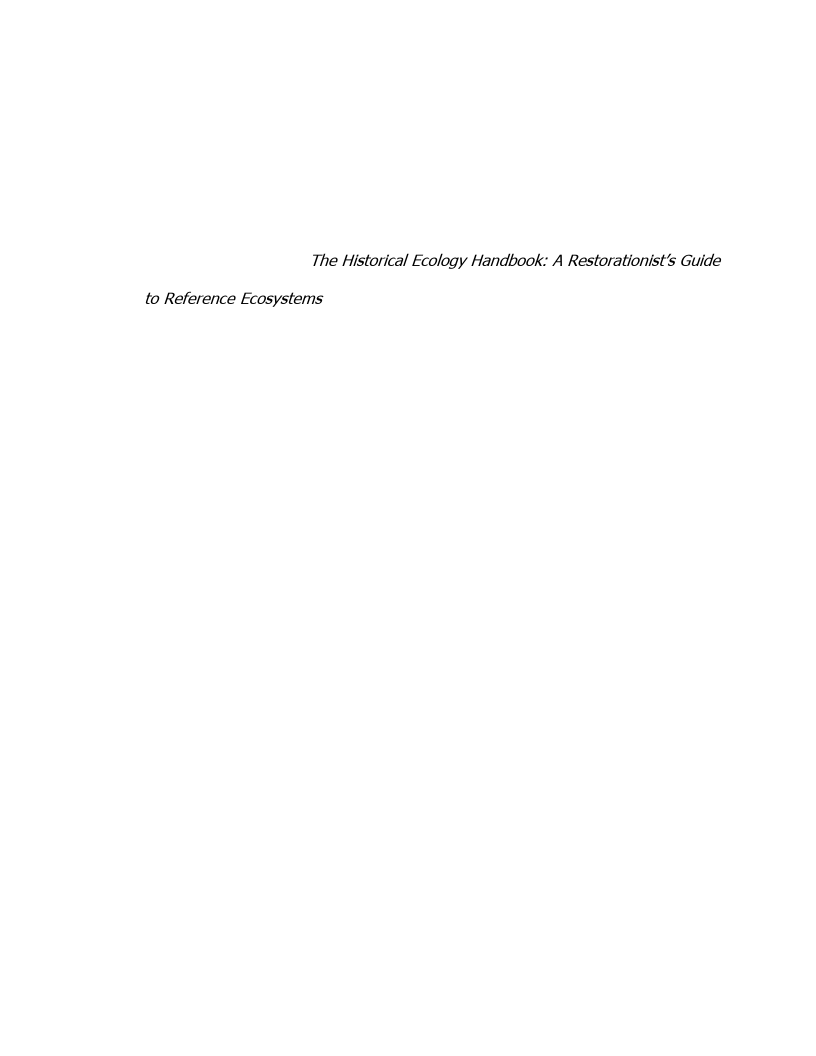
91
own balance in the park, losing the quiet voice of such a place, with all its
accumulated lessons would not be worth the assumed gains of a fully developed,
more civilized park. We need more exemplary places like Ravenna, not less.
The importance of places like Ravenna extends beyond their own spatial
and temporal bounds. The Historical Ecology Handbook: A Restorationist‟s Guide
to Reference Ecosystems posits that species should not be the sole focal point in
restoration efforts. Approaches of researchers represented in this book
emphasize evolving ecosystem roles and functions contextualized within
historical references rather a fixed picture of native species. Historical ecologists
emphasize detailed, careful and long-term study of reference ecosystems in
conjunction with ongoing restoration efforts. Cognizant of pervasive human
influences in present day ecosystems, they examine cultural as well as
environmental data in analyzing reference ecosystems. In recognizing human
influence, including our detrimental effect on landscapes, they affirm the positive
roles humans might play in restoration efforts. And in examining and
interpreting environmental change at different spatial and temporal scales,
historical ecologists emphasize a place‟s past explicitly as a means to ensuring its
future.5 Ravenna, as one of Seattle‟s most pristine reference ecosystem,
becomes a source of inherent wisdom as we begin to understand its inherent
wisdom as it evolved, and continues to evolve.
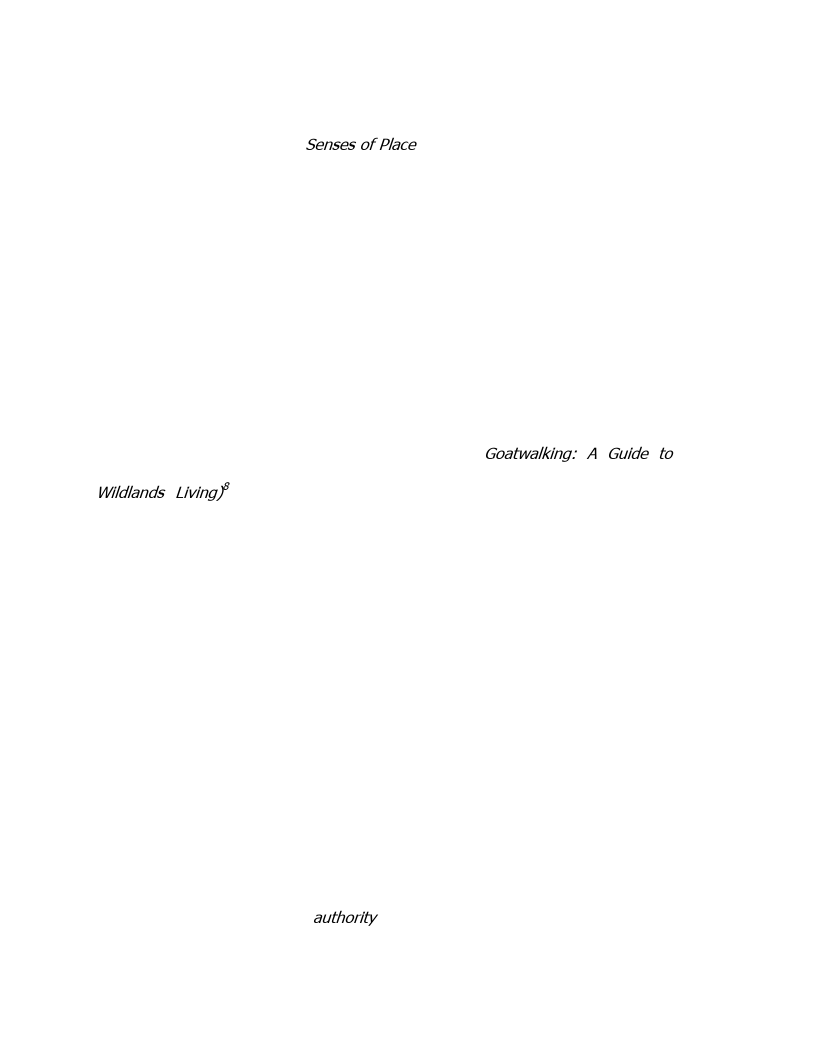
92
The phenomenologist Edward Casey asserts that “places gather.” In the Keith
Basso/Steven Feld anthology Senses of Place, he states “Minimally, places gather
things in their midst – where “things” connotes various animate and inanimate
entities. Places also gather experiences and histories, even languages and
thoughts.”6 I might add that places can gather stories, memories, imaginings
and ecological wisdom as well. Particular places become palimpsests of time.
Moreover, there may be reciprocity in the gathering; our bodily senses and
minds constantly collect information from place – and they from us.
Ethical relations with place, as proposed by Leopold in his much cited
„Land Ethic‟ essay7 and affirmed by Jim Corbett (Goatwalking: A Guide to
Wildlands Living)8 as well as other environmental philosophers, predicates
respectful reciprocity. Ethics implies a moral authority that intertwines with
attitude and action. When fully present with the land and within ourselves, we
enter mature relationships that attend respectfully to all. To me, this state of
absolute presence is as real as it gets. To be reciprocally real is the state one
might call “real-ationship.”
If all that places gather becomes part of the ongoing story, then our
ability to respond, to listen and engage in partnership rather than dominion help
humans remain a viable character in the land‟s tale of itself. Perhaps the
measure of ecological restoration projects should be their success as agents of
re-story-ation. Humans often act as if we were sole author of a land‟s narrative.
Recognizing a place‟s own authority may not only be wise but prudent.

93
Remarking on places‟ capacity for triggering self-reflective musing and
memory, Senses co-editor Basso comments “Place-based thoughts about the self
lead commonly to thoughts of other things – other places, other people, other
times, whole networks of associations that ramify unaccountably within the
expanding spheres of awareness that they themselves engender.”9 If places, or
physical objects within those places, can carry us into our own stories, into
deeply personal reveries of place-self, I wonder if such places and objects also
carry and convey stories of others who have lived and moved there; stories that
extend beyond our current understanding of the nature of place, or of time.
If we cultivate a deep, sensual regard for place, perhaps we can gather to
us some of the wisdom collected there. Ravenna‟s gift may not only rest in its
organismic diversity and spatial complexity, but in the many stories it has
gathered to itself, uninterrupted across the span of time only it alone recalls. But
even such places as Ravenna may not withstand the pressures of urban planning
and economic necessity.
“Hey, did you hear what the city‟s planning?” Angrily, my friend Pete explained
the City of Seattle Parks and Recreation proposal to “improve” Ravenna Park.
Green Lake is a popular recreation area to the northwest of Ravenna. Located
in a bowl of land lacking a natural outlet, cradling the runoff from surrounding
streets and parking lot, the lake had been in a gradual state of eutrophication.
The master use plan proposed by the city indicated that heavily utilized Green

94
Lake could be preserved by creating an outflow through the lightly used and
poorly regarded Ravenna creek, continuing all the way to Portage Bay near
marshes built upon junkyard landfill.
In typical bureaucratic doublespeak, the projected “straightening” of the
creek, the laying of concrete culverts and cutting of inconvenient old-growth
cedars were considered an improvement over the raw tangle of unimproved
Ravenna. Modern benches and picnic areas, wide paved paths, florid
landscaping, and surface lights would provide more “recreational opportunities”
to citizens denied access by the uninviting character of the old-growth park.
At a neighborhood gathering inside a graciously appointed older home at
the lip of the ravine, I found out that Pete and I weren‟t the only ones outraged
by the city‟s plan. Dozens of us crowded on couches, perched on folding chairs,
and squeezed into gaps on the floor as we listened to our neighbors; erudite
professors from UW, struggling students in thrift store clothes, old hippies and
new yuppies, testify both their love of the park and their anger over the
proposed improvements.
That meeting led to others. Our numbers swelling, we broke into task
groups, each with a part of the overall mission to elevate local awareness, focus
attention, harness energy, challenge plans, and win respite for the cedars and
the stream. I joined the publicity sub-committee and worked with a new-found
photographer friend to develop a slide-show and narration that was presented at
neighborhood meetings throughout Ravenna, nearby Wedgwood, and the

95
University District. Our charge was to raise consciousness and muster support.
We printed up t-shirts and wore them proudly. We wrote impassioned letters to
the editors. We sat in on interminable city council meetings and presented our
petitions. We railed. We rhapsodized. We hoped. We waited.
This was a different kind of educational process than I‟d ever experienced.
When I‟d left my eight year teaching career in the Northeast for an uncertain
future as a free-lance writer in the Northwest, I‟d summarized my educational
philosophy as follows: all learning begins with attention; what gets noticed can
be responded to, such response sits at the root of responsibility. During the fight
for Ravenna Park, I realized that my philosophy had evolved beyond traditional
education to encompass the personal and the political as well. Notice-respond-
responsibility describes an arc of reciprocal relationship. I‟d met Ravenna at my
most raw state and the cedars and stream had held and beheld me. As I healed,
I carefully looked back: the ancient majesty of towering red cedar, the ancient
evanescence of horsetail, the sumptuous periodicity of Himalayan blackberry, the
intricate weaving of creek waters threading the ravine and replicated in the
mychorreazal watershed of roots and soil.
The environs of Ravenna and its outlet Portage Bay wildly intoxicated me;
my blood, spirit and thought became now an inextricable part of the watershed.
How could I not take responsibility for that relationship? If someone held a gun
to the head of my lover or friend, would I not be compelled to intervene?

96
Several months into our guerilla campaign on behalf of Ravenna, the city
backed off its master plan and sought alternatives for the Green Lake problem.
They‟d failed to “improve” the park, but had unwittingly triggered compelling
improvements in the heart and spirit of a community. The grassroots „Save
Ravenna Park‟ coalition evolved in to several long-term community groups,
including the Ravenna Creek Association, which these days works towards the
„daylighting‟ of the entire creek from its headwaters in Cowen Park (upper
Ravenna), through the shopping malls of University Village, to the estuary at
Portage Bay. There is serious talk of returning salmon to this place which has
long missed their passage.10 Their story has been missed.

97
SALMON RETURN
Shadow, ripple, glint of sun-splashed scale
grace, perpetuation.
I imagine the return of salmon to this stream
which only half-remembers itself without them.
My fingers trace arabesque patterns on the surface of this still eddy
drawing runes as if through some ancient conjuring
I could bring coho or sockeye to this place.
Willow breaks and rip-rap, log weirs and re-vegetation
slope stabilization, habitat enhancement – no talisman or prayer alone
can restore this watershed to its memory.
Could it be, without salmon here, that I have lost
some vital memory of myself as well?
In the shade of red cedar, amid the bending of vine maple
and the incessant whine of mosquitoes, at the curve of this stream
this confluence of earth, body and water,
I wonder what it means to restore a full run of salmon to one another‟s souls.
Restoration of any kind is never so straightforward as we would wish.
This stream, pained by its longing, is comforted by its forgetfulness –

98
now used to the silt sheathing its gravel beds, adjusted to the uncluttered,
straight-line channels free of log snags and boulders,
currents which no longer invite salmon to their dance,
grown fond even of the introduced moments of brook trout and catfish.
To remember salmon is to welcome a certain pain.
It is not easy knowing that, in the endless cycle of riparian time,
in order for something to live and spawn something of you must die.
That is the way of salmon.
That is the way of souls.
I can not divert your heart from this.
It is not easy to know the law of salmon rivers – heron and eagle,
otter and bear will come to pluck the richness from you.
The river does not allow its abundance
to flow unshared (while desire chafes at such limits...)
Nor is it easy to recognize that in order for balance and integrity
to return to the course of a river or a life
everything must continually restore itself each moment of its existence.
But still I want these things for you, for me,
because there is no other way to know ecstasy and wisdom
but through the movement of salmon
in these places which have long forgotten them.

99
Heavy salmon fly through the air to the exhortations of admiring on-lookers.
This could be a view of leaping Coho or King at Ballard Locks‟ fish ladder, one of
Seattle‟s better known tourist destinations, where spawning salmon begin their
migration from Puget Sound, through the ship canal to Lake Washington, and up
various feeder tributaries. But this particular image of wild salmon in flight
captures hyper-active fishmongers tossing their expensive wares from ice bins to
wrapping stations before eager customers at another popular sightseeing arena,
one of the fish markets at downtown‟s Pike Place Market.
In a city marketing its wild surround, salmon represents big business. But
modern demand has long exceeded supply. Leveraging desire, entrepreneurs
began raising force-fed farmed salmon in the 80‟s. Savvy diners though, scoff
at the domesticated variety and seek the wild. Ecological as well as aesthetic
concerns may abide: farmed salmon are more susceptible to disease and die-off.
Operations often contribute to nasty algal blooms via nutrient pollution.11
Marketing competes with misinformation, pressuring further a species
close to its breaking point. People may live in the midst of salmon without
understanding much about them. A friend ordering his meal at a trendy eatery
overlooking the Lake Washington ship canal queries the waitress. “Is your
salmon wild or farm-raised?” She breezily replies “Neither, it‟s smoked.”
Pacific Northwest human cultures and salmon species intertwine, each a pioneer
in re-colonization as the Wisconsin glaciation receded more than 10,000 years

100
ago. For all our ingenuity, would we have readily survived here without the
richly fatted flesh of the regions‟ six tribes of Oncorhynchus; coho, sockeye,
chum, pink, king and steelhead. Hardy salmon pushed up the treacherous
meltwater rivers. Harsh glacial outwash would push back, wiping out whole
generations of intrepid fish, but still they persisted, till in the wake of the last
glacier nearly every watershed held its own native population.12
Humans followed salmon on their river rounds, gathering the time and
place for propitious hunting from the species and its natal rivers. „Up-running‟ is
the etymological origin of the word „anadromous‟ which connotes Pacific salmon‟s
migrations from birth in fresh water, out to the sea, and back again. Of the six
species, only the steelhead is not semelparous, meaning the rest return to spawn
and then die.13 How could a species so prolific, yet also so mysteriously resilient,
not capture the imagination and respect of indigenous peoples who counted on
salmon‟s abundance, and eventually celebrated its spiritual significance?
If places gather, then so do salmon. Salmon inadvertently gathered
native peoples to them in watersheds they colonized, but as they evolved they
also gathered something of their home waters to themselves that defines them
so strongly that wild hatchlings from one river released in another will quickly
lose their way and almost always die. Scientists speculate that salmon navigate
their way back to their exact birth water with a form of magnetic guidance, but
they also utilize an inordinately sophisticated sense of smell and taste to exactly
recollect their place. Author and Pacific editor of National Fisherman magazine

101
Brad Matsen compares the acuity of their scent sense to our detecting the
equivalent of one drop of vermouth in five hundred thousand barrels of gin.14
For all the odds stacked against them, the reality that any salmon survive
at all staggers the imagination. Only one in five eggs laid by a spawning female
may survive to become fry. Of these, but one in ten survive to find suitable
freshwater habitat to grow large and strong enough for their eventual ocean
journey (a matter of months or years depending on the species).15 Say that fry
survives freshwater predation and makes it to the river‟s estuary to rest and
adapt for its years of saltwater life. Each journey, way-station and destination is
fraught with peril – many hunters abound who savor the flesh growing salmon.
Thousands of eggs might yield one sea-based salmon capable of returning to
spawn, assuming it makes it back through the obstacles not only of predation,
but of engineered locks and electrical dams, of source point heat and toxic
pollution, and its own sheer weariness.
Some rivers have lost their salmon. Some salmon, the farmed variety, will
never know a river. A few rivers remain which still know their wild salmon.
Some bereft streams, like Seattle‟s Piper‟s Creek and maybe someday Ravenna,
may welcome again this species that can gather a river to itself, turn that river
into an ocean, and bring that sea home to spawn. These salmon may not start
out so wild – urban watershed restoration depends heavily on hatchery spawn –
but managers hope that subsequent generations of these fry will recall their
wildness, and perhaps help its river become wild again as well. But if a salmon is

102
made of its river, it might be said that a river is made of time, measured in the
cycling of flow from headwater to estuary, and from oceanic weathers to misty
rain back along their drainage. As threatened as salmon might be, their rivers
may be even more at risk. In restoring salmon to their rightful place, perhaps
we must first re-establish the rivers that welcome them.
It is one thing to learn what a salmon might need to sustainably exist, but
what of a river? Entering a time trance once more, I sift through memories and
experiences of Northwest rivers to see if I might discern something there native
to my own nature, and if in this I might recognize useful patterns that might help
me understand what it might be to restore salmon to a river, and to re-story a
river to its own place in time.
Rill, riffle, trickle, seep. Rivulet, freshet, brook, creek. Just as something in a
salmon compels it to return upstream and spawn, something in the nature of
water compels it to move and branch downstream. Two atoms of hydrogen
ecstatically embrace a single atom of oxygen and something in their union
echoes within a river and draw the salmon to its source. River water – like time
– is not restless but at peace with its motion. When I refer to a river, I do not
mean only the water that moves along its course from head to mouth or the
countervailing forces which influences its flow along the way. The river I am
talking about includes the stones and sand that massage its round belly, the
insects that spin and dart through its bloodstream, the waterlogged driftwood

103
raking a craggy hand along its bending torso, as well as the salmon seeking
perpetual life with the sacrifice of death.
A river is more than its surface; down where salmon struggle through the
current, there‟s another flow. A friend and I camped along the White River at a
slow bend, politely excused from the company of highway 169 on its way to Mt.
Rainier. Snuggled warm in my sleeping bag, I watched the stars transit the cold
sky for nearly an hour. Finally, I closed my eyes and gave myself over to pure
listening. In that calm just before sleep, I heard a new sound, a subtle vibrato.
I was no longer hearing the incessant chatter of surface water but the low,
dense moan of the deeper river where it rubbed against the smooth stones lining
its bed. It was a sound heard more with my bones than my ears. Only in the
stillness of that wilderness night, with my frantic pace of life slowed to a crawl,
was I able to detect the edges of that deep river song.
We know that salmon can navigate a river by their internal compass,
aligned to a magnetic direction each and every one of them knows. We know
that their sense of smell and taste and temperature sensitivity can detect subtle
nuances in each portion of their natal stream, unerringly finding their way back
to their spawning redd. Might a salmon also recognize the music unique to its
own river, a signature writ in tumbling stone? How would I, with my limited
senses, ever come to know a river so well?
A summer waterway in Idaho taught me about river acclimatization. A
friend and I had struck out on a trail beside a tributary of the Lochsa River. Put

104
several miles of hiking in ninety plus temperatures under a full sun together with
a wide bend in an inviting reach of water and skinny-dipping is the only logical
outcome. I boulder jumped to the middle and eased myself into the cool eddy
behind a huge promontory of stone. For twenty minutes or more I lay
submerged with only my nose and lips raised to the air. Anchored with my right
hand to the rock, I let my body ease out into the broad wash of the current.
When I stood to dry in the sun, my blood felt like it was no longer
pumping longitudinally but instead was yearning for lateral release. My whole
body, so used to vertical existence, adapted to the horizontal axis of the river –
the alignment that salmon know from the moment they hatch. For the next
hour, I felt like I was walking through an alien world – as if my blood
remembered more clearly my ancestral journey through the primordial waters of
life than my scrambles across the variegated landscapes of North America. If
indeed, mammals evolved from creatures of the sea, then perhaps for awhile I
had traveled back through time to my piscatorial origins.
From surface down to bedrock, rivers flow to gravity‟s undeniable call. A
river explains its insistence with the startling cut of the Snake River Canyon, with
the deep desire of the Columbia Gorge, even the persistent trickle of Ravenna
Creek, architect of its steep shadowy ravine. This isn‟t to say that rivers lack
diversions, nor its denizens need of respite. There may well be Type A
personality salmon, but few make it to their sacrosanct gravel redds without the
restful pauses provided by a river‟s eddies. This is also not to say that rivers lack

105
responsiveness. A river knows the lay of its land and responds accordingly. It
must be able to adjust its flow to the mass of its water, the bend of its banks,
and the inclination of its slope at any given point. Rivers define themselves with
a shape-shifting responsiveness. Whether examining rivers or personal
motivations, cultivating such adaptive sensitivity helps. A backwater eddy may
be a near ideal response to the intensity of rapids.
Even with its quiet places of recycle and reflection, a river knows where
it‟s going and uses its momentum to get there. Anything that impedes that
destiny can be damned (including, in the realistic, silt-laden frame of geologic
time – our monstrous, man-made dams). Efforts of the Army Corps of Engineers
and Bureau of Land Management‟s over recent decades to „channelize‟ rivers to
reduce flooding has, with no small irony, at times resulted in more frequent and
severe flooding. Re-engineering steals time and space from the river, slicing
through their meandering oxbows to hasten the flow of water through their
watersheds. A calculus of ranging volume and optimal flow creates the windings
of a river. Too much water moving through too little space in too short a time
creates a recipe for flooding. A river left to its own natural devices will inevitably
determine its most efficient course to the ocean. Particular salmon evolved to
dwell in particular rivers. As rivers alter, salmon adapt. But when humans
change the character of a river beyond recognition, it may be too much for even
a salmon to adapt to. Thus when we try to restore a stretch of water to again
welcome salmon, we need to see through time to the association cultivated

106
between place and salmon over millennia. Restoring salmon, or a river,
resurrects an ecological story told across the vastness of time.
Aldo Leopold used the river as a metaphor for ecology in the centerpiece
essay of his book entitled The Round River.16 The physical river (ably joined by
oceans, lakes and the natural processes of evaporation and transpiration) is
simply one portion of the vast, complete water cycle. Leopold‟s Round River
expresses a metaphor for the complex web of relationships which constitute the
cycles of life in our ecosystems. In such a river, the concept of head and mouth
seem arbitrary. Each stage of the river is essential to the whole and the Round
River flows in a full spiral. I suggest that time, like ecology, meanders in
intertwining cycles and flows much like a round river. Things may die along this
river, but only to feed another life. Ultimately, our continued meddling with the
Round River may result in our species‟ death. It might take a huge meander
around our disappearance, but it will keep flowing.
Perhaps our experiences and reflections along a body of water color our
perceptions and memories as much as the water itself; blood and thought
interweave with the flow. In this way, we become part of the river. In this way,
both river and soul become part of the Round River. It may not be enough to
return the salmon to a river, that they might come to know each other again.
Perhaps we need to cultivate our own kind of ongoing, reciprocal, and cyclical
intimacy with our rivers.

107
There is a slight bend on a small stream in Ravenna Park that I like to linger at.
Returning to that place is a kind of ritual. My fingertips graze the rippled current
in greeting. I sit upon the bank and watch the water pass. Sometimes as I gaze
at the water, whatever tangles my thoughts and knots my muscles seems to
dislodge from my banks, swings hesitantly out to mid-current and, picking up
speed, disappears from consciousness. I believe urban areas in particular, need
rivers to help sweep away the spiritual detritus from our lives (and thus may be
in need of another kind of sewage treatment for the “toxic soul waste” many of
us spill without treatment).
As I sat at my Ravenna bend one afternoon, I became mesmerized by the
motion of a small vine maple leaf spinning ceaselessly in an eddy at my feet.
Each time it looked as if it might unwind into the downstream current, it would
inexorably be pulled back into its own private Sisyphus myth. I wanted to reach
down to nudge it free. Was this a cycle belonging to a Leopoldian Round River,
or an ephemeral mirage, an interruption in time. Gathering wisdom from rivers
and streams, I felt the power of wild unmanaged waters. No easy task,
restoration – with rivers or souls, but sometimes all we require is the stillness to
hear the deep river rocks jumbling in our psyche, the sensitivity to detect the
current of emotions and desires, and the willingness to follow our true flow no
matter how the channel braids and meanders. Trust told me that ahead would
be the fecund richness of estuary, and beyond that the sacred path of the Round
River to return me to the headwaters of life, even in death. I began reading

108
about salmon habitat restoration, wondering what it might take for a city river to
remember itself, to rehabilitate its Round River channel of free-flowing time.
Why bother with urban ecological restoration? With wilderness quality
landscapes, both designated and undesignated, under continual economic and
political pressures, shouldn‟t we focus our efforts on landscapes not already
ravaged by human enterprise? Wendell Berry addresses this very question in the
essay “getting Along With Nature‟ in his Home Economics. While supporting
continued efforts to preserve wilderness, he cautions that we can‟t stop there.
Citing his friend and colleague Wes Jackson‟s observation that if we can‟t
preserve farmland then we can‟t preserve wilderness, he extends the
preservation paradigm to urban areas; observing that “…the same attitudes that
destroy wildness in the topsoil will finally destroy it everywhere… …if everyone
has to go to a designated public wilderness for the necessary contact with
wildness, then our parks will be no more natural than our cities.”17
Human culture and non-human nature, domesticity and wildness, to
Berry‟s thinking, are not oppositional but interdependent. Our economy must
align with our ecology, creating necessary reference points and places of refuge.
We need places where we can learn from and renew ourselves in wildness, not
just the large public tracts we think of as wilderness but “millions of small private
or semiprivate ones” as well.18 We restore wild salmon to Seattle‟s urban
watersheds not just for the sake of salmon, but for us as well. Lacking wild
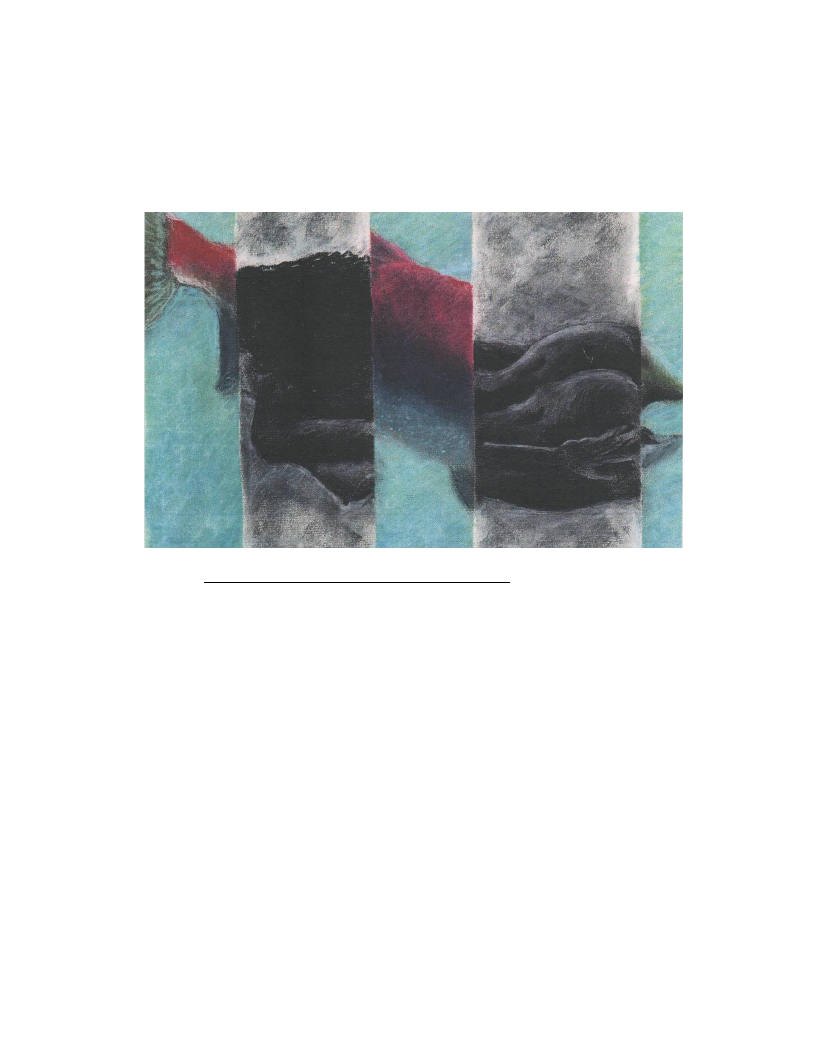
109
species in our city landscapes, might our species‟ long-term run on these
watersheds be endangered as well?
Figure 1: „Salmon Woman‟ – R.S. Russell, pastel and charcoal

110
TANGLED VINES
A mixed crew comprised of Latin American, African, Pan-Asian, European and
North Americans, colleagues in urban restoration work, once taught me a great
lesson about ecological reciprocity. A year or so after my Ravenna Creek musing
and personal dedication to restoring my own Round River, I‟d co-founded an
organization with a group of friends, Cascadia Quest, bringing young adults from
around the world to work with Seattle-King County peers to help restore the
land‟s vitality from wildland forests of the Cascades foothills to urban watersheds
like Ravenna and Thornton Creek.19 We worked explicitly with notions of
noticing the land, responding to its character and organisms, and recognizing the
inherent story of each place. Though at times we certainly acted in ignorance,
more often I saw young adults open their hearts and minds to places and let the
wisdom they‟d witnessed inform their actions.
Out in the field with a group of Cascadia Quest participants one morning,
the Pipers Creek restoration project manager instructed us to remove Himalayan
blackberries from alongside a stream being restored for reintroduction of salmon.
"Why are we cutting them down?" asked a feisty young woman from
Costa Rica.
"Because they don't belong here!" was his somewhat exasperated
response, as he railed on in brutal detail about the horrors of “invasives” like the
blackberry.

111
She shot back, archly. “The way you talk of this plant is the way some
people in your country talk about my people from my country when they come
here.” The project manager blanched.
"The blackberries are growing here now," a Kenyan participant chimed in,
"And they have much fruit. Surely something must eat them?" The manager
sighed, and tried to better explain the potential consequences to salmon and the
need for clearing the banks at that particular bend to allow more sun to
penetrate to the water. He offered that native salmonberry seedlings would be
planted, which would fill the blackberry niche in a few years. The question “But
what will the birds eat until then?” caught him further off guard.
A vigorous discussion ensued about the role blackberries may play in what
had until recently been a heavily disturbed area, as well as the ethical
responsibility humans should hold in addressing both the introduction and
eradication of non-natives. "If we were called the invasives," a woman from
Mexico pointedly offered, "how would it feel to be told we must be removed?"
One local restoration ecologist had told me that invasives like blackberries and
scotch broom were akin to "Band-Aid on an open wound." Spontaneously, the
group decided to create a little ritual of gratitude to the blackberries before
picking up their clippers and wading in. The project manager thanked us
afterwards for teaching him a new way to think about his work.
Contemporary discourse on eradication of invasive species strikes me with
interest and dismay. I don‟t wish to blindly defend invasives. Indeed, through

112
ignorance and arrogance humans have introduced non-native species to great
detriment in bioregions across the globe. Concerted efforts must certainly be
undertaken to restore ecological integrity to such areas. Success in these
endeavors often involves the replacement of exogenous species with indigenous
ones. Our mindset in this dwells more in the domain of ethics than biology.
Author and educator John Tallmadge has been involved in urban
ecological exploration in Cincinnati for a number of years. He cautions an
attitude of what he terms "environmental fascism" towards invasives.20 A
„Native good/invasive bad‟ point of view can be overly simplistic, even
dangerous, when applied to the complexities of deeply textured landscapes. To
the extent that human ignorance and arrogance contribute to introduction of
problematic invasives, we must take care not to project a parallel ignorance and
arrogance in eliminating them. I recall that blackberry afternoon, as well as
John's admonition, whenever I hear impassioned diatribe about the removal of
non-native species. As my Cascadia Quest crew showed, in whatever way we
choose to address the presence and possible removal of invasives, we ought to
offer the same respect and reflection to the plants in question that we‟d wish
towards us. After all, plenty of organisms may well consider humans the
invasive species most dangerous to the integrity of the ecosystem.
Like many larger urban areas across North America, Seattle struggles with
youth violence. Teens and young adults who do not fit the system become
stigmatized as problems despite the part poverty, bigotry, apathy or antipathy

113
might play in creating the conditions they habitually respond to.21 I see
blackberries and scotch-broom like they‟re gangs of invasive species; unwanted,
misunderstood, pushed aside. Plants like these are a natural response and
outgrowth within heavily disturbed areas. We may fail to understand that the
original disturbance in the area could be the root problem not the specific
species response (whether native or invasive). To restore both human and non-
human domains, we may need to honor the contributions of various respondents
to the disturbance rather than just angrily eradicate them.
In restoration efforts, we must make the environment more hospitable for
native species before they can take hold. Often this requires the removal of the
undesirables but I wonder if (with both blackberries and teen gangs) whether we
fail to interact with the community context in a truly restorative fashion.
Restoration of ecosystems may also require ongoing respectful relations with
species we wish to quell. Ironically, by the extended measures of ecological time
in the Pacific Northwest, humans may be the most dangerous invasives in
riparian habitats. Though I believe that for the most part people mean well with
our actions, good intentions don‟t guarantee ecological integrity. I find no easy
answers in these dilemmas, just an increasing need to understand and navigate
paradox in ecological thought and resource management.
How do we get away from our scientific hubris? One restoration ecologist
I met in the Pacific Northwest who was working on severely disturbed riparian
systems in a long-term salmon habitat restoration project expressed a need to

114
try to think first in 500 year plans rather than the standard government-issue five
year variety. From this perspective, he realized that he didn't know enough
about the optimal soil conditions for the desired native Western red cedar to
advocate total removal of the resident alders (regarded as a junk species by his
supervisors). He felt that the alders might play some role in restoring qualities to
the soil that would help prepare the way for the eventual return of the cedar.
Another restoration ecologist on the Olympic Peninsula told us at a
Cascadia Quest board meeting that when assigned a new project she goes out to
the site a few weeks early and tries to learn what that place is already doing to
restore itself. She sees her job then, to support and enhance already naturally
occurring restorative phenomena. I cite these as examples of the restoration
science I wish to advocate, one which works humble harmony with the
particularities of a place and recognizes that humans need to be particularly
cautious in addressing restoration work. In cutting our way out of the tangled
vines of urban restoration dilemmas, we need a new way to view not only where
we‟ve been but where we‟re heading.

115
CINEMATIC ECOLOGY
A trench-coated figure perches on a gold statue overlooking the hazy Berlin
skyline, ruminating on sights and insights from his day. Suddenly, he dives
towards oblivion, a kaleidoscope of images running through his consciousness as
if his life were passing before him. As if, because Cassiel and many other
characters in Wim Wenders‟ 1987 movie „Wings of Desire‟ are eternal angels.22
From the beginning of time, they have been observing, listening, and recording
the passing of eternity. “Before humans, we didn‟t know laughter” observes
Damiel, Cassiel‟s best friend and the movie‟s protagonist. His yearning to taste
the human realm he has observed for millennia feeds Damiel‟s existential angst.
One day Damiel sees a trapeze artist in rehearsal, follows her into her dressing
room, and witnesses her private sorrow touched with grace. Deeply moved by
the moment, Damiel‟s desire for Marion crystallizes into a decision to give up his
immortal status for human mortality.
We hunger for full, long lives; who of us would give up eternity? But the
look of bliss blossoming on Damiel‟s face as he sips his first cup of coffee after
passing the chasm between angel and human, cradling the paper cup in his hand
like a sacrament, suggests that time alone does not richness make. Being
sensorially present, alive in each new moment, creates its own kind of eternity.
Angels may watch the world forever, but they can never touch it. What is time
without relationship? Which would you choose, Wenders asks us?

116
Afterwards, I emerged from the theatre into an otherworldly urban
nightscape. The streetlights pulsed with a hidden light, further concealing the
rooftops in reinforced darkness. I imagined angels there musing over my own
existential dilemmas on the paradox of restoring time in a disturbed place. But it
was not merely the themes of this film alone that informed my thinking about
temporal ecology, but reflections from movies in general. Long denied the
experience of seeing a film in a theatre (we did not own a car as I was growing
up) cinema for me became suffused with a kind of longing. I‟d scan the local TV
channels late at night, ostensibly seeking old movies but really searching for a
window outside of my own limited time and place. For the duration of a film, I
could transport myself to distant landscapes and imagine myself into the past or
future. Cinema my have been my original experience of time-transing.
Restoration ecology can be defined as the re-establishment of a set of
native species to a particular place from a historical time. Slavish restoration to a
previously extant image of an ecosystem is akin to processing a photograph. A
fixed picture of ecological composition burns to the negative. We measure
success by the accuracy with which the rendering occurs. Such practice assumes
that the contextual background and practical foreground of the photo never
changes, so that the original subjects will always be held in the same way.
In returning indigenous species to their historical habitats, an underlying
supposition of fixed-picture restoration holds that if an organism thrived there
some number of years ago, they should be made to succeed there now. Staff

117
biologists and project managers compile and assemble their native roster,
assiduously excluding non-natives from the team. Charismatic threatened
species are the superstars, made welcome at all costs. We vilify invasive
competitors. We yearn to eradicate non-natives and perpetuate natives.
Theoretically, in a successful restoration project, some equilibrium occurs in
which indigenous species naturally rule the roost and biologically expel the
invaders. The composition of the picture is rendered complete.
While I don‟t mean to diminish the overall import and efficacy of such
efforts, I do want to call into question the base assumption of “once native –
always native/Johnny-come-lately invasive – never welcome at the table” ethic
present within modern restoration ecology practice. Recalling the Piper‟s Creek
project where Cascadia Quest team members had cast doubt on absolute
blackberry removal, I wondered whether that urban/suburban watershed could
even be reasonably compared to the pre-settlement Piper‟s Creek, let alone
restored to its prior conditions and composition.
Local ecosystems, however, are seldom as static as portrayed in fixed
picture models. Take Piper‟s Creek for example. Most likely, salmonberries
flourished there during some periods of the past. On soils laden with post-
industrial detritus, amid conditions subject to modern human agency, in habitat
utilized in a vastly different manner; who‟s to say current circumstances
contribute to salmonberry success? And while Himalayan blackberries indeed

118
cause their share of problems, who can say they don‟t at the present time best
fill a necessary niche in this particular place?
My bias sees biological succession and evolutionary process as more like
moving pictures than fixed ones. Living processes are not static and inviolable;
we measure ecological success as much in terms of flexible resilience as in
species persistence. The notion that climatic, geologic, hydrologic and biologic
conditions across a landscape, let alone pertinent speciation, never change
becomes especially ludicrous from an expanded lens of time. What does
indigenous mean on time scales of 10,000 years or more? How long does an
invasive need to be present before it‟s seen as native? Move back in time long
enough ago wouldn‟t even salmon be an invasive?
Complicating matters, many reference ecosystems have disappeared or
been severely negatively impacted. In casting characters to fulfill complicated
and ever-changing roles in urban habitat restoration, perhaps we could examine
the scripts of other eco-cinematic settings as a basis for comparison.
Some slopes in Washington‟s Central Cascades resemble mange-ridden dogs
more than picture-postcard mountainsides. Clear-cutting will do that to a place.
It must be duly noted that Northwest lumber companies vigorously protest that
they do not practice indiscriminate razing of entire tracts of woods; after all they
leave buffer strips several trees thick along drainage areas.23 Perhaps the

119
mangy dog metaphor should be changed to a classroom of teen boys with thin
mo-hawk haircuts.
A friend and I decided to take a walk trough a clear-cut one day, to
immerse ourselves in that pained landscape and try to put a close-up ecological
face on the rage and sorrow we feel when we see such places from a distance. I
nearly cried when I saw the twisted remains of a slash pile near where we
parked the truck. I gazed up to a long thin line of trees angling up the hill,
probably tracing the route of a feeder stream to the river we‟d passed in the
valley below on the way in. We skirted around the slash and walked up into the
middle of the cut, parting there each to be alone with our thoughts. I found the
remains of a Doug fir stump and sat down with my journal. A butterfly lifted
over a nearby downed log and floated towards me. Small birds rustled in the
berry bushes already sprung up in the space created by last year‟s logging. A
raven lazed overhead, gurgled its call.
I was surprised to be feeling tranquil, not enraged. I tried to summon my
righteous wrath but was distracted by a columbine rising to the right of my
stump. The homily “hate the sin, but love the sinner” came to mind. I can
respect the hard work and obligations of area loggers, but can‟t muster much
affection for the CEOs of multi-national logging companies squeezing every
board-foot they can out of these lands while just barely following the law. But
what of the sin? This land seemed intent, if not on forgiveness, then on going
about the business of patching over the wounds and getting on with the business

120
of ecological vitality. The visit became a reminder that even the most egregious
human-caused disturbances can be ameliorated with time, sometimes less time
than I would imagine necessary given the severity of the wounds.
But despite the short-term vitality of this clear cut clearing, it‟s difficult to
project the mid-term prognosis for that place. Evenly placed evergreen seedlings
throughout the clearing bore witness to the likelihood that this area was
intended for future logging, once these young firs reached adolescence (maturity
would be deemed too costly to the lumber conglomerates). How many frames
could be cut from that forest movie before original plot could no longer be
discerned? How many extras would be cut from the cast because they‟re not
productive? Would the stars of the show continue to show up if all they get in
the end were an ignomious death scene?
Along with humans and salmon, the thick-trunked Douglas firs and
western red cedars colonized the post-glacial Northwest. Shading the adult
spawning and fry feeding grounds, these trees ameliorated the temperatures of
shallow up-slope waters. Some like it hot, but not coho and Chinook. Without
the protective cover of the tall trees, some salmon habitats literally cook their
salmon into submission. Similarly, when salmon thirst for fresh-water habitat,
they want it clear, and they want their gravel out in the open and easy to move.
Silt from denuded forest slopes wreaks havoc on the salmon‟s preferred
setting.24 If Oncorhynchus could forgive, I‟m not sure they offer it to logging
operations. But then again, the prospects of clear-cut creek-beds may make the

121
Piper‟s and Ravenna‟s Creeks of urban Seattle seem a paradise in comparison.
Sometimes the new story might be preferred to the old, with history and
speciation plans rendered meaningless.
Arrays of conical, evenly-spaced mounds radiate out from where I stand. This
otherworldly landscape asks many questions and answers few. Mima Mounds
Natural Area Preserve, located an hour south of Seattle in Thurston County,
Washington, is called glacial outwash prairie by geographers though its genesis
and composition bear little resemblance to Midwest short, mid and tallgrass
prairie varieties. Theories abound for the mounds‟ origin, none proven. Though
in my mind it‟s an absurd proposition, some scientists argue that giant pocket
gophers once dug out these mounds. Other theories depict geological origin:
frozen chunks of ice-age prairies fractured by repeated freezing and thawing,
erosive engagement coupled with floodwater action, the shaking of seismic
activity rearranging the course soil materials.25
I‟d initially traveled there on a time-trance kind of day; dense fog eddied
around the mounds, the air so moist that I was immediately soaked though no
rain fell. Mist shrouded the fall-dried remains of camas plants (prized by Native
peoples for their nutritious roots), numerous ferns, several mosses, buttercups,
St. Johnswort, and reindeer lichen, each growing in its own specialized niche at
particular heights and orientations along the mounds. Examining the mounds

122
floating in the mist, they seemed more like islands than prairie. Even without
the fog, this would have been an otherworldly place.
Origins of Mima Mounds may be obscured from scientific certainty, but in
those uncertain mists loom the glistening bulk of glaciers that traveled through
these parts several millennia before recorded history. Historical glaciation has
forcefully and absolutely altered the character of many North American
landscapes. Physical and climatic changes associated with the ice ages seemed
a bit like wiping the hard drive clean on our computer, only in slow motion.
Species software that ran on the pre-glacier platform didn‟t necessarily reboot
afterwards.26 Examining long range overhead photos of Mima Mounds, I note
the gradual reclamation of “prairie” by alders and pines. Should encroaching
trees be eradicated, preserving this ecological relic?
Restoration is a complicated term. I‟ve watched restoration ecologists pull
blackberries from stream banks, cursing them angrily as they did so, without
ever questioning our destruction of one habitat to cultivate another. I‟ve spoken
to homeless teens, including former gang members, whose notion of community
and loyalty was of shared protection from the violence surrounding them, and
whose experience of that community was continually disrupted by social workers,
police and other public officials who failed to understand the naturalness of their
communal desire. Human desire may be less the problem than the particular
pathways towards and objects of our desires; there remains for us the need to

123
acquire a mature, cohesive and indomitable wisdom to provide alternative means
fulfilling desire without destroying the habitat of desire itself.
If reference ecosystems are shrouded in mystery or lost in oblivion, it is
equally confusing to find our models of restoration in city settings. Historical
ecology may offer some but certainly not all the answers, especially in
obliterated urban areas. Long-term study may indeed be necessary, not just of
extant ecological remnants of coastal forested, riparian habitats, but also of
healthfully functioning human community and cultures. We not only need to
learn from what has functioned but also may need to find new models of
working with each other and the land. Matters of scale, both spatial and
temporal, must be as considered in urban settings as in wild ones in ensuring the
future of native species as well as selective invasives, including humans. As
explored in the next section, what seems tame at one scale and view may reveal
elsewhere a side of wildness we might otherwise miss. Reference points we use
today build on the detritus of earlier ones, a palimpsest of misty markers.

124
NURSE LOGS
A murmur of cascading water soothes jangled urban nerves. A soft breeze off
Puget Sound stirs the burgeoning foliage, releasing tantalizing herbaceous scents
and rippling a chiaroscuro of flowery reds, oranges, and violets. Scenes from a
remote rainforest glade? Hardly. This paradise is located just a few blocks away
from downtown Seattle‟s epicenter. Water courses from a home-made solar
fountain. Herbs and flowers overflow from carefully tended garden plots. I
kneel on thick rectangular stones liberated from an abandoned pile of trans-
continental ship‟s ballast, now repurposed as paving around the fountain.
In a city well known for its network of community gardens, Belltown P-
Patch is the first created on downtown real estate. In past incarnations a
parking lot, homeless campground, and heroin shooting gallery, this garden
sanctuary was envisioned by a tenacious collection of artists, activists and urban
environmentalists.27 Made real by a combination of public and private funding
and community sweat equity (one of the grants matched each volunteer hour
with fiscal remuneration) Belltown represents one of the crown jewels of the P-
Patch system.28 Located two blocks away from my then workplace at Antioch
Seattle, I jumped at the opportunity to become involved. Volunteers layered
rockery terraces along the sloped hillside, dug trenches for gravity fed water
lines, crafted wrought-iron sculptural fences and gateways around the perimeter,
and created broken tile mosaics along the stairways and retaining walls.

125
This renewed greening of Belltown flies in the face of recent years of local
real-estate speculation and condominium development. When I‟d first come to
the area, Belltown was in transition from light industrial use to a crucible for
creativity. As lower rents on the outskirts of the city drew businesses away,
opportunistic artists, musicians and filmmakers moved into the barren
warehouses and clunky industrial habitat to establish working studios,
cooperative galleries and funky cafes and neighborhood restaurants.
Gradually, urban and suburban seekers of the next cool place began to
descend on Belltown each weekend. Before long, buildings that once housed
artist squatters were bought, torn down, and rebuilt as urban chic
condominiums. Within ten years, nary an artist loft remained; toney restaurants
and trendy bars now line the streets, expensive shops sell retro designer
clothing, and gated garages protect condo owners‟ Lexus‟s and SUV‟s from the
homeless remnants who still dare to wander the Belltown streets in search of
Social Services now largely pushed out of the neighborhood.29
Are condo owners now the native species in this habitat? Should the old
artists be restored to their niche? Might the displaced homeless be an
endangered species? Perhaps the elder Kwakiutl and Tlingit should be allowed
to hunt upon and gather from this habitat. Maybe native grizzly bears will be
lured back as baristas at the coffee bars. Whose place is this, really, and who
can say where the arrow of time should ultimately land?

126
Continuity may be an endangered concept in urban areas. Humans
impose successive disjointed uses, paradigms and intentions on city places rather
than organically evolving them from remnant place patterns. It resembles not so
much an integrated cinematic narrative as a slap-dash experimental collage. We
tear down and pave over reference points in city-scapes; no vestige remains to
trace back to an original purpose. How do we restore an urban landscape when
we no longer can trace processes to original ecological reference points? Surely
there are patterns to renew such places, but how do we determine them?
Such questions leave me bewildered. I made a temporal pilgrimage out
to the Quinault rain forest on the Olympic Peninsula to catch a glimpse of what
Seattle might have been like before people arrived, before the arrow of time was
splintered and diverted. In a time trans to my first sojourn years ago, I recalled
the drive out South Fork Road towards Graves Creek shrouded in a rolling fog
spawned by late afternoon showers. Several miles from the campground, in the
near dark, a darker bulk, then another, and still others, appeared to the left of
the car. A small herd of Roosevelt elk lifted heads from their evening meal, and
stayed as I watched in awe till my eyes could no longer make out their shapes.
The next morning, hiking the trail out towards the Enchanted Valley, I‟d
craned my neck at monstrous specimens of Douglas-fir, western hemlock, Sitka
spruce and western red cedar, draped in their omnipresent scarves of old-man's-
beard lichen. That day I hiked over seven miles before reluctantly turning back
to return to my tent at Graves Creek.

127
The overriding mystery of that sojourn was not how such large trees had
attained their bulk – the abundance of rain and temperate clime made this a
place of mystical abundance – but how new seedlings ever found purchase
among the giants. As with salmon, the forming of a new generation stretched
credulity. I recalled the many downed, slowly decaying trunks with their covey
of saplings sprouting along their length like spines on a razorback hog. I learned
that by such means, many young trees get their start.
These coniferous parent trees are called nurse logs. Whether by virtue of
the water retained by the well-rotted wood through the dry months of summer,
the piggyback ride up above the forest undergrowth towards the much-needed
light, the safety such a perch may provide from browsing elk, or the nutrients
released by gradual decay of the parent material, their seedlings delight and
depend on the advantages given them by the platform of their elders. In many
locales throughout the rain forest, we might readily trace parent and child
generations of trees from the straight lines and intermingled roots of siblings
rising from a single long trunk; from columnar buttresses left where forest debris
has filled in spaces between the growing prop roots where once the old nurse
log lay.30 In an environment where the clamor and fervor for life and light and
height roars at a frenetic pace, I marveled at the ingenuity of each generation of
those grave and serious conifers to give a leg-up to the new generation. If not
for nurse logs, certain rain-forest species would not persist. My study of ancient
forests lent me insights about the palimpsest of my own ancestry.

128
“She took a turn for the worse last night. The doctor‟s say she probably won‟t
last the day.” I felt like a bystander in my own body, eavesdropping on this
early morning conversation with my sister Ginger, who was updating me on the
perilous condition of our mother. Mom, in and out of the hospital for months,
fought for breath and life from the effects of congestive heart failure. Seattle
was a long ways from our family homestead in rural northeast Pennsylvania. I
tried to bridge the distance with daily phone calls.
Her extended hospital stay severely crimped Mom‟s daily outdoor rhythms.
As the illness had worn on, it became a habit for me to take long walks each day
to both clear my mind and to gather natural experiences that I might pass along.
I intuited that separation from her gardens, flower beds and bird feeders was on
some level contributing to her demise. For a few minutes each day, Mom could
close her eyes and pretend she was out walking with me.
Some folks lay claim to green thumbs – I think my mother was green to
the shoulder blades. Our hard-scrabble land was her haven where she‟d learned
to tease splendid vegetables and flowers from the uneven terrain and stony soil.
A good half of our food was garden raised or wild found, eaten fresh off the vine
in summer or jarred and frozen against the cold, snowbound winter. Paradise
was a wild strawberry excursion to the spring fields and pastures. Nirvana was a
dinner of sun warmed summer tomatoes, and corn direct from the stalk to
boiling water. In such ways, Mom became my nurse log.

129
In her late sixties, Mom had become an avid birder. I was impressed with
her thirst for new learning at an age where others often begin to shut their lives
down. She pored over field guides, listened to tapes of identifying calls. She
hung seed feeders and suet bags and fought constant battles with recalcitrant
robber-squirrels. An occasional black bear would leave paw prints high up on the
living room picture window where it would reach to snag the sweet bundle of
rendered fat. She scolded our bevy of semi-wild hunter cats into submission; a
single glance from her and they would slink off into the shrubs. She planted
berry bushes and fruit trees, as much for the birds as for us, and cultivated
special flower varietals because hummingbirds were fond of them. I returned
home from college one winter and arose early one morning to an empty house.
Mom was in the back yard; two chickadees feeding out of her hand, a third was
perched on her shoulder awaiting its turn.
Stunned and dismayed after I‟d shakily hung up the phone with Ginger, I was all
too aware that these could well be my mother‟s last hours. With no way to get
to her bedside in time to offer comfort, all I could think to do was to take one
last long walk with her, to smell each new flower, watch each flitting bird, and
take the fresh air deep into my lungs. I anticipated an ominous flashing red light
on my answering machine when I returned home, but for the moment I‟d drink
the world into me, as if my senses had somehow merged with hers.

130
Against drizzly weather, I donned raincoat and backpack and struck out
towards Shilshole beach, a grainy, pebbly strip of shoreline on the north side of
Seattle looking out across Puget Sound to the cloud-shrouded Olympic peninsula.
I walked to the beach that day not only to soak in sights and sounds for Mom,
but to let wind and waves wear away my emotional and spiritual malaise.
I scooped out a hollow in the stony upper beach to fit my body and shield
me somewhat from the stiff northeast wind. Gulls danced and swooped along
the tops of white-topped breakers looking for wave-tossed breakfast. Two crows
incessantly cawed from a small plot of woods behind me, like cranky commuters
awaiting their morning coffee. A fine mist began to play out from the low,
scudding clouds.
I may have lain there for hours; alternately napping, writing in my journal,
and staring out at gray-black mountains, gray-white bank of clouds, roiling
green-gray water, and the sandy, stony gray stretch of beach. My dark,
monotone mood of dismay gradually gave way, shading into occasional nuanced
tones of easy calm and bright flashes of curious wonder. A sandpiper unerringly
tight-roped the ragged edge of the advancing and receding tide line; racing
forward to peck at a bit of edible flotsam, sprinting back on thin legs just ahead
of the frothy swell. In the middle distance, a single log bobbed and swayed,
perhaps an escapee from one of the floating logging rafts made up of trees
stripped from the Olympics. Two herring gulls rode opposite ends of the log,
fidgety and distant as two strangers on a bus stop bench. Pebbles ground and

131
water seeped in low voices down below. They reminisced with me and told
stories from far shores that temporarily took me away from my troubles.
As I walked away along waterfront boardwalks past quiet marinas, I heard
a loud shriek. I looked around – no other humans in sight. I looked out on the
water – only waves and the distant ferry chugging towards Bainbridge Island. I
glanced up and saw two crows dive-bombing an osprey, which cried out again as
it tried to elude its antagonists. Crows in spring, smarting from any number of
perceived slights with nesting time just ahead, can drive off far larger foes.
Maybe it was the same two cranky crows that had berated me earlier that
morning. Perhaps they were just in the mood to be annoying. The hawk could
not shake them; they poked and pestered the larger bird which could not out-
maneuver their looping feints and stabs.
An image of my mother came to me of her in hospital bed, amid a tangle
of tubes, breathing laboriously, fighting off the pain dive-bombing her body.
Suddenly, the osprey shot straight up, its wings stock still and spread wide to
ride the updraft. The crows tried to follow but could not gain the altitude and
quickly gave up the chase. The hawk remained however, circling slowly straight
overheard as I walked along the shore. For a good twenty minutes I was
mesmerized, craning my neck upwards as I walked. For the first time, the
death-grip I‟d held on a life-wish for my mom began to loosen. Sometimes in
the face of pain and torment, all a body can do is rise and leave it all behind. At

132
the thought, the osprey wheeled and sped out across the water, soon lost to my
sight in a shroud of mist.
I believe it was during those trans-generational-spatial walks with my mother
that I truly experienced her as a metaphorial nurse log. We are often
encouraged to consider our descendants in each and every action, as if what we
do this moment might ripple out across succeeding generations. It occurred to
me that our responsibilities in the present might also extend to past generations
as well. Perhaps we the living become the sensate link back through time to our
people who no longer possess living human sight, scent, hearing, taste or touch.
Suppose during each and every moment, at this present and transient place, our
roots extended back into the soul-soil of our ancestors, as our branches
stretched out towards the soul-sky of our descendants, as our leaves turned the
energy of the sun into sustenance for both. What if death were seen not a
period in a sentence, but a pause in an exceptionally long story?
We modern Westerners live in a culture which attempts to deny death at
every step. We go to extraordinary lengths to prolong life. Perhaps we feel we
can hold death at arms length if we do not speak its proper name. But death
reveals itself as an integral part of life.31 When a fallen Sitka spruce lends
support, nutrition, and vital moisture to a new generation of conifers, who‟s to
say that that tree has actually died? Aldo Leopold, in a brief essay entitled
'Odyssey' from his classic A Sand County Almanac, wrote of the journey of one

133
"atom X" as it passed from rock to flower to oak to deer to Indian and onward.32
To me, his essay suggests that all matter ultimately journeys like atom X. Time
transforms and matter gets around.
Each of us provides not water or nutrients or mycorrizal tissue to those
who survive us. In our physical realm, genetic material circulates from one
generation to the next. In cultural, emotional and spiritual ways, all who‟ve
come before influence and augment the paths our lives take. It can be argued
that we each contain physical aspects and cultural relicts of the very first
prototypical humans to walk the earth. Tracing the long journeys of evolution
and ecology, we find common material with all living things. From this
perspective, who can say exactly what has ever died? When life continually
renews itself from the detritus of death, the distinction between living and non-
living blurs and boundaries fade in the mists of time.
With thoughts of descendants and ancestors and my dying mother
mingling in my senses and mind, I returned from my long walk. As expected,
there was a little blinking red light, but quite unexpectedly the message was that
Mom had suddenly rallied over the course of the day, and was now sitting up,
alert, and joking with the staff and her visitors. She‟d soared high above her
travails, even above death perhaps, to live another day.
Who are the nurse logs in our culture? On whose flanks might our troubled
youth and communities gain purchase to better affirm life? A colleague at

134
Antioch University Seattle left a flyer in my mailbox about a new organization she
was trying to build. Seattle Youth Garden Works gave homeless teens a chance
to gain literal and figurative grounding in their lives; participants worked daily in
one of a number of area P-Patch plots, learning to till the soil and nurture new
growth for sale to upscale restaurants and farmer‟s markets. Our staff offered
workshops on resume writing, interview skills, and coping with the disturbing
circumstances of their transplanted lives, interspersed with hands-on work.33
Some made it off the streets. Others chose to stay, squatting in
abandoned buildings in small tribes of their peers. To many, the active nurturing
– of gardens, of their own fragile circumstance – was a new and inspiring
concept. Working in the gardens gave a routine to their days, a Zen-like
mirroring of the notions that staff tried to instill. I joined the board and tried to
build alliances with organizations I‟d met while helping to co-found Cascadia
Quest. We attempted to raise money as well as consciousness; a local grunge-
rock band organized an all-ages concert and dance as a benefit. Off-peak
garden times, participants made crafts and sold them at local fairs. By these and
other ways our organization became a nurse log for an otherwise neglected
youth. In another sense, we adults were also preparing the gravel redds that
might nurture and protect the next generation to hatch into society.
Odd that these garden varietal plants, utterly domesticated, now offer a
wild context suggesting old-growth forests succession. The co-mingling of
generations; older adult staff and volunteers taking the time to serve youth

135
makes a kind of nurse log. Standing back a step to look at Seattle Youth Garden
Works participants, I no longer saw damaged goods but living organisms
delighting in the opportunity for growth. They did not deny their difficult
circumstances, nor did they revel in their outsider status. They simply lived to
the best of their ability, and thrived when given a chance. In the process of
becoming an elder in my familial clan, I wondered what parts of me were
becoming nurse logs for other aspects of me. Was something in me an
intergenerational folding of old-growth into new opportunity as well?
Every tree in an old growth forest was once new; any given spruce or
hemlock may be only the latest of a long run of coniferous ancestors. Biological
organisms adapt and change constantly, but possess a general stability within a
state of dynamic equilibrium. Like all living organisms, humans are creatures of
change; our emotional, physical and spiritual states a dynamic whirl of transition.
Perhaps in our tendency to think of our lives as an uphill progression we fail to
take full advantage of the fecund potential in each prior moment or experience.
If we let each moment, each loss, each 'little death' be a kind of nurse log, we
might not find enlightenment – but we might find some essential nutrition and
stability in order to stand healthy and full in our own forests of the soul.
One morning a month or so after my long ancestral walk, in a mid-May phone
conversation, my mother seemed particularly weak. She barely acknowledged
my stories. A long silence stretched between us, punctuated only by labored

136
breathing. Finally, faintly, she spoke. “I‟m giving up. I‟m ready to let go.” The
words came out like a whimper. There was nothing more to say but “It‟s OK. I
love you. You‟ll always be with me.” I hung up the phone, knowing I would not
hear her voice again. Despite the many times she‟d returned from the brink of
death, this time I knew she was ready to cross the threshold.
I walked to my garden plot in the Belltown P-Patch, and sat on the ground
amid the growing vegetables and herbs, clutching the soil in my fingers. I
wanted to be in a place like one that had so nurtured my mother, a habitat that
nourished all of us in the family in turn. I yearned for comfort but felt only raw
pain, and an indecipherable edginess. It felt all the grief in the world gather
itself and sit in a lump in my chest, yet I could not cry, I could barely breathe.
The piercing calls of gulls gave voice to sorrow.
I glanced up to the sound and the hair rose on the back of my head. Two
herring gulls badgered a large gliding figure. The hawk careened and swooped
but could not elude its attackers. They dove and swerved over my head for
several tense minutes then suddenly, as the murderous calls and dives of the
gulls reached frenzy, the osprey caught an up-draft and rose precipitously above
the battle and calmly glided away. My mother died later that day.
Do landscapes die? Certainly species do. Cultures? Neighborhoods? Urbanist
writer and activist Jane Jacobs authored her seminal work Death and Life of
Great American Cities in 1961, a stirring critique of contemporary urban renewal

137
efforts sweeping North American cities.34 She took on the sacred cows of urban
development: high-rise projects for the poor amid manicured expanses of grass,
iconic monumental civic centers isolated from commerce or industry,
expressways speeding traffic through or around a downtown core on the way to
gated suburban villages and easy-access shopping malls. Efforts to carefully
craft model living cities were instead killing them, Jacobs contends, because they
ignored simple and discernable principles that gave great cities their vitality.
Real cities are messy she claims, and should be studied closely for what
does and doesn‟t work. Tongue in cheek, her entire contents under „Illustrations‟
states “The scenes that illustrate this book are all about us. For illustrations,
please look closely at real cities. While you are looking, you might as well also
listen, linger and think about what you see.”35 She cites four general principles
underlying the liveliness of an urban area; concurrent mixed primary functions
(e.g. housing, industry and commerce) to insure the presence of people at
different times for diverse purposes; short blocks encouraging foot traffic and
neighborhood intimacy and integration as opposed to isolation; close-grained mix
of age and condition of buildings to promote a varied range of economic
enterprise; sufficiently dense concentrations of people, especially those in
residence, to cultivate convenience, and multiple aspects of human diversity.36
Her final point about density deserves a bit of explication. Jacobs
differentiates quality density – that which stimulates liveliness by bringing diverse
mixes of people into meaningful interaction with each other – from

138
overcrowdedness. Overcrowded housing means high numbers of residents per
unit, which can lead to any number of well documented social ills, while density
refers to the number of housing units on a tract of land. High density housing
does not necessarily mean overcrowded. In particular, she cites New York City‟s
Greenwich Village and Boston‟s North End as early 60‟s exemplars of quality
density offering lively community.37
Two factors stand out in my contemplations of Jacobs‟ work. Operating
beneath her four principles, I find a single unifying theme of commingled variety
and diversity. Vital neighborhoods exhibit sufficient people out and about on
intimately situated streets at all times of day and eve for a variety of reasons.
They live and work in heterogeneous buildings whose different ages and
conditions lead to a cascading range of economic opportunity. These other
factors in turn can welcome population density rich in different age, class and
other diversities.
I‟m struck by the parallels between vital city neighborhoods and healthy
woodlands. Here I think of mixed ages and conditions of buildings and varied
neighborhood patches as representing a successional overlay mirroring that of
old-growth forests. Older buildings and deep rooted businesses and institutions
make a kind of nurse log, passing on values and collective wisdom to new
generations in their life, offering new space for successive opportunity even in
their death. Take these away from a city, and you‟ve stolen time; the time it
takes for long-terms cultivation of successive and persistent renewal at deep and

139
diverse levels. Time is robbed from a place when the means and conditions for
adaptive change are removed.
A gray monotony of culture, economy and community characterizes dying
cities and neighborhoods. Slums may fail because of a monotone of economic
opportunity, but wholesale urban renewal razing those slums to raise monolithic
residential boxes may fail as well for many of the same reasons. Gated
communities for the upper classes with posted guards and terraced walls may
fail in a different way, by the measure of overall vitality with rich and diverse
blends of peoples in close daily interaction with each other. Even Belltown P-
Patch may fail in time, not because the carefully tended plots won‟t produce a
diverse texture of flowers and vegetables, but because the condos that sprout
like weeds in the wake of shifting economic forces may fail to produce a vibrant
enough texture of community to value the communing of gardeners as anything
more than an ornamental feature of a thinly rooted culture.
Jacobs encourages city planners and urban residents to study closely what
works well in cities, and what doesn‟t. I take her exhortation to heart in thinking
about urban restoration ecology, inclusive of both human and non-human
realms. I recall now the Olympics National Forest restoration ecologist, who‟d
head out to her assigned site weeks ahead of the crew to study what the
landscape was already doing to heal itself. What do the streams tell us, the
urban gardens, the thriving little cafes, the garage bands, the old men and
women chatting on benches in waterfront parks?

140
If shoddy planning and lifeless neighborhoods steal time from our city
landscapes then urban planners and community leaders, like restoration
ecologists, must become temporal architects and chronological magicians. They
must serve as stewards and nurse logs and somehow reintroduce the means and
conditions for ongoing change to naturally occur, not over the life of a five or ten
year mixed-use plan or mayoral commission on economic opportunity, but by the
measures of time old growth cedars and ever-cycling salmon know.
Perhaps the divides we make between urban, rural and wilderness places
endangers us, as Berry suggested,38 dangers mirrored in the kinds of divides we
make within ourselves and between each other. Perhaps also, in the imaginative
space that I‟d created in myself amid the time-transing character of the greater
Pacific Northwest, there was an attitudinal and epistemological unity where
transpositions of urban and wild, native and invasive, and death and life could be
glimpsed integrally as one complex and wholly functioning system. In crafting
that larger epistemological space, I wondered how one went about the task of
restoring time?

141
WILD TIME: A STITCH IN THE SOCIAL FABRIC
I‟d begun to feel a kind of temporal claustrophobia. It was not just the physical
surround of vigorous growth and tall trees, but also the dense network of criss-
crossing time frames. Boulevards of ancient cedars dead-ended in fast-forward
skyscraper caverns. Ceaseless iterations of salmon climbed newly installed fish
ladders in urban watersheds. Crows seeking ancestral winter roosts vied with
crack junkies searching for out-of-the way fixes and increasing numbers of
homeless pursuing their own precarious perches for the night.
When determined as much by legislation passed in the courts as by
practices of land use managers; when those practices involve widespread
eradication of introduced species and strategic feats of engineering; when that
engineering orchestrates acceptable and eliminates unacceptable processes from
the land; and with that land subject to the impact of ever-increasing numbers of
visitors, then the notion of Northwest wilderness as landscape “untrammeled by
man” with “primeval character and influence… …which is protected and managed
so as to preserve its natural conditions” as defined by 1964‟s Wilderness Act
seems a bit absurd.39
There‟s a stretch of old railroad tracks paralleling the Lake Washington
ship canal from the University District, through Fremont, past the Ballard Locks,
to Shilshole where it joins the mainline Amtrak commuter and industrial lines
heading northward. Long-abandoned when I first discovered them, they became

142
a place of respite for me from the wear of crowded urban existence. Others
might consider these rails snaking through old warehouses and vacant lots an
urban blight, but for me it was a kind of paradise. On any given walk, it was
rare that I‟d encounter another person. Non-human pursuits now replaced
human commerce. Both sides of the tracks burst with wildflowers and berry
bushes; some plants persistently pushed through the cinders and wrapped
around the ties. Songbirds preened amid the tangle of shrubbery. Muddy
footprints on the rails bespoke the passage of skunks, opossums and raccoons.
On any given stroll in the central Cascades, it‟s not unusual to pass
several dozen other hikers, even mid-week. We traverse carefully maintained
trails past areas cordoned off for restoration work. There‟s no denying the
grandeur of older growth forests and mountain pass vistas, nor of the grittiness
of an urban industrial railroad corridor. However, I wonder whether my
abandoned rails weren‟t less trammeled by human kind than the designated
Cascades wilderness, with its un-manicured byway a place of primeval natural
expression, a paragon of non-human influence.
When Thoreau wrote “in wildness is the preservation of the world”40 he
was probably not imagining the gradual reclamation of railroad tracks by the
likes of scotch broom, Himalayan blackberry, chicory and teasel as a means of
natural preservation, but I find comfort in the wildness of these plants –
introduced species all – of their unmanaged rejuvenation of this human-marred
place. If an old-growth Sitka spruce falls in the forest, does it make a sound? If

143
a no one notices a forgotten landscape restoring itself in its own time to its own
expression, does it not constitute a wilderness?
Not just abandoned tracks, but live rail lines possess their appealing
qualities. At Ballard Locks my urban wild tracks curve north and string along the
shoreline to active rails running from Everett and points north to Seattle and
points south. Those tracks cross the Lake Washington ship canal above the locks
on their Puget Sound side. Just where migrating trains overtake canal waters on
their way to downtown rail-yard resting places, an active rookery of twenty or
more Great Blue Heron nests has claimed a copse of trees adjacent to the tracks.
Talking to older residents who live in that neighborhood, I learned that
the herons had dwelt there at least a human generation if not longer. When
they first laid claim to their abode, this part of Seattle was still considered semi-
rural. As population rippled out from the downtown core, real estate speculation
being what it was, suburban homesteaders chose more attractive plots further
away from the train line. With real estate speculation running high today in this
part of town, the presence of trains does not discourage potential development.
For more than a decade, grassroots activists and a loose association of
neighborhood residents have advocated for the preservation of the rookery from
the ravages of bulldozers and condos.41
In my time in the city, developers have sold and cut more than half of
those trackside woods. Heron chicks now peek over the rims of nests far older
than the living room ensembles of recently built condos. But through it all, the

144
birds still glide over the approaching trains, dart down into the turbulent waters
where the locks spill Lake Washington fresh water into the salty Sound, and
emerge lumbering back to their fledgling with spawning salmon, as they‟ve done
for so many eons. People have migrated across these lands for many eons as
well. What of our habitat – spanning multiple spatial and temporal scales –
might be in need of preservation or restoration, and how might our own
movements through these realms contribute to such efforts?
While strolling home from work one day I remembered a story about walking, an
obscure sect of a pre-Christian Celtic people called the „Walkers‟ whose sole work
was to traverse the woods, hills and fields on foot. They did not make offerings.
They did not say prayers. They simply paid attention to the land as they moved
through it. They believed that this simple act of noticing was the greatest
devotion possible to the land that sustained their people.42
Perhaps townspeople simply thirsted for news of other regions and
villages, but in return for this service, each walker was fed and housed for the
night. The walkers lived simply, but clothing and other material needs were also
generously provided by the various villages, who also believed that this ongoing
noticing was integral to everyone‟s survival. There remains a timeless lesson in
this story, one that reappears through a number of spiritual beliefs. The
focusing of attention, whether through prayer, meditation, or walking, creates a
space of grace and devotion.

145
Walking has become both prayer and an effective practice of meditation.
If our movements through place and time, both social and ecological, create a
metaphysical fabric, then what do I weave as I walk? I imagine each step of
mine as a sensate needle and thread. Perhaps the quality of attention we bring
to noticing as we move keeps us connected with integrity with one another and
with the rest of nature.
Might the term social fabric be more than a metaphor? Just as sustained
and careful attention to my natural surroundings as I walk my urban, rural and
wilderness paths may weave a kind of thread of integrity through the fabric of
the landscape, perhaps the greeting and avoidance of others I encounter on my
daily rounds fixes or frays the fabric of human sociability. Might we also have
need of neo-Celtic Walkers to move like prayers of salutation through the worn
cloth of our modern culture, as well as across the variegated fabric of soil, water
and air, blood fiber and stone?
Authors of the book Habits of the Heart, which revisited and updated de
Toqueville‟s analysis of US society, pointed out that Americans more likely
experienced what they called “lifestyle enclaves” than true community.43
Healthy communities weave the marginalized into the larger fabric; they tolerate
and find a way to work with even uncomfortable differences. Lifestyle enclaves,
however, are segregated patches based on affinity or convenience; with others
of shared economic, ethnic or social bracket. Some find their affinity in the

146
workplace, others on the internet. Others create gated „communities‟ to lock out
differences and lock in their approved companions.
Perhaps the rending of fabric earth, with countless species ripped from
the cloth of life, is matched only by a tearing of human community. Who‟s to
say that these two fabrics don‟t interpenetrate one another, and aren‟t in need of
the same mending? Perhaps pace gained from the wilds of time-transing and
presence gleaned from close attention to gathered places, serve as the warp and
weft of real-ationship, response-ability, and re-story-ation through deep time and
rich imagination, and bring a thoughtful weave to the fraying cloth of human and
non-human life in this city and on this planet? What work, beyond that of
organizations like Cascadia Quest, Belltown P-Patch and Seattle Youth Garden
Works, must citizens offer to our places? How might a conscious and
conscientious individual become a nurturing nurse log? What does it mean to
actively walk a landscape in a healing fashion?
In restoring the connections between people and place, invariably the notion of
particularity draws me; the development over time of abiding relations with
particular places, gathered by and gathering from the land. Late in the day on
my last visit to Seattle, I arrive at a place that has gathered me to it through
almost two decades of close association. A light mist in a mottled sky, a shy
sunset over the Olympics, a pinioning of black wings bearing south-by
southwest: the density of commuter crow to sky so high that it all but casts a

147
premature darkness. I perch on a beaver-felled log at the edge of Portage Bay,
where Ravenna Creek flows into the vast waters of Lake Washington, near where
spawning salmon emerging from the ship canal miles beyond Ballard Locks join
the flow and embark on their journeys to various natal streams. Today, this is
my place. It‟s all that I know – and for the moment all I want to know.
“Wisdom sits in places.” I‟ve taken a long journey through wisdom today; in a
time-trans of memory and in a walking weave from downtown‟s Pike Place
Market and my Belltown P-Patch, to the Fremont railroad tracks and Ballard
heron rookery, from Woodland Park at whose edge I loved for nine years and
around Green Lake, from Ravenna Park to the rejuvenated landfill now known as
Portage Bay Natural Area. Perhaps comfort sits in places too, given my path –
internal and external – taken to arrive here.
Earlier today, I‟d walked the Ravenna watershed from Cowen Park to
Portage Bay amid thought of the braiding channels of relationship, reciprocity,
responsibility and restoration. Ghosts of salmon past and specters of salmon
future swam alongside. As I reflected on the lands and waters I‟d known and
cared about in urban Seattle, it occurred to me that the work of restoring time –
a deliberation of the ongoing history and story of place – is in part a restoration
of personal connection to place. Our socio-cultural fabric also includes an
ecological warp and a temporal weft, inclusive of human and non-human, native
and invasive, spanning time and gathered in place.

148
Having traveled to wilderness New Mexico in the high desert Southwest
and explored the urban wilds of Seattle in the forested Pacific Northwest, I now
wished to turn my focus to a differently inhabited land – something more rural –
within a different biome in another part of the continent. Where Pajarito taught
me nuanced lessons of rejuvenating disturbance, and Seattle the temporal
paradox of restoration, I now sought lessons in connection and conciliation
between the two from the prairie Midwest.

149
THE MISTS OF TIME ENDNOTES
1 John Hanscom Mitchell, Ceremonial Time: Fifteen Thousand Years on One Square Mile (New
York City: Warner Books, 1984) 47-61.
2 I first heard the term used In a casual conversation with a colleague at Antioch University New
England. The earliest web reference I could find was from a 24 Sept. 2005 online newsletter.
Rendell Tan, "Power of Storytelling," Singapore Toastmasters, 7 Dec. 2006 <http://trl-
toastmasters.org/modules.php?name=News&file=article&sid=329>.
3 "Seattle Neighborhoods: Ravenna - Roosevelt -- Thumbnail History," Seattle Department of
Neighborhoods, 12 Dec. 2006,
<http://historylink.org/essays/printer_friendly/index.cfm?file_id=3502>.
4 Terry L. Anderson and Donald R. Leal, "Inside Our Outdoor Policy," Cato Institute, 12 Dec.
2006, <http://www.cato.org/pub_display.php?pub_id=979&full=1>.
5 Dave Egan and Evelyn A. Howell, ed., The Historical Ecology Handbook: A Restorationist's Guide
to Reference Ecosystems (Washington D.C.: Island Press, 2001) 1-17.
6 Basso, ed., Senses of Place 24.
7 Aldo Leopold, A Sand County Almanac (London: Oxford University Press, 1968) 201-26.
8 Jim Corbett, Goatwalking: A Guide to Wildlands Living, a Quest for a Peaceable Kingdom (New
York City: Viking, 1991) 211-19.
9 Basso, ed., Senses of Place 55.
10 "Salmon-Friendly Ravenna Creek Streamflow," Ravenna Creek Alliance, 12 Dec. 2006,
<http://home.earthlink.net/~ravennacreek/Publications/Newsletters/Fall1996.htm>. A pragmatic
primer for such restoration was published in Seattle: Steve Yates, Adopting a Stream: A
Northwest Handbook (Seattle, WA: The Adopt a Steam Foundation with the University of
Washington Press, 1991).
11 Rowland S. Russell, "Sea Farming Salmon Fuels Hot Debate in Washington," National
Fisherman, Sept. 2006: 20-22.
12 Tom Jay, Brad Matsen, and Natalie Fobes photos, Reaching Home: Pacific Salmon, Pacific
People (Anchorage, AK: Alaska Northwest Books, 1994) 17-21. Also, Joseph Cone, A Common
Fate: Endangered Salmon and the People of the Pacific Northwest (New York City: Henry Holt
and Co., 1995). Further information on salmon was found in the work of Adam Lewis, Salmon of
the Pacific (Seattle, WA: Sasquatch Books, 1994). An extraordinary tale of restoring salmon to a
native river was told by Freeman House, Totem Salmon: Life Lessons from Another Species
(Boston: Beacon Press, 1999).
13 Jay, Reaching Home: Pacific Salmon, Pacific People 47.
14 Ibid. 53.
15 Ibid. 48-52.

150
16 Aldo Leopold, Round River: From the Journals of Aldo Leopold (London: Oxford University
Press, 1972) 145-65.
17 Wendell Berry, Home Economics (San Francisco: North Point Press, 1987) 11.
18 Ibid. 17.
19 Cascadia Quest Board of Directors Documents (Seattle, WA: Cascadia Quest, 1995).
20 John Tallmadge, Personal Conversation, Keene, NH, Oct. 2004.
21 While living in Seattle, I served on the board of an organization with a novel approach for
dealing with the problems of troubled urban youth. Seattle Youth Garden Works tended urban
gardens with homeless youth, selling produce at farmers markets and to upscale restaurants,
while helping them develop job and life skills. In a sense, S.Y.G.W provided both literal and
figurative grounding to the Individuals who were part of the program. Seattle Youth Garden
Works Board of Directors Documents (Seattle, WA: Seattle Youth Garden Works, 1996). The
organization now maintains a web site: "Seattle Youth Garden Works: Education, Employment,
Empowerment," Seattle Youth Garden Works, 17 April 2007, <http://www.sygw.org/>.
22 Wings of Desire. Dir. Wim Wenders, DVD, Orion Classics, 1988.
23 For a thorough and nuanced exploration of how science, economy, policy and practice have
contributed to problems - as well as solutions - in forest management, see Nancy Langston,
Forest Dreams, Forest Nightmares: The Paradox of Old Growth in the Inland West (Seattle, WA:
University of Washington Press, 1995). For a perspective representing those who have made
their living felling old growth, see Robert Leo Heilman, Overstory Zero: Real Life in Timber
Country (Seattle, WA: Sasquatch Press, 1995).
24 Jay, Reaching Home: Pacific Salmon, Pacific People 66.
25 As with other parts of the ecologically rich and complex Puget Sound area, a great deal
ofmwell researched information on this unique landscape can be found in Arthur R. Kruckeberg,
The Natural History of Puget Sound Country (Seattle, WA: University of Washington Press, 1991)
290-304. Also, Donn Walter and Amy Bryant, "Mima Mounds of Thurston County: A Study of
Evapotranspiration, Geologic History & Myths " The Evergreen State College, 18 Dec. 2006,
<http://192.211.16.13/curricular/ENVANA/Mima%20Mounds/HOME.HTM>.
26 The ebb and flow of ice ages leaves traces of many strange land forms (and associated flora
and fauna). Refugia that places like Mima represent offer compelling tales of the changing
nature of our continent before we were there to record it all. William H. Macleish, The Day
before America: Changing the Nature of a Continent (Boston: Houghton Mifflin Company, 1994)
33-55.
27 Belltown P-Patch Planning Meeting Notes (Seattle, WA: Friends of Belltown P-Patch, 1995).
28 "Belltown P-Patch," Friends of Belltown P-Patch, 14 Dec. 2006,
<http://www.speakeasy.org/~mykejw/ppatch//whatis.html>. "P-Patch Community Gardens," 14
Dec. 2006, <http://www.seattle.gov/neighborhoods/ppatch/>.
29 Rowland S. Russell, The Life Cycle of Arts Community, paper for sociology class, Seattle, WA,
1985.

151
30 Daniel Mathews, Cascade-Olympic Natural History (Portland, OR: Raven Editions, 1990) 34-37.
31 With many lessons to offer the living: Stephen Levine, A Year to Live: How to Live This Year as
If It Were Your Last (New York City: Bell Tower, 1997).
32 Leopold, A Sand County Almanac 104-08.
33 Seattle Youth Garden Works Board of Directors Documents.
34 Jane Jacobs, The Death and Life of Great American Cities (New York: Vintage Books, 1961).
35 Ibid. ix.
36 Ibid. 143-221.
37 Ibid. 8-13, 200-21.
38 Berry, Home Economics 6-20.
39 "Wilderness Legislation: The Wilderness Act of 1964," Wilderness.net, 17 Dec. 2006,
<http://www.wilderness.net/index.cfm?fuse=NWPS&sec=legisAct&error=404>.
40 Drawn from a frequently delivered lecture, this first appeared in print published just after
Thoreau's death: Henry David Thoreau, "Walking," The Atlantic Monthly, August, 1862: 657-74.
41 Colin McDonald, "Peace and Quiet for the Herons," Seattle Post-Intelligencer On-line, 20 April
2007, <http://seattlepi.nwsource.com/local/307477_herons15.html>..html>
42 "The Human Urge to Green Colloquium," (Seattle, WA: Center for Urban Horticulture, 1993).
43 Robert N. Bellah, et. al., ed., Habits of the Heart: Individualism and Commitment in American
Life (New York City: Harper and Row, 1985) 71-75.

152
CHAPTER IV: THINKING LIKE A PRAIRIE
ROOTS AND ROUTES
October fog shrouds low hills as I cross the Mississippi River from Wisconsin into
Iowa. Brightly colored metal signposts advertising seed and chemical companies
flag mile upon mile of monotonous cropland. Amid even stands of sorghum,
sporadic shaggy stalks shoot high, battling the uniformity. Could these outliers
reflect the persistence of native prairie? The sightings lend me hope that
monotony has not fully overthrown diversity in these parts.
In the heart of the agricultural Midwest, I am probing the contradictions
posed by a fundamentally monolithic agri-business imposed upon the firmament
of diverse prairie plentitude. I wind along two-lane blacktop towards Hayden
Prairie State Reserve in Northeast Iowa, a vestige of wild grassland amid heavily
tilled and domesticated terrain. Reports indicate that less than one tenth of one
percent of Iowa‟s original prairie remains.1 Encompassing only 240 acres,
Hayden – named for Ada Hayden, the first woman granted a PhD from Iowa
State who later became a fierce advocate for Iowa prairie preservation2 –
remains yet one of the largest unplowed tracts of grassland in the state.
I wonder what‟s been taken from this rich loamy soil over decades of
intensive cropping, or destroyed by complicated chemical cocktails mixed with
generous shots of various petroleum distillates. Prairie soil, millennia in the

153
making, recalls the Great Plain‟s heritage and heralds an endangered legacy.
This time of year, just before even the stalks of corn will be buzz cut from the
fields and used for pig fodder, I can barely glimpse the soil to take its pulse, to
grasp what might remain of its integrity.
The weather turns as I arrive at Hayden. A serene sun amid blissful
clouds gives way to surging winds and a boiling grey tempest. Wind, sky and
cloud are elemental features of this landscape. Looking up, an intoxicating,
dizzying freedom of air and wind and light liberates me. Looking around, I feel
hemmed in again by the close proximity of corn and soybeans. To shut out the
surround of farm, I lie back on the ground to let the strong winds toss the tall
grasses in swirling arcs over my prone body. A Carter Family depression era
ballad keens for “fifty miles of elbow room.”3 For a few moments I imagine the
vastness of original grassland spreading around me, while roots stretch thirsty
and deep down from my back, arms and hands into the dark, fertile earth.
Big and little bluestem, wild rye, grama, and half a dozen other grasses
dominate the biomass of intact tallgrass prairies. But the above-ground tale
shows only part of the story. For all their stunning display – bluestems can
reach ten or more feet above the surface – they do so from a deeply rooted base
that descends fifteen or more feet below. Before reaching skyward, a self-
respecting bluestem reaches deep first; two to three years of its initial growth
establishes the network of rhizomes and rootlets that allow these grasses to be
resilient in dynamic and severe climatic conditions. Given such root systems,

154
whatever variations flux through a prairie season, drought or fire, blight or
locust, nothing seems to deter a colony of bluestem.
Where dense mats of rootlets and fibrous root hairs tunnel and turn, I
can‟t discern where grass roots stop and soil begins. I turn my face to the
ground, trying to imagine the workings of teeming micro-fauna and infinitesimal
bacteria which are the soul of prairie soil. I rest here a good twenty minutes,
setting down roots into the notion that I might learn something about myself or
our communities from this teeming labyrinth of deeply rooted grasses. Tall-grass
persistence requires a deep reach and an extensive grasp; so too with my own
learning about places like Hayden. To understand the relevance of prairie
habitat in modern agricultural context, I will need to look deep below the surface
of all the plans and statistics and move extensively through diverse lands and
perspectives to trace my way along the tangled roots connecting ecological,
economic, political and social systems.
To do so, I will traverse thousands of miles of Midwest prairie landscapes,
and travel a good bit more in inner terrain.4 I would first visit a smattering of
Iowa‟s remnant patches in an attempt to stitch together an understanding of
how those preserved tatters could be integrated into the working texture of
corporate agriculture. With prototypes of ecological diversity and agricultural
commodity at odds with each other, the grasslands of the central plains have
become a veritable philosophical and political wrestling mat.

155
From Iowa‟s patchwork quilt of prairie relics, I would travel west into
Nebraska to crisscross the Sandhills country seeking the larger integrity that vast
grasslands can exhibit. The porous Sandhills soil has made intensive planting a
dubious experiment at best, and in those primal reaches of prairie, I hoped to
discover an integrity that might not be manifest in Iowa. But there too I would
encounter different paradoxes stretching between the poles of economic
development and habitat preservation/restoration.
Seeking models of how to transcend such polarities and create new
ecological and epistemological spaces that better hold the tensions without
canceling anything from the equation, I would then journey to Kansas to witness
Wes Jackson‟s operation at the Land Institute,5 and to navigate the relatively
unbridled tallgrass prairie terrains of the nation‟s first Tallgrass Prairie National
Preserve6 near Strong City, and the Konza Prairie, jointly managed by the Nature
Conservancy and Kansas State just outside of the town of Manhattan.7
Many prairies processes remain unknown, and perhaps unknowable, to
soil conservation managers, biologists, and restoration ecologists. With North
American original grasslands largely lost, it remains to be seen whether a full
understanding of prairies will ever be entirely gained.8 To round our knowledge,
we may need to utilize tools beyond scientific inquiry. In addition to scientific
exploration, I feel it‟s important to find other means of entrée into the landscape.
I want to think like a prairie. I seek immersion, holding what I can understand

156
and perceive of prairies up like a mirror, projecting myself into the interstices of
soil, networks of roots, and burgeoning articulations of plant and animal matter.
Rising wind calls me back to consciousness at Hayden Preserve. Renewed by my
imaginative insights and ready to explore other places, other prairie remnants, I
rise and brush the desiccated chaff from my clothes. Ambling back towards the
car, I realize that I‟ve dropped my sunglasses. Retracing my steps I find the
spot where I‟d just lain down. Already the tough grasses have begun to spring
back but I can still discern the shape cast by my prone body. Kneeling down at
the root level and scanning outward in concentric arcs, I begin to see plants I‟d
not noticed before. It takes new eyes to discern this realm of diversity,
retraining vision inured to miles of corn and soybeans. Immediately to my left
within a slight depression in the soil surface, I discover a constellation of plants
that significantly differ from those in a slightly elevated swell just a few feet
away. As I continue to scan, I note many plants I had not seen when I was
imagining the grasses earlier; bottle gentian and asters, bergamot, remains of
evening primrose, partridge pea, and many others I can‟t identify.9
I forget my sunglass search and instead examine differing clusters of tiny
succulents, tender forbs and crackly dried flowers. Every few feet I discover a
slightly different universe beneath the dominating arc of the tall grasses. Each
slight and subtle variation in topography, moisture, or salinity seems to signal
shifts in diversity. I realize that acquiring the mind-set of a prairie requires

157
passing through different stages of seeing and freshly engaged perceptions, each
new-found way revealing a dimension unavailable through the others.
If grasses dominate biomass statistics; non-grasses hold sway in diversity
counts. Mature prairies such as these once held several hundred plant species.10
Think of your neighborhood containing four hundred nationalities and languages.
Describing a prairie as a „plant and animal community‟ vastly simplifies matters –
like describing New York City or Tokyo as simply a „human community‟. With
Iowa‟s wild grassland fragments little more than postage-stamps against a vast
cultivated expanse11, the degree of biodiversity contained in these remnants
stands in dynamic contrast to the monocultural fields of corn, sorghum and
soybeans that blanket the rest of the state.
While dominant grasses provide persistent ballast to native prairie, the
ceaseless variety of non-grasses offers adaptive flexibility. In a landscape of
constant flux and dramatic breaks, the non-grasses represent a diverse seed
bank responsive to the extreme variations in ecological conditions. If each plant
in a prairie represents a different way of seeing the landscape, a unique
perception of place, what does it mean to our collective ecological intellect to
perpetuate landscapes with only one or two points of view? Amid this small
patch of variegated plant perspectives, I wonder what we would suffer if we
were to lose their highly specialized knowledge of this local landscape.

158
Later that first day traveling through Iowa remnants, at Calhoun County‟s 120
acre Johnson Prairie, I undulated in the supple, sinuous, haphazard patterns of
the wind whistled grasses. Several days later, in the Loess Hills of Western Iowa
at the brim of a knife edge rim, with wide-wing hawk as model, I imagine my
body in flight, air spun upward along the flank of hill stretching through my
fingers, tilting and wheeling in response to the wind's shape-shifting. Along with
rooting psyche and intellect and the ever-shifting subtlety of my prairie thought,
I must also let my senses be a potential source of wisdom.
To think like a prairie I cultivate a diversity of perceptions, a multi-
dimensional mind capable of holding its own paradoxical conundrums. Grassland
landscapes mirror the system‟s theory truism “the whole is always greater than
the sum of the parts.” Einstein reputedly said “A scientific theory should be as
simple as possible, but no simpler.”12 In attempting to wrestle cogent meaning
from the vast, intricate tangles of prairie complexity, I distill my observations and
reading down to a few simply stated principles, recognizing that I can not help
but oversimplify the inherent meaning that roots more deeply and ranges more
broadly than any mind can discern.
If I am to think like a prairie, I must begin to discern the prairie within
me. „Soil‟ and „soul‟, but one letter apart, may be more than an etymological
coincidence. Perhaps our psyches and spirits, minds and memories, constitute
an ephemeral kind of humus. Just as soil is an accumulation of organic and
inorganic matter made over by various biotic and abiotic processes, perhaps

159
what I call soul in myself is itself an accumulation of what matters to me and in
me, altered by an array of internal and external processes.
What I refer to as soul is a complex substrata formed and informed by the
detritus of my perceptions, emotions and experiences, transformed in turn by my
reflections, ruminations and relationships. But if but one tenth of one percent of
the soulscape who knows itself as „Rowland‟ were all that remained in its native
state, who would I have then become? How would I then proceed to restore a
cohesive fabric to the widely scattered fragments of my being?
Noting dominant prairie grasses‟ initial investment in establishment of
underground stores before venturing sunward, I examine my own rootedness –
in place, in relationships, in ideology, in belief, wondering if I have invested
sufficiently in my inherent infrastructure before I try to bear fruit or seed a
project. Viewing myself from the multiple perspectives of the many opportunistic
forbs and flowers, I assess my flexibility to adjust and adapt to the ceaseless
changes that blow through my life with the constancy of prairie winds. Perhaps
my inner prairie is not just a towering, tunneling array of tall grasses, but also a
diverse assemblage of locally adapted plants. If I existed only as a rooted being
I might lack sufficient resources to adjust to the flux and flow of changes that
bombard every moment. If I were only made of ephemeral, transitory growth, I
might lack the deep ballast that would sustain me through extreme or long term
disturbance. Should my beliefs and attitudes be more like the big grasses, or the
roaming forbs? It is almost more than the intellect can grasp
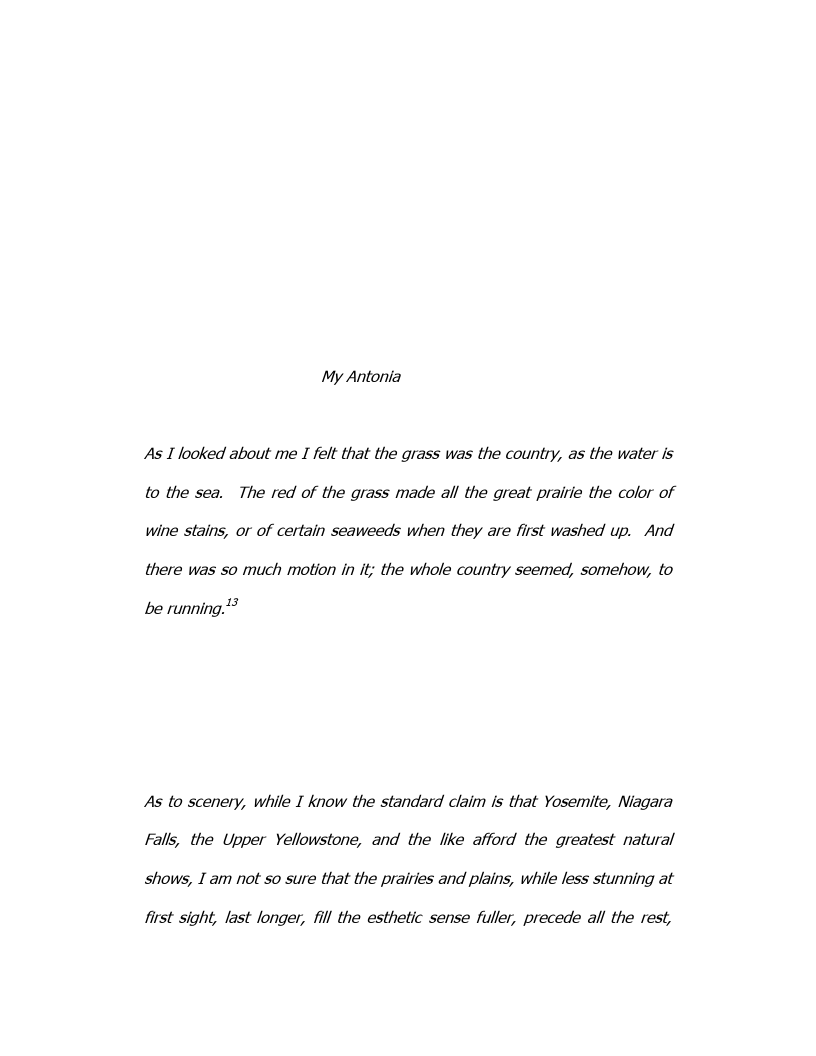
160
When European-descended explorers of the North America continent first
encountered the Midwest prairie, they struggled for words to convey the
immensity and seeming monotony of this new landscape. Resorting to familiar
imagery, they described the undulating plains in oceanic terms; a surging sea of
grass, tossing prairie waves in the crashing surf of wind. Willa Cather of Red
Cloud, one of the finest writers ever produced from Nebraska‟s grasslands,
continues with the oceanic theme in this passage spoken by a new settler to the
Sandhills, taken from her novel My Antonia, first published in 1918:
As I looked about me I felt that the grass was the country, as the water is
to the sea. The red of the grass made all the great prairie the color of
wine stains, or of certain seaweeds when they are first washed up. And
there was so much motion in it; the whole country seemed, somehow, to
be running.13
Other visitors were quite taken by the subtle beauty and mystery of the prairie.
In 1879, Walt Whitman wrote:
As to scenery, while I know the standard claim is that Yosemite, Niagara
Falls, the Upper Yellowstone, and the like afford the greatest natural
shows, I am not so sure that the prairies and plains, while less stunning at
first sight, last longer, fill the esthetic sense fuller, precede all the rest,

161
and make North America‟s characteristic landscape. Even [the prairie‟s]
simplest statistics are sublime.14
A sojourner to the remnants of formerly vast realms several hundred years later,
I too grasp at the familiar in making sense of my initial prairie encounters.
These prairie relicts inhabit intoxicatingly unfamiliar landscapes, but there are
undercurrents of familiarity here too. There‟s a place inside perhaps, where
familiar and unfamiliar come together in a seamless, inseparable vision. As a
kid, I often rambled across the open meadows scattered across our hardscrabble
Pennsylvania hills. From my high perch at the stone quarry on the mountain
across the valley from my house, I would gaze out on the rolling expanse. Far
above the claustrophobic pines adjoining our neighbor‟s cow pastures, I might
spy a red-tail hawk on its hunting rounds and imagine myself within its soaring
wings with nothing to bind me to the earth but my own fears. Space was
intoxication, spaciousness an exhilarating comfort.
If expansiveness provides perspective, then I wonder if perhaps I might
see still more of my familiar life through the unfamiliar eyes of the prairie, and
thus unite the prairie in me with the Eastern woodlands, Western mountains, and
bi-coastal shorelines of my youth and adulthood. As I navigate this mesic sea, I
let my imagination be my compass. To think like a prairie, I need to experience
it across its range of diverse moods and varied reaches, and discern what might
restore both resilient depth and flexible reach.

162
SOIL BUILDING / SOUL BUILDING
“She's going to die you know,” the hobo says matter-of-factly, motioning his cup
towards the east, where she lives now. We hunker around a fire, jungled up in a
rough clearing by the Burlington Northern main line. “That's the way it is!” he
says for emphasis, steam from his coffee wrapping tendrils around rough beard
and hard-lined features. It‟s a face I might have known from another more
callously held life. The familiarity unsettles, and then awakens me.
The dream has stayed with me for days. The man at the fire somehow
knew my sister Ginger struggled for life at the edges of death on the other side
of my dreaming. “Got to go on living anyway,” he'd urged me, “Ain't nothing
you can do to change matters.” Is the boundary really so thin between dream
and waking? The span between what we normally consider disassociated grows
infinitesimally small. I think about this intermingling of opposites, a boy who‟d
wandered thickly wooded hill country now a man ranging this even plain.
I'm poised at the edge of what used to be spacious grassland as if
readying for a flight to freedom. Walt Whitman used grass as his metaphor for
radical democracy. But Whitman had not traveled the Great Plains when he'd
penned Leaves of Grass. Writer Richard Manning points out that Whitman called
for large scale forestry efforts to resolve “the tree problem” on the prairies he
considered barren. But Manning contends that Whitman's earliest assertions
remain closest to the truth. “I believe the grassland was where we destroyed

163
democracy because of our inability to accept and understand freedom” he writes
in Grasslands, Manning‟s stunning evocation of prairie landscape.15
My journey then conjures not just the pursuit of freedom but a stitching
together of soil and soul with integrity. Species persisted on the vast grasslands
of middle North America by virtue of their skill at movement as a means for
surviving rapidly changing surface conditions. Shifting mosaics of wind, weather,
climate and moisture selected plants that dug down deep in persistence or
adapted rapidly in resilience to constant wind and periodic drought, fire, and ice.
Those whose seed rode the wind, clung to the hides of migratory grazers, or
stuck to the beaks or passed through the bellies of flitting songbirds became the
most successful at colonizing the constantly changing plains.
With rainfall, temperature and other climatic gradients sometimes shifting
hundreds of miles in a matter of years, animal species that could quickly shift
territory and exploit new habitat were also selected for success.16 Humankind
was born of the vast African savannahs. We are a species of the grassland,
selected by our ability to adapt to rapidly changing and varied conditions, free
because we are flexible. Yet we have always yearned for more.
Alchemists in the middle ages believed they could transform the primal
substance of albumen into gold. By turning prairie soil into agricultural riches,
one could argue that grasslands have fulfilled the alchemists dream. An
alchemical fire ranges through every prairie stand, lent by the sun, rent by
humankind in our attempt to borrow that fire as our own. To persist as a

164
species in such places, we might need a reverse alchemical rendering, a co-
mingling of soul with soil so that we inextricably belong to the prairie rather than
only borrow against it. How do we begin to build more resilient bonds with a
landscape we‟ve so severely fragmented?
There‟s a kind of fullness that presents itself as emptiness. The mind, the heart,
the skin can grow so satiated that they can‟t take anything else in. In that
overwhelm, we‟re suspended in time and space, numbed to everything new that
comes along – fullness turned inside out into emptiness. In such ways, at their
remote edges, things might sometimes turn themselves into their opposites. In
places of paradox, polarities may find coherence and coexistence. Humanity
splintered the prairie‟s integrity, but in the process of naming the rifts we also
may become more capable of knitting it together – and ourselves along with it.
Somehow, my hobo dream, my sister's struggle through cancer, and my
hopscotch journey through prairie remnants intertwine like some braided river
sloping down to the massive Mississippi drainage. Indeed I must go on living,
even if my sister fails to. In my search for meaning and belonging, these
savannah-like landscapes draw from a primal evolutionary knowledge. What I
discover from prairie paradox crisscrosses the borders between opposites, where
death renews itself in life, solitude restores a sense of belonging, and my
questions become perhaps their own answers.

165
As I stood earlier today at the edge of a central Iowa corn field, gazing
west over miles of rattling stalks, while a river of grackles undulated from one
stand of black locusts to another of sycamores, with the ululations of crickets
and cicadas serenading soul and sounding the soil, I felt suffused with an
unaccountable substance. Born of the grasslands a hundred thousand
generations ago, gradients of fullness and emptiness, open and closed, deep and
shallow, aloneness and belonging shifted constantly with the wind clattering
through the corn. In such a way, I transcend polarity.
Manning observes that the wilderness preservation movement has been
mostly a “mountain-and-forest” movement.17 Settlers clear-cut the “grass forest”
of the prairie Midwest, primarily for agricultural use. In many locales, the
sublime soil, the grassland's sustenance in the cyclic reciprocity of flood-drought-
fire-ice, has eroded to a shadow of its deeper self. Have prairie souls eroded as
well? In soil making in intact ecosystems, all that lives and grows ultimately dies
and disintegrates, another transcending of opposites. Perhaps the same is true
for soul making. Must something in my existence fall apart so that it can
reincorporate anew? I ponder the ways I may clear-cut my own diversity, plant
myself in mind-numbing monoculture, or bombard myself with metaphysical
pesticides-herbicides-fungicides.
Skin of soil – skin of soul. The industrial plow tore through the skin of
these soils, but also shredded the soul of this place.18 Commodity replaced
diversity as the underlying ethos. There were freedoms lost when the sea of

166
grass was stilled and drained, what Gretel Erlich called “the solace of open
spaces”19 scatters from land purely transformed into a capitalist venture.
Perhaps the clear-cutting and commoditization of prairie land has also clear-cut
and sold out our ideology, religious tolerance, grass-roots politics, and economic
sustainability. Perhaps in restoring our relationship to prairie places, we need a
soil worthy of the soul we desire.
If landscape processes form a kind of ecological consciousness, then can a
place that loses more than 99 percent of its original integrity still claim to
possess a mind of its own? And if the soil fundament of this region has been
irrevocably changed, have the souls of the people who draw sustenance from it
been inexorably altered as well? Here in this bread-basket of the nation, any of
us that eat from the Midwest‟s provender are implicated.
The scale of thought needed to address such questions transcends the
acreage of the lands I‟ve thus far visited. Neal Smith National Wildlife Refuge,
Southeast of Des Moines in the center of the state, offers the largest area given
over to prairie thinking in Iowa.20 As an experiment of prairie restoration and
relationship building on a grand magnitude, I hoped to find an extant integrity
missing from the tiny fragments of remnant prairies adrift in a sea of corn.

167
A PATCHWORK PRAIRIE: REMNANTS, RESILIENCE AND RESTORATION
Thousands of redwing blackbirds flex and flow like a tumbled wind suddenly
made visible. I pull to the roadside to take in the seemingly ceaseless stalks of
big bluestem and Indian grass taller than my vehicle. Tangling from the grass at
my feet, small purple spirals of petals announce the presence of aster‟s late
blooming. This exhibits the perfect picture of eternal prairie health and vitality,
and none of it was here twenty years ago.
Neal Smith National Wildlife Refuge, named for Prairie City‟s congressional
representative, encompasses 8,654 acres in central Iowa east of Des Moines.
Originally targeted for a nuclear power plant, this former agricultural land was
purchased by the US Fish and Wildlife Service in 1991. Dedicated research
biologists, refuge staff, and hundreds of volunteers are transforming some 5,000
acres of this parcel from corn and soybeans to wild rye and prairie dropseed.21
Where cattle once foraged, now bison graze.
It‟s an extremely ambitious restoration effort with its foundation in
education – of kids about the necessity of prairie ecosystems, and of landowners
about how to take existing land and put it into restoration. Extensive gathering
campaigns from wild stretches of land provide native seed needed for the
restoration efforts. Certainly the staff and volunteers at Neal Smith should be
complimented for their extraordinary work in teasing prairie plenitude from hard-
used agricultural soil. But for the impressiveness of vigorous native growth, an

168
air of artificiality also shows here. Curvaceous well-groomed trails punctuated by
comfortable seating lend this a feel of a city park. Unbridled winds tousle the tall
grasses, no doubt native plants, but the place itself seems somehow tame. The
presence of plants does not mean that a prairie has been restored when that
place is made as much of processes as provender. I suspect that the re-creation
of prairie and oak savannah habitat may yet lack something present in its
original creation. Perhaps that‟s incidental to a more important restoration
taking place here; the reconnection of kids, scientists, conservation officers, and
prairie enthusiasts with a tangible caring for prairie life; the incubation of
understanding of ecological processes underpinning these landscapes even when
their results only approximate native prairie.
I continue on the loop trail from refuge headquarters, skirting two milling
groups of school children out for a day‟s learning. Down the path, finally out of
sight of buildings and kids, I sit on a bench and soak in the sounds and sights
nearby. Waves and eddies of wind ripple the grass tips, steal away any voices I
might hear, lending me the illusion if not the reality of solitude. A movement in
one of the cottonwoods in the valley‟s crease catches my eye. Bursting from the
leaves, redwings flit in and out of sun and shadow, turning light and dark, a
chiaroscuro of wings. Their feathered choreography catches me up in their
dance. I rise and follow them from tree to tree all down the valley. Finally they
circle back over my head and flow almost silently back into the original
cottonwood from which they‟d first flown.

169
If I‟d wondered whether a place like Neal Smith could eventually match
the original prairie‟s integrity, then Agelaius phoeniceus reminds me that the
ultimate proof may be in the wing beat. But does the making of new soil mean
that it has been made whole? The metaphor of Iowa prairie as a patchwork quilt
may only go so far. Thinking of original remnants such as Hayden and Johnson
Prairies, and restored farmland such as Neal Smith Wildlife Refuge, any stitching
between even the largest of these plots reveals more gap than substance.
Ecological integrity must be measured not just within the squares but at the
interstices between them. Thus far I‟d traveled at ground level between widely
scattered prairie vestiges. I wondered if it might be time to seek a different
model, one which exhibited coherence that encompassed not only the remnants
of native growth, but the works of human agricultural enterprise.
Where the Little Sioux River braids into the big Missouri in western Iowa‟s
Monona County, eons of wind and weather have lifted silt and sediments from
the Missouri River drainage, and sculpted the deposits into steeply scalloped
hills.22 I puff and sweat from exertion by the time I reach the summit of one.
Slicing chunks of cheese and apples to layer over rough cut slabs of hard grained
bread, I gaze out over the flatter lands sliding from my hills toward the river.
Tractor combines taller than the single story house with attic I grew up in work
opposite ends of a corn field towards each other. Just shy of connecting, they
shut down their engines. Perhaps lunch calls their operators as well.

170
As I chomp through my thick sandwich, I notice first one, then three
specks circling high above my perch over the valley. No doubt drawn to
something more alluring than cheese and apple sandwiches their spirals tighten
and they descend closer. I make out the distinctive wing fold of turkey vultures,
chuckling to myself – but quietly – in guessing that it may be my sweaty booty
not my lunch bounty that they investigate. Subsisting as they do on the most
despicable fare imaginable (from human perspective) vultures ingest dead,
decaying, putrefying flesh and transform it into soaring transcendent flight. On a
silt-blown hill at the edge of Iowa grasslands, on the verge of the Missouri flood
plain, three circling vultures remind me that life feeds upon death. For the last
century or so Midwest agriculture has lived on the dead and dying remains of
ancestral prairie plants. Where are the roots of future prairie soils? What
remains for life when all that dies is carted off for commodity, when what‟s given
back to soil is not native substance but the flash of chemical additives?
Another passing speck now draws my attention. Something in its bearing
and intent differentiates its flight from that of the vultures. By the tilt of the
wings inferred from this distance, and some quality in its suspenseful maneuvers
of the wind, I peg this bird as a hawk though it never draws close enough for me
to make a positive identification. I project myself into its body and spiral high
above Iowa plains and look backward, from on high, across the land and over
the perspective of my last few days

171
In my hopscotch through Iowa prairie remnants, I recite place names like
a graveyard elegy, or perhaps more hopefully, a grassland genealogy: Hayden,
Johnson, Marietta, Cayler, Clay, Kaslow, Stinson, Steele, Neal Smith, Tourin.23
What threads – ecological, economic, societal, spiritual – stitch together these
disjointed remnants into an integrated quilt? From my hawk‟s eye, the
patchwork quilt of the land may look complete. But it‟s one thing to examine a
stand of original or restored prairie to determine whether a particular plant
association remains viable; quite another to examine the landscape from the
perspective of an organism – such as a red-tailed hawk or turkey vulture –
whose viability rests on a different measure of resilience.
Ecological resilience measures the capacity of a landscape community to
undergo disturbances while retaining its original character and function, including
the shift to alternative stable states. Its measure depends on the adaptive
capacity of that ecosystem to deal with damage, cope with change and open to
new opportunities, assessed across cascading scales of space and time. Prairie
disturbances abound, with causal roots in both human and non-human realms;
snarled and shifting dynamics of fire, flood, climate change, urbanization, oil
exploration, and agricultural force. A scan of the current literature reveals a
plethora of papers describing „social-ecological resilience,‟ exploring humanity
adaptations to rapid flux in sustaining lands.24 Amid vast seas of sorghum, corn
and soybean; to weave resilient integrity across scattered patches of remnant

172
prairie means we must bridge scales and develop capacities beyond those
previously imagined.
But resilience to a prairie means something different than it does to an
alpine meadow, a sagebrush plain, or a hardwoods forest. If resilience reflects a
flexible persistence in the face of ongoing difficulty, then native grassland
endures its diverse expressions of organismic response to every conceivable
variation of weather, topography, hydrology and disturbance; along with the
ability to root deep into the subterranean mystery, channeling growth downward
as well as up, patiently waiting out whatever rubs the surface raw. Ensuring the
presence of a handful of keystone species or the setting aside of particular tracts
of lands alone does not alone perpetuate resilience in native grasslands. More
withdrawals than deposits to the native soil „bank‟ severely diminish the prairie‟s
capacity to rebound. When the flexibility and complexity represented by species
abundance is replaced with monocultural simplicity, then the integrity of prairie
landscape is further compromised. Millennia of soil development and diversity
lend the Midwest‟s its agricultural bounty. When that becomes lost, how many
centuries might it take to restore that original measure of ecological buoyancy?
I ruminate on resilience for my own reasons. I close my eyes and see
prairie hills, fly them like a sharp-shinned hawk in my imagination, feel the deep-
rooted grasses reaching down into my own loamy fertility. Encountering those
places, I discover some hidden continent in my soul, as if wild native grassland
flourished in me all along, unexplored but deeply sensed, ripe with resilience.

173
Thinking like a prairie, I find a definition of internal and external resilience that
incorporates long-term depth with flexible diversity. But these dynamics
contradict the current measures of cultural and agricultural achievement. Higher
yields, enhanced performance, more efficiency: mantras of modern of success in
both land and society, drawn without replenishment from both soil and soul.
Remembering my initial drive through Iowa farmland to Hayden preserve, I recall
what I took to be a sentinel of prairie resilience in the outlier towering above the
sorghum. Even the one sight that initially gave me hope later dashed my
optimism, as the tall oddball proved not to be a native species but mutant
sorghum, a genetic freak even to its genetically manipulated brethren.
Much of Iowa native prairie has been uprooted, uprooting also something
of our understanding of it, and perhaps of ourselves, in the process. Stitching
together the remnant fabric of extant prairie and restoring once-farmed land to
fertile diversity are admirable and inspiring activities.25 But in order to extend
my prairie mind, I wonder if I might need to encounter a place with more of its
primal essence intact? In nurturing my fragile new consciousness of grassland
epistemology, I seek fifty miles of thinking room, a place rooted in its diversity,
and flexible in its persistence. Seeking a larger frame of prairie integrity, I point
my car north and west of Iowa, to Nebraska Sandhills 19,000 square miles of
relatively intact grassland.

174
OGALLALA TO OGLALA
Barren stretches of Nebraska make you you‟d swear you‟re the last human being
alive. Past McCook, heading North on route 61, driving late across the curving
Nebraska highlands, bereft of sun and of moon, my headlights slice ribbons of
light through velvet cloth revealing surreal images and dancing tall grass
shadows along the side of the road. I pass a ramshackle homestead; dark
shuttered, empty tonight, perchance forever. Emptiness catches in my chest as I
breathe deep bluestem air swirling through the open window. I yearn for sign of
another living human being. Over another ridge, tucked in a treeless draw, I
glimpse soft light from an isolated farm house. Such a light, I think, might put
the coffee up for me. Such a light, if I became lost, would direct me homeward.
Such a light, waiting warm, offers welcome against the weariness of night.
From the highlands south of the Platte river, I glimpse another welcoming
light; the glow of Ogallala, population less than 5,000, my destination for
tonight, my resting place against the solitude, darkness, and weary miles as I
head into the Nebraska Sandhills for the next stage of my research journey.
Certain towns, like some homes, seem to bid us welcome. Ogallala has been
that kind of place for me. I first happened upon the city some 15 years ago,
dog-tired on my mid-west leg of a cross country trip. I‟d pulled into downtown
Ogallala‟s Plaza Inn, rented a room for the night, and asked if there was a good
place nearby for a bite to eat. The proprietor angled his bony hand across the
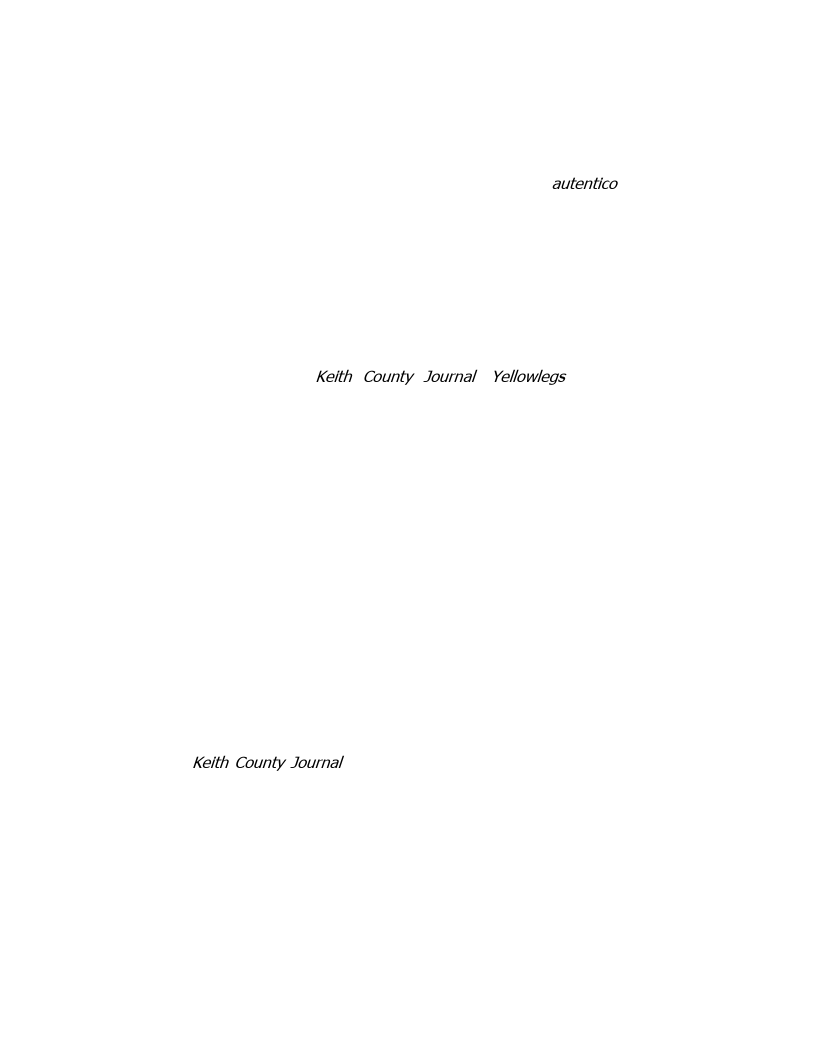
175
street to a near-empty Mexican restaurant. I ambled across the street. The
hostess wiping down a table greeted me like a lost friend. I ate enchiladas as
worthy as any this side of Chihuahua, washed down with autentico Tecate beer.
Afterwards I strolled around town, the main streets simply appointed, the
stores practical and not a chain store among them. Though it was almost 9pm,
the local bookshop was still open. I moseyed towards the natural history section
and found a bonanza of offerings from one of my favorite prairie writers, John
Janovy Jr, author of Keith County Journal, Yellowlegs and others, and a
renowned invertebrate biologist over at the University in Lincoln.26 With a
Janovy book and one by Mari Sandoz, another Nebraska writer of note,27 I
approached the counter to make my payment. The clerk grinned as I
complimented him on his choice of stock. “John comes by all the time.” he
informed me, “He takes his students into the Sandhills up past Arthur.” “Of
course!” I thought to myself, recalling the bullet-hole pocked country sign as I
curved down towards the river the other side of town. „Keith County‟ it
announced humbly. I was at the threshold of a land I‟d traveled through in my
imagination for many years.
Keith County Journal not only reveals the wonder of a natural place, but
can make me laugh out loud. With scientific accuracy and lucid prose, Janovy
reveals a multiplicity of perspectives on prairie diversity and integrity.28 The boy
curiously turning over cow patties becomes the biologist explaining the mysteries

176
of how termites and intestinal protozoan hitchhikers convert undigested cellulose
left over from a cow‟s grassland ruminations into soil worth its weight in gold.29
The teacher leads his students out across the unlikely wildlife sanctuaries
of a well-managed remote back-country ranch, into the dank shadow of a
highway overpass, or through the mud and muck of cattail marshes, and he‟s not
just showing them how the long billed curlews fearlessly scream and gracefully
pivot overhead, but how those birds point out the ways that humans might hold
the paradox of domestication and wildness. Not just how to track the path a
species of parasitic worm takes from the intestine of a cliff swallow, through the
liver of a land snail, but how in the process all three species unite in a lasting
dance between specific place and evolutionary time. He‟s showing them that the
killifish wriggling in their seine net is not just a member of a community, but
represents a host of concentric communities, a spiral rippling inward and
outward that encompasses all of humankind.30
Reading Janovy for the first time, I began to question the biases that led
early settlers to call the prairie the great, blank desert in the middle of the
continent, or causes modern travelers to put the Cadillac on cruise control and
speed out to the mountains west or back to the cities east. Habitually drawn to
lands of scenic wonder and exotic magnitude myself, I wondered if maybe
mysteries in grasslands deserved my careful attention and consecrated time. As
I made my purchases at the register, chatting amiably with the proprietor, I felt
like a larval worm gestating in a cocoon of compelling ecological tales told of the

177
Sandhills. I was now catching a glimmer of mysteries long concealed in a realm
beyond the cover of the book, and perhaps beyond even my imagining.
Janovy‟s works had taught me a great deal about this stretch of native
Nebraska prairie, but to think like the Sandhills, I would need to travel there
myself. Several Octobers later, ready finally to emerge into the chrysalis of first-
hand Sandhills knowledge, I seek traveler‟s refuge once more in Ogallala. I hole
up in my room with Mari Sandoz‟s Capital City and peanut butter sandwiches and
read myself to sleep.31 In the morning, I fuel up on both caffeine and gasoline
for my long day‟s journey through the Sandhills. I skirt the vast artificial
reservoir of Lake McConaughy, an aquamarine monstrosity against the shallow
meandering reach of the Platte through a semi-arid region. “Is this what‟s
become of the Oglallah aquifer?” I muse as I turn left at highway 26.
Blink and you might miss Oshkosh, Nebraska, population 986. In that
blink, you and I both might overlook the casually marked turnoff heading north
towards Crescent Lake National Wildlife Refuge. Some twenty miles on, a
narrow gravel road yields to one lane blacktop (composed of mixed slurry of
sand and tar). Traversing sensually sloping hills some 200 to 300 feet in
elevation with each crest a breathtaking glimpse of limitless expanses, I am both
calmed and exhilarated. This is elemental spaciousness. These hills swallow me
whole. Gently swelling curves enfold me like a body‟s curves – hills like a
languorous Sunday morning in bed with your lover. As my rental car glides from
one Sandhills dune crest to another, I recall my childhood soaring with red-tails.

178
Driving that one lane macadam for the first time, creasing the luxurious slopes
cascading into seeming infinity, I realize that I might never be closer to the
sensation of a hawk in flight than in this moment.
At 46,000 acres, Crescent Lake is the largest stretch of protected prairie
landscape I‟ve encountered thus far, that is if one considers hunting and fishing
forms of environmental protection. One of the refuge‟s lakes is open to fishing
year round while others open only from November through mid-February.
Grouse, pheasant, rabbit, deer and coyote may be hunted in appropriate seasons
on all refuge lands from September through January. Ducks, geese and coot
may be sought on portions of Crescent Lake. While such activities may seem
contrary to the concept of a wildlife refuge, heavy regulation helps maintain
native populations of both game and non-game species. Fishing with minnows,
either alive or dead, is strictly prohibited. Possession of any fish not explicitly
taken from the refuge is subject to prosecution. Non-toxic shot is de rigueur for
any hunting, and all blinds and decoys must be removed at the end of the day. 32
Sandhills integrity balances on compromise. It took political and economic
compromise to carve such lands from the vast free-hold domain of the region‟s
cattle barons. Whether allowance of these activities on refuge land was a bone
thrown to the settlers and ranchers is a matter of speculation. Certainly, humans
have disrupted the tender equilibrium of natural predation and native prey.
Provision to cull certain overpopulated species has become a necessity. Quite
likely, the revenue brought from game licenses in such places far from the

179
Federal feed-trough can be all that stands between success and failure of staff
efforts to manage and protect Crescent Lake.
I reflect on this balancing act of compromises as I pull into the parking lot
at Island Lake. In places like the Sandhills, it‟s important not to take anything at
face value. Varied perspectives yield varied insights. The water shows
blue/slate grey from one angle, but a pastiche of yellow, ochre, and sienna when
seen with the sunshine directly above as I walk onto the fishing dock/observation
platform. A redwing blackbird perches at the railing, which flies off to the marsh
and alights on a cattail as I approach. It sounds subdued – circumspect almost –
perhaps because it is not looking for a mate this time of year. I hear its nervous
chirrups, but its bold, distinctive “booker-tee” is missing from its vocal repertoire.
I note a lone swan and several white egrets far out on the lake. A milling
cluster of six or seven Canada geese cackles like gregarious friends at a crowded
café. Some species, at least, are not daunted by the prospect of hunters. But
humans are not the only hunters here. Walking back to the car, I pass by an
Army surplus oil trailer. Writ like a short story on the mud around and beneath
it, I trace small clawed tracks moving warily – drag marks of skidding feet or tail
perhaps – a couple of swirling marks of wing tips – the drama of hunting hawk
sweeping for rodent food. The happenstance presence of a handful of birds or
an individual prey‟s flight from particular predator, narrate the presence of
associations across dimensions of both time and space.

180
From the side of the road just shy of refuge headquarters at Gimlet Lake, I angle
up on a trail that promises a hill top overlook. Trailside, spikes of yucca and
bristles of cacti strike through scruffy thatches of dried grasses. This does not
look like the tallgrass remnants I was exploring further east. Shy on rain, coping
with porous spendthrift soils, plants this far west are more representative of mid-
grass prairie communities. It mingles elements found amid the tallgrass with
elements of high desert flora.
Some animal has scooped out a burrow just off to the left. If I were an
earth digger I might live here too. The sandy soil is easily displaced by earnest
effort. Enduring winds from the west and south also make the soil vulnerable.
Near the crest of the hill I come upon my first blowout, hollowed out over time
by the persistent wind, and home to blowout penstemon, the poster child of
Sandhills paradox. From the perspective of many environmentalists and land use
managers, the Nebraska Sandhills are an ecological success story. Increased
environmental sensitivity, creative partnerships between economic and
environmental interests, more careful grazing practices, as well as a relative
exodus of human population, have stabilized the rolling dunes of the Sandhills
and made them less subject to destructive erosion.
However, from the perspective of the blowout penstemon current
conditions on the Sandhills loom as a potential disaster. This deeply rooted
perennial herb with slender lavender flowers was placed on the endangered
species list in 1987. Ironically, the very processes and practices that provide a

181
stabilizing factor for the erosion-prone sand dunes erase the habitat conditions
much favored by this endangered plant.
Penstemon haydenii is a pioneering species, requiring the tabula rasa of a
freshly disturbed environment. Scientists monitoring the blowout penstemon
protection plan are extremely secretive about the few locations where it currently
thrives. Besides those few places scattered throughout the Sandhills where
naturally erosive forces still carve out a niche for the plant, it may also
occasionally favor sites of human caused disturbance created by overzealous
snow plowing, routine highway maintenance or back-country construction. This
begs the question: if Penstemon haydenii is to survive and thrive in a naturally
rejuvenating place and in a sustainable fashion, should disturbances be
intentionally created to provide its necessary habitat?
Blowout penstemon was originally called Hayden‟s – after Ferdinand V.
who first collected the plant in 1857 (not related to Ada, the heroine of Iowa
prairie preservation efforts). It blooms in late May for 3-6 weeks; each lavender
flower head persists for 5-9 days.33 As it prefers a freshly disturbed sandy soil,
the ancestral Nebraska Sandhills were a penstemon paradise. Before settlement,
lightning or native-set fire burned over habitat regularly and bison trafficked here
in their migratory feeding, exposing sand to persistent winter and spring winds.
Elimination of Native American‟s fiery practices on the prairie slowed but did not
stop fire‟s impact on these landscapes. Though later cattle came to replace the
beleaguered bison as primary grazer over much of this terrain, the new bovines

182
continued to disturb the Sandhills fragile soils, while natural occurring and
accidentally set fires still periodically raced across the landscape, thus stimulating
the conditions which satisfied the penstemon‟s desire.
But following on the heels of cattle business and agricultural excesses
culminating in the Dust Bowl years, attention throughout the region turned to
preserving the fragile soil. As in the rest of the country, we suppressed naturally
occurring wildland fires from the early 1900‟s onward. In addition, soil
conservation science significantly affected the ranging practices of ranchers,
leading to greatly enhanced habitat protection. Less fire and diminished impact
of Bovidae foraging meant more vegetation in general, but less prime real estate
for the penstemon. By the mid part of the 20th century, there was speculation
among Sandhills botanists that the blowout penstemon had perhaps gone the
way of the great auk and the dodo bird.34 Though some are optimistic about its
recovery, I wonder how such a species inured to impairment can sustain itself
when its preferred habitat continues to be threatened not by naturally occurring
disturbance but by sensibly planned restoration.
Seeking a place to camp for the night, I pore over my Nebraska State map
searching for little red triangles that signal public camping sites. There isn‟t
much to choose from. I could bite the bullet and check into some grungy
roadside motel and fritter away my night watching bad TV. Or I could take my
chances on an intriguingly named site called Toadstool Park about 15 miles from

183
where I sit. After a day spent traversing the subtle grandeur of Crescent Lake, I
crave solitude and natural splendor more than motel amenities. With Toadstool
located in the midst of Oglala National Grassland, the thought of laying my head
to rest in Oglala after morning in Ogallala city appeals to my poetic sensibilities.
The gravel road to Toadstool shadows a busy railway bed. Snaking lines
of coal cars rattle past every few minutes, full towards the east, empty back to
the west. Eventually, I cross the official boundary for Oglala National Grassland.
Despite the impact of frequently visited National Parks and publicly contentious
National Forests, few Americans know much if anything of the 20 federally
designated National Grasslands totaling almost four million acres of mixed
grasslands. Many represent quintessential short grass prairie habitat, colonized
by an association of plants and animals that can survive on an average of fifteen
inches of rain that falls annually on these landscapes (as opposed to wetter
tallgrass habitat). At 94,480 acres, Oglala – named for Crazy Horse‟s people –
dwarfs Iowa‟s Neal Smith National Wildlife Refuge by more than a factor of ten,
but is itself smaller than many sister grasslands in the system. North Dakota‟s
Little Missouri National Grassland, for example, totals more than a million acres.35
The scope of these lands reveals the scale of earlier human failure.
1862‟s Homestead Act opened a great deal of the mid portion of the continent to
land hungry easterners searching for “fifty miles of elbow room” and a decent life
if they could prove their claim on the land through judicious effort. Offering 160
acres for the modest price of $18, a flood of disenfranchised Eastern farmers,

184
newly arrived European immigrants, single women, and former Southern slaves
loaded their wagons and headed west for a new start. Many failed right from
the get-go, and even those who succeeded for a spell could be wiped clean from
bouts of improvident weather or wildfire.36
Within twenty years, the combined intervention of railroads and intentions
of cattle barons overtook all but the most steadfast of the original settlers.
However, subsequent tweaks of the Homestead Act (most notably the Kincaid
Act of 1904 which upped the claim acreage to 640 acres), along with the
discovery of gold nearby and further west brought new waves of prospective
homesteaders to the region.37 Droughts, flash floods, dust storms, and plagues
of locusts (and other insects) constantly challenged these new dirt farmers,
along with their gruff and sometimes violent cattle ranching neighbors, and took
the heart out of their efforts.
By the 1930‟s, in the aftermath of the Dust Bowl that hit these Nebraska
grasslands as hard as any Okie hardscrabble farm sung of by Woody Guthrie,
much of the populous – and the soil – had migrated elsewhere. A series of
commissions and acts of legislation attempted to stem the soil tide. These
landscapes were further brokered between the Forest Service, Fish and Wildlife
Service, the BLM and the National Park Service (1954), before falling under sole
proprietorship of the USDA Forest Service (1960).38 As with the Forest Service‟s
industry-friendly master plans elsewhere in the continent, it‟s little surprise that
coal and oil leases now abound on National Grassland holdings. Dirt cheap

185
leases to ever larger cattle ranching operations also predominate. Despite these
constant pressures, many of these grasslands are veritable gardens of Eden
compared to their corn and soybean compatriots further east.
Toadstool Geologic Park sits at the boundary between grassland and badland. It
looks like something out of a Flintstones cartoon. At the base of a curving cliff of
hoodoos and fractured cliffs, a semicircle of six covered picnic tables and
parking/campsites curves away from a restored sod house based on an original
homesteader‟s design for the first homes cheaply made in Sandhills settlement.
A chalky white trail slivers up and over sandstone shelves and around the
capstone slabs on clay pillars from which the park gathers its name.
In the last half hour before sunset, I delay dinner and camp setup for the
pleasure of a brief back-country ramble. Prehistoric volcanic activity in the area
periodically draped this landscape in layers of ash. Weathered into cracks in the
clay the ash eventually crystallized. The softer surface material erodes, revealing
glasslike gravel and the bones of primeval organisms. The path curves and
traverses an old stream bed. Patches of this coarse mix of bone and silica
appear where waters have worn them visible. I pick up a fragment of ashen
glass, picture in my mind‟s eye the original fiery rain, the pressing concerns of
centuries of sandstone deposits, followed by eons of watery cascades and
caravans of wind, revealing this moment of Homo sapiens grasping a handful of
the past within his present.

186
Around the corner, a self-guided signpost alerts me to the presence of
prehistoric tracks. Again I enter the crossroads of my imagination as I rest my
palms into the shallow depressions that describe the path of some antediluvian
organism. On a balanced sandstone boulder off to my right, I note the tracks of
a two toed animal across the ancient mud. My imagination can neither confirm
nor deny the evidence of an entelodont‟s traverse. I must trust the
paleontologist‟s call on the passage of this prehistoric giant pig.
Further along the loop trail, I come across more entelodont traces, this
time trailing two sets of other tracks. My imagination fails me altogether as I
read the guide‟s story of two separate species of rhinoceros that had once
followed this streambed. Some Dick Tracy paleontologist had speculated that
the smaller of the two had crossed the stream after the larger had just passed.
Perhaps spooked by the near encounter, it apparently sped off through the mud,
leaving splash marks that stained time immemorial.39
At the crest of the sandstone ridge I sit on an outcrop and survey the
plain stretching south from the campground. In the distance several telltale
conical slopes suggest that volcanoes indeed marked time here. From that far
vista, sienna and tan grasslands stretch back towards me like a scratchy wool
blanket rumpled by windstorm creases and flash flood gullies. Nearer still, and
off behind me lie the crushed and crucified badlands that tie all the way back
north towards Badlands National Park in lower South Dakota.

187
At sunset, crisscross ripples of different and diametrically opposite layers
of flows of cloud and color perfectly portray a landscape that has learned to hold
contradictory forces in dynamic tension. I let Sandhills earth and sky,
spaciousness and timelessness, seep into my skin and blood. There‟s no one
else nearby to verify what year this is, or to declare what organism will next
round the rocky bend, or to debate with me what it would take to keep and
restore this grassland cum moon crater. Reflecting on the tracks of a now
extinct archaic giant pig and a lumbering rhinoceros, our crafting of management
plans detailing the denouement of native and nonnative species strikes me as
somewhat absurd and hubristic. By whose calendar are such things measured?
From the calcified perspective of the entelodont, we are all invaders here.
That night as the cold flows over the rock faces into my valley, an intense wind
and a sneaky rain wreaks havoc with my efforts to fire up my cook stove to craft
dinner and warming tea. I give up; put on every layer I can, and wriggle into
my sleeping bag. In the absolute dark I hear rumbling and howling. Loaded
coal train? Yahoos out for a bit of tourist torment? Coyotes on a hunter‟s prowl?
Blundering entelodonts rushing downstream to crush my tent? In such a time
and place anything seems possible – except perhaps the possibility that humans
will choose the wisest course in matters of managing these primeval lands.

188
Arising early the next morning, I hike a stream-bed trail and up onto the plateau
behind Toadstool heading towards Hudson-Meng Bison Bonebed. In the early
1950‟s ranchers Albert Meng and Bill Hudson uncovered large bones poking from
an eroding bank and summoned scientific expertise. Excavations revealed an
extinct species of bison with stone tool artifacts dating some 8,000-10,000 years.
Archeologists surmised first an ancient bison jump, then a natural death event of
unknown origins. The mystery is yet being explored by archaeologists and
visitors to the dig site.40
Wind tosses the dry grass. I stand on a high ridge with a 360 degree
prospect. I‟m at a crossroads of dim past and uncertain future, equally
inscrutable, recorded in stone but not fixed in time. Who‟s to say that
tomorrow‟s paleontologists won‟t be excavating cattle ranches plumbing the
secrets of bovine decline, or that either grasshopper or redwing will yet be here
to watch over burgeoning blowout penstemon? For all the apparent mystery,
across the span of time, no land remains trackless. Roaming the wind-sculpted
hills of Lake Crescent, the eroded ash hoodoos of Toadstool, the airy sweep of
this plateau, I glimpse traces of creatures past and present within these ancient
lands. On the trail of episodic migratory species, ephemeral plants, prehistoric
tracks, and eternal wind, I feel more a shaman summoning fleeting spirits than a
researcher pursuing scientific certitude.

189
GHOST ROADS
To my right, broken pieces of macadam slide down into a weed choked culvert.
Sentinel mullein stalks and phalanxes of goldenrod push through cracks in the
weathered surface. Along several of these pre-interstate highways of central
Nebraska, mute evidence of the first roads through here is writ upon the curving
Sandhills rise and fall. For reasons known only to highway engineers, and
perhaps pork-barrel politicians, long stretches parallel older adjacent pioneer
roads rather than overriding them, even those that follow the same grade.
“Ghost roads” I jot in my journal, one hand on the wheel as I slide up one
slope and down the next. In my mind‟s eye I see model-T Fords chugging up
the hill beside me, furniture laden Dust Bowl trucks stalled, steaming, attempting
to escape the wrath of the persistent wind, broken down wagons from even
older ghostly trails across the harsh Nebraska landscape. Occasionally I pass
rundown stucco gas station-motels replete with rusty pumps, windowless diners,
and devastated farmsteads, home to hosts of phantom memories. Profligate
Sandhills prairie does its best to erase the traces of memorial remnants, but I
imagine that other generations of drivers on these less-traveled by-ways will still
be able to sense the tracks of ghosts long after their passage fades from sight.
Speeding down rte. 27 from Gordon, I glimpse a worn wooden sign on a
side road indicating „Sandoz Books‟ a few miles in. I‟d heard that Caroline
Sandoz Pifer, executor of her sister Mari‟s literary estate, operated a little

190
bookshop/museum after the renowned Nebraska author‟s death in 1966. I hook
an abrupt left turn, wheels spitting dust, hoping the sign will lead me to first-
hand information about Mari Sandoz. Several miles down the unpaved avenue, I
begin to regret my impetuousness. Deep ruts in the sandy path threaten to
swallow my vehicle: I balance one wheel off the side, the other in the center,
steering with sweaty palms.
At a steep grade, my tires start to spin in loose sand. As the car slips left,
I steer right and gun the engine, maneuvering the rest of the way up the dune.
At the crest, I stop and shakily walk to the passenger side and pry tumbleweed
from the wheel well. Blossoming red, freshly nudged from its tentative roots, the
plant looks nothing like I would imagine from my stockpile of old Western movie
footage memories. The wind buffets me, shakes even the car. But for my
modern conveyance, I could be a late 1800‟s homesteader on my way to a claim,
like Mari‟s father – subject of her most renowned book Old Jules – and the
dozens of others who Jules subsequently persuaded to settle nearby. In a lull in
the blowing, a meadowlark calls from over the crest of a dune. A slant of motion
overhead catches my eye, plummets to the ground; red-tail hawk in primal
hunting mode. Closing my eyes, I picture this place a hundred years or so ago.
Opening them, I‟m convinced that little has changed but the lay of the dunes.
As I drive forward, the road seems more solid, less rutted. About where
the bookstore should be, fruit trees appear, old fencing, birdhouses affixed to
both, grey-sided outbuildings tumbled and worn, and then a more modern

191
looking home. No sign „Sandoz Books‟ greets me as I park and stride towards
the door. Before I can reach the buzzer, the door opens and a middle aged man
appears. “Looking for Caroline?” he asks, then proceeds before I can answer
“She‟s up at the nursing home in Gordon you know… Hasn‟t lived here in some
time… This is a private residence now…” Noticing perhaps the sink of my
shoulders, he adds “Books and such are up in Gordon too… Have some water?”
We chat a few minutes, the new owner expresses gratitude for the work
Caroline and family did to bring trees to this place, and for the work the trees
have done to bring the birds. Caroline, with a degree in botany from the
University of Minnesota, created a haven for both wild and domesticated life. I
learn that a tribute to Mari‟s work, including a number of the artifacts saved by
Caroline, operates at a local print shop run by a friend of the family. I bid
farewell and head for the next leg of my ghostly journey. With a taste of the
Sandoz way of life through Caroline‟s legacy, an informed sense of Mari‟s
existence still eludes me like a will-o-the-wisp trailing away with the wind.
Bathed in lucid afternoon light, I sit on a simple wooden bench, gazing across at
the tan and sienna hills. In the valley to my right a mass of greenery, trees –
fruit trees in fact – rises in a place where miles can pass without sign of anything
taller than the ever-present bluestem. Behind me a single headstone also stands
out, the significant granite slab out of place in this otherwise austere landscape.
In a day out traveling ghost roads, I‟ve arrived at an appropriate place.

192
Earlier, another simply appointed sign beckoned me off the beaten track
of rte. 27: „Mari Sandoz grave site.‟ On the drive in, a passing pickup truck
slipped by in a cloud of loose sand. The driver lifted a hand in greeting, her
determined face like something out of a Walker Evans photograph from the Dust
Bowl years. Eerily, I recalled a picture of Mari from the dust jacket of one of her
books. I shook off the image and drove the rest of the way to my destination.
Thus I arrive at my resting place with Mari Sandoz, author of an array of
non-fiction narratives including her well known familial memoir centering on her
father Old Jules, a cycle of historical works including The Beaver Men and The
Buffalo Hunters, and a set of novels, among them Slogum House and Capital
City.41 Niece Celia Sandoz Ostrander Barth (it was her in the truck, I speculate)
and family now tend the homestead and the fruit trees in the valley planted by
Mari‟s father. Located on this barely passable dirt track, this is less a tourist‟s
destination than a devotee‟s pilgrimage.
Mari‟s last wish was to be buried where her spirit could gaze out across
the hills she rambled and loved up close and from afar (during the many years
she lived and wrote in New York City). I come here to place myself in the land
where she so often placed herself in reality and imagination. Reading through
guest entries in the wind-tattered pages of a spiral notebook, I discover I‟m not
the only one who was moved by Mari‟s writing. The testimonies of young
women who‟ve found in relevance in words written five or six decades ago
particularly strike me. A number of works of gripping social commentary
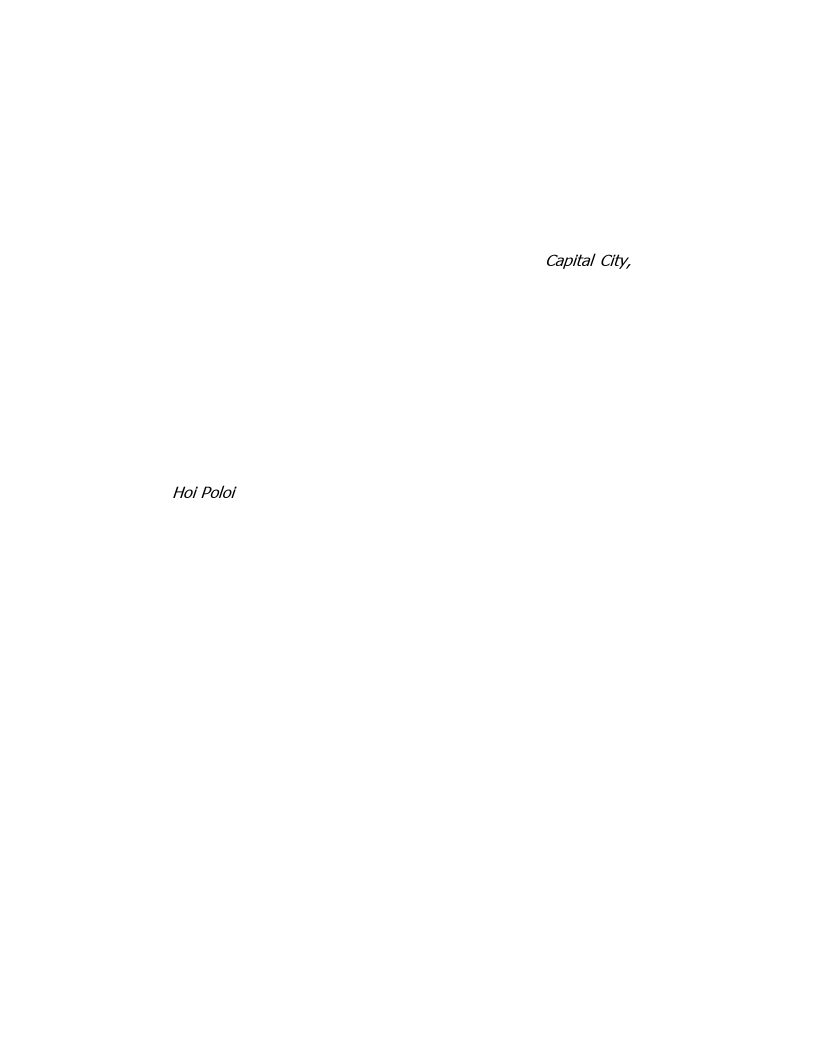
193
encompass the Sandoz canon. In this remote peaceful valley that was this
writer‟s refuge, I become lost in thought about a novel that outlines what was
once her scourge and outrage.
Sandoz‟s most ambitious and audacious political work, Capital City, is set in an
imagined capital in a made-up state. The city of Franklin and the state of
Kanewa are a compendium of Midwest states and their capitals meticulously
researched by Sandoz. Taking place in the turbulent times in the Great
Depression just before World War II, the novel opens with the ostentatious
ceremonial coronation of Franklin‟s Emperor and Empress; an annual excuse for
the Hoi Poloi to lord their riches and the rabble to make a buck on the festivities.
From Herb‟s Addition, a shanty-town for the poor squatters and disenfranchised,
Hamm Rufe; 40-something Socialist-leaning publisher of a Farmer‟s Insurance
newsletter and protagonist of the novel – gazes out over the action with „the
Coot,‟ a former banker who‟d lost all in the 1890‟s depression. Thus the story‟s
defining tension is laid out, provocatively characterizing the class and land
struggles that fueled the Depression. In the novel, the incoming Emperor turns
up mysteriously dead in a men‟s room stall just before his coronation, police
brutally assault the Labor Day parade of workers, a picketing striker is shot, an
immigrant boy run over by a speeding car; signal events in a chain-reaction that
flashes and burns through the rest of the book.42

194
“That Hitler, he knows how to handle labor.” a character grouses at a
later gathering of Franklin‟s social elite. The comment is indicative of a late
1930‟s socio-political climate that bordered on Fascism; that admired the tight-
fisted control of the means of production and of those who advocated for a fair
deal for the workers.43 Sandoz‟s mythic setting and story differ little in degree
and tone from present tensions between the moneyed elite and the hardscrabble
Sandhills farmers. Neither story resolves such tensions – ranchers still struggle
to make ends meet on land left in the hands of ever fewer owners. But with no
small irony, the economic forces which threaten the Sandhills may be part of
what ultimately helps keep it safe: modern cattle ranching can support just a few
hardy souls, while mimicking closely the actions of the original bison.
From the old Sandoz homestead, I embark on a roundabout journey towards
Valentine National Wildlife Refuge. It‟s several hundred miles of extra driving but
I want to soak in every vista I can of the Sandhills. Like a spaciousness junkie, I
careen on a binge and I don‟t want the high to stop. Valentine, my ultimate
destination, is – alongside Crescent Lake – the only other large segment of the
Sandhills under Federal wilderness protection (unless one counts multi-use
forests and grasslands under the National Forest Service aegis).44 I zig south
onto rte. 27, zag east for a spell, loop north, then spur east again before turning
south at the town of Valentine, doggedly driving the 25 miles towards a camp
site at the state park at Merritt Dam straddling the Niobrara River.

195
By the time I hit the first campground well past sunset, I discover that
permits can be bought only at the service center I‟d already passed. I drive back
to the combo-gas station/permit service operator: closed. Cursing the Nebraska
State Department of Recreation, I return to the campground, determined to
camp sans permit. As I pull off at the first grassy area, headlights flash up from
the reservoir and a monstrous pickup truck towing an over-sized motorboat
coasts to a slow crawl alongside me. I see only the glow of a cigarette and the
dash lights illuminating the undersides of two Stetsons. Suddenly I feel quite
vulnerable. When after an ominous moment, engine idling, the two finally cruise
away I resolve to spend the night in a motel room.
As I backtrack to Valentine, halfway there I pull off the side of the road on
a long straightaway to calm my nerves. Shutting off the engine and lights I‟m
stunned not by the blanket darkness but by the bright clarity of stars more
bedazzling than any I‟ve seen in years. In the cool evening, moisture wrung
from the desiccated air releases a lingering hint of sage mingled with the scents
of a hundred other late-fall prairie plants. A nearby coyote yips and yodels, his
wavering crescendo winds to a whimpering murmur. If I breathed deep enough,
I think I might suck down a star or two like errant gnats, so near do they seem
to loom overhead. It‟s tranquil and awesome enough to make me wonder
whether to u-turn back to risk the campground once more, good ol‟ boys be
dammed. Almost enough, as another pickup barrels around the bend down the

196
highway bearing down on me to remind me that, after all is said and done, I‟m a
stranger to this land and guest to no one. I am rootless in this prairie wind.
I don‟t wholly shake off the unsettling mood of my aborted Merritt Dam camping
search the evening before till my morning coffee has cooled in the cup holder,
sun halfway up the windshield. Turning at a casually marked entrance for
Valentine NWR, I travel once again on one lane pavement, lolling over the
curvaceous hills with windows rolled down even with a chill wind hurtling
through. Raggedy skeins of geese crisscross, hopping from lake to lake like K-
mart shoppers seeking a blue light special. Dozens of lakes, marshes, fens and
mud-holes, each serving up its own fine cuisine of killifish, minnow and snail dot
the area encompassed by Valentine. Traversing hundreds of miles of spare, dry
Sandhills terrain over the last while, I am tempted to think of the region as a
sub-Saharan clone; treeless expanses and ceaseless sandy slopes connote a
desert feel. But both Sandhills NWRs testify to the presence of the underground
sea we call the Ogallala Aquifer.
This presence is especially apparent when I climb to the top of a hill
surmounted by a CCC era fire tower opposite refuge headquarters at Hackberry
Lake. From what may be the highest point for miles, I scan each direction for
minutes at a time, drinking in the vast undulating folds of tan and sienna hills,
punctuated by the tourmaline flash of the lakes, teal reaches of myriad marshes,

197
emerald calm of ancient fens. With every vista I become more intoxicated. An
hour here passes like a minute elsewhere.
A range of fens, road-less and closed to all public entry draws my eyes
again and again. Passages of murderous thoughts and deeds of dark characters
skulking around foggy marshy terrain in Shakespearean epics conjure my
working knowledge of fens. Biologically though, the fens of North American
landscapes bear life and produce peat domains rich in nutritious runoff
percolating from heavily mineralized soils. Less acidic than its wetland cousin the
bog, fens support a much more diverse array of plants and animals.45
Sustained by an Ogallala aquifer severely threatened by agricultural,
municipal and industrial depletion, this area seems stable and vibrant for now.
However, I can‟t help wondering what else would be drained from this stunning
vista if these nurturing waters were drawn down for center-pivot irrigation in
semi-arid lands, golf-course watering in high desert communities, and coal plant
cooling in sun-soaked regions hundreds of miles from here. Should ever the
Oglala be pumped dry, it would not be Sandhills roads alone which would take
on a ghostly visage.46 In such a dire event, I imagine a symbolic blood being
drained from these living lands, as if these hills rang with the resonance of
resilience and ecological integrity.

198
RUMINATION
Gliding from crest to crest on another remote one lane road in the central
Sandhills, I feel anxious. This remote by-way, representative of others which
symbolize a particular Sandhills kind of liberation, presents itself this morning as
a looming threat. For days massive cattle trucks have hurtled past me down the
highway, heading to and from the back-county ranches and their resident beef.
A few miles back, I saw the tail end of one truck plummeting down one slope as
I descended another. As narrow as the road is, there would be nowhere to go
should I encounter one heading in my direction. As fast as they move, there
would be precious little time to react.
I slam on my brakes, an obstacle suddenly in my path. Bovine eyes
frantic, a flustered black and white steer scrambles off the road and into the
ditch-side scrub brush. It turns and looks back at me, its anxiousness matches
mine. Other cattle look up from their feeding at our apprehensive tableau. My
cow finds a clump of grass to its liking, forgets all about our brief encounter, and
relaxes into its eating. Each of us left to our own particular ruminations, I slowly
accelerate and move on, reflective, pensive, troubled.
Grassland organisms evolve various strategies for gathering nutritional
value from the bluestems and gramas, preeminent plant species on this prairie.
Grasshoppers hinged jaws slide back and forth, grinding the silicon-reinforced
monocots. Their brown-juicy secretions, like an old tobacco-stained pioneer,
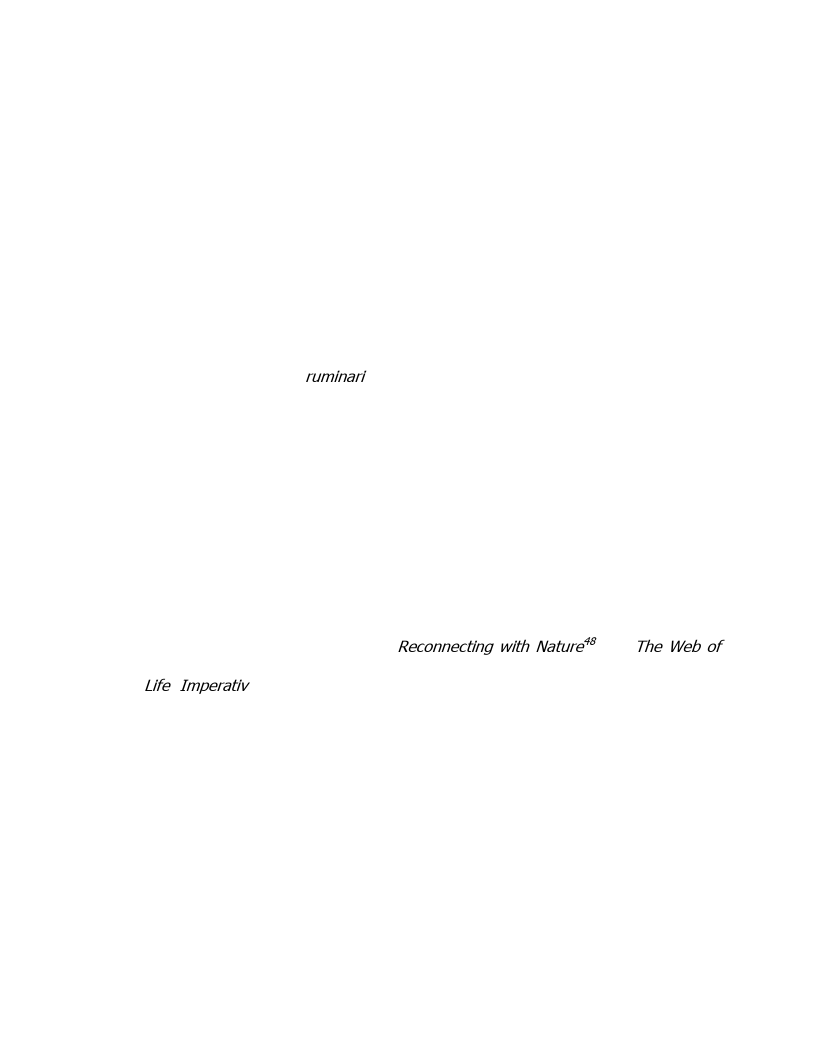
199
further break down the tough fibrous grasses. Even with the aid of specialized
teeth, much of the nutritional content of a prairie‟s provender is locked up in
relatively indigestible fibers. Biologists classify bison, historically the dominant
grazing animal on these plains, as ruminants. Cattle ruminate too, whether bred
for beef bringing or dairy drudgery. Raw forage passes from the ruminant‟s
chewing through successive stomachs, each equipped with its own enzymes,
gradually rendering the tough grasses into meaningful nutrients.
The Latin verb ruminari – to chew over again, in the lexicon of modern
use it has come to refer to thoughtful reflection, a turning over of thoughts in
the mind.47 As a metaphorical experiment, I consider the organs and functions
of the brains as akin to separate stomachs on a mammalian ruminant. If
cognitive function symbolized a series of successive ruminations, then I surmise
that our sensory apparatus and nervous system would be the first.
Michael Cohen, founder of Audubon Expedition Institute and The Institute
of Global Education and author of Reconnecting with Nature48 and The Web of
Life Imperative49 lays claim to 53 separate senses, not five alone. “Each
attraction, sensation, feeling or emotion is a rational sensory way of knowing and
relating that we biologically inherit from, and hold in common with, nature.”50
While I find myself a bit dubious of his claims, it is instructive to consider trust,
place, pain, and community as sensory input. Wherever we draw the line in
defining sensation, conventionally or unconventionally, node and nerve of
sensorial data deeply inform our knowledge and belief of the world.

200
What if our concepts were nourished by the movement of sense, idea and
emotion from skin, eye, ear or nose through the upper part of the spinal cord,
into the brain stem, digested by the cerebellum, cortex, and neo-cortex, further
ground amid the parietal, occipital and temporal lobes, and made palatable by
the corpus callosum that unites the brain‟s divide? For all we know of the brain
and its functions, there‟s ever more we have yet to learn. Hypothalamus and
thalamus, dendrites, neurotransmitters and synapses help us explore and
consume the mysteries of the universe, even as their full functioning remain
something of a mystery to us.51
In such ways might a prairie‟s meaning be rendered into availability, as if
to digest both the tough siliceous grasses and the rough-hewn intentions of this
place required complementary processing; a passing through different realms of
comprehension and knowing. How else might one wrest meaning from the
tough and contradictory information encountered in these prairie remnants and
flowing hills: a landscape finds stability together from the tenacious rooting of a
few persistent grasses but remains flexible through the resilient meandering of
hundreds of forbs and flowers; a prairie may be impossible to fully restore, but
it‟s possible that a people‟s desire for a prairie may be enough to manage
miracles; agriculture often disrupts ecological flow – ranching sometimes heals,
though not for a single plant that requires a freshly disturbed palette; a region
formed and informed by a diverse array of plant and animal species balances its
precarious economy on the success or failure of a handful of crops?

201
As I near the end of that long stretch of one lane road, still gripping the wheel
tightly in my fear of encountering a rampaging cattle truck, I notice an
abandoned farmstead off to my left. Not so unusual, given the number of
derelict homesteads through these hardscrabble lands. A black wind moving
through the copse of trees planted between the dilapidated house and the
stumbling barn catches my eye. I pull over, shut off the engine. The wind
launches, spitting sparks of red color, spins up above the trees and into the
adjoining corn stubble, then up again as quick as a blink, swirling back and
pouring down into the chattering leaves.
Thousands of redwing blackbirds dance and shuttle from branch to
branch. For the third time in a week, I‟ve encountered Agelaius phoeniceus out
on its migratory rounds. They too have been drawn to these prairie places, but
unlike me they seem to hold no inherent moral conflict about dining in a cattail
swamp one day and a corn field another. Redwings find merit in lands of both
diversity and commodity; cows too, for that matter. I ruminate on this notion as
I head south on the highway towards Kansas.

202
EATING OIL
See-saw pumps pendulum against the low slung horizon line. I stand by the side
of the road, gazing at small oil rigs spaced at intervals amid dried stalks of corn,
not yet cut for stubble. This is Central Kansas, the heart of the heartland.
Billboards along the highway proclaim that each Kansas farmer feeds “129
people plus you.” I wonder just how many oil derricks it takes to support one
field of corn. I come here to plumb the roots of prairie paradox, to try to discern
how the thrust of agricultural commodity can be balanced against the necessity
of prairie diversity.
Modern agriculture is testimony to fossil-fuel driven technology. One
portion of crude oil pumped from derricks around the world is processed into
diesel fuel for the massive tractors and farm implements that plow, seed,
fertilize, irrigate and harvest large plots of corn, soybean, sorghum and wheat.
Another segment is diverted into factories such as Monsanto and Cargill and
transformed into production of various fertilizers, herbicides, fungicides, and
insecticides (as well as the apparatus and means for applying these to the
fields). Refineries reserve still other portions for the transport of the harvest to
processing factories, the fueling of those factories, and the movement of food
products through a network of production and transport facilities, all the way to
our homes, refrigerators, stoves and microwaves. The volume of fossil fuel
utilized to bring say, one package of corn taco shells to our table boggles the

203
mind. As I watch the rhythmic pumping of cornfield oil derricks from roadside
Kansas, I can‟t help wondering if it might be symbolically accurate to display that
volume simply by letting that pumped oil spill out onto the fields.
As an undergraduate at State University of New York at Binghamton, I
took a class entitled Ecological Principles and Agricultural Practices.52 To bring
the economics and energetic complexity of modern food systems home, our
professor assigned us a set of dietary analysis assignments. The first was a
straightforward investigation of percentages of caloric intake of proteins, fats and
carbohydrates incorporated in our diet over the course of one week. In sharing
our results with each other, we assessed our place along the continuum of what
was considered healthy at that time.
I was a vegetarian at the time and well acquainted with the concept of
complementary proteins acquired through the mixing of say, corn and beans. I
was rather pleased with myself for having close to an ideal mix, with most of my
proteins yielded from grain-veggie complements. Our next assignment however,
greatly humbled us. Taking the week‟s sampling we‟d just recorded, we applied
sophisticated formulas to calculate the energetic caloric input of each of our
calories. Depending on where and how the ingredients were raised, processed,
packaged, transported, stored and cooked, we came up with a caloric count for
each meal we‟d consumed that week. Even for the most conscientious eater, the
results proved sobering.53
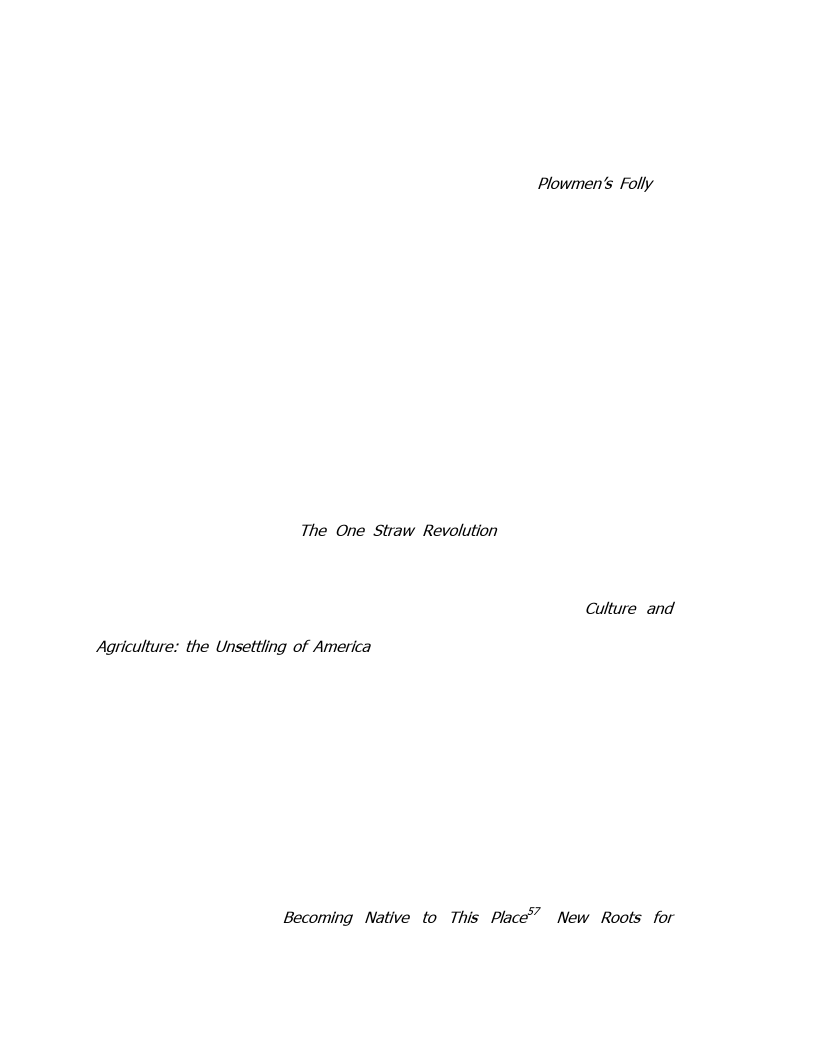
204
Even if many of decided to change what we eat, fundamental changes in
North American diet would be problematic given how deeply our agricultural
practices are entrenched. In 1943 Edward Faulkner wrote Plowmen‟s Folly, a
detailed and explicit critique of the use of the moldboard plow, then as now a
staple in crop production. Faulkner was so overtly critical of modern agricultural
practice that his book was almost universally rejected or ignored by experts of
the day. He confronted modern agriculture‟s constant disruption of soil structure
by the cleaving plow, and the cost of not replenishing biotic material removed.54
Much of what Faulkner wrote over 40 years ago has borne the test of
time, though many corporate farms remain imperious to the necessity of
returning – in organic form – what they‟ve leased and leached from the soil.
Others listened however. The One Straw Revolution by Masunobu Fukuoka
emerged in the late 70‟s proposing an alternative to chemical farming, modeled
after patterns in healthy local ecosystems.55 Wendell Berry‟s Culture and
Agriculture: the Unsettling of America suggests that such practices as Faulkner
criticized grew out of a more fundamental schism between people and land. As
the relationship between people and their sustaining land was disrupted,
suggested Berry, all our relationships became damaged. Throughout his work,
he contends that to heal rifts in our culture, we must address destructive
practices in agriculture.56
Berry‟s dear friend Wes Jackson, founder of The Land Institute in Salina,
Kansas and author of Becoming Native to This Place57, New Roots for
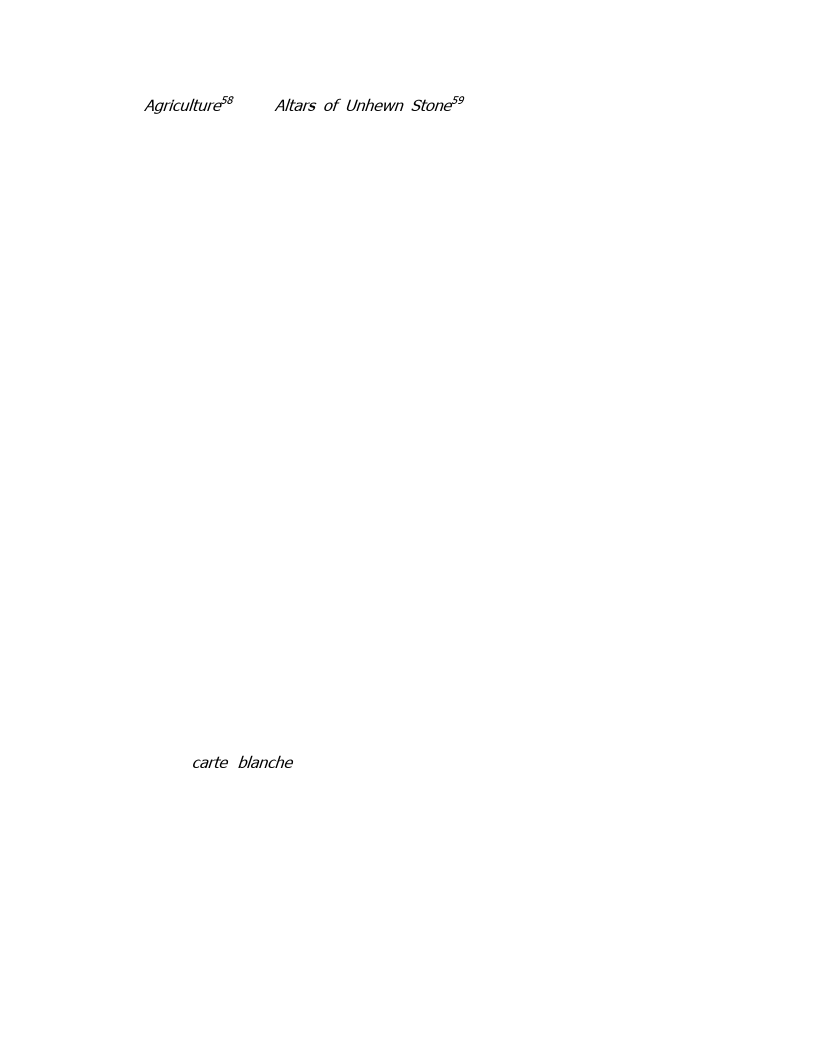
205
Agriculture58 and Altars of Unhewn Stone59 has dedicated his life to pursuing
alternatives to destructive agricultural practices, which is why I‟ve traveled
halfway across the continent this bright warm September weekend for the Land
Institute‟s annual Prairie Festival.60 Jackson‟s formal education includes a BA in
biology, an MA in botany, and a PhD in genetics. He has earned another
education hands on with friends and colleagues working the soil. At the Land
Institute, he and his staff research methods of crop rotation and inter-planting to
mimic more closely the rich, diverse integrity of the prairie ecosystems.61
This is an extremely intriguing alternative to eating oil. By cross-breeding
annual domesticated crops with wild perennial counterparts, they yield offspring
not dependent on the annual oil-consuming, soil-breaking extravaganza of seed
and plow. Currently, the staff undertakes research on a number of breeding
programs; crossing sorghum with johnsongrass, wheat and triticale with
wheatgrass, enhancing the agricultural value of leguminous Illinois bundleflower,
and cultivating perennial rye, millet and sunflower hybrids. Mixes of these sown
in association mimic prairie diversity. Their combine further benefits the farmer
in serving as a naturally integrated pest management. No single insect invader
holds carte blanche over a monotonous monocultural field; the agricultural
diversity and indigenous genetic composition invites native foes of problematic
pests to the feast.
A ten-year on site demonstration project combined perennial agricultural
practice with renewable energy means. They are currently evaluating data on the
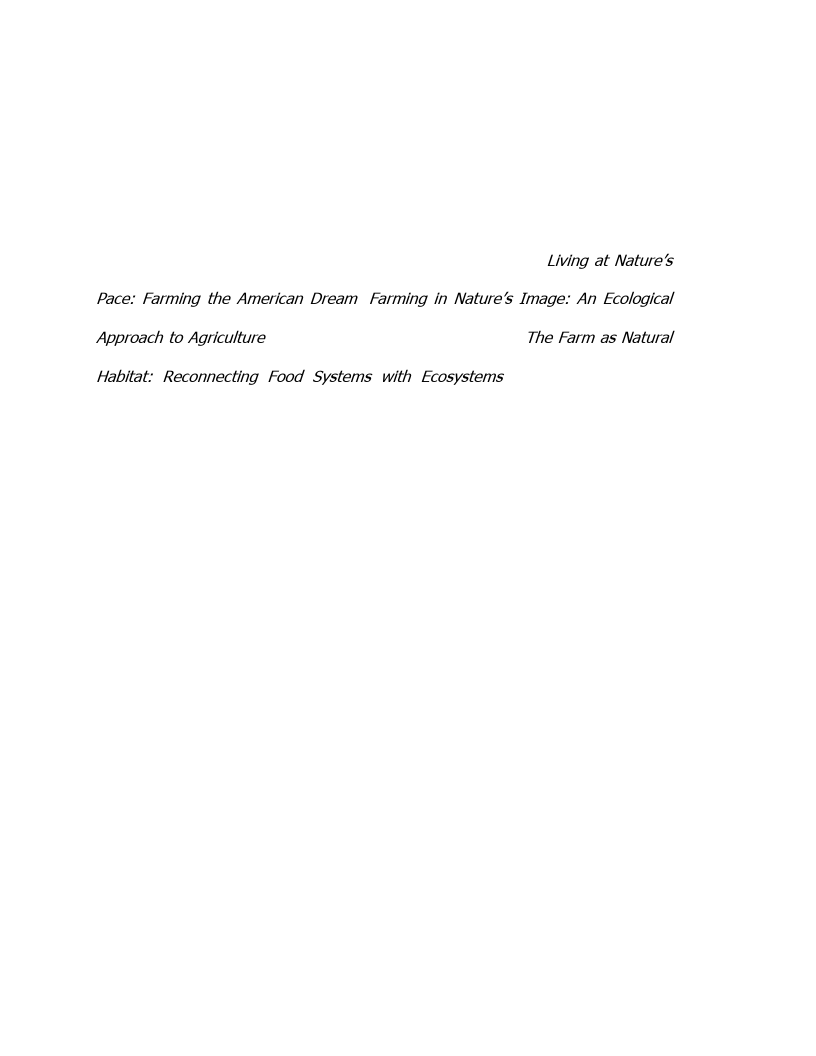
206
project, which used no artificial fertilizers, pesticides or irrigation, with machine
energy inputs provided by photovoltaic cells, bio-diesel, and draft horses.62 A
bold and radical model for a new agriculture, it‟s not fully free, but largely
independent of petrochemical inputs. At the Prairie Festival‟s mobile bookstore, I
stock my larder with other alternative models: Gene Logson‟s Living at Nature‟s
Pace: Farming the American Dream, Farming in Nature‟s Image: An Ecological
Approach to Agriculture by Judith Soule and Jon Piper, and The Farm as Natural
Habitat: Reconnecting Food Systems with Ecosystems, a set of provocative
essays edited by Wes‟s daughters Dana and Laura Jackson.63
During lunch break at the Land Institute‟s Prairie Festival, I bring the remains of
my previous night‟s dinner to the crest of a hill overlooking the Wauhob Prairie
on the Land Institute‟s property. As I munch chips and salsa, I notice a figure
angling down from the highest hill in my vista, directly across from where I sit
and ruminate on the morning‟s proceedings. As the walker reaches the bottom
of the slope he stops, looks in every direction, then strikes straight up the hill
towards me. He puffs up to a stop, drawls “That sure was more than I
bargained for!” and flops down on the ground.
After introductions, Fred – white-haired with a dyed streak of green and a
mean sense of humor – launches into the tale behind his ramble; a friend of his
and Wes Jackson‟s – a brilliant creative thinker if my new acquaintance was to
be believed – had died some time back and requested his ashes be scattered on

207
the hilltop across the way. Supposedly a memorial marker noted the spot, but
my new companion could not find it. “But I found a thatch of sage growing up
there, and that was one of his favorites so I figure that‟s where he lies. Pretty
enough spot anyhow.”
As Prairie Festival festivities close on Sunday, I return to the field where
I‟d first met Fred. Before I undertake my long drive to my next destination I
want to scramble up that hill and pay homage to the ashes of that man who so
loved its vista. Ambling down the hill, I brush against the late-season residues of
late-season prairie richness; black ribbed post-flowered blue wild indigo, fragrant
pitcher sage, and gangly blazing star. At the tree line I find Monarch butterflies
weaving through the grasses like shuttlecocks on a sewing machine; a cascade
of butterflies. Off to the side, I see a white flowered shrub, shimmering in the
early-afternoon sun. What I first took to be fluttering leaves, on closer
examination turns into a teeming mass of butterflies; yellows, white, and a
dimpling of Monarchs. Whatever this plant, it‟s obviously the butterfly version of
a combo disco/diner for all the ecstatic motion and succulent repast.
Driving away from the Institute afterwards, I pass huge fields of fully
matured corn in the slanting late sun. An optical illusion mesmerizes me. Light
shuttering through phalanxes of evenly spaced stalks creates an effect like one
of those flip books we all once made as kids, where each page with a slightly
altered drawing looked like a movie when the thumb flicked through the stack.
That which is still seems electrified with motion. It‟s easy to think of native

208
prairies as somehow alive and agribusiness plots as somewhat inert. This corn,
genetically modified and corporately commoditized, is still a living thing,
possessing a nature and integrity all its own.
But as the Land institute and other research institutes and alternative
farms demonstrate, there may be ways to grow food that draw from the wisdom
of prairie ecosystems, without diminishing the ability to sustain soil or soul.
Cascade of butterflies, movie reel of corn; to be native to a place is not
necessarily to become domesticated, to be domesticated is not to imply being
fully tamed. Imagination crosses the boundaries that otherwise might separate
the innate from the introduced. In order to find a facile resilience that honors
both diversity and commodity, one must sometimes stand with one foot in the
wild and the other in domesticity.

209
FUNDAMENT / FIRMAMENT
When I landed on the soil, I looked on the ground and I says this is free ground.
Then I looked on the heavens, and I says them is free and beautiful heavens.
Then I looked within my heart, and I says to myself I wonder why I never was
free before? 64
– John Solomon Lewis, on his arrival in Kansas
Seeking road-side respite on a long stretch of driving across Kansas west of
Salina, I pass a historical marker signpost just ahead for the town of Nicodemus.
Pulling aside a shaded park with scattered picnic tables, I decide to take a break
from the road and pull out my makings for lunch. Sandwich in hand, I cross the
grass to an information board. With the words “In July 1877, negro “exodusters”
from Kentucky established a settlement here in the Promised Land of Kansas…” I
am riveted. I‟ve happened upon the sole remaining African American town in the
west from the Reconstruction Period following the Civil War.65
Though the North‟s victory over the South technically ended slavery, some
grim times lay ahead for newly freed blacks seeking equality and prosperity.
Shadow organizations like the Klu Klux Klan emerged to ensure white supremacy
in all things economic, and separatism in everything else. Seeking opportunity,
African American leaders like Henry Adams and Pap Singleton tirelessly promoted
relocation from the oppressions of the South to the Freedom of the West. Home

210
of the famous abolitionist John Brown, Kansas became one of the most popular
destinations. A trickle became a flood: within ten years, from 1870 to 1880, the
population of blacks in Kansas soared from 16,250 to 43,110, some 6,000 of
whom were exodusters from the South. Fleeing blacks like Reverend Simon
Roundtree, Zack Fletcher and wife Jenny Smith Fletcher became Nicodemus‟s
first settlers and early town leaders, spurring others to colonize the town.66
Surviving the initial harsh winter by selling buffalo bones, taking work far
away, or accepting help from the Osage natives, these pioneers planted their
first crops the following spring as the town began to prosper. By 1887 there was
a full complement of stores and services, several churches, post office, hotel, two
newspapers, a band, even a baseball team. But continued growth was doomed
by failure to lure the Union Pacific Railroad to pass through their town.67
Gradually, some moved away, others died, and the Great Depression and
Dust Bowl took their toll here as elsewhere. By 1935 only 76 residents could be
accounted for. In 1997, Bill Clinton signed a bill authorizing the designation of
Nicodemus as a National Historic Site. The NPS now leases space in the old
town hall with plans underway to restore several other historical buildings.68 The
town of 20 now annually hosts an emancipation celebration every July and a
„Juneeteenth‟ jazz and blues festival in the month before.69 Perhaps further
promise yet to come awaits the town of Nicodemus and others like it across the
Great Plains, but only if they can re-imagine an economy more diverse than corn
or soybeans alone. We must imagine a more diverse way of growing our food,

211
following principles like those advocated by the Land Institute, lessons they have
been earnestly learning from native prairie habitat. But we must also learn from
prairie lands to imagine our way into more diverse relations with each other.
Our hosts at the Land Institute‟s Prairie Festival in Salina, KS alternated
between cracking wise and waxing apologetic for the ongoing debate at the
Kansas Board of Education over the teaching of evolution and intelligent design
in the classroom. These two philosophical poles of argument mirror a similar
continuum to that of commodity and diversity. Might emergent political and
religious practices be a reflection of workings on the land? While one segment of
the Midwest population symbolically model their beliefs after the diversity of a
mature tall-grass prairie, another seems to take their cue from large scale,
mono-cultural farming.
Noting extensive changes in land-use and economic patterns here over
the last 150 years, I ponder that a region that once gave rise to some of this
nation‟s most progressive political and spiritual movements has now become the
seat to fundamentalist religious zealots.70 In Capital City, we see a depiction of a
city and region perched on a commercial and political powder keg, but the
radical roots depicted in the novel‟s fictionalized agrarian politics run quite deep.
Radical, from the Latin radix, translates to „root‟:71 is it any wonder that a
landscape that gives rise to bluestem and its unfathomable reach into the soil
would also inspire political sensibilities rooted in soulful values respecting
individual farmer‟s rights and progressive community-based values. Rising land

212
prices, high mortgages, plummeting prices, and rampant railway land
speculation, all conspired to concentrate wealth to a privileged elite. In
response, „The National Grange for the Patrons of Husbandry – „the Grange‟ for
short – was founded in 1867 in Minnesota and spread rapidly through the
agrarian Midwest.72 Regional organizations such as the Farmers and Laborers
Union and the Colored Farmers National Alliance also arose. Their genesis
summons a familiar story to those who worked the land; the hand that sells, not
the hand that grows, is the one that has the full grip on the wallet. Through the
1880‟s, continuing ongoing tensions between poor growers and privileged sellers
gave birth to a pro-farmer Populist Party that managed to elect 5 U.S. senators,
6 governors, and 46 congressmen in the 1890 elections.73
One of the primary planks in the Populist platform spoke out against the
exclusive emphasis on property rights and the ownership of land by those who
did not work it, a politic indicative of a region settled by homesteaders scratching
out an existence on relatively small plots of land. Ideals of self-reliance and
cooperative labor and mutual support abounded in the Midwest.74 Fast forward
a hundred years and the polarities reverse; strident voices on AM talk show radio
blast those who would weaken property rights in any way, shape or form.
Absentee owners amass larger farms and ranches, and greater federal subsidies
for oil-intensive production. And the Kansas that once welcomed John Solomon
Lewis and others like him to free ground and freedom of heart and soul now has
become a breeding ground of political divisiveness and religious intolerance.

213
The early Midwest described by writers such as Mari Sandoz and Willa
Cather was characterized by significant religious tolerance: Hutterites,
Mennonites, Amish, Plain Quakers, Shakers, Bruderhofs, Swedenborgs,
Moravians, Rappites, Amanas; all these and others were welcomed as
homesteading settlers to the new promised land,75 though it must be noted that
there was a pronounced lack of religious tolerance for those Native Americans
still in the area. A great deal of this diverse influx was a result of the European
immigration encouraged as a result of the 1862 Homestead Act, but religious
seekers from other parts of North America, including Baptist blacks from the
Reconstruction south, made their way to Kansas, Nebraska, Iowa and other
prairie states.76 One must wonder where that nuanced climate of tolerance has
gone. Popular media leads us to believe that all Christians are rabid
fundamentalists and all scientists intolerant of spiritual discourse. The truth is
likely as nuanced and varied as a wild prairie, but few on the Left or Right take
the time to delve beneath their knee-jerk prejudices.
Prairie plenitude rests on a fundament of soil; and our human plentitude
surely subsists from the fundament of integrative soulfulness we experience.
Having razed the diverse forest of grass and raised a monocultural factory of
corn, can we pretend that a poisoned and perishing soil has not also diminished
our individual and collective character? Wes Jackson and his colleague‟s lifelong
experiment at the Land Institute attempts to balance economic and ecological
interests. Their effort suggests that land and soil might be rejuvenated even

214
while providing ample food. Restoration of land may also require a restoration of
our abiding relationship to that land, and a reformation of attitudes and habits,
as well as a re-imagination of hope.
From Jackson‟s “agri-prairie” experiment, I traveled east about 50 miles to the
nation‟s first federal native prairie reserve. Leaving my car behind, it‟s as if any
moment I could fly. I face into a persistent east-bound wind at the crest of a hill
at the National Tallgrass Prairie Preserve near Strong City in the Flint Hills.77 As I
hold out my arms and lean into the column of air, I must check to make sure I
haven‟t actually grown wings. The nearest trees stand at least a quarter mile
away. Even these few cluster like outcasts in a tuck of the valley. From every
vista flow strong currents of open space, bursting stretches of sharpened light,
and the ceaseless murmuring of tall grasses.
Nearly 11,000 acres in reach, this site is the nation‟s sole publicly
maintained facility dedicated to the preservation of the legacy of tallgrass
prairie.78 As I spin on my heels for a 360 degree view, another surge of primal
spaciousness flows through me, something I can only imagine ancestral natives
and first explorers of this realm feeling as they stood in such locales. It‟s a
defining moment: the East feels extremely claustrophobic to me, not only from
the thickly reforested landscape and densely populated locales, but from the
thicket of ongoing duties, never-ending projects, and monotonous meetings of
my increasingly complicated personal and professional existence.

215
I remember back to my first experiences of tallgrass prairie at Hayden
Reserve in northeast Iowa. There I‟d diligently screened out my immediate
surround in order to imagine the vastness of America‟s historical prairies. Here I
can open my eyes, my senses, my mind, and my heart, with every vista as wide
open as the others. It‟s the external antithesis to my internal intellectual and
emotional terrain, which more closely mirrors the intensely cultivated farms
blanketing the rest of the state than this spacious expanse that radiates out from
where I stand.
While most acreage in the region is plowed fencerow to fencerow, why
have settlers left this slice of the Flint Hills relatively intact? It‟s all in the name.
As the porous soils of the Sandhills discouraged intensive agriculture over some
19,000 square miles of Nebraska into South Dakota, so too were the Flint Hills
given inadvertent protection by geology. Underlying ridges composed of flint,
chert and limestone outcrops cracked the firmest resolve of settler‟s plows. As
with the Sandhills, so also was much of this spacious acreage put into employ for
the fattening of cattle.79 The Tallgrass Prairie Preserve owes its existence to
ranching. Following years of concerted and sometimes contentious political
negotiations, the Z Bar/Spring Hill Ranch was finally purchased by the federal
government and placed under the joint management of the National Park Service
and the National Park Trust in 1996.80 Though intensively grazed for nearly a
century, the land still recalls much of its underlying integrity, especially in
windswept ridges such as this.

216
Here, where the wild persistent wind sweeps everything clear, I give
myself over to this land. Let those outer winds scour clean the sculpted curving
surface of these hills. Let my inner winds tempest and roar as well, sweeping
clear the chaff and cull of dead thoughts, desiccated stalks of belief, broken
branches of misplaced action. Dark rain-swollen clouds boil upwards and blow in
from the west. I take in the patterns swirling through the bluestem and switch
grass. If this were dance, I would be stunned by the masterful choreography.
Shafts of sun snaking through torn rents in the cumulonimbus add to the
kaleidoscopic effect. Outcrops of limestone and chert thrust from the thin soil.
Some, weathered and hollowed by time, hold ephemeral pools lined with a
community of mosses and tiny ferns.
For a moment, I can visualize myself in this area after the Permian-age
limestone laid down under eons of inland sea was thrust upward by the toss and
tilt of geologic muscle. Having grown up in a heavily wooded area of the
Northeast, this treeless slope seems the epitome of a blank slate. Humbled by
millennia of persistent weathering, this place becomes exalted by enterprising
flora and fauna. I picture enterprising grass seeds blowing in along with clay
and silt from the engineering rivers further west and south, lodging in the cherty
gravel, and rooting down through cracks in the limestone bedrock. In such a
landscape anything seems possible.
Two weeks into my prairie sojourn, I'm liberated of artifice and normality.
No one I meet knows me or a damn thing about me. I can shed the coat of the

217
overworked colleague, the grieving son, the concerned brother. I can pretend to
be a Jehovah's Witness, a dangerous criminal, an encyclopedia salesman, an out-
of-work Chippendale‟s dancer. Prairie landscapes constantly reinvent
themselves. In a place like this preserve, populated by some 400 plant and over
200 bird and mammal species, then every footstep could create a new niche,
every rainfall a potential rise of one organism and the demise of another, every
grain of blowing sand a possible tip in balance from one species over another.
Gazing out into the limitless horizons under the expansive sky, my mind
truly empties and my spirit stretches out into fifty miles of elbow room. But
prairie reality at is not really an emptiness waiting to be filled, but a dynamic
fullness reflecting maximum potential for creative change. Root paradox to the
prairie may be that a place so open can also be so packed to bursting.
Lessons from prairie spaciousness and its teeming complexity show that
soil‟s fundament reflects creation predicated on vast diversity, not abnegation of
singular difference. Tall grasses sink deep into the earth‟s firmament, but never
stand alone in native grasslands ecology. When humans invest deeply in
fundamentalist principles, they often espouse just one way of being, one true
belief. Thinking like a prairie shows me that hundreds of ways of knowing knit
the fabric whole, reinventing, resilient not because it is steadfast and fixed but
imminently and variably adaptable.

218
A DIVERSITY OF DISTURBANCE
Near gale force winds threaten to topple me from a limestone ridge I traverse on
the Konza Prairie, an 8,700 acre Flint Hills tallgrass prairie preserve east of
Manhattan KS, cooperatively managed by Kansas State University and the Nature
Conservancy.81 Not-so-distant rumbles of thunder advise me to descend, but I
push forward, buffeted by twin forces of weather and curiosity.
The trail bends towards the north, descends for a bit, then joins the winds
again at another crest. I discern a small numbered sign to my right. Digging out
the keyed guide from my day pack, I read of an ancestral bison wallow further to
the right. I kneel down, out of the brunt of the wind, and let my eyes wander
over the surface of the ridge, tracing fold and curve of the wallow which has not
felt the roll and sway of any native beast for at least two hundred years. Yet the
imprint of this wallow still readily shows, writ by bison‟s elemental disturbance.
Later, I read a passage from O.J. Reichmann‟s Konza Prairie about the
fierce competitiveness of plant life on the prairie. A single glancing footprint
might subtly compress the soil or crush some existing plant, and alter the profile
of those few square inches in such a way that a new plant (or set of plants),
latent in that place or nearby, might spring into being.82 Where a bison‟s wallow
persists beyond its bones, and a ranging cow‟s footfalls might change the course
of natural history, is it any wonder why Konza Prairie contains upwards of 600
unique plant species?

219
Consider each landscape as having a language; a lexicon and syntax
unique to that place. Say that species are the nouns. Do these alone tell the
story of a place? I could recite a litany of prairie species yet it would be as
meaningless to you as my weekly grocery list. I choose not to read my
dictionary when I‟m in the mood for a good story. Meaning is made through
complete sentences awash in verbs, adverbs, prepositions and adjectives as well
as nouns, joined in ways that evoke or provoke, compel or repel, expire or
inspire thought, emotion and reflection.
If species are nouns, then perhaps disturbances and other biotic and
abiotic processes constitute the lexicon of verbs with which a place tells its story.
Wind, lightning, bison, beef cow, human; each wields a force that acts upon the
curved prairie earth, and yields a subtly altered organic syntax. If certain
landscapes hold more biodiversity than others, then perhaps a diversity of
disturbance verbiage contributes as much as an extent glossary of species.
Contrast Konza with other regions due west of here where one could
count the different species on the fingers of both hands held firmly to the wheel
of the John Deere tractor plowing under the remnant stubble of corn, sorghum,
wheat or soybean. The compacting wheels of a tractor as well as the actions of
various towed implements, represents one kind of disturbance. The application
of petrochemical based pesticides, herbicides and fungicides provide others. The
tungsten steel blade of a farmer‟s plow is every bit the disturbance of a bison‟s
hoof or a meadow vole‟s chew, and then some. This factor of active disturbance

220
doesn‟t account for the differences in species diversity between areas such as
Konza with those where modern agriculture is practiced.
While the actions and dynamics of climate, geology, and an evolving cast
of organisms evoke various stories of place, humans seem to yield a
disproportionate effect. One of many possible nouns in such places, we also act
as divisive prepositions as well as hyperactive verbs in each place narrative,
capable of silencing a landscape‟s other voices. For a meaningful dialectics of
place-based paradox, there may need to be a much more nuanced lexicon of
processes as well as of species. In examining various landscapes across the
North American continent, I infer that each disturbance creates a particular and
unique kind of opportunity. But not all prospects reflect equal quality to
opportunistic species, nor does each interruption in the ecological status-quo
welcome the same quality of guests.
Each variety of disturbance acts as a verb, but these may also be taken to
be temporal and spatial adverbs. As such, characteristics of the plant and animal
community might well be seen as adjectives. A richly textured language
possesses an extravagance of words with uniquely distinctive qualities. Imagine
if we only had four or five nouns, a dozen or so adjectives and adverbs, a
handful of verbs, and one dominant pronoun. What meaning is a landscape able
to utter, what tales does it birth, when it‟s reduced to a small set of genetically
manipulated nouns of increasingly homogenized character, an intrusive ordering

221
of low quality verbs, often diverted by a single fundamentally arrogant and
largely ignorant preposition?
While some of our human stories may be rendered flat on the page or
screen, those told by the land carry dimensions far beyond any syntactical
metaphor. In profligate prairie and productive farm field alike, there‟s always
more than one storyteller, even though the number of available tales may vary
considerably. Humans are not the only agent of disturbance, though we seem to
corner the market on a number of those that create lower quality opportunity.
Find me an organism which can survive massive applications of 2,4-D and diuron
and I will bargain that that species that might one day rule the planet in our
stead, and I will guess also that it may currently be but a bit player in the cast of
a native grassland. For now, I propose that quality of disturbance be measured
by the yield of desirable species that arise from its capacious opportunity.
However we define quality, it is a matter of course that all organisms
disturb their habitats, even at infinitesimally small scales. What‟s the acceptable
level of disturbance? That which reduces the likelihood for one species may
indeed be an opportunity for another, but some disturbances open the floodgate
to wholesale changes that rend the integrity of a landscape, while others pave
the way for incremental opportunities promoting variety and resilience. If
diversity of disturbances conjures bio-diverse ecological integrity and place
persistence, then measures of quality and scale must be taken into account too.

222
Out of the wind for now, I watch an exodus of crows my presence has disturbed
sluice out of the cottonwoods and sycamores lining the valley streambed and
fight the tempest of air making their way to their next station. Across from me,
on the other descending ridge, half a dozen wild turkeys disappear into dense
shrubs that follow the course of an old stone wall. Konza was not always home
to wild species alone. For the better part of a century the land was
homesteaded and improved for agriculture. Remains of the farm, its springs,
fencerows, and outbuildings, are now managed as part of the Konza cooperative
preservation and research venture. From the numbers of skittish birds and
scuffling mammals that spirit away as I approach, I would guess that the original
settler Andrew Hokanson and those that followed till the land was ultimately
procured for preservation offered high enough quality of disturbance on small
enough scale to leave this place more enriched than impoverished.83
As storm approaches, this valley looks like a cathedral sanctuary with a
congregation of crows and choirboy turkeys. I‟m the acolyte here, seeking the
inherent wisdom from a well-versed prairie sermon. As with all good churchly
homilies, the challenge is not just to hear the message, but to embody it as well.

223
THINKING LIKE A PRAIRIE ENDNOTES
1 "Neal Smith National Wildlife Refuge Prairie Learning Center," United States Fish and Wildlife
Service, 26 Sept. 2006, <http://www.fws.gov/midwest/nealsmith/>. A list of prairie reserves is
available on the Iowa Dept. of Natural Resources web page. "Iowa D.N.R. State Preserves,"
State of Iowa Department of Natural Resources, 14 Sept. 2006,
<http://www.state.ia.us/parks/select.htm>.
2 "Ada Hayden," Iowa State University, 17 Sept. 2006,
<http://www.public.iastate.edu/~herbarium/adapage.html>. "Iowa Women in Science: Ada
Hayden," Iowa State University, 17 Sept. 2006,
<http://www.lib.iastate.edu/spcl/exhibits/20thWomen/Listpages/hayden/prairie.html>.
3 The Carter Family, Fifty Miles of Elbow Room, Song, Rhapsody, 1941.
4 I would also devour a vast array of books on the area, including the tallgrass prairie classic
John Madson, Where the Sky Began: Land of the Tallgrass Prairie (Ames, IA: Iowa State
University Press, 1995). Also the lesser known David Costello, The Prairie World (Minneapolis,
MN: University of Minnesota Press, 1969). In addition the sensational exploration of place and
Ideas: Paul Gruchow, Grass Roots: The Universe of Home (Minneapolis, MN: Milkweed Editions,
1995).Representing a first person account of Sandhills exploration is Stephen R. Jones, The Last
Prairie: A Sandhills Journal (Camden, ME: Ragged Mountain Press, 2000).
5 "The Land Institute: About Us," The Land Institute, 4 Oct. 2006,
<http://www.landinstitute.org/vnews/display.v/SEC/About%20Us>.
6 "Tallgrass Prairie National Preserve: Home Page," National Park Service, 12 Oct. 2006,
<http://www.nps.gov/archive/tapr/home.htm>.
7 O. J. Reichman, Konza Prairie: A Tallgrass Natural History (Lawrence, KS: University Press of
Kansas, 1987).
8 For an articulate and well researched exploration, see Richard Manning, Grassland: The History,
Biology, Politics and Promise of the American Prairie (New York City: Penguin Books, 1997).
9 Doug Ladd, Tallgrass Prairie Wildflowers (Helena, MT: Falcon, 1995). Also, Russell R. Kirt,
Prairie Plants of the Midwest: Identification and Ecology (Champaign, IL: Stipes Publishing,
1995).
10 Konza prairie reserve in the Flint Hills of Kansas holds upwards of 600 plant species.
Reichman, Konza Prairie: A Tallgrass Natural History.
11 "Major Issues Facing the Prairie," Iowa Prairie Network, 19 Sept. 2006,
<http://www.iowaprairienetwork.org/issues/issues.htm>.
12 I could not verify an original source for this quote, though it is often repeated and attributed to
Einstein.
13 Willa Cather, My Antonia (Boston: Houghton Mifflin, 1995).
14 Attributed to Whitman, from a plaque on a viewing tower overlooking Valentine National
Wildlife Refuge in the Nebraska Sandhills.

224
15 Manning, Grassland: The History, Biology, Politics and Promise of the American Prairie 9.
16 Macleish, The Day before America: Changing the Nature of a Continent 32-55.
17 Manning, Grassland: The History, Biology, Politics and Promise of the American Prairie 6-8.
18 Edward H. Faulkner, Plowman's Folly (Norman, OK: University of Oklahoma Press, 1943). This
was both literally and figuratively a "groundbreaking" work, published in the 40s, and exposing
the environmental risk of destruction of soil integrity by over-zealous plowing.
19 Gretel Ehrlich, The Solace of Open Spaces (New York City: Penguin, 1986).
20 "Neal Smith National Wildlife Refuge Prairie Learning Center,"
21 Ibid.
22 "Turin Loess Hills Preserve," State of Iowa Department of Natural Resources, 29 Sept. 2006,
<http://www.state.ia.us/parks/turin.htm>.
23 "Iowa State Preserves," State of Iowa Department of Natural Resources, 15 Sept. 2006,
<http://www.state.ia.us/parks/select.htm>.
24 C. S. Holling Brian Walker, Stephen R. Carpenter, and Ann Kinzig, "Ecology and Society:
Resilience, Adaptability and Transformability in Social–Ecological Systems," Ecology and Society:
A Journal of Integrative Science for Resilience and Sustainability, 30 Sept. 2006,
<http://www.ecologyandsociety.org/vol9/iss2/art5/main.html#Resilience>.
25 A handful of books provided information on the scope and scale of prairie restoration and
conservation practices in North America: Fred B. Samson, and Fritz L. Knopf, ed., Prairie
Conservation: Preserving North America's Most Endangered System (Washington, D.C.: Island
Press, 1996). Robert F. Sayre, ed., Recovering the Prairie (Madison, WI: University of Wisconsin
Press, 1999). Stephen Packard, and Cornelia F. Mutel, The Tallgrass Restoration Handbook: For
Prairies, Savannas, and Woodlands (Washington, D.C.: Island Press, 1997). Also, the brief and
practical hands-on guide Carl Kurtz, A Practical Guide to Prairie Reconstruction (Iowa City, IA:
University of Iowa Press, 2001).
26 John Janovy Jr., On Becoming a Biologist (Lincoln, NE: University of Nebraska Press, 1996).
27 Among Sandoz's works evoking life on the Sandhills are Mari Sandoz, Old Jules (Lincoln, NE:
University of Nebraska Press, 1962).; Mari Sandoz, Old Jules Country (Lincoln, NE: University of
Nebraska Press, 1982).; Mari Sandoz, Sandhill Sundays and Other Recollections (Lincoln, NE:
University of Nebraska Press, 1984).; and Mari Sandoz, Love Song to the Plains (Lincoln, NE:
University of Nebraska Press, 1966).For an engaging biographical evocation of Sandoz, see Helen
Winter Stauffer, Mari Sandoz: Story Catcher of the Plains (Lincoln, NE: University of Nebraska
Press, 1982). For a more intimate portrait of the author, with letters, unpublished manuscripts
and other mementoes of her sister, see Caroline Sandoz Pifer, Making of an Author: Mari Sandoz:
Books I-Iv (Crawford, NE: Cottonwood Press, 1988).
28 John Janovy Jr., Keith County Journal (New York City: St. Martin's Press, 1978).
29 Ibid. 'Termite Country,' 1-11.
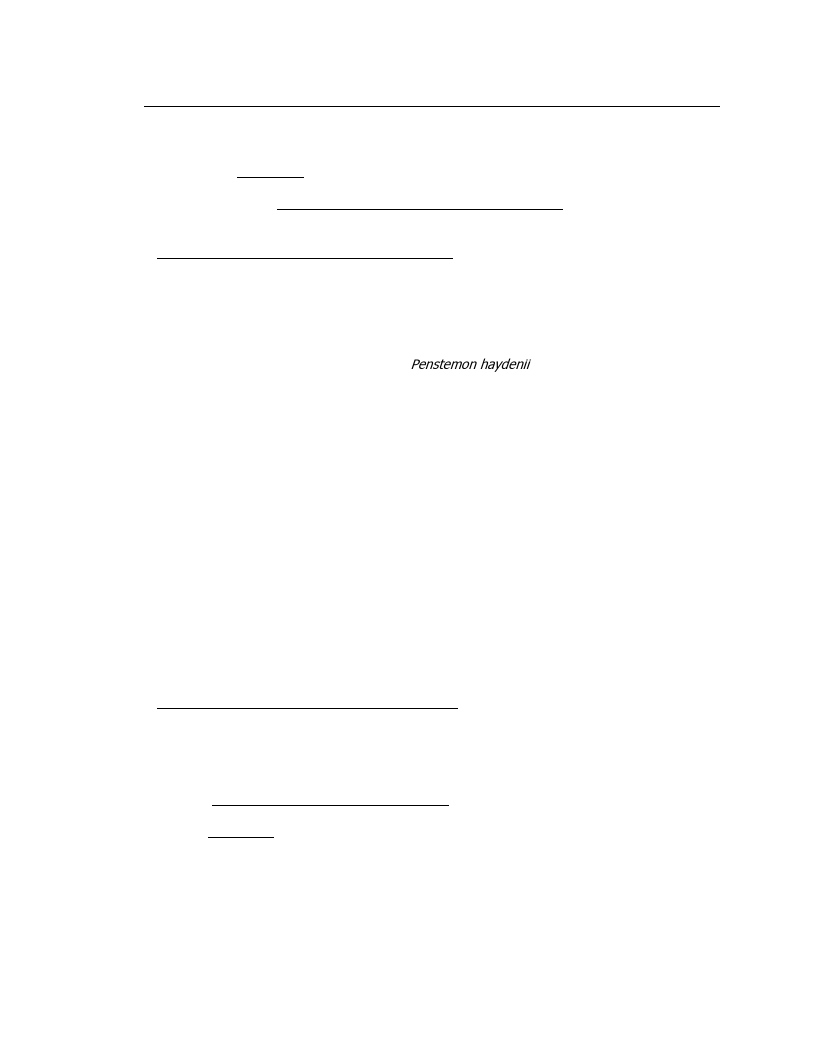
225
30 Ibid. 'The Fundulus Chronicles,' 114-38.
31 Mari Sandoz, Capital City (Lincoln, NE: University of Nebraska Press, 1982). For a historical
account of the places and periods before, during and after that represented In Sandoz' fiction,
see Donald R. Hickey, Nebraska Moments: Glimpses of Nebraska's Past (Lincoln, NE: University of
Nebraska Press, 1992).
32 Crescent Lake National Wildlife Visitor Information, (United States Fish and Wildlife Service,
2005).
33 "Center for Plant Conservation National Collection Plant Profile: Penstemon Haydenii," Center
for Plant Conservation, 7 Oct. 2006,
<http://www.centerforplantconservation.org/ASP/CPC_ViewProfile.asp?CPCNum=3241>.
34 Reading over the federal recovery plan for Penstemon haydenii, I note that before the Feds
approve a classification change from endangered to threatened status, there needs to be a
minimum of 10,000 plants in 5 separate population groups. To de-list, there need to be 15,000
occurring in 10 separate and stable populations. "Species Profile: Blowout Penstemon
(Penstemon Haydenii)," United States Fish and Wildlife Service, 7 Oct. 2006,
<http://ecos.fws.gov/speciesProfile/SpeciesReport.do?spcode=Q2EX>. Also, "Blowout
Penstemon (Penstemon Haydenii) S. Watson Recovery Plan," United States Fish and Wildlife
Service, 7 Oct. 2006, <http://ecos.fws.gov/docs/recovery_plans/1992/920717.pdf>.
35 "National Grasslands Visitor Information", United States Department of Agriculture Forest
Service, 2005.
36 "Homestead Act," National Park Service, 10 Oct. 2006,
<http://www.nps.gov/home/homestead_act.html>.
37 Ibid.
38 These included the National Land Use Planning Committee (1932), Department of Agriculture‟s
Resettlement Administration (1935), the Bankhead-Jones Farm Tenant Act of 1937, and transfer
in 1938 to the Soil Conservation Service. "National Grasslands Visitor Information",
39 Toadstool Geologic Park, Oglala National Grassland, (United States Department of Agriculture
Forest Service, 2004).
40 "History of Hudson-Meng Bison Kill," Hudson-Meng Bison Kill, 13 Oct. 2006,
<http://www.hudson-meng.org/Hudson-MengHistory.html>.
41 Stauffer, Mari Sandoz: Story Catcher of the Plains.
42 Sandoz, Capital City.
43 Ibid.
44 "National Grasslands Visitor Information",
45 "Valentine National Wildlife Visitor Information," (Valentine, NE: United States Fish and
Wildlife Service, 2005).

226
46 The story might be much like that portrayed by Marc Reisner, Cadillac Desert: The American
West and Its Disappearing Water (New York City: Penguin Books, 1987).
47 The New Century Dictionary of the English Language 1590.
48 Michael J. Cohen, Reconnecting with Nature: A Restoration of the Missing Link in Western
Thinking. Project Natureconnect (Friday Harbor, WA: Project NatureConnect, University of Global
Education, 1995).
49 Michael J. Cohen, The Web of Life Imperative: Regenerative Ecopsychology Techniques That
Help People Think in Balance with Natural Systems (Friday Harbor, WA: Institute of Global
Education and Trafford Publications, 2003).
50 From the web site of Expedition Institute founder Michael Cohen and his Institute for Global
Education. Michael J. Cohen, "Thinking and Feeling Disorders Reduced by the Corrective Flow of
Natural Systems Ecotherapy," Institute of Global Connection, 20 Nov. 2006,
<http://www.ecopsych.com/wholeness66.html>.
51 "Brain Basics: Know Your Brain," National Institute of Neurological Disorders and Stroke, 15
Oct. 2006, <http://www.ninds.nih.gov/disorders/brain_basics/know_your_brain.htm>.
52 Richard Andrus, "Ecological Principles and Agricultural Practices," (Binghamton, NY: State
University of New York at Binghamton, 1979). One of our primary texts for the course was
Richard Merrill, ed., Radical Agriculture (New York City: Harper and Row, 1976). More currently,
offering a stirring critique of industrial agriculture is Andrew Kimbrell, ed., The Fatal Harvest
Reader: The Tragedy of Industrial Agriculture (Washington, D.C.: Island Press, 2002). For a
more hopeful vision of modern agriculture see Daniel Imhoff, Framing with the Wild: Enhancing
Biodiversity on Farms and Ranches (San Francisco: Sierra Club Books, 2003).
53 An avid gardener and attentive vegetarian, the caloric input into my diet was still a
considerably high ratio. Andrus, "Ecological Principles and Agricultural Practices."
54 Faulkner, Plowman's Folly 43-54.
55 Masanobu Fukuoka, The One-Straw Revolution (New York: Bantam Books, 1978).
56 Wendell Berry, The Unsettling of America: Culture and Agriculture (New York City: Avon Books,
1977).
57 Jackson, Becoming Native to This Place.
58 Wes Jackson, New Roots for Agriculture (Lincoln NE: University of Nebraska Press, 1980).
59 Wes Jackson, Altars of Unhewn Stone: Science and the Earth (New York City: North Point
Press, 1987).
60 "The Land Institute: Prairie Festival X.X.V.," The Land Institute, 1 Sept. 2003,
<http://www.landinstitute.org/vnews/display.v/ART/2000/08/04/3d91e92ed05c4>.

227
61 "The Land Institute Visitor Information," (Salinas, KS: The Land Institute, 2004). Also, "The
Land Institute: Overview," The Land Institute, 4 Oct. 2006,
<http://www.landinstitute.org/vnews/display.v/ART/2000/08/10/379f4e853>.
62 "The Land Institute: Sunshine Farm Research," The Land Institute, 4 Oct. 2006,
<http://www.landinstitute.org/vnews/display.v/ART/1999/07/01/377bbca63>.
63 Gene Logsdon, Living at Nature's Pace: Farming and the American Dream (White River
Junction, VT: Chelsea Green Publishing Company, 1994). Judith D. Soule, and Jon K. Piper,
Farming in Nature's Image: An Ecological Approach to Agriculture (Washington, D.C.: Island
Press). Dana L. Jackson, and Laura L. Jackson, The Farm as Natural Habitat: Reconnecting Food
Systems with Ecosystems (Washington, D.C.: Island Press, 2002).
64 "Stories of the Great Westward Expansion - Stories to Be Told - African American History in the
National Parks: The Exodus to Freedom," National Park Service, 12 Oct. 2006,
<http://www.nps.gov/untold/banners_and_backgrounds/expansionbanner/exoduster.htm>.
65 "Nicodemus National Historic Site," National Park Service, 12 Oct. 2006,
<http://www.nps.gov/nico/>. Additional travel information on Nicodemus can be found at
"Nicodemus, Kansas: A Black Pioneer Town," Legends of America, 12 Oct. 2006,
<http://www.legendsofamerica.com/OZ-Nicodemus.html>. More information on the Exodus and
Southern Reconstruction can be found at "African American Odyssey: Reconstruction and Its
Aftermath," Library of Congress, 12 Oct. 2006,
<http://memory.loc.gov/ammem/aaohtml/exhibit/aopart5.html>.
66 "Nicodemus, Kansas: A Black Pioneer Town,"
67 Ibid.
68 "Historic Buildings of Nicodemus," National Park Service, 12 Oct. 2006,
<http://www.nps.gov/features/nicodemus/buildings.htm>.
69 "North Central Region Sustainable Agricultural Research and Education Display," North Central
Region Sustainable Agricultural Research and Education
http://www.sare.org/ncrsare/nicodemus.htm>.
70 I gained much insight into the nature of fundamentalist thought from the writing of Karen
Armstrong, The Battle for God: A History of Fundamentalism (New York City: Random House,
2000).
71 The New Century Dictionary of the English Language 1460.
72 "National Grange," The National Grange of the Order of Patrons of Husbandry, 16 Oct. 2006,
<http://www.nationalgrange.org/about/history.html>.
73 Stanley K. Schultz, "How Ya' Gonna' Keep 'Em Down on the Farm?: The Rise of Populism,"
University of Wisconsin, 12 Oct. 2006,
<http://us.history.wisc.edu/hist102/lectures/textonly/lecture10.html>.
74 Wikipedia's definition of Populism is a useful starting point for many works detailing the rise
and fall of the Populist Party in North America: "Populism," Wikipedia, 16 Oct. 2006,
<http://en.wikipedia.org/wiki/Populism>.

228
75 Ontario Consultants on Religious Tolerance maintains an extensive data set of memberships in
various Christian denominations in the US, reflecting the diversity even within our majority
religion: "Christian Denominations in the U.S.," Ontario Consultants on Religious Tolerance, 14
Oct. 2006, <http://www.religioustolerance.org/us_rel2.htm>. The Religious Movements
Homepage Project at Univ. of Virginia maintains profiles of many groups cited in this passage:
"The Religious Movements Page: Alphabetic Listing of Group Profile Pages," University of Virginai,
14 Nov. 2006, <http://religiousmovements.lib.virginia.edu/profiles/listalpha.htm#h>>. The
National Park Service‟s Amana Colony site describes in detail the experience of one of those early
groups with a Utopian vision: "Utopian Societies: The Amana Colonies National Register of
Historic Places Travel Itinerary," National Park Service, 14 Oct. 2006,
<http://www.nps.gov/history/nr/travel/amana/utopia.htm>.
76 "Homestead Act," Specific information on the impact of homesteading via these acts can be
found at: "Kinkaid Act," University of Nebraska-Lincoln, 12 Oct. 2006,
<http://csce.unl.edu/~mbeerman/histday1.html>.
77 The region is explored with fascinating but near-excessive depth in the sprawling William Least
Heat Moon, Prairyerth (Boston: Houghton Mifflin, 1991).
78 Tallgrass Prairie National Preserve sites: "Tallgrass Prairie National Preserve: Home Page,"
also "Tallgrass Prairie National Preserve," National Park Service, 12 Oct. 2006,
<http://www.nps.gov/tapr>.
79 "Geology, Geomorphology and Geohydrology of the Flint Hills," Emporia State University, 20
Oct. 2006, <http://academic.emporia.edu/aberjame/field/flint/flint.htm>.
80 "Zbar/Spring Hill Ranch," National Park Trust, 18 Oct. 2006, <http://www.parktrust.org/zb-
glim.html>.
81 Reichman, Konza Prairie: A Tallgrass Natural History 2.
82 Ibid. 51-52.
83 Ibid. "Konza Prairie Trail Guide," (Manhattan, KS: Nature Conservancy and Kansas State
University, 2004).

229
CHAPTER V: PRACTICES OF PARADOX
MINDING MATTER
On my flight back to New Hampshire from Kansas, massive thunder-storms
diverted us to Harrisburg, PA. By the time I got back to Pittsburg and onto my
plane to Manchester, it was well after 2am. Reaching cruising altitude at 37,000
feet, the pilot said "You might want to take a look out the left side of the plane."
Horizon-wide Aurora Borealis startled me - stunning shoots, undulations and
waves of cascading light in brilliant color display for intoxicating hours till we
tucked back down into the clouds in our approach to final landing in Manchester.
Back home in the Northeast, it‟s as if I had not yet quite returned.
Something of the prairie mind and matter clung to me and so I sought
manifestations of spaciousness wherever I could find them; gazing at the open
sky mornings and evenings, staying up late at night when others lie fast asleep,
or walking to clear hilltops away from all distractions. Of course, spaciousness
learned prairie style is not only the seeming sensation of openness, but the
teeming milieu of dynamic possibility. It‟s not enough merely to create space,
but to offer a diverse lexicon of expressive opportunity available to fill and fulfill
newly disturbed openings. I take a week-long trip to New York City to immerse
myself in as much cultural, culinary, artistic and musical diversity as I can. The
object is not to fill myself to the point where I feel empty again, but to recognize

230
that a biodiversity of experience and perspective is as important to my own
integrity as to that of a fully functioning prairie ecosystem.
Having found my bearings in the prairie over time, in part through the
lens of familiar sensation and memory, I challenge myself now to reverse the
focus. When we frame the unfamiliar only through the frame of the familiar, we
find comfort but we may also trade in our ability to see the native vivacity within
the new. Since returning from the Sandhills of Nebraska and Flint Hills of Kansas
I‟ve tried to see the world around and within me through prairie eyes.
Struggling to write about this dynamic, I took a break to walk through the
cemetery near my house, overlain with a new fallen snow. Crossing the expanse
of white patched around dried grasses and dormant shrubs, I thought of the
potential for life buried just beneath the snow cover, hiding in the marrow of the
maples and oaks, shyly tipping the branches of marsh willows and sawgrass.
With the memory of tallgrass buoyancy, I began to see my wintry marsh, woods
and fields as a kind a prairie; the potential for teeming life, resilience and
reserve, held beneath the still and seemingly inert surface of the earth. If I am a
prairie, I wonder, where do I sunk my roots so that I might hold life in the face
of harsh weathers? If I live as prairie, from the tangle of such roots could I
gather my resolve and grow to the roof of the sky?
There‟s not a day when some image or memory of Iowa prairie remnants,
Neal Smith, Sandhills‟ Crescent Lake, Toadstool, and Fort Valentine, the Land
Institute, Tallgrass Prairie Preserve, or Konza fails to enter my vision or enhance

231
my perspective. It‟s as if a vast prairie had grown within me all along; awaiting
discovery, rife with diverse high quality disturbances, and ripe for restoration.
Such ruminations become the stuff of the ecology of our inner terrain, which for
me also now includes the high desert reaches of New Mexico and the rambling
ravines and slow-moving sloughs of the Pacific Northwest. Pay close attention to
any wild landscape for sufficient time and you‟ll discover that every day is a
biological resurrection.
On the Pajarito, I learned from fire that periodic disturbances were
sometimes necessary to reduce fuel load and to break down the fibers of organic
structures that had become rigid or whose nutrients were not readily available to
new growth. Severing connection on one level ironically can make the whole
more adaptable by breaking down relatively inflexible components into energy
and nutrients that can better flow to rising need. Suppression of naturally
occurring disturbances over time can set the stage for debilitating conflagration
at unexpected-flash points.
My fire walk revealed that even destruction has its place in individual,
species or habitat resilience. Fire and other periodic disturbances redistribute
matter, breaking down old or inert form and structure, liberating energy and
nutrients for new growth. Land use practices have shifted from absolute
suppression of fire to periodic use of controlled and proscribed burns. However,
sustainable application of fire and other implements in the disturbance tool kit
may require more localized thinking than we are ready to acknowledge. We tend

232
to apply our efforts, especially in Western lands, with broad brush strokes.
Pajarito taught me that one tree‟s rejuvenation may be another‟s devastation.
Time-transing in Seattle, I began to understand that most organized
systems, whether inner or outer landscape, operated along complex temporal
scales as well as spatial. Shifting dynamics or restoring connections required
recognition of the longer time frame involved. Rather than restoring a place to a
former state, we must restore the characters in an ongoing, ever-changing tale.
Re-storyation involves not so much the recreation of a fixed picture of idealized
constituents to a habitat, but of a revitalization of patterns, roles and flows of
energy whose trajectory can be inherently unpredictable. Questions of native
and non-native citizenship become subsumed to the larger integrating dynamics
of a healthfully functioning place. Rigid adherence to ecological dogma can
undermine ecological integrity.
But even this moving picture view of restoration requires stable reference
points like Ravenna with its old growth vestiges of cedar and spruce. In heavily
urban settings, neighborhoods, buildings, even individual people play vital roles
in the historical ecology. Whether actual or symbolic, nurse logs serve as stable
reference points through chaotic change. Salmon, though constantly migrating,
have been reference point for Northwest cultures going back to first human
inhabitation there. At some level, their story is our story and something of us
unravels if they disappear from their native places.

233
Prairie flora and fauna taught me to balance adaptability with persistence.
Root deep into sustaining energies, but incorporate a vast seed bank against the
inevitability of constant change. Diversity manifests not just in species
composition, but in large scale systemic dynamics; a diversity of disturbances
indicates a place where creative, chaotic, highly adaptive activity is taking place.
Monocultures of field or mind require inefficient supplies of energetic input,
expose surrounding terrain to incapacitating consequence, and may be subject
themselves to radical collapse. Prairie also taught me that that a sufficient
diversity of disturbances, spatially and temporally scaled, fostered a more diverse
set of organisms. Proper periodic disruption of an ecological status quo creates
conditions for the rebirth of species adapted to each particular disturbance,
though redemption of one organism may be rooted in the destruction of another.
I acknowledge values and desires rooted as deep in me as a mature
bluestem‟s reach, but I challenge my own fundamentalism and resistance to
change as well. I recognize ruminator in me as I range over open terrain both
cultivated and wild with a manifold reflective mind. My excursion to the big open
taught me to interpose wildness within my domestic character, a hybridization
that may drain less of my resources. Just as native prairie maintains resilience
within dispersed diversity across vast community and deep roots in particularity,
so I too find resilience in both spread and depth of my friendships and interests.
Perhaps 'wildness' manifests itself in a multiplicity of forms.

234
Previous chapters explored place-based paradox from the context of three
different landscapes. Each outer place also offered lessons for the inner
landscape. This final chapter explores the ecology of that inner terrain. If
ecology becomes more than a metaphor, then I suspect that domains of body,
soul, community and society each exhibit their own patterns of disturbance and
restoration. It has become increasingly difficult for me to separate my own
processes from ecological dynamics, and that is precisely the purpose of my
work; to foster connection where separation has been the norm. My journeys
and essays through New Mexico, Seattle, and Midwest habitats have been
crafting practices of paradox, cultivating ways to bring more resilience and
dynamic flexibility to the connective tissues linking humans and non-human,
people and place, between and within.
Practices of paradox cultivate perceptive flexibility and allow us to hold
complexity with a measure of grace. Learning from landscapes of paradox
encourages us to better respect our own contradictory natures. Ligaments of
thought, belief, and action can not be artificially restored, but reconciled only
through organic reflection and multiply-adaptive action. In places of paradox,
exterior or interior, disturbance and restoration are not polarized currency but
two sides to the same coin. This has become my spiritual practice, my religion in
the deepest sense of the word.

235
RELIGIO
"You got to beat the devil out of you! You got to beat that devil down!" 5:30
am. Startled from sleep by the booming voice of next door‟s evangelical
preacher through the plaster walls of my little motel room in Central Ohio, I
flashed to another rude religious awakening from a lifetime ago it seems, a
memory burned into skin and psyche. In the King James Bible, book of
Matthew, I recall the phrase “seek, and ye shall find.”1 I‟d been on a quest for
personal restoration, but it had not appeared in a guise I recognized. “Judge
not, that ye be not judged” says a preceding passage in Matthew, though
remembering the time the devil was cast out of me, it is difficult for me to
reserve judgment.
But before that tale of spiritual disturbance is told, I will sketch some
background on the evolution of my spiritual and environmental attitudes. Raised
up in a rural and conservative corner of Pennsylvania, I could not say for certain
that my mother was a Christian. I knew that she would read for an hour or
more each night before drifting to sleep, and that one of the books on her
nightstand was a Bible. I knew that she felt the need for all of us to attend
church at times. My memories of those Sundays arise less from sermons or
sonorous voices in the choir, than from afterwards heading across the road to
the country store for cinnamon rolls and comic books. Back home, I‟d pick
raisons out of the goopy confections and pore over my new Tarzan, Turok son of

236
Stone (a Paleolithic eco-avenger protecting his people), or Tomahawk (tales of a
Revolutionary war ensemble of courageous patriot misfits). If I thought of Jesus
at all, it was in terms of a comic book superhero. I imagined a long-haired,
rippling-muscled giant, smiting the heathens or throwing the moneychangers out
of the market.
What little I learned about Jesus came from the Bible study sessions that
were all but forced upon us at the Laurel Lake Elementary School one Friday
each month. Though these were not technically compulsory, those who did not
attend one of the denominational sessions had to sit in the principal‟s office and
do homework. There was not much of a choice, so I gravitated to the Methodist
corner, where the religious fervor seemed somewhat more subdued.
We were required to memorize Bible verses. Those that did so would
receive stars which could be turned in for illustrated comics depicting various
Biblical stories. I didn‟t care to find out what demerits would earn me. Not only
did we have to recite our verses to perfection, we also were forced to discuss
these cryptic passages ad nauseum. Growing up, not an only child but a
lonesome one, roaming the wild woods by myself with my imagination for
company, Tarzan and Turok made a great deal more sense to me than Jesus.
I recall being especially confused about the concept of a „Second Coming.‟
I‟d gathered that Christ had been put to death for some reason, and that he had
somehow overcome this to be up in heaven looking at everything we did. I
knew that crows always scrutinized me on my Snake Creek rambles, and that

237
red-tail hawks often circled me with seemingly riveted attention. I speculated
that Jesus must possess wings and eyes like that, scattered among all the beasts
of all the valleys like mine, in order to take it all in. But if Jesus was already here
in the white-tail deer, porcupines and chickadees, then what was this Second
Coming all about?
During those Friday church indoctrinations, our leader told me that God
was in each of us (though I‟d gathered that some individuals demonstrated His
presence in odd ways). I naturally extended this presence to the plants and
animals I‟d encountered on my rambles through my hills, woods and fields.
Lingering on a favorite large sedimentary outcrop behind our house, in the peace
and comfort I felt there, it was not a stretch for me to imagine that God was
even in the rocks and that I was a part of the land and that it was a part of me.
As ecological consciousness began to take root, TV news of toxic rivers
and skies, and reports on rare and disappearing species from shows like Mutual
of Omaha‟s Wild Kingdom, which aired on NBC Sunday Nights, and PBS‟s Nature
taught me that humans yielded an extraordinarily negative influence on the
planet. My mother tuned us into other shows that described the horror of the
Vietnam War, the burden of overpopulation, and the massive resource imbalance
between our country and others.
These were not easy thoughts for a child to wrap his mind around: war,
famine, desolation of cultures, despoiling of environments. I climbed my favorite
trees. I sat on my favorite flagstone outcrop back behind our house. I tried to

238
figure all this stuff out. My notions of God being part of everything still made
sense. Every walk I took outside seemed to glow with a vital luminosity. But I
struggled to meld this model of experience with the world shown on TV. Maybe,
I wondered, Jesus had left the world in disgust because we‟d turned our back on
the little pieces of God in each other. Maybe, I postulated, he‟ll only arrive in the
triumphant return of the Second Coming when all the little pieces learned to
come together again.
Graveyard shift, IBM, Endwell NY; on a stultifying work-study job held while
studying undergrad math, I was longing for redemptive connection in the land of
machines. Our „lunch‟ was at 2am each evening. I sat apart from the others on
my work team. Between my repugnance for the weapons systems we all
labored on and my colleague‟s disinclination to delve into the spiritual, ethical,
and ecological questions I was grappling with there wasn‟t much for us to say.
Though cordial, we were ciphers to each other.
One night, I noticed another loner at the lunchroom. In a room of pasty
white men garbed in geek casual he stood out, a young black man in a crisply
pressed white shirt, red-striped tie and a conservative blue blazer. “Who‟s that?”
I asked one of the fellows. “Oh, that‟s Dwight. He‟s an odd one – don‟t mind
him.” Considering the source, my curiosity was piqued. Over the next weeks
Dwight and I progressed from wary nods in the hallways, to brief chats by the
copier, to spirited conversations with each other across the lunch room table.

239
Talking to Dwight was a refreshing break from the IBM drone world. He
was intensely curious about the world around him, interested in my school work,
and participated eagerly in rambling philosophical discourse. Talk turned to
spirituality. One day I told him I was looking for a church where I could feel
connected. He invited me to join him that next evening (before our work shift
started) for a special guest presentation at his Pentecostal Church.
Reverend Stoner, a visiting pastor from southern Ohio, possessed a
commanding presence. His voice boomed the wonders of coming into Christ, of
the miracles that would course through our saved souls. His talk was punctuated
by lively hymns. Dwight strummed electric guitar as one of the accompanists. I
sat in the front row near where he played. Stoner worked the pulpit like a man
on fire. From time to time in his ministrations, he‟d touch the top of my head or
lay his hand on my shoulder, driving home his point about how the Lord would
reach out to us once we sought Him. I shuddered with each gesture, confused
but intrigued.
At the end of his sermon the reverend made an altar call, asking if anyone
was in need of the special touch of Jesus. A middle-aged woman strode up as
Dwight‟s guitar chords echoed through the pews. Stoner placed both his hands
alongside her face. She immediately fell to the floor as if struck by a bullet and
writhed in the aisle as the parishioners shouted “Hallelujah!” and “Praise Jesus!”
I‟d never seen anyone „laying in the spirit‟ before. She looked possessed. I was
fascinated and frightened, wondering at the fine line between deliverance and

240
damnation. Reverend Stoner beamed down on her momentarily before asking if
there was anyone else who wished to approach the pulpit. When no one else
volunteered he turned his gaze towards me. “Young man, you look like you‟re
searching for something. Won‟t you come on up here?” I shivered, hesitated,
frozen to my pew. Dwight gestured to me a thumbs-up, smiled, and tilted his
head toward Stoner.
Haltingly, I approached the rock-solid preacher. Resting two surprisingly
cool palms on either side of my face, he looked me intently in the eye. “I want
you to speak in tongues,” he commanded. “I don‟t know how,” I whispered.
“Let the spirit take you over, let it move through your tongue.” “It doesn‟t make
sense,” I stuttered. “The ways of the Holy Spirit aren‟t supposed to make
sense,” he replied. Under his urgent tutelage, I began to babble. “La la la la,
blal lal lah.” To me it sounded like a baby‟s meaningless prattling. To Reverend
Stoner and the rest of the congregation it was the sound of salvation.
“Hallelujah!”, “Praise Jesus!” Folks rose and moved towards me, clapping me on
the shoulder, tousling my hair. Dwight came up behind me. “This is a big step,”
he enthused, “I think you‟re ready to be baptized into the Lord.” “But I‟ve
already been baptized,” I demurred. “Not in our church you haven‟t!”
Dwight led me out of the milling pack to a kind-eyed older man with a
shock of fleece white hair, the church‟s regular pastor. “Rowland‟s here to be
baptized in Jesus!” Dwight gushed. “Excellent!” He motioned me to the far side
of the altar where the baptismal basin awaited. In a whirlwind of emotions, I

241
barely registered Dwight and the preacher draping me in white cloth, bending
me towards the basin, and immersing me in cool water. “Hallelujah!”, “Praise
Jesus!” Another round of back slapping ensued as beaming strangers pumped
my hand and praised me. I stood in a daze and tried to count my blessings.
That morning at our IBM lunch, Dwight glowed. “I‟m so glad for you! You‟ll
have to come back to the church tonight for part two of Reverend Stoner‟s talk.”
I nodded, busied myself with my food. “I once was lost, but now I‟m found.
Was blind but now I see...” Lyrics from Amazing Grace came to me as I
reflected on the spiritual and emotional whirlwind earlier that evening. “What
have I found,” I wondered to myself, “what do I see now that I‟m saved?”
When I got to the church that evening I looked for Dwight. When I could
not spy him I asked one of his choir mates. “Dwight can‟t make it tonight.”
“Oh,” I murmured and looked for a seat in one of the pews further back.
Without Dwight there I felt unaccountably vulnerable. I didn‟t want to stand out.
Reverend Stoner strode purposefully to the pulpit and launched into a
holy-roller, fire and brimstone evocation of the dangers of Satan. “There‟s evil
spirits fighting for your souls,” he boomed, “right here in this church! I see them
up there in the rafters, stalking you right now!” I shivered and slumped lower in
my pew. This wasn‟t the ecstatic inspiration of the previous evening. The mood
was dark and foreboding. This did not feel like my spiritual home. As Stoner‟s

242
diatribe wore on, he enumerated the multifarious ways the Prince of Darkness
might grab our souls. I decided to search for another church more to my liking.
After the end of Stoner‟s ravings, I‟d noticed the regular pastor slip into
his chambers. I skirted the milling crowd moving towards the back of the room.
I wanted to thank him for his hospitality. “How can I help you?” he asked
warmly. “I‟m very grateful for all the friendliness and support you‟ve given,” I
said, “but I think I need to check out some other churches before I make my
decision.” His kindly eyes grew frantic. The old preacher looped around me and
swiftly closed the door. “Young man, I think an evil spirit has possessed you and
is lying to you about our church! If you leave now Satan will have your soul!
You‟ve been baptized into the one true church,” he roared, “If you walk out now
then you‟ve lost Jesus, and salvation!” Taken aback, I turned, opened the door,
and abruptly exited. The frantic minister burst out of the office behind me.
“Reverend Stoner! Reverend Stoner! Come quick!” he bellowed. “This young
man is possessed by Satan! We can‟t let him leave here!”
The parishioners clustered around Stoner moved swiftly into action. Like
a rabble of amphetamine-pumped linebackers corralling an errant runner, they
leaped pews and converged on me as I made my way down the right aisle. As
Reverend Stoner puffed up, his beet-red face came close to mine “I rebuke thee
Satan! Get thee away from this boy! He‟s ours and you can‟t have him!” In a
panic, I turned to look for another exit. My way was blocked by righteously
determined parishioners. I spun back into Stoner, who grabbed me by the

243
shoulders, moved his cold, clammy hands up to the sides of my face and
continued his diatribe against Satan. My mind reeled.
Suddenly, some tumbler clicked in place in my whirring brain. “La la la la,
blal lal lah...” I babbled ecstatically. “Bibly lah blo lah!” I concluded with a
flourish. “Hallelujah!” “Praise Jesus!” “You‟ve saved him Reverend Stoner!”
Hands reached in to touch me, to claim a bit of the miracle they‟d just witnessed.
Beatifically, I beamed back at them, calculating how long I would need to accept
their congratulations before I‟d be able to make my break.
“Reverend Stoner?” a meek voice broke in, tugging at the sweating
preacher‟s sleeve. “Could you help me?” As he turned to take the woman‟s face
into his healing hands and the rest eagerly gathered around for the next miracle,
I made my way unnoticed towards the front door. Crosby, Stills, Nash had
recently released a new album. Unbidden, the lyrics from the title track
„Cathedral‟ flashed into my mind. “Open up the gates of the church and let me
out of here! Too many people have died in the name of Christ for anyone to
heed the call. Too many people have died in the name of Christ and I can‟t
believe it all!”2 I sang under my breath as I reached towards the door.
Seeking connection, I‟d found division. What I thought I wanted was to be at
one with God. Could this spiritual community that sought to divide true believers
in Christ from Satanic non-believers be truly redemptive? To belong there, I
would have had to cut off parts of myself that did not fit their picture of religious

244
conviction. It was not till I found environmental literature that I found language
and imagery to comprehend that time in my life. John Muir once said “When we
try to pick out anything by itself, we find it hitched to everything else in the
Universe.”3 That sense of pervasive ecological connection, hearkening back to
my childhood beliefs about the pieces of God in all matter spoke deeply to me,
and more sensibly than the rhetoric of sin and salvation.
But still I yearned for a kind of union that I could not find in my Peterson
guides and wilderness trail books. I‟d glimpsed it in backcountry cathedrals and
mountain sanctuaries. But most of these sacred times I‟d experienced in
solitude. For all the blessings encountered in the non-human realm, I hungered
for a sense of connection with other people. I still craved a spiritual community.
Even after my exorcism, I sought religion, but had no idea what it looked like.
My etymological dictionary notes, perhaps fittingly, that the Latin root of
the word religion – religio – is of uncertain origin.4 However, I detect an
intriguing relation with religare – rooted beneath the word „ligament‟, meaning to
bind or connect.5 Religion reflected as a re-ligamenting force thus has a dual,
subtly contradictory meaning. My experience in the Pentecostal Church with
Reverend Stoner was one of being bound and tied to the church; God‟s will a
substitute for my own. However, when I reflect on the work of the ligaments in
my body, I find a compelling metaphor of functionality that‟s at once connective
and flexible. Without the ligaments in my ankles, knees, hips, I could not walk,

245
jump, or even rise from this chair. The tendons in my hand provide the means
to type these words.
Having experienced my share of disturbing religious encounters with those
who would bind me to their faith, I find intimations of religion as a connecting
thread running deeply through us, between us, linking us with every other
organism on the planet. Perhaps my lifelong search for that close tie permits me
flexibility that has often compelled me to seek the presence of religio beyond the
narrow confines of religion.
In a few days, communities of Christian faith will gather to commemorate the
last days of Christ. „Stations of the Cross‟ re-enact fourteen episodes from his
condemnation to die to being lain in the tomb.6 Looking back on my journeys to
research sites throughout New Mexico, Washington State, and the Prairie
Midwest, I feel as if I were following the stations of an ecological cross. My
journey through these places and concepts has felt sacred though quite
sobering. One can not view places of disturbance, no matter the recognition of
its intertwined dance with rejuvenation and resilience, without bearing witness to
death, decay and destruction (oft by human agency). But at the same time,
these somber acknowledgements are cast in the light of persistent and pervasive
natural forces of resurrection.
Peregrination invokes a seeking, a quest, an adventure, or an exile. In
Biblical terms, it refers to a journey to find the place of resurrection. Across my

246
paradox sojourns, I found not one but many. Resurrection was the pinyons and
ponderosas in the Pajarito, reincorporating the charred remains of burnt trunks,
the worship of cryptogrammic crusts making holy the soil. Resurrection was the
coho spawning, gashes in exhausted bodies, making sacrificial offerings in the
gravelly redds of King County streambeds. Resurrection was the Blowout
Penstemon, sacrament to the Nebraska Sandhills, bringing new life to a slate
wiped clean by prairie winds.
Connection may be the lingua franca of both disturbance and restoration,
distinguishing terms which themselves blur with my experiences in landscapes of
paradox. Disturbance may sever connection at one level while simultaneously
creating the conditions for renewed association. Restoration efforts, depending
on their spirit and intent, may sever what they seek to connect within an
ecosystem. The following sections explore an emergent epistemology of
connection with land, with others, with soul, informed by my experiences in
places of paradox.

247
SHATTERING
Life regularly tests my ability to envision resurrection within devastation. About
ten years ago my faith in the resilient nature of primal connection was shaken.
It was a time of more than ordinary loss; my sister Barbara‟s death, a romantic
relationship ended. In my desolation, my friend Ren offered to take me to one
of her favorite place in the Cascades. A half-Cherokee medicine woman with
indomitable will and gracious spirit, Ren was one of the few people I trusted to
bear witness to my pain without trying to shape it towards her own ends.
Months earlier, as we chatted on the sidewalk, I‟d told her of Barbara‟s
diagnosis of inoperable brain cancer. “Sometimes I wonder whether I‟m being
given more than my fair share of pain,” I mused. Ren told me of her meeting
with a Buddhist nun and of asking about her own propensity for more-than-the-
usual servings of pain. “We believe that suffering provides an opportunity for
compassion,” the woman told Ren, “but not everyone is capable of carrying their
share of the world‟s suffering.” She suggested that Ren might be one whom the
Buddhist‟s say has been placed in this life to carry the pain of others who could
not handle their own. “It‟s a blessing, not a curse,” the nun concluded.
On the day we set to travel to the Cascades, Ren picked me up in her
beat-up late-model Chevy. The radio did not work, but she serenaded me with
childhood songs. On an obscure bend of road, high in the Cascades, she pulled
over and parked. A misty rain swirled around us. We put on packs and parkas

248
and crossed the road to our trailhead. Hundred-plus foot Douglas Firs clung to
the near-precipitous slope. I could discern no trail and wondered whether Ren
was up for the hike down. At the time she weighed more than 200 pounds and
was still noticeably limping from a severe injury years before (she‟d crashed a
motorcycle and broken her leg in several places).
But Ren was made of more determined stuff than most. Casting excuses
and injury aside, she would not be deterred bushwhacking down the Doug-Fir
hillside to the streamside. We butt-slid down the rain-slicked slope, arriving at a
broad granite slab thrust out into the turbulent, rain swollen creek. Ren laid out
a small tarp she had brought for us to take a seat on, settled herself down, and
motioned for me to sit beside her.
I rested for a long time in silence, no words to offer, no emotions to
express. Ren quietly hummed a tune I did not recognize, a chant perhaps, the
sound a murmur merging with the passing water. It might have been a tune
older than the trees, the stream, or even the mountains, and it soothed me.
With a hand to my shoulder, Ren indicated for me to recline my head against her
ample lap. As I did so, a wracking sob escaped and tears began to flow like the
run-off from the granite slopes we rested against.
Ren, who‟d previously earned a degree in Geology, began to tell me the
story of how the Cascades formed; the primeval up-thrust of titanic tectonic
collisions had sent basalt and granite peaks hurtling skyward, and was still
pushing them outward at least as fast as they could wear down. She told me

249
how for eons these mountains had stood severe and bare against the elements,
older than knowing but still forming. Ren said she loved this place because it
reminded her how to be strong and constant, like the rock beneath us. Glancing
at the tall firs around me, the hurtling waters rushing past our feet, rain blowing
against my face mingling with the tears, I thought “but these trees would never
have grown unless the mountain had shattered.”
Perhaps, like that mountain, there‟s something in us formed from tectonic
collisions of immeasurable forces. Could it be that our seeming imperviousness,
our granite-like facades, might be subject to similar forces that wear even the
firmest of mountains? Perhaps the ceaseless weathering of daily sorrows and
shattering tragedies make of us a richly mineralized soul-soil. Would we not
otherwise be sufficiently porous to admit the seed of new growth? In the
inevitable cascade of shattering that wears at each of our lives, from the time
scale of mountains, glaciers and Douglas Firs, I‟d found a sense of resurrection
within the rubble of dying and despair.
Pema Chodron, an American Buddhist nun, is a well-known meditation
master and author. In When Things Fall Apart, Chodron encourages us, like my
Guillan-Barre neurologist, to move into our pain and suffering, to draw wisdom
from the ache and chaos. Pain, suffering, sorrow, despair are not invasives in
our ecosystems but native organisms that serve important functions as interior
disturbance regimes. “Things falling apart is a kind of testing and also a kind of
healing.” Chodron writes, “We think that the point is to pass the test and to

250
overcome the problem, but the point is that things don‟t really get solved. They
come together and they fall apart.” The first noble truth of Buddhism says that
suffering becomes inevitable when we cling to any given moment. Samsara is
the illusion that we can make pleasure or happiness last and avoid pain or
sadness. “Healing comes from letting there be room for all of this to happen:
room for grief, for relief, for misery, for joy.” she suggests.7 Holding paradox, I
believe, creates that room. Transpose these observations to ecosystems and it
suggests an epistemology of disturbance.
From the perspective of dry-land forests such as those at Bandelier
National Monument on the Pajarito Plateau, periodic mid-level disturbances can
contribute to overall health and flexibility of high desert landscapes. Too little
wildfire and fuel load builds, creating conditions for devastating conflagration.
Too high a frequency and ecological resilience of resident species may be
negatively impacted. Fires in the mind and psyche might follow a similar pattern.
Unprocessed emotional baggage and unexamined actions can create a
kind of fuel load, dry tinder for the inevitable disturbing sparks that life
periodically offers. But even highly reflective individuals can suffer from a surfeit
of loss or stress. As with fire-inured ecosystems, there may be optimal levels
and frequencies of disturbance in our personal and interpersonal ecologies. If
so, when my other sister Ginger was diagnosed for the 5th time in 9 years with a
reoccurrence of colon cancer, I felt as if I perilously balanced in limbo. No

251
matter the optimum; the capacity for fiery rejuvenation in any fire-inured
ecosystem can be exceeded at times by the impact of inflammatory destruction.
Such was the case, perhaps, over the last several years for me. As
Guillan-Barre was a kind of fire that swept through my nervous systems,
cumulative circumstances in family, work and relationships – not unnatural in any
way – triggered a crown fire of psyche that ravaged the soul-making capacity of
my own microbial habitats. The exhaustion of nine years of familial illness and
three deaths left me emotionally numb. But soul, like soil, has its own capacity
for regeneration. Words, thoughts, actions, feelings and experiences make a
kind of forest duff, that ultimately make the stuff of soul as surely as leaf and
needle eventually can culminate in redemptive and regenerating soil.

252
SEEKING REFUGE: CARRYING CAPACITY OF THE SOUL
ref•uge 1. The state of being protected, as from danger. 2. A place
providing protection: haven, sanctuary.8
A relationship, a family, a community, all form metaphysical pieces of land. As
with any environment, they are subject to the slow wear and transformation of
time. Such connections may be a wilderness, untrammeled by outside control or
design, unsettled and uncultivated and raw. They might be a farm, and as such
could lie fallow with disuse, broken with misuse, or rich and fertile with loving
use. They could even be a parking lot, paved with good intentions, empty at
night and buried with runoff in bad weather.
In the aftermath of my personal disturbances, I attempted to find refuge
in time with comrades and colleagues. There‟s danger in viewing such
connections as sanctuary however. A zoo is indeed a kind of refuge, but the
type of protection offered there does not necessarily offer much in the way of
freedom. The word „refugee‟ is a short leap from „refuge‟; refugees fleeing
disaster or despair can‟t help but bring something of what they flee into the
places in which they seek restoration. I began to feel a hunger and longing for
refuge, not from the friends who stood near by, but for a landscape that lay a
continent‟s length away. Refuge also hearkens to refugia, a repository of species
endangered by change but safe in spatial, if not temporal, sanctuary.

253
Harney County in Southeast Oregon is home to Malheur National Wildlife Refuge;
which in turn is domicile, boudoir, restaurant and full service avian station to
some 300 species of birds and 58 mammals.9 In the French lexicon, the word
„malheur‟ indicates misfortune or unhappiness. For several hundred thousand
migrant birds which descend upon Malheur National Wildlife Refuge in SE Oregon
each spring, the connotation is one of sublime fortune and an intoxicating
happiness. Abundant food and water, the relative safely of sanctuary, define an
avian paradise amid the hooting, honking, chirping, screeching throngs.
Far from being a place of misfortune and unhappiness, the land, water
and sky of Malheur country has become a place where I can find healing for ill
fortune and come to terms with melancholy. It‟s one of the seminal places on
this planet which, for me, repudiate all that stands in the way of redemptive life
force. Something in my soul flocks to feed on the abundance, and finds reason
to forget for a spell the madness of human concern.
Any trip I take to Malheur is a sojourn to temporal and emotional refuge.
For almost fifteen years I‟ve undertaken periodic migrations there. I am not a
birder but the wild sweep of wings inexorably compels me, the raucous feeding
frenzies calls, and the impassioned mating displays of approximately three
hundred species of birds thrill. But it‟s not the wildlife alone which draws me,
nor the beauty of swelling vistas and surreal landscapes, but a complex web of
emotional responses and intangible desire.

254
Seventeen miles north of Burns on route 395 in southeastern Oregon‟s
Harney County, there's a quiet campground nestled amid statuesque ponderosa
pines. Idlewild Campground in the Malheur National Forest was bereft the first
weekend in May during my first journey to the Refuge, other campers scared
away perhaps by the chill lingering at 5300 feet elevation. I pitched my tent at
the edge of a small sage studded meadow. Across the way framing the basin
was a rocky bluff which I explored as soon as I‟d set up camp. At a prominent
outcrop with a wide view of the south facing campsites, I found several dried
calling cards of coyote, who take their constitutionals in the open where they can
look around to ensure danger free relief. Whether the scat was a form of social
commentary on campers is a matter of conjecture.
As a respite from my work with Cascadia Quest attempting to restore
urban watersheds for wild Seattle salmon, I sought another migratory
endangered species, one that had itself come back from the brink of death. I‟d
come to see the elusive trumpeter swan which nests and raises young at
Malheur during the spring and summer. Following a single audible but invisible
encounter in backcountry Yellowstone a decade before, I‟d often sought
trumpeters but hadn‟t found any in considerable backcountry travel throughout
Montana, Wyoming, Idaho and Oregon. But that first wild call – brilliantly new
yet ancient – still reverberated in me, as if my own bones were hollow wings
moving in a distant time, and my blood a memory of marshes past.

255
Trumpeters, one of the largest species of birds in North America
(weighing up to 38 pounds), are also one of the least common. In 1931, only a
handful remained documented within the United States. Drainage of habitat,
hunting, and predation had pushed the species to the edge of extinction.
Conservation measures over ensuing decades slowly brought the nesting
populations back, but only a few thousand remain in all of North America.10
Insufficient suitable habitat exists to propel the population any higher. All that
day on Malheur‟s marshes I kept my eyes pealed for a serene and graceful
floating bulk, for the lumbering motion of huge white wings. I encountered
many species, but no Trumpeter.
I slept fitfully that night, tossing and turning in vivid dreams. Early that
following morning, as I explored the bluff once more I discovered fresh evidence
that a coyote had been up there watching the previous night. I sipped my
coffee, imagining Coyote and Trumpeter Swan watching me poking around the
fire pit. In my mind‟s eye, I saw predator and prey together in communion;
drinking tequila, playing cards, and laughing at human pretensions.
As I drove to the reserve the next morning, I passed several fence-lines
festooned with the shaggy carcasses of coyote. Impassioned efforts brought to
the heroic preservation of one species and to the indiscriminate extermination of
another presented quite an irony. Along with gray wolf, cougar, and black bear,
coyotes occupy the upper trophic levels of the Great Basin food chain. Prevailing
20th Century game management practices in southeast Oregon and much of the
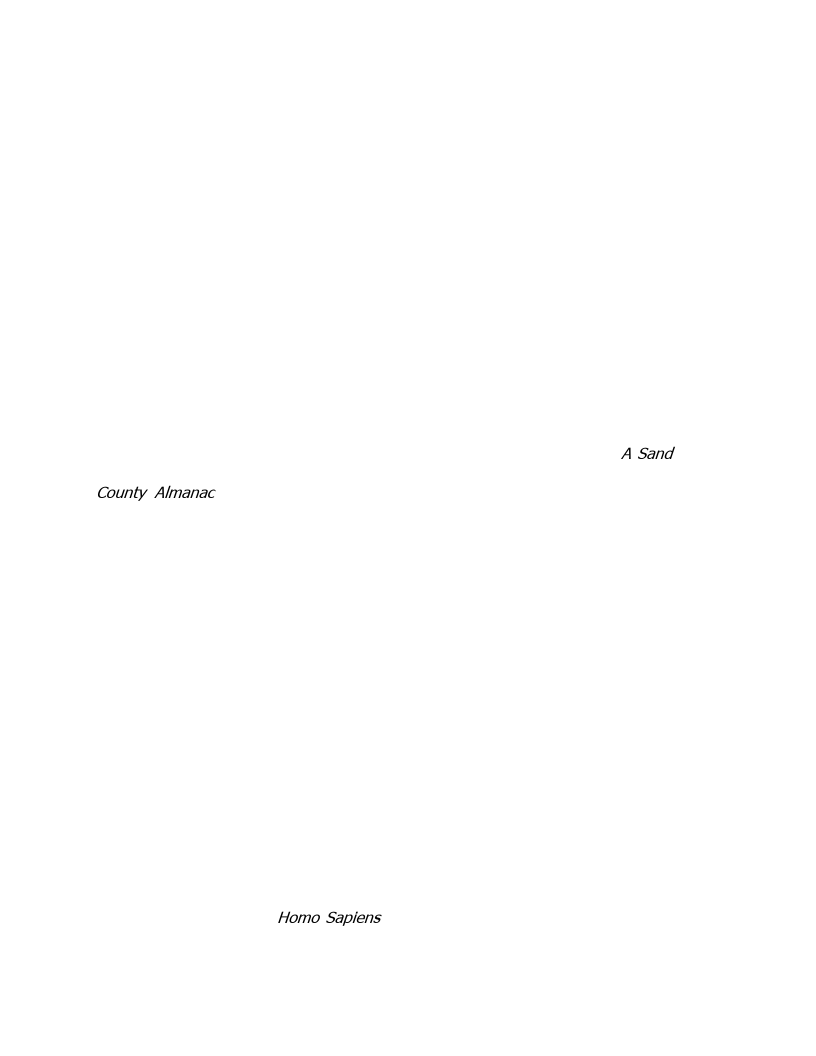
256
rest of the west still have not taken kindly to the presence of such predators. In
a region of ranch-based economy, any perceived threat to income-on-the-hoof is
dealt with quite harshly. The knowledge that coyotes feed much more on prairie
dogs or jack-rabbits than stock scarcely diminishes the ardor of a rancher‟s
pursuit. Any drive throughout the region reveals dozens of tell-tale tawny hides
skinned and hung from the barbed wire fencing as a coyote deterrent. How
ironic that the coyote is every bit as much a native here as trumpeter swan, or
humans for that matter.
Carrying capacity is defined as the maximum number of organisms that a
particular habitat can support over the long term. As Leopold noted in A Sand
County Almanac the first years of predator extermination often did result in
greatly elevated numbers of desired game species. However, increased habitat
destruction of over-populated game often ironically diminished the carrying
capacity of regional herbivores. In the days of Leopold's southwest, in the
longer run of ecological time the wolf proved less of a limiting factor to deer
population than the deer‟s overgrazing of wolf-bereft habitat. Predation culls the
weak and infirm, which helps keep the populations of grazers from overwhelming
the delicate high desert rangeland.11
That predator and prey represent a complex mutually dependent synergy
is no longer debated in wildlife management and ecology classrooms. Whether
we„ve taken Leopold's message to heart in social and economic practices remains
questionable. But then, Homo Sapiens often misses the complexity with which

257
various species within an ecosystem may be apparently contradictory in the
microcosm, but ultimately enhance one another in the macrocosm.
Like many individuals born into the predominantly Christian culture of rural North
America, I‟d learned to pray almost as soon as I learned to talk. I was raised to
believe that there was a white-bearded God out there who would listen to and
grant my heart-felt wishes if I followed proper prayerful protocol. Sadness could
be dispelled if only I entreated reverently enough for happiness. Conflicts would
disappear through pleas for peace. That unhappiness and struggle continued
post-prayer only indicated that I was lacking faith.
In my early twenties, even after my brush with Reverend Stoner, I was
still seeking a religion I could call home. Struggling to accept an evangelical
Christian faith, I was plagued with doubts. I still took comfort in the promise of
the Second Coming as a metaphor, trusting that if Jesus was immanent in each
living organism, that He would return to us here on earth when we all; people,
trees, bugs and crawdads, somehow could connect again. But the Pentecostal
Church of Dwight and Reverend Stoner had taught me that evil spirits dwelt in
the non-believers, and that redemption was available only to a few. Devotees
twisted centuries of biblical dogma into justification for human dominion over all
living things, including non-believing humans. I could not jibe this with my
lingering sense of the equal importance of all beings in the web of life.

258
My church friends urged me to work through my doubts. "Where are you
with the Lord today?" my best friend Michael would ask me each time he saw
me. My doubts were seen as a tear in the fabric of my faith; the sooner the rent
repaired the better. But I never stopped doubting beliefs which urged me to cut
myself off from the fundamental forces of ecological life. Eventually, even my
dearest friend turned his back on me. He and his wife feared that I was forever
lost to Satan and would prove a bad influence on them. I tried to turn my own
back on that difficult period of my life. "Don't dwell in sadness or pain", another
friend from that time told me, "because that is where the devil will find you."
But I continued to pray, shyly, quietly, not quite willing to let go the
vestiges of a belief system I could not entirely dispel or disprove. I prayed for a
return of my friendship, for the right woman to enter my existence, for a simple
answer to the mysteries of life. Nothing much ever came of my prayers as far as
I could tell. If I prayed for happiness one night, I still seemed to wake up sad
the next day. My incantations invoked no discernable interventions.
Then I was introduced to a Great Plains Native-American tribe's concept of
prayer. Rather than solely seeking personal gain or individual redemption, each
prayer was contextualized in the phrase "not for myself, but for my people".12
Not unlike the complex interactions among plant and animal communities, our
personal wishes knit a more intricate web of relationship, both interpersonally
and intra-personally. Praying for easy-going happiness might not always be the
best thing for land and community if anger, for instance, was needed to further

259
"my people." It occurred to me that there was a great deal of mutually
supportive complexity to the relationships between our various emotional states.
Conventional 'soul-range' management practices might indicate that
sadness, for example, would be a limiting factor to happiness. My Christian
friends saw doubt as a blood-thirsty scavenger lusting after my faith. Eliminate
doubt, or sadness or bitterness, or despair from our lives, and we intuit a higher
carrying capacity for faith (or happiness, or forgiveness, or hope). I learned the
hard way that denial of one feeling did not automatically lead to an increase in
another, just as Aldo Leopold learned that fewer wolves did not ultimately
translate to more deer.
Far from being a limiting factor, my ability to feel my sadness contributed
significantly to my ability to embrace happiness. During the times I was least
able to deal with what I considered destructive predatory emotions (anger, fear,
pain), it seemed my emotional range were stripped bare. The happiness I tried
to muster was a weakened species within an exhausted ecosystem. On the
larger scale though, the health of jack-rabbit depends on the health of coyote,
just as perhaps, happiness requires equilibrium with sadness. I'm not sure I‟d
want a life devoid of fear, doubt, or anguish any more than I would want a
mountain without its wolf or a desert its coyote.
Could it be that, just as the vitality of a particular biological community
rests on the health of each of its plants and animals, so too does our soul's
health depend on a balanced integration of all of our emotions? Eradicating any

260
particular element within the whole upsets system equilibrium. Perhaps each
individual depends for its health on the dynamic network of relationships within
its ecological or emotional context.
Balance, in Eastern Oregon as well as with my own psyche, is a dynamic
give and take between arrays of diverse organisms. Several days into this
Malheur sojourn, I felt far from balanced. As I drove to the marsh, I was not
thinking about the symbiosis between predator and prey. I was not thinking
about the balance between internal or external ecosystems. I was only thinking
about whether I could make it another mile without cracking wide open. My
throat was tight with sadness. Arms throbbed painfully from gripping the
steering wheel so firmly. I could not think. I dared not feel. I drove instead.
Suddenly, a grayish-tan body streaked across the road, barely clearing my
left bumper. I skidded to a stop. Twenty yards into the grass on the other side
of the road, a coyote looked back over its shoulder at me, seemingly
unconcerned with its close scrape. “Do coyotes feel grief?” I wondered, “What
would a coyote do if it were me?” Right there on the side of the highway, I took
my hands off the wheel, tilted my head back and let out a long, mournful howl.
I yipped and yowled and wailed till my breath ran out, then took another gulp of
air and continued to serenade the sadness. In one more breath I was reduced
to tears. In five minutes the tears ran dry, replaced by laughter. I rolled down
the windows and listened to the grass whispering in the late afternoon breeze.
As I started the car and pulled back onto the highway, I recognized that my

261
effort to hold myself together was ironically splitting me apart. Only if I gave
myself over to this land with the same native trust as the coyote to high desert
Oregon could healing begin to knit me back together.
My stations of my Malheur cross include lava beds just to the east of the
marshes, the monolithic Steens Mountain, the desiccated playas of Alvord
Desert, the quixotic hot spring arsenic pools at Borax Lake, and the remote
majesty of Hart Mountain Antelope Refuge. I visited them all, reveling in my
coyote senses. For me, it was a kind of resurrection, as I connected with
beloved places and observed the sacred movements of SE Oregon wildlife. It
was several days before I made it to the marshes.
Malheur heading towards day‟s end was a calming frenzy. The fading
light and muted colors painted the cliffs and grasses in placid pastel shades. The
temperature cooled and a mild breeze languidly played over my skin. Everything
inside me slowed to a still point, yet all around me was in wild motion.
Elongated cranes returned from a day of field feeding. A great blue heron
stabbed at the water, hunting fish moving towards insects moving towards the
skin of water moving in the evening wind. Songbirds bellied up to the bar and
belted out their last sun-drunk songs. Minx and muskrat moved across the road,
slipped into the water, and looked for their meals of meat and vegetables. And
at Benson Pond, as the cliffs to the west swallowed the first bite of sun, a pair of
brilliant white forms moved smoothly across the water, craning their long necks
at the sun, dipping them down into the water, lifting them again towards one

262
another. One, the larger, wore a green band around its neck. The smaller
slipped into a cove in the cattails. Green Band, looks first left, then right, then
directly at me, before turning and following his mate.
I could pretend that this sighting of Trumpeter Swan was an accident. I
could assume that I just happened to pass by as the two lazed about on an
evening swim. I could convince myself that the occasion bore no relation to the
events of the last few days. My entering the landscape as trusting partner could
not possibly influence the way another organism might behave towards me.
Coyotes, for instance, skittish around humans and as fond of bold mid-day light
as humans are of dentist drills, do not run across the road in the middle of the
day then turn to glance back at a pie-eyed driver. They wouldn‟t dream of
suggesting a human being howl from the very core of his being. Coyotes, after
all, only cross the paths of humans in order to eat their livestock.
Modern science teaches us to ignore what can not be proven. I could set
aside my experience and intuition and yet not be able to ignore the mounting
scientific evidence that reciprocal communication can and does occur between
different species. If we see ourselves as natural as coyotes, ravens, mosquitoes
or swans, we must then acknowledge our own creaturely wisdom
Upon returning from Benson Pond I drove the loops and twists of Rte. 205 some
twenty miles to Buena Vista Overlook, hoping to make sunset there. Arriving,
the cacophony of geese, songbirds, swifts and ducks was no less joyful at the

263
sun‟s setting than rising. „This is how life should be,” I mused, “as happy at any
ends as the beginnings.”
As the last sliver of sun was swallowed by the ridges to the west, I took
out a loaf of bread, peanut butter and jelly. I made two sandwiches then took
one over to a nearby outcrop which looks remarkably like a coyote squatting on
its haunches. I did not stay to see whether Coyote came to claim my offering – I
don‟t know that I would care to see him laboring with the gummy peanut butter.
I wouldn‟t want to know that pack rats or field mice had instead absconded with
the sacrament. It was enough just to make the offer and then depart.
Driving back through Malheur, I curved down-ridge to a place where the
road shoots straight across a nearly ten mile wide expanse of lake and marsh,
the road sometimes the narrowest sliver through the watery plain. A thin
cirrostratus gauze across the entire sky reflected extravagant washes of pink and
purple from the retreating sun. I rounded the last bend before the straight-away
and stopped the car dead in the middle of the road, completely disoriented by
what I encountered there. The still waters of Malheur Lake and its intermediary
marshes absolutely mirrored the colorful expanse of sky. I could still make out
the road ahead of me but twilight completely erased any delineation between
water and sky. It was as if I floated in a nebulous between-place, a liminal
ecotone. I was afraid to breathe, lest water fill my lungs. If I drove another
foot, I feared I too might disappear.

264
Much of our lives pass in such between places, though we seldom
appreciate the ambiguity. So used to the razor sharp delineations between our
beliefs, roles, duties and schedules – and one another, we fail to see the
reciprocal intermingling of that which we would normally hold apart. Each of us
is predator and prey. Our happiness, at some level, is inextricable from our
sadness. There‟s a seamless flow even between each of us, as well as with all
the other species which inhabit the planet with us.
We wage wars over divides of racial and religious territory and in pursuit
of distant material power. We put our money in tax shelters and SUVs, while
shaking our heads over the wretchedness of poverty. The mirror of Malheur and
sky counseled me to see beyond these apparent distinctions to places of
singularity. There‟s a Trumpeter in each of us, abiding in our clean still waters.
There‟s a Coyote which hungrily ranges the perimeters of our psyches. If we
wage war against others, we destroy ourselves. If we hoard possessions and
ignore relationships, we diminish not just us, but all other living thing around us.
In a moment of terrible grace these thoughts and emotions flooded me. I
could turn away from the infinite void where all things merge or I could embrace
it despite my fear, and enter. I climbed back into the car, and drove slowly into
the vastness of light, the grace of darkness, and the healing chaos I first sensed
in that liminal space, a refugee from religion finding refuge in religio.

265
CONTROLLED BURNS
Life's problems are too limited. That is a pity; the function of the artist is
to increase these problems, to cause upheavals in the brain, to make
people wild and free so there will be more drama in their lives.13
- Henry Miller
I act as every other artist will act, I make use of another new instant to
create more and more complications. Psychoanalysis, when grasped by
the artist, becomes another device by which to create chaos.14
- Anais Nin
Henry Miller and Anais Nin, writers, artists, lovers, provocateurs, shared a
paradoxical truth with one another and with society: problems, complications,
drama, chaos, personal disturbances, serve a necessary function to humanity,
through which the artist liberates imagination and desire in the lands of our
souls. Perhaps only by destroying old truths, conventions and social mores,
might new more resilient ones emerge.
Fire represents the quintessential trickster disturbance. When allowed to
work freely in fire-inured ecosystems, it devastates what it touches but also
restores vigor to local plant and animal communities by creating space for new
growth and releasing nutrients back into the soil. Perhaps soul, the soil of our

266
lives, also requires periodic disturbance to clear space for new thoughts,
emotions and relationships, and to break down the dense lignin within our fixed
attitudes and habitual patterns, releasing numinous atoms to be incorporated
into new ways of thinking, being and relating.
Modern ecosystem management practices in fire-prone lands suggest that
well planned and carefully executed prescribed burns can help maintain the
overall health of the land. We might take a page from the book of wilderness
management experts by thoughtfully conceiving of and executing periodic
prescribed disturbances in psyche and soma. Like Miller and Nin, we might see
ourselves as trickster artists, setting controlled burns and liberating chaos and
confusion to clear densely packed lives and transform impoverished souls.
Rising high for a rebound, I‟d come down hard on the firmly planted pivot foot of
an opponent. The torque and tumble irreparably tore two of the three
connecting ligaments in my right ankle. I spent six months hobbling around the
icy streets of Binghamton New York on crutches. Over the next half dozen years
or so – playing soccer, hiking a mountain, just crossing the street – I re-injured
my ankle at least ten times seriously enough to merit cane or crutches. An
orthopedic specialist advised that the only way I could address my issue was
through a complex surgery crafting and implanting artificial ligaments to hold my
ankle in place, gaining a permanent stability. New loss though, would be a
complete lack of mobility. At the time, I did not have language to articulate that

267
I was being asked to trade resilience for reliability, but I resisted the suggestion.
Though the severity of these disturbances was problematic, I was not willing to
risk losing my full range of normal flexibility.
In Seattle, I began to work with a specialist in mind-body connections.
Though the stated purpose was to address dynamics of familial suffering and
illness, Nan‟s approach was not unlike the Olympic restoration ecologist who
sought knowledge of a place‟s own healing process before undertaking her work.
Nan used an ancient Chinese acupressure massage technique called Jin Shin Do,
which focused attention on the energetic pathways running like meridians
through the body. Through light touch, pressure and expertly trained sensory
input, she could read the flow of energy moving or stagnating in my body.
Scanning me one afternoon early on in our treatment, she paused and
looked up quizzically when moving her hands over my right ankle. “How
strange,” she mused, “I can trace the flow all the way down your right leg, then
nothing comes out from the bottom of your foot.” She explained that normally,
energy flows in a counterclockwise cycle, moving like a river carrying and
cleansing along the way. Normal flow would leave the right foot and reenter the
left, continuing up those meridians on its way back to the vital heart. I explained
to her my basketball fall, my propensity for continued ankle injuries. Brows knit,
she asked “Can you tell me any stories about that ankle?” The question threw
me. I wanted hands-on healing, not touchy-feely story.

268
“I can feel your resistance” she offered, smiling. In a flash, an insight
came to me. As long as I could remember I‟d been an inveterate foot-tapper.
My habit was a source of familial banter; “Oh the jiggler‟s at it again. Stop
shaking the table!” I shared my recollection with Nan. “Can you tell me what
you were feeling when you jiggled?” I was stumped.
All week I pondered this mind-body question. Nothing came to me. In a
meeting a day or so before my next session with Nan, I listened distractedly as
my supervisor laid out a ridiculous project for us to undertake. Unconsciously,
legs crossed, tremors started vibrating my right foot. As she droned on, full-tilt
jiggling set in. I saw the leaves on the table plant moving before I noticed my
own shaking. “Aha!” I flashed, as memories of psychic frustration, anger and
anxiety flooded through me, linked now to my somatic action. The next day in
Nan‟s office, I blurted out my insight. “Can you find a different way to express
those emotions?” She continued, explaining her theory that the intense
energetic flow of my anger and anxiety was like a rough river wearing at the
fragile connections in my ankle. Predisposed to physical injury, I might be
further weakening that area with the bombardment of unexpressed emotions.
Her explanation frustrated me, less because of her acuity than my realization of
the potential for conflict that sharing such things out loud might generate. She
listened, reflecting. “Don‟t assume that the direct path is the only path.” she
advised, “Think about how else you might move and express that energy.”

269
Over subsequent weeks, my homework assignment was to note the onset
of foot tremors, stop and name the cause, then craft strategies for alternative
responses. As a kid, I‟d often worked out my aggressions through various
games of rock baseball. My favorite involved pitching balls or strikes against a
telephone pole at the base of our driveway. Several times a week, I‟d go out to
a relatively uninhabited Seattle park with a ready supply of small stones, pitching
out my frustration and anxiety. Before long, I found that I could pick up on my
emotional tremors well before they manifested in my ankle. Sometimes I could
avert the display – leaving the room, steering the conversation in another
direction – sometimes I could not. Those times, I‟d swallow hard and express
my feelings out loud. Surprisingly, the world didn‟t fall apart. As I grew more
facile with navigating the dynamics of internal-external conflict, I noticed that
months, then years had passed without an ankle injury. Fifteen years later, I‟ve
not had a single occasion to drag crutches or cane from the closet.
If religio is a re-ligamenting of connection between people, place and
each other, then my work with Nan became a literal healing of my ankle
ligaments. Noting and sharing anger, frustration and anxiety outwardly were
akin to controlled burns; I did not allow the fuel load of unexpressed emotions to
build to blowout stage. It‟s not that I didn‟t feel awkward. But these were
reasonable low-level disturbances, allowed to burn naturally. Undertaking this
work with Nan, I‟d happened on a practice for managing my own wild lands.

270
To transform habitat, I probed, interpreted and altered habit. Wild
ecosystems like the Pajarito and the Sandhills masterfully provide their services
with rich efficiency. Intact landscapes contain all the elements they need to
function. Were my daily choices and actions detracting from or adding to the
health and vitality of my wild life? Did I possess a biodiversity of interior species
sufficient to inhabit the roles required of a self-sustaining ecology? As
provocative and illuminating my exploration of mindful restoration of my soul‟s
sanctuary was proving to be, I began to wonder whether mind alone was
enough to restore the heart to its state of wild sanctuary.
In their lobbying efforts, wildlife advocates often cite the necessity of extensive
spatial requirements. Grizzly bears need significant land to roam in and wildlife
corridors between suitable habitats to ensure their survival. Perhaps the 90-95%
of our brain that recedes from consciousness at any given moment encompasses
a protected area of the imagination that ensures the survival of all our species of
thought, emotion and belief. Are we willing to ferociously fight for the wild
within us as well as around us? But more tellingly, are we willing to let our inner
forests burn, stand by in patience while mountains within shatter and shake?
An underlying axiom to Chaos Theory holds that implicit order underlies
the apparent disorder. I don‟t know that I agree. In the search for Gregory
Bateson‟s “patterns that connect,” might we be missing the import of “patterns
that disrupt?” In Thomas Moore's Soul Mates explorations of the paradox of

271
relationships, there is the suggestions that strong emotional states like anger or
grief can be similar to the processes by which precious metals are refined.15 As
bronze or steel or silver becomes annealed by chemical and physical applications
of heat or pressure, perhaps our vivid emotional states bring about alchemical
and metaphysical transformations of interior raw materials. Such tempering
conjures a different way of looking at the ways thoughts, actions, moods,
sensations and emotional states interact within us, not unlike the process of
chemical redefinition in fire-inured soils in Southwest and Midwest landscapes.
As steel or iron bend in fierce heat, repeated dousing with cool waters
bring about tensile strengthening. Perhaps the blanketing darkness of
depression, the cool detachment of apathy, or the flowing wet of sadness might
be part of the soul's tempering. Our instinct around personal fire is to put it out
immediately. But I now approach fire as a Neanderthal might have, and as an
ecologist has learned to. The Neanderthal knew our survival depended on fire
and remained in awe of it for that reason. The ecologist remembers the lessons
learned from Cascade, California, Los Alamos, and Yellowstone fire.
There‟s a region in Australia of healthy stands of eucalyptus, teeming with
wildlife that has disappeared from other nearby, though ecologically and
climatically similar areas. Scientists, studying the vitality of the place, realized
that local aboriginal peoples have been torching the grasslands each spring for
over 500 years. It's an incongruous story of health; fires keep down the tough,
woody (and less digestible) grasses and sedges, making way for a greater

272
diversity of succulent plants. These provide forage for organisms that have
learned to evade or cope with the controlled burns. But shouldn't the fire
destroy the eucalyptus? Indeed, flames severely damage the boles of the trees.
Over the years, great hollows burn nearly to the heart of each tree. But nature
provides compelling compensation; these spaces make perfect dens for
organisms whose accumulated excrement and food refuse make nutritious
fertilizer upon which the eucalyptus thrives.16
Whether in the savannas of Australia or Africa, the plateaus of New
Mexico, the foothills of the Cascades, or the grasslands of the Midwest – fire
destroys but also nurtures in unexpected ways. This seems true of internal
landscapes as well; tough woody ideas, indigestible belief patterns, craggy
overgrown habits and friendships need a good burning from time to time. One
might go overboard with these fires, setting indiscriminant proscribed burns, but
no landscape can stay healthy when constantly aflame. However, as we've
gradually learned in prairie and forest management, too few fires prove as
deleterious to the health of the system as too many. Nature's fires tend to
happen spontaneously; human ones may need to be planned. Both ways may
ultimately be necessary. Fire is one of nature's primary means of releasing the
potential of landscape by shifting and redirecting form, matter, and nutrients.
If I burn, it‟s with this in mind; that the blaze is energy which needs to be
moved, matter which needs to evolve new form. The equilibrium of both inner
and outer ecosystems requires a continual dynamism. What seems to be new

273
within me grows out of a natural transformation of that which I perceive as old.
In this I am prairie; my thirsty roots plow the rich, raw humus of my
consciousness and experience – there‟s not a thing which does not feed me.
Like a prairie swept by fire, conflagrations of loss, grief, and death devastate me.
But that fire also regenerates me.
Moore's sees human existence as a series of encounters filled with
contradictory emotions, responses and actions. Rather than fixing the paradox
by eradicating what doesn't fit, Moore encourages us to embrace the
contradictions and allow that tension to come into awareness. Inevitably, Moore
says, a new way through the tangle emerges.17 When I allow contradictions to
rest in suspension within me, a different way of being does emerge, though the
path may not be altogether clear. Sometimes in the process of re-ligamenting
connection, literally also re-membering, we must learn the art of forgetting and
work at not knowing. At times, to find the light of truth perhaps we must be
willing to enter the darkness of confusion.

274
ENDARKENMENT
As I walked home from a movie on a sunny day a couple of years ago February,
I thought about the renowned groundhog Punxsatawney Phil and the quirky
ritual of winter prognostication that has risen around him. They say sight of his
shadow will scare him into hiding and compel six more weeks of winter. It's
more likely that a self-respecting woodchuck would catch sight of the sun and
begin fantasizing over early peas or broccoli starts. One would think that a
creature that lives underground much of its life should be pretty used to shadow.
Perhaps we believe Phil will be afraid of his shadow because we live in
fear of that darkness ourselves. "Beware the shadow side", we are cautioned.
But what is a shadow, really, but evidence of substance shown by the cast of
light. Our substantive lives are often shadowed by circumstance. A sibling might
die, a parent fall gravely ill, spent love and lost wishes pass through your life like
eternal darkness. But there is always significant substance contained within the
shadow rich like good humus, readily available for our growth.
I crafted a ritual to intentionally immerse myself in the realm of not
knowing. If enlightenment embodies the pursuit of the knowledge of absolute
truth, then endarkenment epitomizes the liberation gained from knowing that
many things remain ultimately unknowable. I hiked to the crest of one of the
highest local hills to watch the sunset. My intention was to see that fading sun
as the setting of this most recent stage of my life. The sunset was a brushstroke

275
of orange and magenta, spectacular enough to almost make me forget the
symbolism of my act. Jagged rays of light pirouetted against thin veils of clouds.
Robust wind conspired to keep any annoying mosquitoes at bay. I was free to
revel in the wonder of it all.
As twilight settled into murky gloom, I started back down the trail towards
town a couple miles away. I walked back home through the pitch-black woods,
symbolically an entry into my own darkness. But this was not the darkness of
shadow selves and all its attendant allusions, but of a place where there was no
truth, no past, no future, nothing that can be known for sure, a liberating
darkness that frees anything to happen, or nothing. Clodhopping back down the
trail in near-night, 20 feet from a strange silhouette, I heard a jagged "hrufff" as
a white-tail deer high-tailed it to the edge of the woods. It paused, looking back
bemusedly as if to say "you could have caught me if you were paying attention."
At a place where the white pines thicken, light failed. I hesitated at an ink-black
tunnel, fearful. But there was no other way home, and so I entered the dark.
I‟d once encountered a passage in Jim Corbett's Goatwalking where he'd
suggested that time alone in the desert night was a surefire way to invite our
demons to the campfire.18 For part two of the ritual, I decided to travel to the
desert of my imagination, light a fire, and greet my demons. Once home, I
propped a large mirror against a kitchen chair and plunged the room into
darkness, lit candles in the four compass directions, placed some sacred found

276
objects around me, and sat before the mirror. Next to me was a bottle of tequila
from the high desert southwest, a place and substance for me of great truth-
telling. I poured the first shot, looked myself in the mirrored eye and said
"Here's to you and all your demons!" Alternating journal writing with dead-
honest assessment of myself, my choices, my habits, I toasted my underlying
dark truths. In such places, anything could happen. As the night stretched near
to infinity, I created a space of not knowing in which I felt that anything or
nothing could happen. For the darkness, for all we can tell, could be filled or
empty – the choice is ours. I chose full, even as I experienced emptiness.
Darkness gets a bad rap. “Forces of darkness” seek to enslave humanity,
certain religious fanatics warn us. “The dark lord rules all” blasts a heavy-metal
band, or a Satanic cult, I can‟t remember which. Pasty-skin, puckish psycho-
babble artists try to tell us about the importance of getting in touch with our
“shadow sides.” The cure for all these ills, some would tell us, is enlightenment,
the awareness that brings us face-to-face with sacred knowing of great and
profound truths. “The truth shall set us free!” cries the prophet.
But what do we make of the sacred un-knowing of the great un-truths?
During my ritual, I‟d deliberately entered a sanctuary where darkness obscured
knowing anything for sure; where the concept of truth proved meaningless
against the things that could never be known. Christian mystic St. John of the
Cross, author of the medieval text Dark Night of the Soul, explored entry into the
unknown as a different way of knowing.19 Our modern take on such exploration

277
views our own dark nights of the soul as passage through painful and anguished
struggles for understanding. What if we conceived of darkness not as an
agonizing skirmish with the embittered-mistress madness, but a playful
encounter with our demons and mysteries that require no firm understanding,
bursting full of wild fun under the cover of the deep, good night?
Some time ago, a friend gave me a thought-provoking quote that he
attributed to turn-of-the-century Russian artist Vladimer Malevich, "No man can
be truly free until he is willing to disbelieve today what they believed yesterday."
This is a challenging and intriguing statement, intoxicating though demanding.
Through endarkenment, I experiment with a willing suspension of belief,
understanding, knowledge and truth, the better to enter those mysterious realms
where such things cannot gather in the conscious mind alone, but must be
sensed deeply and reverently in the skin's paradise and the body's deep.
The wisdom of darkness... We spend half our lives in darkness. We fear
it for the absence of light and for what we fell might trap us there, grow
uncomfortable with not penetrating its secrets, not realizing the liberation that
not knowing can provide. When speaking of enlightenment, we may refer to a
refined knowledge of our selves and a deeper understanding of the universe
around us. But I wonder if we overrate such knowledge. Endarkenment allows
for that which can not be known by mind alone. Darkness makes room for the
possibility of any truth, or no truth at all. In this practice of paradox, if

278
enlightenment is the pursuit of the knowledge of truth, then endarkenment
signifies relaxation into places of not knowing. Our confusion may also be a gift.
A friend wrote me awhile ago "I am in a state of blissful/painful
confusion." What a marvelously complex statement; the bliss and pain of
confusion. As with darkness, I believe confusion has also gotten a bad rap. I
traced the word back to its roots, the Latin fundere; to pour, cast or mold.20
When something becomes fused, disparate elements transubstantiate into a
liquid state promoting facile combination. Confusion can be seen as a kind of
alchemy, a subliminal shifting and co-mingling of essences with another (where
the „other‟ may be land, human, non-human, or aspects of self). There are times
for distinction and separation, but also episodes of inextricable and absolute
merging. Confusion has now come to reflect a state of "fusing with," or merging
with otherness so that the boundaries inevitably get a bit fuzzy. Maybe to be a
part of rather than apart from life will always involve some confusion, as we
intermingle deeply with the settings, situations and individuals around us.
As I explored an endarkened state of not knowing, I began to view the
numbness I felt after my sister‟s deaths a bit differently. Perhaps my emotional
paralysis was less a state of disturbed dysfunction than some sort of alchemical
purgatory, another word which has been given a pejorative slant. The primary
definition rises straight out of Catholic doctrine: a between place where souls of
those who‟ve died must atone for their sins. Even the secondary definition takes
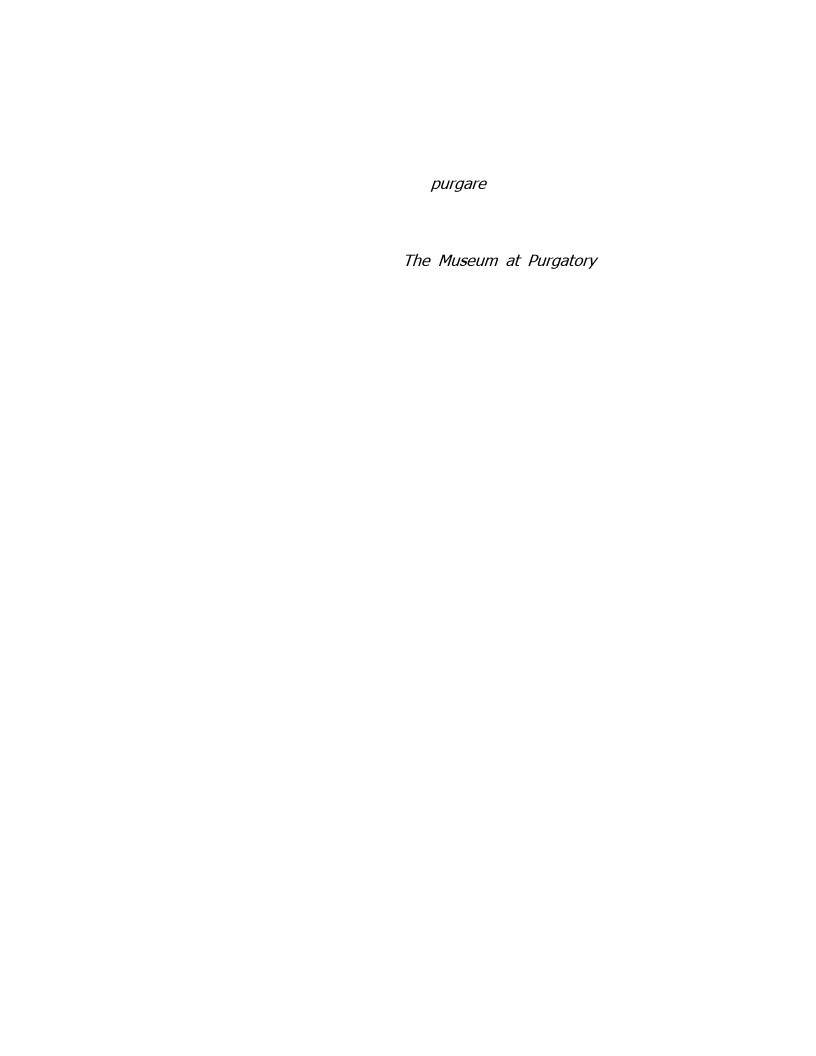
279
a strong lean toward Christian guilt tripping: a place or state of temporary
suffering or punishment. But down in the roots, there is a more nuanced
interpretation. Evolving from the Latin purgare it refers to any place serving to
purge, cleanse, purify or expiate (itself a lovely word of making amends).21
Artist/author Nick Bantock‟s The Museum at Purgatory transformed my
view of that liminal space. His story follows „Non‟ the museum‟s new curator and
his encounters with the souls who pause in Purgatory on their passage to various
dystopias and utopias. What Bantock reveals through these characters is the
twinning of our usually dualistic natures (good/bad, happy/sad, playful/somber).
His purgatory is a restful place of reintegration and, quite often, redemption.22
And so I begin to see my own version of purgatory in a different light, as a way-
station to weave together parts of me divided against one another and restore
equilibrium and equanimity. Here I rest at a still point, ready to enact my future
with these seeming opposites entwined and inseparable in all that I do. But
even amid the grace of not knowing, there remains yet a necessity of conscious
intention in discerning paradox. I close this chapter with one last practice of
paradox, a restoration of consciousness.
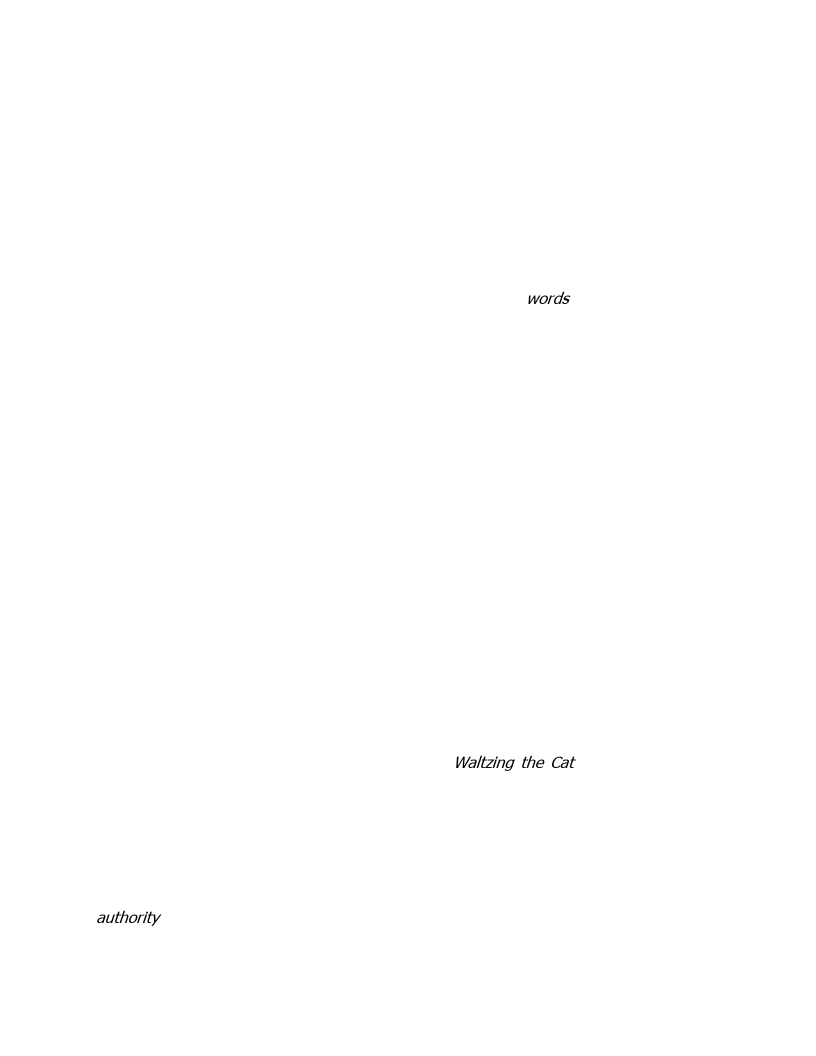
280
RE-STORY-ATION
Benediction means literally “good or beneficial words.” Throughout this chapter,
I‟ve undertaken a piecemeal etymological restoration of language and meaning.
Biblical scripture proposes “By their works ye shall know them.”23 I‟m beginning
to wonder if an equally revelatory maxim might be “By our words ye shall know
us.” If words themselves lose their nuances and threaded meanings, then how
do we begin to re-story our lands and ourselves reflecting the kind of bio-
diversity we wish for both? Stripped of the evolutionary layers that encompass
each word‟s textured meaning, then our stories and dialog lose something
intangible yet vital that crafts the connective tissue of our social fabric
Indeed, the stories we tell ourselves and one another seem to profoundly
inform our beliefs, imaginations and responses to our deeper selves and to one
another. Re-storying, I think perhaps, emphasizes not just one kind of story
over another but a richly textured tapestry of all narratives that honors the
complexity of our emotional, philosophical, and spiritual terrain, recognizing the
soul-ecology function of each strand of story within us.
A main character in Pam Houston‟s novel Waltzing the Cat tells a friend
that she had four stories she would tell a man when she wanted him to fall for
her.24 This passage has led me to reflect on what defining stories I tell when I
really want someone to know me. In this, I reflect upon what it meant to hold
authority in my life, about how I shape my stories to define my own character (a

281
multiple-meaning word that stands for the moral qualities or habits of a person
as well as a role in a play or movie). Deliberate attention to endarkenment and
confusion within my personal purgatory brought almost overwhelming ambiguity.
Evolved from the Latin ambigere, to wander, which in turn was built from the
roots ambi- , around, + agere, drive, literally ambiguous means „to wander
around with drive or purpose.‟25 This is an important distinction from common
meaning of the word (uncertain, doubtful).
I suspect that what we call our persona operates more along the lines of
landscape ecology than the narrow confines of most psychological or religious
orientations; meaning it contains a richly textured diversity, where contradictions
that abound on one level reveal themselves as complementary on another. My
journey through different places of paradox was a simultaneous outer and inner
excursion; one which served more to raise provocative questions than to
generate reasonable answers. To provide a way of glimpsing discernable
patterns amid the inherent chaos, I once again looked outward to see within.
From my sit spot near the Woodland cemetery marsh in Keene one May
morning last year, as I listened to the exuberant chorus of songbirds and
followed their technicolor flights, I mused about how many baseball teams had
chosen small birds as mascots. Unlike their higher-on-the-food chain football
brethren (Lions, Eagles, Ravens, Bulldogs), baseball aficionados and owners
seem willing to celebrate the less testosterone driven qualities of avian
commoners (Blue Jays, Cardinals, Redwings). Oddly, though a big fan of both

282
birds and baseball, I couldn't remember the last time I'd seen an Oriole,
Baltimore or otherwise. I strained my memory to recall plumage, size, gait or
song. As I gathered my journal and empty coffee cup to head to work, I made a
mental note to check my Peterson‟s bird guide that evening.
Late that afternoon as I strolled home from work, I heard a commotion in
the branches to my right and saw an aggressive jay chase a smaller bird from its
territory. The chastened interloper landed on a branch nearby where I could get
a good look at it. Indeed – oriole. Sighting it that late in May, I recognize that
bird had been in the area all spring. I believe I hadn't seen it because my brain
had lost its mental map to the interior habitat of oriole. Having made an oriole-
shaped space in my consciousness that morning, it was only natural that I would
see a creature that had existed there all along. How many other things had I
failed to see in the world around me because my conscious mind had not made
room for them to enter? Might making space in my thoughts and perspectives
also liberate and renew my vision and experience?
The New-Age statement “I create my own reality” has always seemed to me a
paragon of arrogance. I could no more make that oriole appear than I could
change the results of the last election by thinking on it. But I do believe we
possess some control over crafting the various lenses through which we view
reality. In The Botany of Desire, Michael Pollen tells of his effort to understand
the effect on short-term memory loss of marijuana, a plant he claims has

283
cultivated human desire for intoxication. He meets with a renowned brain
scientist. Asking how pot limits the brain‟s ability to recall, Pollen‟s taken aback
when the researcher tells him that the work of the brain is forgetting not
remembering. Without our mind‟s ability to selectively sift through the flood of
sensory data to winnow out what‟s worth paying attention to we would be in a
constant state of overwhelmedness bordering on insanity.26
What should we pay attention to? Certainly we come well equipped both
physiologically and psychologically to cull data pertinent to satisfaction of our
hierarchy of needs including shelter, food, and safety. If a person habitually
focuses on death, despair or destruction, there‟s no lack of external
manifestations of these to fill the mind many times over. Most of us know such
horror mongers; thumbing through the newspaper for police reports and
obituaries, flicking through the cable channels for Cops shows and Fox news
bites. But then again, we can tune into other sensory channels broadcasting
very different stories of hopefulness, resilience and rejuvenation, however poorly
such topics may fare in our culture‟s Nielson ratings.
But it‟s not just what we notice that makes a difference in shaping the
spaces in our consciousness, but also the frame we place around what we do
notice. Some of my friends saw in my Guillan-Barre episode a debilitating illness
and viewed me with pity and sadness. I found in that experience my body‟s
capabilities for adaptive resilience. For much of the 20th Century, land use
managers, politicians, and much of the general public witnessed a plume of

284
smoke on the horizon of a nearby forest and saw wildlands fire as an
abomination to be eradicated. Nowadays, increasing numbers of individuals in
public space management positions and political office see fire as a rejuvenating
force, one that can serve a revitalizing role if properly contextualized.
Restoration ecologists in urban areas like Seattle struggle to see through
time for the proper reference ecosystem that would become the target for their
efforts, but there‟s no ringing consensus on the species that constitute a restored
watershed. Lumber companies and wilderness advocates see very different
things when they look at a Doug Fir or a Spotted Owl, just as in the prairie
Midwest there‟s more than one orientation on an unplowed plot of land. There
may be something in the human brain that seeks the simplest view and
explanation for any phenomenon it takes in.
Polarization and dichotomy yield a simple lens of binary representation of
experience. A practice of paradox creates a multi-faceted lens on reality, like a
grasshopper‟s compound eye. It cultivates wisdom to navigate increasingly
complex ecological issues. If the root of religion can be a re-ligamenting of our
culture and connection to nature, I now believe that practices of place-based
paradox can create space in our consciousness to hold contradictions in creative
tension and foster multi-threaded connections in our most polarizing domains.
Red state, blue state; it was all I saws in the news after the 2004 Presidential
elections. Waking the morning after, I sought a “third” state. At a workplace

285
where liberalism is the accepted political norm and where folks are not shy about
proclaiming their beliefs and assuming you feel the same, I figured it would be
an uncomfortable place for our resident Republicans. Sensitive to patterns that
don‟t quite fit, I‟d identified those few whom I knew would have voted for
George W. Bush. Arriving at work, I made my way around to each one. Each
conversation opened with my congratulations, my acknowledgment that our
environment was probably not all that supportive of their choice today, and my
assertion that I saw their integrity and thoughtfulness even though I had made a
different choice, one which I was not particularly excited about.
To my surprise, each conversation took an unexpected turn from there.
In acknowledging their authority as well as my ambivalence about Kerry, my
colleagues shared their own ambivalence about Bush. As we began sharing
what it was we wished for in a president and in our country, we found that we
had virtually the same set of concerns and dreams. If I‟d stayed in the polarity
of my own blue state (pun intended) I‟d never have connected to the
fundamental commonality between us.
This object lesson in facing personal and political contradictions highlights
a number of the practices of paradox I‟d learned from my place-based
explorations. With perceptions tuned to noticing patterns that don‟t fit the norm
and an epistemological basis for holding the potential contradictions in
suspension, I identified individuals with whom I might create a third space of
understanding and found a more flexible way of connecting with differences.

286
Operating out of that place of bio-diverse understanding, we formed more
flexible bonds with each other, which endure to this day.
Other practices though, shaped my ability to even reach across that
political divide. The prairies lessons of softening my own attitudinal
fundamentalism combined with the Pajarito‟s teaching on uncertainty became a
practice of endarkenment; acknowledging that I may not have all the answers,
nor do I always need to know for certain that any given choice, idea, or belief is
the right one. When I opened my email that morning after the election and read
the diatribes about Bush and all those who voted for him, I remembered the
words of that Cascadia Quest participant. Who was I to call Republicans the
invasives on my societal terrain? Perhaps there was something in the pattern of
their political thought that could play a vital role in my own thinking.
Shifting our attitudes, beliefs and ideology in these ways is a matter of
creating paradox-shaped space in our consciousness. A foundational shape in
my own consciousness underlying all the other practices that have emerged in
this work holds that our losses, debacles and setbacks operate like ecological fire
to create space and breaks down matter into forms more readily available for
new growth. Paradox, in place and self, has taught me to enter what I fear,
disdain or simply don‟t know or understand, believing that thriving as an
individual and perhaps surviving as a species demands such connective flexibility.

287
PRACTICES OF PARADOX ENDNOTES
1 The Holy Bible (King James Version), (Cleveland, OH: The World Publishing Company).
Matthew 7:7
2 Still Crosby, Nash, Cathedral, Song, Atlantic/Wea, 1977.
3 John Muir, My First Summer in the Sierra (San Francisco: Sierra Club Books, 1988) 110.
4 The New Century Dictionary of the English Language 1515.
5 Ibid. 952.
6 Creighton University maintains a concise introduction to the fourteen stations: "The Stations of
the Cross," Creighton University, 18 Jan. 2007,
<http://www.creighton.edu/CollaborativeMinistry/stations.html>.
7 Pema Chodron, When Things Fall Apart: Heart Advise for Difficult Times (Boston: Shambhala,
1997) 8.
8 The New Century Dictionary of the English Language 1504.
9 "Malheur National Wildlife Refuge: Birding Opportunities," United States Fish and Wildlife
Service, 24 Jan. 2007, <http://www.fws.gov/malheur/birdopps.htm>.
10 "Fauna of the National Parks of the United States: Problems of Historical Origin: Treatment of
Species Reduced to Danger Point," National Park Service, 2 Feb. 07,
<http://www.nps.gov/history/history/online_books/fauna1/fauna3-2.htm>.
11 Leopold, A Sand County Almanac 129-33.
12 John G. Neihardt, Black Elk Speaks: Being the Life Story of a Holy Man of the Ogalala Sioux
(New York: Pocket Books, 1959) 210.
13 Anais Nin, A Literate Passion: Letters of Anais Nin and Henry Miller 1932-1953 (New York City:
Harvest Books, 1989).
14 Ibid.
15 Thomas Moore, Soul Mates: Honoring the Mysteries of Love and Relationship (New York City:
Harper Collins, 1994) xiv-xix, 55-60.
16 Pyne devoted a whole book to the fire ecology of Australia: Stephen J. Pyne, Burning Bush: A
Fire History of Australia (Seattle, WA: University of Washington Press, 1998).
17 Thomas Moore, Care of the Soul: A Guide for Cultivating Depth and Sacredness in Everyday
Life (New York City: Harper Collins, 1992) particularly 137-76.
18 Corbett, Goatwalking: A Guide to Wildlands Living, a Quest for a Peaceable Kingdom 1-48.
The first three chapters in particular lay out the philosophical lessons and implications of
wandering the Sonoran desert as a solitary wildlands goatherd.

288
19 Kieran Kavanaugh, and Otilio Rodriguez, "The Collected Woks of St. John of the Cross,"
(Washington D.C.: ICS Publications, 1991).
20 The New Century Dictionary of the English Language 305.
21 Ibid. 1421.
22 Nick Bantock, The Museum at Purgatory (New York City: Harper Collins, 1999).
23 The Holy Bible (King James Version). Romans 3:24
24 Pam Houston, Waltzing the Cat (New York City: Washington Square Press, 1998) 256.
25 The New Century Dictionary of the English Language 37.
26 Pollan, The Botany of Desire: A Plant's Eye View of the World 159-62.

289
WORKS CITED
"Ada Hayden". Iowa State University. 17 Sept. 2006.
<http://www.public.iastate.edu/~herbarium/adapage.html>.
"African American Odyssey: Reconstruction and Its Aftermath". Library of Congress. 12 Oct.
2006. <http://memory.loc.gov/ammem/aaohtml/exhibit/aopart5.html>.
Allen, Craig D., ed. Fire Effects in Southwestern Forests: Proceedings of the Second La Mesa Fire
Symposium. Fort Collins, CO: USDA Forest Service, 1994.
Andrus, Richard. "Ecological Principles and Agricultural Practices." Binghamton, NY: State
University of New York at Binghamton, 1979.
Armstrong, Karen. The Battle for God: A History of Fundamentalism. New York City: Random
House, 2000.
Arno, Stephen F., and Steven Allison-Bunnell. Flames in Our Forest: Disaster or Renewal?
Washington, D.C.: Island Press, 2002.
Ausubel, Kenny. Restoring the Earth: Visionary Solutions from the Bioneers. Tiburon, CA: H.J.
Kramer, 1997.
Bandelier, Adolf F. The Delight Makers: A Novel of Prehistoric Pueblo Indians. New York City:
Harcourt Brace Jovanovich, 1971.
Bandelier National Monument. Tucson, AZ: Southwest Parks and Monumnets Association, 1990.
Bantock, Nick. The Museum at Purgatory. New York City: Harper Collins, 1999.
Basso, Steven Feld and Keith H., ed. Senses of Place. Santa Fe, NM: Schoool of American
Research Press, 1996.
Bateson, Gregory. Mind and Nature: A Necessary Unit. New York City: Bantom Books, 1979.
Beimler, Rosalind Rosoff, with photos by John Greenleigh. The Days of the Dead. San Francisco:
Collins Publishers, 1991.
Bellah, Robert N., et. al., ed. Habits of the Heart: Individualism and Commitment in American
Life. New York City: Harper and Row, 1985.
"Belltown P-Patch". Seattle, WA. Friends of Belltown P-Patch. 14 Dec. 2006.
<http://www.speakeasy.org/~mykejw/ppatch//whatis.html>.
Belltown P-Patch Planning Meeting Notes. Seattle, WA: Friends of Belltown P-Patch, 1995.
Berger, John J., ed. Restoring the Earth: How Americans Are Working to Renew Our Damaged
Environment. New York City: Alfred A. Knopf, 1985.
Berry, Wendell. Home Economics. San Francisco: North Point Press, 1987.
---. The Unsettling of America: Culture and Agriculture. New York City: Avon Books, 1977.
Biswell, Harold H. Prescribed Burning in California Wildlands Vegetation Management. Berkeley,
CA: University of California Press, 1989.
"Blowout Penstemon (Penstemon Haydenii) S. Watson Recovery Plan". United States Fish and
Wildlife Service. 7 Oct. 2006.
<http://ecos.fws.gov/docs/recovery_plans/1992/920717.pdf>.
"Brain Basics: Know Your Brain". National Institute of Neurological Disorders and Stroke. 15 Oct.
2006. <http://www.ninds.nih.gov/disorders/brain_basics/know_your_brain.htm>.
Brian Walker, C. S. Holling, Stephen R. Carpenter, and Ann Kinzig. "Ecology and Society:
Resilience, Adaptability and Transformability in Social–Ecological Systems". 2004.
Ecology and Society: A Journal of Integrative Science for Resilience and Sustainability. 30
Sept. 2006. <http://www.ecologyandsociety.org/vol9/iss2/art5/main.html#Resilience>.
Brown, Kenneth A. Four Corners: History, Land and People of the Desert Southwest. New York
City: HarperCollins, 1995.

290
Bryant, Donn Walter and Amy. "Mima Mounds of Thurston County: A Study of
Evapotranspiration, Geologic History & Myths ". The Evergreen State College. 18 Dec.
2006. <http://192.211.16.13/curricular/ENVANA/Mima%20Mounds/HOME.HTM>.
Bullock, Alice. Mountain Villages. Santa Fe, NM: Sunstone Press, 1973.
Burns, Patrick, ed. In the Shadows of Los Alamos: Selected Writings of Edith Warner.
Albuquerque, NM: University of New Mexico Press, 2002.
Cascadia Quest Board of Directors Documents. Seattle, WA: Cascadia Quest, 1995.
Cash, Johnny. Ring of Fire. Song. SONY, 1963.
Cather, Willa. My Antonia. Boston: Houghton Mifflin, 1995.
"Center for Plant Conservation National Collection Plant Profile: Penstemon Haydenii". Center for
Plant Conservation. 7 Oct. 2006.
<http://www.centerforplantconservation.org/ASP/CPC_ViewProfile.asp?CPCNum=3241>.
Chodron, Pema. When Things Fall Apart: Heart Advise for Difficult Times. Boston: Shambhala,
1997.
"Christian Denominations in the U.S." Ontario Consultants on Religious Tolerance. 14 Oct. 2006.
<http://www.religioustolerance.org/us_rel2.htm>.
Church, Peggy Pond. The House at Otowi Bridge: The Story of Edith Warner and Los Alamos.
Albuquerque, NM: University of New Mexico Press, 1960.
Cohen, Michael J. Reconnecting with Nature: A Restoration of the Missing Link in Western
Thinking. Project Natureconnect. Friday Harbor, WA: Project NatureConnect, University
of Global Education, 1995.
---. "Thinking and Feeling Disorders Reduced by the Corrective Flow of Natural Systems
Ecotherapy". Institute of Global Connection. 20 Nov. 2006.
<http://www.ecopsych.com/wholeness66.html>.
---. The Web of Life Imperative: Regenerative Ecopsychology Techniques That Help People Think
in Balance with Natural Systems. Friday Harbor, WA: Institute of Global Education and
Trafford Publications, 2003.
Cone, Joseph. A Common Fate: Endangered Salmon and the People of the Pacific Northwest.
New York City: Henry Holt and Co., 1995.
Corbett, Jim. Goatwalking: A Guide to Wildlands Living, a Quest for a Peaceable Kingdom. New
York City: Viking, 1991.
Costello, David. The Prairie World. Minneapolis, MN: University of Minnesota Press, 1969.
Crescent Lake National Wildlife Visitor Information. United States Fish and Wildlife Service, 2005.
Crosby, Still, Nash. Cathedral. Song. Atlantic/Wea, 1977.
Domrzalski, Dennis. "94,000 Acres of Paradise: Touring the Baca." Albuquerque Weekly Alibi
12/10/98.
Dunmire, William W., and Gail D. Tierney. Wild Plants of the Pueblo Province: Exploring Ancient
and Enduring Uses. Santa Fe NM: Museum of New Mexico Press, 1995.
Ehrlich, Gretel. The Solace of Open Spaces. New York City: Penguin, 1986.
Elias, Scott A. The Ice-Age History of Southwestern National Parks. Washington D.C.:
Smithsonian Institution Press, 1997.
Family, The Carter. Fifty Miles of Elbow Room. Song. Rhapsody, 1941.
Faulkner, Edward H. Plowman's Folly. Norman, OK: University of Oklahoma Press, 1943.
"Fauna of the National Parks of the United States: Problems of Historical Origin: Treatment of
Species Reduced to Danger Point". National Park Service. 2 Feb. 07.
<http://www.nps.gov/history/history/online_books/fauna1/fauna3-2.htm>.
"Fire: Mesa Verde National Park". Mesa Verde, CO. United States National Park Service. 4 Dec.
2006 <http://www.nps.gov/archive/meve/fire/>.
"Forest Insect and Disease Conditions in the Southwestern Region". USFS and USDA Dept of
Agriculture. 2 Dec. 2006.
<http://www.fs.fed.us/r3/publications/documents/fidc2003.pdf>.
Fukuoka, Masanobu. The One-Straw Revolution. New York: Bantam Books, 1978.

291
"Geology, Geomorphology and Geohydrology of the Flint Hills". Emporia State University. 20 Oct.
2006. <http://academic.emporia.edu/aberjame/field/flint/flint.htm>.
Gobster, Paul H., and R. Bruce Hill. Restoring Nature: Perspectives from the Social Sciences and
Humanities. Washington, D.C.: Island Press, 2000.
Grieggs, Alison B., Octavio Ramos, and Chris Pearcy, ed. Cerro Grande: Canyons of Fire, Spirit of
Community. Los Alamos, NM: Los Alamos National Bank, 2001.
Gruchow, Paul. Grass Roots: The Universe of Home. Minneapolis, MN: Milkweed Editions, 1995.
Heilman, Robert Leo. Overstory Zero: Real Life in Timber Country. Seattle, WA: Sasquatch Press,
1995.
Heller, Joseph, and Speed Vogel. No Laughing Matter. New York City: Avon Books, 1987.
Hickey, Donald R. Nebraska Moments: Glimpses of Nebraska's Past. Lincoln, NE: University of
Nebraska Press, 1992.
Hinojosa, Tish. Aquella Noche. Album. Texas Music Group, 1991.
"Historic Buildings of Nicodemus". National Park Service. 12 Oct. 2006.
<http://www.nps.gov/features/nicodemus/buildings.htm>.
"History of Hudson-Meng Bison Kill". Hudson-Meng Bison Kill. 13 Oct. 2006.
<http://www.hudson-meng.org/Hudson-MengHistory.html>.
Hoard, Dorothy. A Guide to Bandelier National Monument. Los Alamos, NM: Los Alamos Historical
Society, 1983.
The Holy Bible (King James Version). Cleveland, OH: The World Publishing Company.
"Homestead Act". National Park Service. 10 Oct. 2006.
<http://www.nps.gov/home/homestead_act.html>.
House, Freeman. Totem Salmon: Life Lessons from Another Species. Boston: Beacon Press,
1999.
Houston, Pam. Waltzing the Cat. New York City: Washington Square Press, 1998.
Howell, Dave Egan and Evelyn A., ed. The Historical Ecology Handbook: A Restorationist's Guide
to Reference Ecosystems. Washington D.C.: Island Press, 2001.
"The Human Urge to Green Colloquium." Seattle, WA: Center for Urban Horticulture, 1993.
Hunter, Nancy Warren. Villages of Hispanic New Mexico. Santa Fe, NM: School of American
Research Press, 1987.
Imhoff, Daniel. Framing with the Wild: Enhancing Biodiversity on Farms and Ranches. San
Francisco: Sierra Club Books, 2003.
"Iowa D.N.R. State Preserves". State of Iowa Department of Natural Resources. 14 Sept. 2006.
<http://www.state.ia.us/parks/select.htm>.
"Iowa State Preserves". State of Iowa Department of Natural Resources. 15 Sept. 2006.
<http://www.state.ia.us/parks/select.htm>.
"Iowa Women in Science: Ada Hayden". Iowa State University. 17 Sept. 2006.
<http://www.lib.iastate.edu/spcl/exhibits/20thWomen/Listpages/hayden/prairie.html>.
Jackson, Dana L., and Laura L. Jackson. The Farm as Natural Habitat: Reconnecting Food
Systems with Ecosystems. Washington, D.C.: Island Press, 2002.
Jackson, Wes. Altars of Unhewn Stone: Science and the Earth. New York City: North Point Press,
1987.
---. Becoming Native to This Place. Washington D.C.: Counterpoint, 1994.
---. New Roots for Agriculture. Lincoln NE: University of Nebraska Press, 1980.
Jacobs, Jane. The Death and Life of Great American Cities. New York: Vintage Books, 1961.
Janovy Jr., John. Keith County Journal. New York City: St. Martin's Press, 1978.
---. On Becoming a Biologist. Lincoln, NE: University of Nebraska Press, 1996.
Jay, Tom, Brad Matsen, and Natalie Fobes photos. Reaching Home: Pacific Salmon, Pacific
People. Anchorage, AK: Alaska Northwest Books, 1994.
Johnston, Charles. The Creative Imperative: A Four-Dimensional Theory of Human Growth and
Planetary Evolution. Berkeley, CA: Celestial Arts, 1986.
Jones, Stephen R. The Last Prairie: A Sandhills Journal. Camden, ME: Ragged Mountain Press,
2000.

292
Jordan III, William R., Michael E. Gilpin, and John D. Aber. Restoration Ecology: A Synthetic
Approach to Ecological Research. Cambridge UK: Cambridge University Press, 1987.
Junger, Sebastian. Fire. New York City: W.W. Norton & Company, 2001.
Kavanaugh, Kieran, and Otilio Rodriguez. "The Collected Woks of St. John of the Cross."
Washington D.C.: ICS Publications, 1991.
Kimbrell, Andrew, ed. The Fatal Harvest Reader: The Tragedy of Industrial Agriculture.
Washington, D.C.: Island Press, 2002.
"Kinkaid Act". University of Nebraska-Lincoln. 12 Oct. 2006.
<http://csce.unl.edu/~mbeerman/histday1.html>.
Kirt, Russell R. Prairie Plants of the Midwest: Identification and Ecology. Champaign, IL: Stipes
Publishing, 1995.
"Konza Prairie Trail Guide." Manhattan, KS: Nature Conservancy and Kansas State University,
2004.
Kruckeberg, Arthur R. The Natural History of Puget Sound Country. Seattle, WA: University of
Washington Press, 1991.
Kurtz, Carl. A Practical Guide to Prairie Reconstruction. Iowa City, IA: University of Iowa Press,
2001.
Ladd, Doug. Tallgrass Prairie Wildflowers. Helena, MT: Falcon, 1995.
"The Land Institute Visitor Information." Salinas, KS: The Land Institute, 2004.
"The Land Institute: About Us". The Land Institute. 4 Oct. 2006.
<http://www.landinstitute.org/vnews/display.v/SEC/About%20Us>.
"The Land Institute: Overview". The Land Institute. 4 Oct. 2006.
<http://www.landinstitute.org/vnews/display.v/ART/2000/08/10/379f4e853>.
"The Land Institute: Prairie Festival X.X.V." The Land Institute. 1 Sept. 2003.
<http://www.landinstitute.org/vnews/display.v/ART/2000/08/04/3d91e92ed05c4>.
"The Land Institute: Sunshine Farm Research". The Land Institute. 4 Oct. 2006.
<http://www.landinstitute.org/vnews/display.v/ART/1999/07/01/377bbca63>.
Langston, Nancy. Forest Dreams, Forest Nightmares: The Paradox of Old Growth in the Inland
West. Seattle, WA: University of Washington Press, 1995.
Leal, Terry L. Anderson and Donald R. "Inside Our Outdoor Policy". Cato Institute. 12 Dec. 2006.
<http://www.cato.org/pub_display.php?pub_id=979&full=1>.
Leopold, Aldo. Round River: From the Journals of Aldo Leopold. London: Oxford University Press,
1972.
---. A Sand County Almanac. London: Oxford University Press, 1968.
Leschak, Peter. Ghosts of the Fireground: Echoes of the Great Peshtigo Fire and the Calling of a
Wildland Firefighter. San Francisco: HarperCollins, 2002.
Levine, Stephen. Planet Steward: Journal of a Wildlife Sanctuary. Santa Cruz, CA: Unity Press,
1974.
---. A Year to Live: How to Live This Year as If It Were Your Last. New York City: Bell Tower,
1997.
Lewis, Adam. Salmon of the Pacific. Seattle, WA: Sasquatch Books, 1994.
Link, Eugene P., and Beulah M. Link. The Tale of Three Cities: Gran Quivara in the Southwest
New Mexico, 1100 B.C. To A.D. 1963. New York City: Vantage Press, 1999.
Logsdon, Gene. Living at Nature's Pace: Farming and the American Dream. White River Junction,
VT: Chelsea Green Publishing Company, 1994.
Maclean, John N. Fire and Ashes: On the Front Lines of American Wildfire. New York City: Henry
Holt and Company, 2003.
---. Fire on the Mountain: The True Story of the South Canyon Fire. New York City: William
Morrow and Company, 1999.
Maclean, Norman. Young Men and Fire. Chicago: University of Chicago Press, 1992.
Macleish, William H. The Day before America: Changing the Nature of a Continent. Boston:
Houghton Mifflin Company, 1994.

293
Madson, John. Where the Sky Began: Land of the Tallgrass Prairie. Ames, IA: Iowa State
University Press, 1995.
"Major Issues Facing the Prairie". Iowa Prairie Network. 19 Sept. 2006.
<http://www.iowaprairienetwork.org/issues/issues.htm>.
"Malheur National Wildlife Refuge: Birding Opportunities". United States Fish and Wildlife
Service. 24 Jan. 2007. <http://www.fws.gov/malheur/birdopps.htm>.
Manning, Richard. Grassland: The History, Biology, Politics and Promise of the American Prairie.
New York City: Penguin Books, 1997.
Margolin, Malcolm. The Earth Manual: How to Work with Nature to Preserve, Restore, and Enjoy
Wild Land - without Taming It. Boston: Houghton Mifflin, 1975.
Mathews, Daniel. Cascade-Olympic Natural History. Portland, OR: Raven Editions, 1990.
Mathieu, W. A. Musical Life: Reflections on What It Is and How to Live It. Boston: Shambhala
Publications, 1994.
McDonald, Colin. "Peace and Quiet for the Herons". Seattle Post-Intelligencer On-line. 20 April
2007. <http://seattlepi.nwsource.com/local/307477_herons15.html>.
Meatyard, Wendell Berry and Gene. The Unforeseen Wilderness: An Essay on Kentucky's Red
River Gorge. San Francisco, CA: North Point Press, 1991.
Merrill, Richard, ed. Radical Agriculture. New York City: Harper and Row, 1976.
Mills, Stephanie. In Service to the Wild: Restoring and Reinhabiting Damaged Land. Boston:
Beacon Press, 1995.
Mitchell, John Hanscom. Ceremonial Time: Fifteen Thousand Years on One Square Mile. New
York City: Warner Books, 1984.
Moon, William Least Heat. Prairyerth. Boston: Houghton Mifflin, 1991.
Moore, Thomas. Care of the Soul: A Guide for Cultivating Depth and Sacredness in Everyday Life.
New York City: Harper Collins, 1992.
---. Soul Mates: Honoring the Mysteries of Love and Relationship. New York City: Harper Collins,
1994.
Moustakas, Clark. Heuristic Research: Design, Methodology, and Applications. Newbury Park, CA:
Sage Publications, 1990.
Muir, John. My First Summer in the Sierra. San Francisco: Sierra Club Books, 1988.
Murphy, Dan. Salinas Pueblo Missions: Abo, Quari, and Gran Quivara. Tucson, AZ: Southwest
Parks and Monuments Association, 1993.
"National Grange". The National Grange of the Order of Patrons of Husbandry. 16 Oct. 2006.
<http://www.nationalgrange.org/about/history.html>.
"National Grasslands Visitor Information." United States Department of Agriculture Forest Service,
2005.
"Neal Smith National Wildlife Refuge Prairie Learning Center". United States Fish and Wildlife
Service. 26 Sept. 2006. <http://www.fws.gov/midwest/nealsmith/>.
Neihardt, John G. Black Elk Speaks: Being the Life Story of a Holy Man of the Ogalala Sioux. New
York: Pocket Books, 1959.
The New Century Dictionary of the English Language. New York City: Standard Reference Works
Publishing Company, 1957.
"Nicodemus National Historic Site". National Park Service. 12 Oct. 2006.
<http://www.nps.gov/nico/>.
"Nicodemus, Kansas: A Black Pioneer Town". Legends of America. 12 Oct. 2006.
<http://www.legendsofamerica.com/OZ-Nicodemus.html>.
Nin, Anais. A Literate Passion: Letters of Anais Nin and Henry Miller 1932-1953. New York City:
Harvest Books, 1989.
"North Central Region Sustainable Agricultural Research and Education Display". North Central
Region Sustainable Agricultural Research and Education 12 Oct. 2006.
<http://www.sare.org/ncrsare/nicodemus.htm>.
Oppenheimer, Robert. ""Interview"." Bulletin of the Atomic Scientists March 3, 1948.

294
"P-Patch Community Gardens". City of Seattle Department of Neighborhoods. 14 Dec. 2006.
<http://www.seattle.gov/neighborhoods/ppatch/>.
Packard, Stephen, and Cornelia F. Mutel. The Tallgrass Restoration Handbook: For Prairies,
Savannas, and Woodlands. Washington, D.C.: Island Press, 1997.
Palmer, Parker. The Promise of Paradox: A Celebration of Contradictions in the Christian Life.
Washington, D.C.: The Servant Leadership School, 1993.
Pifer, Caroline Sandoz. Making of an Author: Mari Sandoz: Books I-Iv. Crawford, NE: Cottonwood
Press, 1988.
"Pinyon Engraver Beetle (Pinyon Ips Beetle)". Utah Division of Forestry, Fire and State Lands. 2
Dec. 2006. <http://www.ffsl.utah.gov/ID/pinyonengraverbeetle.pdf>.
Pollan, Michael. The Botany of Desire: A Plant's Eye View of the World. New York City: Random
House, 2001.
"Populism". Wikipedia. 16 Oct. 2006. <http://en.wikipedia.org/wiki/Populism>.
Pyne, Stephen J. Burning Bush: A Fire History of Australia. Seattle, WA: University of Washington
Press, 1998.
---. Fire in America: A Cultural History of Wildland and Rural Fire. Seattle, WA: University of
Washington Press, 1997.
---. Fire on the Rim: A Firefighter's Season at the Grand Canyon. Seattle WA: University of
Washington Press, 1989.
---. Smokechasing. Tucson, AZ: University of Arizona Press, 2003.
---. Year of the Fires: The Story of the Great Fires of 1910. New York City: Viking, 2002.
Pyne, Stephen J., Patricia L. Andrews, and Richard D. Laven, ed. Introduction to Wildland Fire.
New York: John Wiley and Sons, Inc., 1996.
Reichman, O. J. Konza Prairie: A Tallgrass Natural History. Lawrence, KS: University Press of
Kansas, 1987.
Reisner, Marc. Cadillac Desert: The American West and Its Disappearing Water. New York City:
Penguin Books, 1987.
"The Religious Movements Page: Alphabetic Listing of Group Profile Pages". University of
Virginai. 14 Nov. 2006.
<http://religiousmovements.lib.virginia.edu/profiles/listalpha.htm#h>>.
Riley, Carroll L. Rio Del Norte: People of the Upper Rio Grande from Earliest Times to the Pueblo
Revolt. Salt Lake City: University of Utah Press, 1995.
Roberts, David. In Search of the Old Ones: Exploring the Anasazi World of the Southwest. New
York City: Simon and Schuster, 1997.
Rothman, Hal K. On Rims and Ridges: The Los Alamos Area since 1880. Lincoln, NE: University of
Nebraska Press, 1997.
Russell, Rowland S. "Cultivating Place-Based Relationship: Practices in Pace and Presence."
Keene, NH: Antioch University New England, 2003.
---. "The Life Cycle of Arts Community." Seattle, WA: Antioch University Seattle, 1985.
---. "Sea Farming Salmon Fuels Hot Debate in Washington." National Fisherman Sept. 2006.
"Salmon-Friendly Ravenna Creek Streamflow". Ravenna Creek Alliance. 12 Dec. 2006.
<http://home.earthlink.net/~ravennacreek/Publications/Newsletters/Fall1996.htm>.
Samson, Fred B., and Fritz L. Knopf, ed. Prairie Conservation: Preserving North America's Most
Endangered System. Washington, D.C.: Island Press, 1996.
Sandoz, Mari. Capital City. Lincoln, NE: University of Nebraska Press, 1982.
---. Love Song to the Plains. Lincoln, NE: University of Nebraska Press, 1966.
---. Old Jules. Lincoln, NE: University of Nebraska Press, 1962.
---. Old Jules Country. Lincoln, NE: University of Nebraska Press, 1982.
---. Sandhill Sundays and Other Recollections. Lincoln, NE: University of Nebraska Press, 1984.
Saner, Reg. The Four-Cornered Falcon: Essays on the Interior West and the Natural Scene. New
York City: Kodasha International, 1994.
Savoy, Lauret. "Glenbrook Writers Retreat." Workshop Discussion ed. Marlborough, NH, 2004.
Sayer, Chloe, ed. Mexico: The Day of the Dead. Boston: Shambahla Redstone Editions, 1993.

295
Sayre, Robert F., ed. Recovering the Prairie. Madison, WI: University of Wisconsin Press, 1999.
Schultz, Stanley K. "How Ya' Gonna' Keep 'Em Down on the Farm?: The Rise of Populism".
University of Wisconsin. 12 Oct. 2006.
<http://us.history.wisc.edu/hist102/lectures/textonly/lecture10.html>.
"Seattle Neighborhoods: Ravenna - Roosevelt -- Thumbnail History". Seattle Department of
Neighborhoods. 12 Dec. 2006.
<http://historylink.org/essays/printer_friendly/index.cfm?file_id=3502>.
Seattle Youth Garden Works Board of Directors Documents. Seattle, WA: Seattle Youth Garden
Works, 1996.
"Seattle Youth Garden Works: Education, Employment, Empowerment". Seattle Youth Garden
Works. 17 April 2007. <http://www.sygw.org/>.
Seideal, Robert W. Los Alamos and the Development of the Atomic Bomb. Los Alamos, NM:
Otowi Crossing Press, 1995.
Shroyer, Jo Ann. Secret Mesa: Inside Los Alamos National Laboratory. New York City: John Wiley
& Sons, Inc., 1998.
Silverberg, Robert. The Pueblo Revolt. Lincoln, NE: University of Nebraska Press, 1994.
Simmons, Marc. New Mexico: An Interpretive History. Albuquerque, NM: University of New
Mexico Press, 1988.
Soule, Judith D., and Jon K. Piper. Farming in Nature's Image: An Ecological Approach to
Agriculture. Washington, D.C.: Island Press.
"Species Profile: Blowout Penstemon (Penstemon Haydenii)". United States Fish and Wildlife
Service. 7 Oct. 2006.
<http://ecos.fws.gov/speciesProfile/SpeciesReport.do?spcode=Q2EX>.
Stafford, William. Traveling through the Dark. New York: Harper & Row, 1962.
"The Stations of the Cross". Creighton University. 18 Jan. 2007.
<http://www.creighton.edu/CollaborativeMinistry/stations.html>.
Stauffer, Helen Winter. Mari Sandoz: Story Catcher of the Plains. Lincoln, NE: University of
Nebraska Press, 1982.
Stephen J. Pyne, Patricia L. Andrews, and Richard D. Laven, ed. Introduction to Wildland Fire.
New York: John Wiley and Sons, Inc., 1996.
"Stories of the Great Westward Expansion - Stories to Be Told - African American History in the
National Parks: The Exodus to Freedom". National Park Service. 12 Oct. 2006.
<http://www.nps.gov/untold/banners_and_backgrounds/expansionbanner/exoduster.ht
m>.
Stuart, David E. The Magic of Bandelier. Santa Fe, NM: Ancient City Press, 1989.
"Tallgrass Prairie National Preserve". National Park Service. 12 Oct. 2006.
<http://www.nps.gov/tapr>.
"Tallgrass Prairie National Preserve: Home Page". National Park Service. 12 Oct. 2006.
<http://www.nps.gov/archive/tapr/home.htm>.
Tallmadge, John. Personal Conversation ed. Keene, NH, 2004.
Tan, Rendell. "Power of Storytelling". Singapore Toastmasters. 7 Dec. 2006 <http://trl-
toastmasters.org/modules.php?name=News&file=article&sid=329>.
Thomashow, Mitchell. Bringing the Biosphere Home: Learning to Perceive Global Environmental
Change. Cambridge, MA: MIT Press, 2002.
Thoreau, Henry David. "Walking." The Atlantic Monthly August, 1862.
Thybony, Scott. Wildfire. Tucson, AZ: Western National Parks Association, 2002.
Tierney, William W. Dunmire and Gail D. Wild Plants and Native Peoples of the Pueblo Provinces.
Santa Fe, NM: Museum of New Mexico Press, 1997.
Toadstool Geologic Park, Oglala National Grassland. United States Department of Agriculture
Forest Service, 2004.
True, Alianor, ed. Wildfire: A Reader. Washington, D.C.: Island Press, 2001.
"Turin Loess Hills Preserve". State of Iowa Department of Natural Resources. 29 Sept. 2006.
<http://www.state.ia.us/parks/turin.htm>.

296
"Utopian Societies: The Amana Colonies National Register of Historic Places Travel Itinerary".
National Park Service. 14 Oct. 2006.
<http://www.nps.gov/history/nr/travel/amana/utopia.htm>.
"Valentine National Wildlife Visitor Information." Valentine, NE: United States Fish and Wildlife
Service, 2005.
Waters, Frank. The Woman of Otowi Crossing. Athens, OH: Ohio University Press, 1987.
Wings of Desire. Dir. Wenders, Wim. Orion Classics. 1988.
"Wilderness Legislation: The Wilderness Act of 1964". Wilderness.net. 17 Dec. 2006.
<http://www.wilderness.net/index.cfm?fuse=NWPS&sec=legisAct&error=404>.
"Wildfire: The Dome Fire." Ed. Bandelier National Monument: National Park Service, 2000.
Woodmency, Jim. Weather in the Southwest. Tucson, AZ: Southwest Parks and Monuments
Association, 2001.
Yancey, Dr. Paul Brand and Philip. The Gift of Pain: Why We Hurt and What We Can Do About It.
Grand Rapids, MI: Zondervan Publishing House, 1993.
Yates, Steve. Adopting a Stream: A Northwest Handbook. Seattle, WA: The Adopt a Steam
Foundation with the University of Washington Press, 1991.
"Zbar/Spring Hill Ranch". National Park Trust. 18 Oct. 2006. <http://www.parktrust.org/zb-
glim.html>.
